Made with by Graphene Themes.
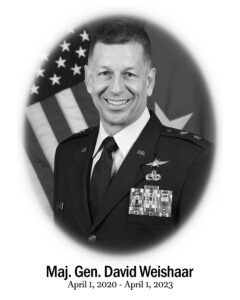 Maj Gen David Weishaar
Maj Gen David Weishaar
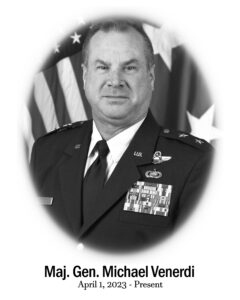
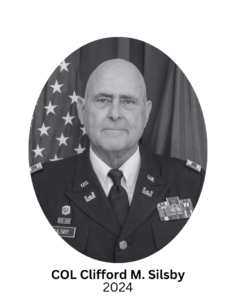
COL Clifford M. Silsby was born on July 19, 1952 in Concordia, Kanas. He enlisted in the Kansas Army National Guard after high school graduation in February, 1970. He completed Basic and Advanced Individual training at Ft. Leonard Wood, Missouri. He started his military career as an Engineer Equipment Operator with the 891st Engineer Battalion and 891st Engineer Company in Mankato, Kansas, followed by assignments with the 170th Maintenance Company. He graduated from the Kansas National Guard Officer Candidate School. During the period of 1984-1992 he held many positions as a Company Grade Officer with Headquarters and Headquarters Company, 891st Engineer Battalion in Iola, Kansas.
He quickly rose through the ranks with promotion to Lieutenant Colonel in 1996 while assigned to the 69th Troop Command, holding several positions. He served as Commander, 89lst Engineer Battalion, as Surface Maintenance Manager for the Kansas Army National Guard, as Executive Officer of the 2d Bn, 235th Regiment, and as Commander, Kansas Regional Training Center, Salina, Kansas. He served as Director of Installations for Joint Force Headquarters from 2005 to 2012. In 2012 COL Silsby was assigned to Operation Enduring Freedom on Active Duty as Officer in Charge of the Special Collections Office, Center for Army Lessons Learned, Ft. Leavenworth, in Afghanistan. Colonel Silsby retired in 2012.
During COL Silsby’s long career he received numerous awards and decorations, including the Legion of Merit, the Meritorious Service Medal with Silver Oak Leaf Cluster, the Army Commendation Medal with 4 Bronze Oak Leaf Clusters, the Army Achievement Medal with 3 Bronze Oak Leaf Clusters, the Army Reserve Components Achievement Medal, National Defense Service Medal, Afghanistan Campaign Medal with Campaign Star, Armed Forces Reserve Medal with Silver Hourglass, Global War on Terrorism Medal, NCO Professional Development Ribbon, Army Service Medal, NATO Medal, Army Superior Unit Award, Kansas National Guard Service Medal, and Kansas Emergency Duty Service Ribbon.. In addition, he received the Kansas National Guard Medal of Excellence and has been inducted into the Kansas Army National Guard Officer Candidate School Hall of Fame. He was also the recipient of several additional special honors.
Over the course of his military career Colonel Silsby completed over twenty schools and courses. He also has a Bachelor of Science in Organizational Management and Business from Friends University, Wichita, Kansas, and a Master of Strategic Studies from the United States Army War College, Carlisle Barracks, PA. He is a graduate of the U. S. Army War College.
A few of his special military service accomplishments were as a Kansas member and manager of the U. S. Army Installations Sustainment and Maintenance Program (ISM), manager of the RETRO Europe Maintenance Program, co-author of the Kansas Advanced Turbine Engineer Program, and Chairman (2008-09) and member of the National Guard Bureau Facilities and Engineering Advisory Council (2006-2009).
In addition to Colonel Silsby’s outstanding military career, he also volunteered with multiple organizations. He served as Chairman of the Jewell County Industrial Development Association and was a volunteer firefighter in Mankato, Kansas. He served as a life member of both NGAUS and NGAKS and has served for 30 years on the Board of Directors of the Museum of the Kansas National Guard. He has been an active member of the Kansas Antique Steam Show Safety Association, holding several board positions. He has been an active member of the Jewell County Historical Society and has served with two American Legion Posts.
He is married to Susan Silsby, and they have five children: Krista (Ben) Ruthstrum, Angela (Timothy) Brown, Elizabeth (Andrew) Stratman, Jennifer, and SFC James (Karla) Silsby. They also have ten grandchildren.
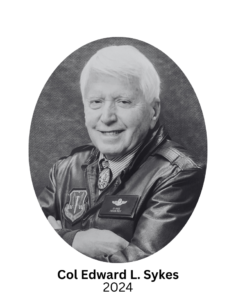
Col Edward L. Sykes was born on June 15, 1943 in Rice Lake, Wisconsin. He graduated from Caldwell County High School, Princeton, Kentucky, in 1962. He attended the university of Wisconsin, Madison, Wisconsin, graduating with a Bachelor of Science in Electrical Engineering in 1967.
He was commissioned in 1967 from the University of Wisconsin AF ROTC program, with his first assignment to attend undergraduate pilot training at Reese AFB in Texas. He next assignment was to McConnell AFB, Wichita, Kansas, flying F-105 Thunderchiefs. He was then assigned to Korat Royal Thai Air Base, where he successfully completed 118 combat missions over the jungles of Vietnam and Southeast Asia in the F-105 Thunderchief.
Following his combat tour, he went back to Reese AFB, Texas, where he served as a T-37 instructor. In 1972 he joined the 184th Tactical Fighter Group (TFG), Kansas Air National Guard, as an F-105 instructor pilot. He soon became the Chief of Academic Training, where he wrote several training manuals for the F-105.
In 1981 he became the Chief of Maintenance for the 184th TFG. Under his leadership and management techniques, the 184th experienced a rise in flyable aircraft and soon met all the daily flying requirements.
In early 1983 he became the Deputy Commander for Operations, in which position he oversaw all flying operations. In this capacity he was responsible for all F-4D training, including the F-4D Fighter Weapons School for the entire Air National Guard, Air Force Reserve and Active Duty Air Force units. In March of 1984 Col Sykes led a 12-ship package of F-4’s on a classified deployment to Thumrait, Oman. This was the first-ever deployment of an Air National Guard unit east of the Suez Canal.
Consequently, in 1984 Sykes was selected to represent the Air National Guard at Tactical Air Command (TAC) Headquarters at Langley AFB, Virginia, as the ANG Advisor to the Commander. In 1986 he was called back to Kansas to assume command of the 184th Fighter Group. He held this position for over six years.
During his time at the 184th and after his retirement he played an active part in the Wichita business community as a business owner, board member of the Freedom First Federal Credit Union, board member for the Rose Hill School District, board member for the Quivira Council of the Boy Scouts, and as a board member for the First Presbyterian Church and Wichita Wagonmasters.
He completed a Master of Science in Business Administration at Wichita State University in 1991. He was a member of the 1988 class of Leadership Kansas. In his retirement he has pursued recovery efforts for three of his fellow pilots shot down in Vietnam, finding one of them at this point with the remains recovered, returned, and buried in Arlington Cemetery. He is the author of The Patch and the Stream Where the American Fell, which details his efforts at the recovery of his friend and roommate.
He and his wife, the former Mary K. Bartz of Suring, Wisconsin, recently celebrated 57 years of marriage. From this marriage came four children: Bartz, Jennifer, Ezra, and Amanda. They have fourteen grandchildren.
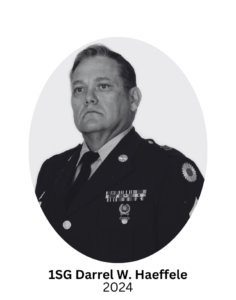 First Sergeant Darrel W. Haeffele was born on September 25, 1940, in Falls City, Nebraska. He graduated from Atchison High School in 1958. He attended Concordia College in Seward, NE for two years before starting a career in retail.
First Sergeant Darrel W. Haeffele was born on September 25, 1940, in Falls City, Nebraska. He graduated from Atchison High School in 1958. He attended Concordia College in Seward, NE for two years before starting a career in retail.
He began his military career by enlisting in the Kansas Army National Guard in 1963. He attended basic and advanced individual training at Ft. Sill, OK in the spring of 1964 and was trained as a Field Artillery Operations and Intelligence Assistant with specialty code 152.10. In May of 1968 he was mobilized with the battalion as a member of Headquarters Battery in Hiawatha, Kansas. While serving at Fort Carson, CO with the battalion he was promoted to Staff Sergeant.
Upon return from active service, SSG Haeffele was hired as a fulltime Guardsman with HHB, 130th FA and assigned as a Personnel NCO. In 1972, recognizing his leadership talents, the battalion reassigned him to a firing battery in order to become proficient in battery field artillery operations. He served as both the Gunnery Sergeant and Chief of Firing Battery, as well as Battery First Sergeant.
He returned to the HHB in 1982 as the Operations NCO. Equally, if not more important, was his role in standing up the Nuclear Training Program within the battalion. This meant becoming qualified in Communications Security, Nuclear Surety, and working closely with the Active Army training teams to establish the Technical Operations teams at Battery level.
He left the technician workforce in 1988, but returned in 1989 as a member of the Active Guard and Reserve Program (AGR). He served the remainder of his career as the fulltime Operations NCO and was instrumental in developing the training program for the transition of the battalion from eight-inch to Multiple Launch Rocket System.
In retirement he continued serving the 130th FA Regiment as historian, his City of Hiawatha as a City Council member, and the Kansas National Guard as an employee of the United States Property and Fiscal Office for Kansas.
His military awards include the Meritorious Service Medal with Oak Leaf Cluster, Army Commendation Medal with 2 Oak Leaf clusters, Army Achievement Medal, Army Reserve Components Achievement Medal with four Oak Leaf Clusters, the National Defense Service Medal with Bronze star Device, the Armed Forces Reserve Medal with Numeral “2” Device, and many others.
Educational achievements include an Associates of Arts Degree from Highland Community College, a Bachelor of Science from Friends University, and a Master of Science in Management from Baker University.
Darrel married Sanda May Carter of Hiawatha in June of 1966. Together they had three children—Cherie (Robert) Herlinger, Traci (Calvin) Weibling, and Michael (Michelle) Haeffele. They have five grandchildren and eight great grandchildren. Sandra departed the earth in April of 2018.
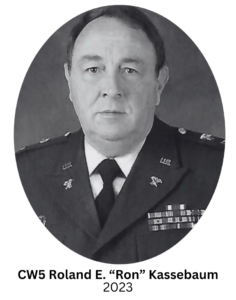 CW5 Roland E. “Ron” Kassebaum was born on February 21, 1946 in Deshler, Nebraska. He graduated from Hebron High School, Hebron, Nebraska in 1964. He attended Fairbury Junior College, Fairbury, Nebraska and the University of Nebraska, Lincoln, Nebraska, and received a Bachelor of Science Degree from the University of the State of New York in 1991. He later attended Liberty University, Lynchberg, Virginia, for courses in accounting and Allen County Community College, Iola, Kansas, for a course in Business Law.
CW5 Roland E. “Ron” Kassebaum was born on February 21, 1946 in Deshler, Nebraska. He graduated from Hebron High School, Hebron, Nebraska in 1964. He attended Fairbury Junior College, Fairbury, Nebraska and the University of Nebraska, Lincoln, Nebraska, and received a Bachelor of Science Degree from the University of the State of New York in 1991. He later attended Liberty University, Lynchberg, Virginia, for courses in accounting and Allen County Community College, Iola, Kansas, for a course in Business Law.
He enlisted in the 250th Ordnance Company, Kansas Army National Guard, at Belleville, Kansas on September 9, 1965, attending Basic and Individual Training at Ft. Leonard Word, Missouri. He was assigned as an Auto Repairman in Company D, 169th Support Battalion, at Belleville, Kansas, and was mobilized with the unit as part of the 1968 mobilization of the 69th Infantry Brigade (Separate) for the Vietnam War at Ft. Carson, Colorado. Released from Active Duty in 1969, he served as a Repair Foreman in Company D, 169th Support Battalion at Belleville, Kansas. In 1970 he became an Auto Repairman Inspector in Company D, 169th Support Battalion at Marysville, Kansas, then Motor Sergeant and First Sergeant in that unit and in Battery C, 2nd Battalion, 130th Field Artillery, reorganized at Marysville, Kansas.
In 1979 he became a Supply Accounting Technician in Headquarters and Headquarters Detachment, 169th Support Battalion, and was promoted from First Sergeant to Chief Warrant Officer Two (CW2) on December 19, 1979. In 1982 he transferred to Headquarters, State Area Command, where he served as the General Supply Technician, including a 3-year tour in the Active Guard & Reserve (AGR) as a Property Book Technician. He was promoted to the rank of Chief Warrant Officer Five (CW5) on April 5, 1996. He completed his career on February 26, 2006 as the Quartermaster Policy Action Officer in Headquarters, State Area Command.
He served most of his military career as a Civil Service Technician in the Kansas Army National Guard, except for the three-year AGR tour in 1987-1990. He began his fulltime career as an AST (Administrative Supply Technician) at Marysville in 1970, later serving as a General Supply Specialist, Examiner, Management Analyst, Supervisory Supply Technician, and Auditor for the U. S. Property and Fiscal Office (USP&FO).
During his career he completed a variety of military and civil service courses which qualified him for ever-increasing responsibility. These courses included The Army Maintenance Management System, the Administrative Supply Technician Course, the Joint Auditor Training School, NCO courses, Logistics Courses, the Kansas Army National Guard Supply Sergeant School, the Warrant Officer Senior Course and Warrant Officer Senior Staff Course, the U. S. Senior Auditor School, Electronic Mail Training, the Fiscal Law Course, and over twenty audit and internal review courses.
His awards and decorations during his military career included the Legion of Merit, Meritorious Service Medal with Oak Leaf Cluster, Army Commendation Medal (6th Award), Army Achievement Medal with 2 Oak Leaf Clusters, the Good Conduct Medal, the Army Reserve Component Achievement Medal with 7 Oak Leaf Clusters, the National Defense Service Medal with Bronze Star, the Armed Forces Reserve Medal with 3 Devices, the Army Service Ribbon, the Kansas National Guard Service Medal with 6 Sunflower Devices, the Kansas Emergency Duty Service Ribbon, and a Certificate of Recognition for the Cold War.
He was named the Warrant Officer of the Year in 2005, received the Kansas National Guard Medal of Excellence, received the Distinguished Performance Award of The Adjutant General of Kansas, and was inducted into the Artillery Order of St. Barbara. He received the U. S. Army Internal Review Award of Merit in 2002, and was one of four nominees for the National Guard Auditor of the Year Award in 2003.
He served as President, Vice President, Membership Chairman, and Board Member of the National Guard Association of Kansas. He is a Life Member of the National Guard Association of both the United States and Kansas and a 53-year member of the American Legion. He has served in many capacities in Our Savior’s Lutheran Church in Topeka, including chair of the Property, Social Ministries, and Audit Committees. He has served as a volunteer for “Communities in Schools,” as an Election Poll Worker, and as a blood donor with over 22 gallons given. He is a member of the Museum of the Kanss National Guard and has led the Museum audit. He has provided pre-mobilization training for the 170th Maintenance Company; the 169th Support Battalion; the 891st Engineer Battalion; the 2d Battalion, 137th Infantry; and the 2d Battalion, 130th Field Artillery.
He has supported Emergency Duty missions in Blue Rapids, Marysville, and Greenleaf, Kansas, and assisted in providing equipment and personnel for many Veterans Day, Memorial Day, and local community celebrations.
He is married to his wife Sandra, and they have two children—Kevin and Corby—and three grandchildren.
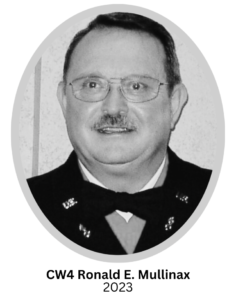 Chief Warrant Officer Four Ronald E. Mullinax was born on August 25, 1946, in Norton, Kansas to Earl and Mary Posson. He was adopted by John and Ada Mullinax. He grew up in Lenora, Kansas, graduating from Lenora Rural High School in 1965. After completing a Denver Automotive Institute training program, Ron worked at Look Body Shop in Norton until 1968.
Chief Warrant Officer Four Ronald E. Mullinax was born on August 25, 1946, in Norton, Kansas to Earl and Mary Posson. He was adopted by John and Ada Mullinax. He grew up in Lenora, Kansas, graduating from Lenora Rural High School in 1965. After completing a Denver Automotive Institute training program, Ron worked at Look Body Shop in Norton until 1968.
He began his long and distinguished military career by enlisting in the Kansas Army National Guard in 1965. He began his fulltime military technician career in 1968 in Organizational Maintenance Shop #1 at Norton, Kansas. He was promoted through the enlisted ranks, attaining the rank of Master Sergeant before earning an appointment as a Warrant Officer in 1991. In 1992 Ron was selected as the Armament Supervisor at the Maneuver Area Training Equipment Site on Ft. Riley, Kansas. He then moved his family to Manhattan, Kansas. He reached his military mandatory retirement age in 2006, and retired at the rank of Chief Warrant Officer Four, with 40 years, 11 months, and 3 days of service to his nation.
His military career was exclusively in the Kansas Army National Guard. He progressed in rank in Headquarters & Headquarters Company, 110th Ordnance Battalon, Norton, Kansas, starting as a cook in 1965 and culminating as the Battalion Motor Sergeant in 1979. In 1979 he was assigned as the Maintenance Operations Supervisor for the 287th Maintenance Battalion, serving in this role until his Warrant Officer appointment in 1991, when he was assigned to the 174th Supply and Service Battalion as a 915 Series Maintenance Support Technician. In October of 1991 he transferred to the 170th Maintenance Company, where he served in numerous assignments until 2002. During this period he transitioned to a 913 series Armament Repair Technician. In 2002 he transferred to the 174th Ordnance Battalion, terminating his military career in Joint Force Headquarters, in 2006.
During Ron’s military career he was selected to evaluate Cold War Era equipment stores in Germany, prepositioned equipment designed for issue to rapidly-deploying Army units. His evaluations resulted in triaging this equipment’s return to the continental Untied States for repairs to be issued to Army units. As a result, Kansas was selected to be a major repair site under a program called Return Equipment from Europe, or RETROEUR, located on Ft. Riley. The RETROEUR program later metamorphosed into the Readiness Sustainment Maintenance Site. Both programs employed hundreds of Kansas and contributed many millions of dollars into the Kansas economy. After achieving his military retirement, Ron continued his service to the National Guard and Kansas as the Assistant Site Foreman at the Kansas Readiness Sustainment Maintenance Site, Ft. Riley, until he retired from this position in 2015.
He participated in a Foreign Military Sales project for Portugal in 2002, and was the project manager in rebuilding M-109A3 howitzers for them. The success of this project resulted in a good reputation for Kansas that led Kansas to become active in the national maintenance program.
His military awards include the Legion of Merit, the Meritorious Service Medal with 2 Oak Leaf Clusters, the Army Commendation Meal with 2 Oak Leaf Clusters, the Army Achievement Medal with 3 Oak Leaf Clusters, the Army Reserve Components Achievement Medal with Silver Oak Leaf Cluster, the National Defense Service Ribbon, the Armed Forces Reserve Medal with 4 Hour Glass Devices, the NCO Professional Development Ribbons with 3 Devices, the Army Service Ribbon, the Army Reserve Components Overseas Training Ribbon, the Kansas Army National Guard Commendation Medal, the Kansas National Guard Achievement Ribbon, the Kansas Emergency Duty Ribbon with 2 Sunflower Devices, and the Kansas National Guard Service Medal with 3 Sunflower Devices. He was also a recipient of the Kansas Army National Guard Recruiter Badge, was selected as the 1999 Kansas Warrant Officer of the Year, and was a recipient of the Ordnance Order of Samuel Sharp.
He completed numerous courses at Colby Community College, the Kansas Technical Institute, and the National Guard Bureau, and earned his Associate of Arts Degree in General Studies from Barton County Community College.
He maintained active memberships in the National Guard Association of Kansas and the United States, the Enlisted Association of the Kansas National Guard, the Museum of the Kansas National Guard, and the American Legion.
Ron married Diane Smith, the absolute love of his life in Norton on September 11, 1966. They made their home in Norton, then Manhattan, Kansas. They raised two sons, Mike and Mark, Ron was a dedicated family man and always actively supported family activities. He and Diane were church youth leaders and enjoyed car clubs. He was a Scout Master for both Cub Scouts and Boys Scouts, and served as a Little League baseball coach. He enjoyed a variety of activities from meticulous yard care to any outdoor activity and work on and restoring numerous cars. His greatest love was spending time with his family, and doing absolutely anything for his wife, children, and grandchildren.
Ron departed this earth on June 23, 2019, leaving his widow, Diane, who still resides in Manhattan, Kansas, as well as two sons, Mike Mullinax of Silver Lake, Kansas and LTC Mark Mullinax of Wamego, Kansas.
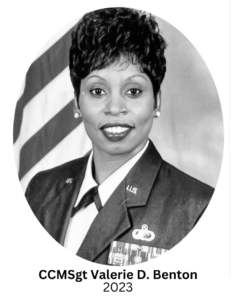 CCMSgt Valerie D. Benton was born on Dec. 10, 1959 in Racine, Wisconsin, where she spent her childhood. She graduated from Washington Park High School in 1978. Soon after graduation she enlisted in the U. S. Air Force and headed to Basic Training at Lackland AFB, Texas in December of 1978. After completion of Basic training, she attended Technical Training at Lowry AFB, Colorado, and graduated as a Food Service Specialist.
CCMSgt Valerie D. Benton was born on Dec. 10, 1959 in Racine, Wisconsin, where she spent her childhood. She graduated from Washington Park High School in 1978. Soon after graduation she enlisted in the U. S. Air Force and headed to Basic Training at Lackland AFB, Texas in December of 1978. After completion of Basic training, she attended Technical Training at Lowry AFB, Colorado, and graduated as a Food Service Specialist.
Upon completion of Technical Training, she received a permanent change of station (PCS) to Aviano Air Base, Italy, where she served for four years. She ended her tour of duty as the NCOIC of the Alert Dining Facility. In 1983 she transferred to McConnell AFB, Kansas and was the Dining Hall Shift Leader until retraining into the Education and Training career field which led to her assignment as the Unit Training Manager for the 384th Security Police Squadron, McConnell AFB.
In 1988 she was selected to be the On-the-Job (OJT) Advisor for the 3753rd Field Training Detachment, affording her the opportunity to conduct OJT courses for Air Force, Air National Guard, and Air Force Reserve personnel. It was during this duty assignment that she met General Tod Bunting (then Major Bunting), who encouraged her to consider the Kansas Air National Guard as one of her future career options.
In 1991 she transitioned to the Kansas Air Guard and served s the NCOIC of the Mission Support Squadron for the 184th Fighter Wing, until accepting an AGR position and retraining into the medical career field as a Health Systems/Aeromedical Technician. While assigned to the Clinic she was selected as NCO of the Year and was nominated as one of the twelve Most Outstanding Airmen for the Air National Guard.
In 1994 she became the Logistics Group Training Manager for the 184th Bomb Wing, where she supervised two personnel and served until 1998. Upon the addition of the Wing First Sergeant position, she was encouraged to apply and accepted the First Sergeant position for the 184th Aircraft Generation Squadron, the largest squadron in the wing. In this position she was blessed to serve the members and families of the 184th Aircraft Generation Squadron and considers it the highlight of her military career. She felt that helping tos ensure the overall well-being of the enlisted men and women was the career field for her. She served in this position from October, 1995 to February, 1998.
While attending the Senior NCO Academy at Gunter AFB, Montgomery, Alabama, she had the opportunity and pleasure to meet the 6th Command Chief Master Sergeant of the Air National Guard, CMSgt Ed Brown, who encouraged her to apply for the Air National Guard First Sergeant Functional Manager position at the U. S. Air Force First Sergeants Academy at Maxwell AFB, Alabama.
From 1998 to 2001 she represented the Air National Guard at the USAF First Sergeants Academy during which time she was the course director and curriculum manager and taught Air National Guad personnel how to be effective and successful first sergeants. She served in this position until being selected as the 8th Command Chief Master Sergeant of the Air National Guard in June of 2001.
During her tour as the Command Chief Master Sergeant of the Air National Guard (2001-2004) she had the opportunity to serve the men and women of the Air National Guard during the September 11/9-11 attacks on the United States. The effort to assess the overall health and well-being of the Air National Guard enlisted corps and their families required travel to over 47 states and territories and nine countries, another highlight of her military career. She retired in 2006 as the Command Chief Maser Sergeant of the Air National Guard.
Her awards and decorations include the Legon of Merit, Meritorious Service Medal with Oak Leaf Cluster, Joint Service Commendation Military Ribbon, Air Force Commendation Medal with 2 Oak Leaf Clusters, the Air Force Achievement Medal, the Kansas Outstanding Airman Ribbon, the Air Force Good Conduct Medal with 4 Oak Leaf Clusters, the Air Reserve Forces Meritorious Service Medal with 1 Oak Leaf Cluster, and the National Defense Service Medal.
After serving 26 years in the USAF and Air National Guard she continued to serve her community by becoming an Air Force Junior ROTC Instructor at Northwestern High School in Baltimore, Maryland and Central High School in Capitol Heights, Maryland (2004-2011). In 2011 she began a graduate program in Education and Training with an emphasis on school counseling. In 2013 she was hired to be the School Counselor at Piccowaxen Middle School, Newburg, Maryland, and then McDonough High School, Pomfret, Maryland, where she currently works as a school counselor and department chair. In 2016 the Board of Education and Citizens of Charles County, Maryland, recognized her unusual abilities and her demonstrated exemplary performance in her capacity as School Counselor.
She is a graduate of Excelsior College, Albany, New York with a Bachelor of Science Degree in Psychology and George Washington University, Washington, D. C., with a Master of Arts Degree in Education and Human Development with an emphasis in School Counseling.
During her career she volunteered in many Wichita community activities, as Administrator for Newcomers for the Spirit of Faith Christian Center, with JROTC cadets for community fundraisers following Hurricane Katrina in 2005, in Community Safety Programs in Capitol Heights, Maryland, and as a team mom for her son’s track and field team. She is a Life Member of the Enlisted Association of the National Guard of the United States and the Air Force Sergeant’s Association.
She is married to Anthony Benton, and they have three children–Terrell, Tamika (Jason) McCormack, and Tristan, and seven grandchildren.
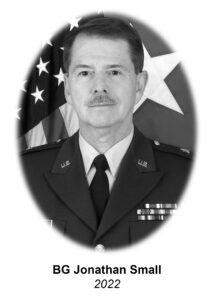 Brigadier General Jonathan P. Small served as The Adjutant General of Kansas from November 1, 2003 to January 4, 2004, culminating a 35-year military career as a distinguished attorney, community leader, citizen-soldier, and military leader. He served as Assistant Adjutant General-Army from 1999 to 2003, and as Commander of the Land Component for the Joint Force Headquarters-Kansas.
Brigadier General Jonathan P. Small served as The Adjutant General of Kansas from November 1, 2003 to January 4, 2004, culminating a 35-year military career as a distinguished attorney, community leader, citizen-soldier, and military leader. He served as Assistant Adjutant General-Army from 1999 to 2003, and as Commander of the Land Component for the Joint Force Headquarters-Kansas.
Born and raised in Medicine Lodge, Kansas, General Small received a Bachelor of Arts in History from Kansas State University in 1969, and a Juris Doctorate degree from the Washburn University School of Law, Topeka, in 1972.
He was commissioned as a Second Lieutenant through the Reserve Officer Training Corps program at Kansas Sate University on June 1, 1969. He was promoted to First Lieutenant in September 1972 and completed the Field Artillery Officer Basic Couse at Fort Sill, Oklahoma in December of that year. From December 1972 to March 1979, General Small was in the U. S. Army Reserve. In March of 1979 he began his career in the Kansas Army National Guard, serving as a State Area Command (STARC) Operations and Training Officer, Executive Officer, Civil-Military Operations Officer, Staff Judge Advocate, Judge Advocate, and Senior Military Judge. Along the way, he also completed the Field Artillery Advanced Course, the U. S. Army Command and General Staff College (1979), the Judge Advocate General Basic and Advanced Courses, and the U. S. Army War College (1994).
In June of 1990, General Small became the Staff Judge Advocate for Kansas, a position he held until becoming the Deputy Commander of STARC in October of 1998. He held the position of Kansas Judge Advocate General under appointment of the Governor from May of 1984 until May of 1999. He was promoted to Brigadier General in July 2000. He retired as The Adjutant General of Kansas on January 4, 2004.
His awards include the Legion of Merit, Meritorious Service Medal, the Army Commendation Medal, the Army Reserve Components Achievement Medal, the National Defense Service Medal, the Armed Forces Reserve Medal, and the Army Service Ribbon.
General Small maintained a private law practice in Topeka, Jonathan P. Small, Chartered, for over 37 years, was Kansas Asst. Attorney General from 1973 to 1978, and was Deputy Kansas Attorney General from 1978 to 1979. He has been a member of the Kansas and American Bar Associations and the American Legion, has been actively involved in the National Guard Association of Kansas, and provides ongoing support in the formation and improvement of the Museum of the Kansas National Guard.
He has served as Chairman and Board Member for the State of Kansas Military Board for 37 years, served for ten years on the Board of Directors of the Great Overland Station, Topeka, and has served as Scoutmaster, member of the Council Executive Committee, and as Council President of the Boy Scouts of America, Topeka.
General Small and his wife, Georgia Anne, reside in Topeka. Their son, Arron, and his wife, Cathy, teach at Purdue University, and their daughter, Jennifer, and her husband, Seth, live in Jefferson City, Missouri.
 General James H. Lane was a militia leader during the Bleeding Kansas period, the commander of the Kansas “Jayhawker” Brigade during the Civil War, and was one of the first United States Senators from Kansas.
General James H. Lane was a militia leader during the Bleeding Kansas period, the commander of the Kansas “Jayhawker” Brigade during the Civil War, and was one of the first United States Senators from Kansas.
General James H. Lane was born in Lawrenceburg, Indiana on June 22, 1814, he practiced law, beginning in 1940 at the age of 26. During the Mexican-American War, he commanded the 3rd and 5th Indiana Regiments. He was a U. S. Congressmen form Indiana from 1853 to 1855, where he voted for the Kansas-Nebraska Act.
He relocated to the Kansas Territory in 1855, and quickly became involved in the abolitionist movement, He was often termed the commander of the Free State Army (the Red Legs or the Jayhawkers), a major Free Soil military group. In 1855 he was the first president of the convention that drafted the anti-slavery Topeka Constitution. In 1858, Lane shot and killed a man in a land dispute in Lawrence, but was acquitted in a trial which kept him from participating in the convention drafting the Wyandotte Constitution, later the official constitution of Kansas. In 1861, the Free Soilers succeeded in getting Kansas admitted to the Union as a free state. Lane was elected as the state’s first U. S. Senator, and re-elected in 1865.
During the Civil War, in addition to serving in the Senate, Lane formed a brigade of “Jayhawkers” known as the “Kansas Brigade,” or “Lane’s Brigade,” composed of the Third, Fourth, and Fifth Kansas Volunteers. He commanded the force in action against pro-southern General Sterling Price in the Battle of Dry Wood Creek in Missouri. Lane lost the battle but then stayed around to attack pro-Southern places elsewhere in Missouri. General John C. Fremont ordered Lane to “make a demonstration along the Kansas-Missouri border with his Jayhawkers.” Lane acted gladly, raided the village of Morristown, burned it and swept a wide path of pillage, arson, and murder through the Missouri territory six miles wide and fifteen miles long. His raids culminated in the sacking of Osceola. For this he was criticized severely by Gen. Henry Halleck, Commander of the Dept of Missouri.
On Dec. 18, 1861, Lane was appointed Brigadier General of volunteers, but, because he was still a U. S. Senator, this was questioned, but, after further consideration, was upheld. On October 27-19, 1862, he recruited the 1st Regiment of Kansas Volunteer Infantry (Colored), which debuted at the Skirmish at Island Mound. They were the first African-Americans to fight in the war, and in their first action, 30 of their members defeated 130 mounted Confederate guerrillas.
Lane was the target of Quantrill’s Raid on Lawrence, Kansas, on August 21, 1863, in retaliation for some of his actions in Missouri. Though he was in residence in Lawrence at the time, he was able to escape the attack by racing through a nearby ravine. In 1864, when Confederate Gen. Sterling Price invaded Missouri, Lane was a volunteer Aide-de-Camp to Gen. Samuel R. Curtis, commander of the Army of the Border. Lane was with the victorious Union forces at the Battle of Westport in Kansas City.
He was re-elected to the United States Senate from Kansas in 1865, but on July 1, 1866, shot himself as he jumped from his carriage in Leavenworth, Kansas, probably because of his depression over having been charged with abandoning his fellow Radical Republicans and accusations of financial irregularities. He died ten days later, and Edmund G. Ross was appointed to succeed him in the Senate.
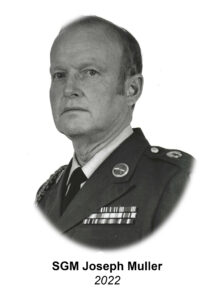 Sergeant Major Joseph T. “Jody” Muller was selected for the Kansas National Guard Hall of Fame for his exceptional service as a citizen soldier in the Kansas National Guard for over 41 years.
Sergeant Major Joseph T. “Jody” Muller was selected for the Kansas National Guard Hall of Fame for his exceptional service as a citizen soldier in the Kansas National Guard for over 41 years.
He was born, raised, and spent his life in St. Marys, Kansas, where he farmed, raised his family, was involved in the seed business, and served his church, Immaculate Conception Catholic Church, and his family over his lifetime.
He enlisted in Headquarters Detachment, 174th Military Police Battalion in St. Marys, KS on March 16, 1953, where he served as Mail Clerk and Unit Supply Sergeant. When the unit was reorganized as Company C (-), 2d Battle Group, 137th Infantry, he became a Light Weapons Infantryman, and by 1962 was a Platoon Sergeant in the unit. When his unit was re-organized in 1963 following inactivation of the 35th Infantry Division, his unit became part of the 69th Infantry Brigade (Separate). He then served as Acting First Sergeant at St. Mary’s, as well a Platoon Sergeant of the 69th Brigade Military Police.
In 1968 he was mobilized with the 69th Infantry Brigade and sent to Fort Carson, CO, where he also served as Acting First Sergeant of the 5th Infantry (Mechanized) Police Company and Operations Sergeant of the Provost Marshall Section. For his great work in these assignments he was given an Army Commendation Medal from the 5th Mech Division. Following de-mobilization on December 12, 1969, he returned to duty with the 69th Infantry Brigade (Separate), until it was re-organized as the 69th Infantry Brigade, 35th Infantry Division in 1984, serving in the capacities of Intelligence Sergeant and Operations Sergeant. He was promoted to the rank of Sergeant Major E-9 on January 4, 1982. In 1988 he participated in overseas training with V Corps in Germany, for which he received a letter of commendation.
In the early 1990’s he served as Operations Sergeant Major in Headquarters, State Area Command, and as the Sergeant Major for the G-1 Personnel Section. He participated in many Readiness for Mobilization exercises, was a key leader in the Wolf Creek Nuclear Operating Station exercises, and was involved in the assignment and training of senior NCO personnel in the Kansas Army National Guard. He was a graduate of Advanced and Senior NCO Courses.
He retired on September 17, 1995 with over 41 years of service. His awards included the Legion of Merit, Army Commendation Medal (3rd Award), the National Defense Service Ribbon, the Army Reserve Components Medal, the Armed Forces Reserve Medal, the Army Achievement Medal, the Army Reserve Components Overseas Training Ribbon, the NCO Professional Development Ribbon, the Kansas National Guard Service Medal w/Sunflower Devices, and the Kansas Emergency Duty Ribbon.
He was a lifelong member of the Immaculate Conception Catholic Church in St. Marys, Kansas, serving in many leadership capacities in the church and Knights of Columbus. He was a leader in the Future Farmers of America, the Farmer’s Union Cooperative in St. Marys, the Rossville American Legion, and the St. Marys Veterans of Foreign Wars. He was the face of the Kansas National Guard in the St. Marys community for many years, filling the role with enthusiasm and integrity.
He was married to his high school sweetheart, Patricia Pollard in 1955, and they shared 63 years together. To the marriage was born five sons, Joseph T., Jr. (Deceased), Brad, Jim, Mike, and Jeff, and one daughter, Tricia. He and his wife celebrated 17 grandchildren and 10 great grandchildren. He passed away on April 28, 2019, and was buried in Mt. Calvary Cemetery at St. Marys, Kansas.
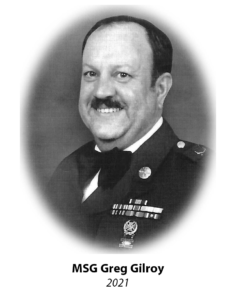 Master Sergeant Greg Gilroy was born on July 25, 1947 at Ottawa, Kansas. He was a lifelong resident of Ottawa, graduating from Ottawa High School in 1965. He then attended Emporia State University during the 1965-66 school year.
Master Sergeant Greg Gilroy was born on July 25, 1947 at Ottawa, Kansas. He was a lifelong resident of Ottawa, graduating from Ottawa High School in 1965. He then attended Emporia State University during the 1965-66 school year.
On December 10, 1966, he joined the Kansas National Guard’s Headquarters Battery, 1st Battalion, 127th Field Artillery in his hometown of Ottawa, Kansas. He served in that unit for 36 years, retiring as a Master Sergeant E-8 on December 9, 2002. He served as the Battery Clerk, Legal Clerk, Intelligence Sergeant, Personnel Staff NCO, First Sergeant for Headquarters Battery, and Battalion Operations Sergeant during that time.
He served as the fulltime 1st Battalion, 127th Field Artillery Operations Sergeant as an Army National Guard Technician during much of that time. In that position he developed and implemented training plans for all batteries in the battalion, ensured effectiveness of unit training at each Annual Training Period, successfully passed a variety of tests and evaluations, and was instrumental in developing the plan for and fielding the Paladin 155mm Self-propelled Howitzer when his unit became the first in the country to field that weapon.
His awards and decorations during his distinguished 36-year career included the following: Meritorious Service Medal (2d Award), Army Commendation Medal, Army Achievement Medal (2d Award), Armed Forces Reserve Medal (2d Award), Army Reserve Components Achievement Medal (7th Award), National Defense Service Ribbon, Army Service Ribbon, NCO Proficiency Development Ribbon (3rd Award), Recruiting Badge, Kansas National Guard Service Ribbon (w/3 Sunflower Devices), and the Kansas National Guard Commendation Ribbon (2d Award).
During his career in the Kansas National Guard, the 1st Battalion, 127th Field Artillery was not called to active Federal Service. However, he was instrumental in fielding and training many Artillerymen and Kansas Guardsmen who were later mobilized for the Global War on Terrorism, and in ensuring mobilization readiness for countless soldiers during that period. For much of his 36 years in the Guard, he was the well-known face of the Guard in the Ottawa community in the long tradition of the citizen-soldier. His leadership and mentorship of soldiers, junior NCO’s, and junior officers was exemplary and a model for others to follow. His imprint has been felt on both individual soldiers and the Guard both during his career and after his retirement.
He served for over 20 years as a member of the Board of Directors of the Museum of the Kansas National Guard, and from March of 2002 until his death in 2019 as Secretary to the Board of Directors (over 17 years). He also maintained the Museum’s Facebook page and chaired the Museum Finance Committee, which managed the Museum’s Trust Account.
He served both as President and as Executive Director of the Enlisted Association of the National Guard of Kansas (EANGKS). On the national level of the Enlisted Association of the National Guard of the United States (EANGUS) he was Chairman of the Finance Committee and the By-Laws Committee, as well as Director for Area Four, EANGUS.
He was especially active with Cub and Boy Scouts, serving as a leader in the Ottawa Cub Scout Troop 3118 and Boy Scout Troop 127, promoting memberships, activities, leader recruitment and training, financial support for scouting, and development of scouting campouts, activities, and events. He most recently served as the Community Leader for the organization.
He served as a member and the Treasurer of the Franklin County Historical Society in Ottawa, and as a member of the Kansas State Historical Society. In these capacities, he was instrumental in developing exhibit ideas, exhibits, and promotions to preserve the history of Ottawa and Franklin County.
He was active as a member of the Ottawa and Lawrence Model Railroad Clubs, and was heavily involved in running the Train Room at the Old Depot Museum in Ottawa. In addition, he volunteered with the Franklin County Fair Board, serving in many capacities during the Franklin County Fair and in preparations for it.
MSG Gilroy married Shirley Sullivan, and through this marriage he gained three wonderful step-children. They were later divorced, and on December 5, 1985 he was unified in marriage to Bonnie Kiefer, his surviving widow. From this marriage he gained three stepchildren. Eventually he would see eighteen grandchildren and twenty-six great grandchildren.
He was a lifelong member of the First Baptist Church of Ottawa and an avid Kansas City Chiefs and Kansas University Jayhawks fan. He traveled extensively with his kids and grandkids in his RV throughout much of the United States, loved western movies, and enjoyed playing golf with his friends from the Ottawa community.
Many members of his large family were present at his funeral in the Ottawa National Guard Armory on November 5, 2019. The Armory was nearly full of his family, friends, and extended National Guard family as a fitting tribute to this epitome of a citizen soldier.
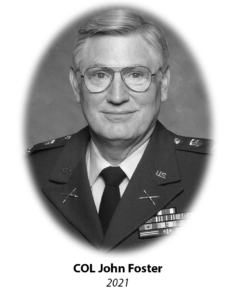
COL John S. Foster was selected for induction into the Kansas National Guard Hall of Fame for exceptional service to Kansas Army National Guard Field Artillery, exceptional service to the communities in which he has lived, and for outstanding leadership in the Kansas Army National Guard.
John S. Foster was born November, 6, 1945 to Ernest A. and Ruth K. (Randall) Foster in Savannah, MO. He was raised and educated in NE Kansas. He graduated in 1963 from Reserve Rural High School in Reserve, KS. COL Foster received a Bachelor of Science in Secondary Education from Kansas State Teachers College at Emporia in 1967 prior to entering the Kansas National Guard. He served as a teacher in the Seaman School District #345, Topeka, and the Perry-Lecompton School District #343.
In February 1970, he enlisted in the Kansas National Guard assigned to HHC, 69th Infantry Brigade in Topeka, KS. He attended the Kansas Army National Guard Officer Candidate School and was commissioned as a Second Lieutenant in June 1972. He was assigned to Battery B, 2nd Battalion, 130th Field Artillery in Horton, KS as a forward observer. He served in all of the Field Artillery Battery positions in Battery B and Battery A, commanding Battery B from August 1978 through September 1979.
In January 1980, Captain Foster began his full-time National Guard career as the Active Guard and Reserve S-1 of the 1st Battalion, 161st Field Artillery in Dodge City. He later served as the training officer of the 2nd Battalion, 130th Field Artillery in Hiawatha, KS. In 1984-1985, while serving as the Administrative Officer of the 169th Support Battalion, he supervised the relocation of the battalion headquarters from Kansas City to Olathe. He later served as the Administrative Officer of the 174th Supply and Services Battalion in Coffeyville and as the Information Management Officer for the Kansas Army National Guard.
He returned to the field in October 1989 as the Executive Officer, 2nd Battalion, 130th Field Artillery and served in that capacity until August 1994 when he assumed command of the battalion. He was promoted to Lieutenant Colonel in October of that year. In August 1997, he returned to HQ STARC as Special Assistant to the Adjutant General (Military) and was promoted to Colonel in March 1999.
COL Foster was a graduate of the Field Artillery Officer Basic and Advanced Courses and the Command and General Staff College. He holds a Master of Science in Systems Management from the University of Southern California.
During his career, COL Foster’s awards included the Legion of Merit, Meritorious Service Medal with oak leaf cluster, Army Commendation Medal with four oak leaf clusters, and the Kansas National Guard Service Medal with two sunflower devices.
He was an inductee into the Kansas Army National Guard Officer Candidate School Hall of Fame and Ancient Order of St. Barbara.
In 1980, he engaged the National Guard Association of Kansas with the concept of establishing the Junior Officer’s committee that was adopted at the state and national levels. COL Foster was appointed as the first Junior Officers Chairman in 1982. He commissioned the Junior Officer of the Year awards that are still presented at the National Guard Association of Kansas annual conference as the Major General Ralph T. Tice Award for Army Company Grade Officer of the Year and the Major General Edward R. Fry Award for Air Company Grade Officer of the Year.
In 1989, COL Foster launched a grass roots campaign to bring the Multiple Launch Rocket System to Kansas. Reconfigured as the High Mobility Artillery Rocket System in 2011, it remains in Hiawatha, KS today and has been employed as one of the most lethal weapons systems on the battlefield in the War on Terrorism.
In the midst of fielding the Multiple Launch Rocket System, COL Foster assisted in commissioning the 130th Field Artillery Regimental room and General’s Walk at the Armory in Hiawatha, KS to capture the legacy of the historic regiment.
COL Foster remained an active community member serving as the Chairman of Faith Lutheran Church, Elks member, Lions member, Emergency medical service volunteer, former board member of the Kansas National Guard Museum, board member of North Central Arkansas Foundation for Arts, board member of Fairfield Bay Community Foundation, and American Legion Commander and Officer.
John is married to Barbara (Guebert) Foster. His sons Chris and Tim Foster served as members of the Kansas Army National Guard deploying in support of Operation Iraqi Freedom. John and Barbara make their home in Fairfield Bay, Arkansas.
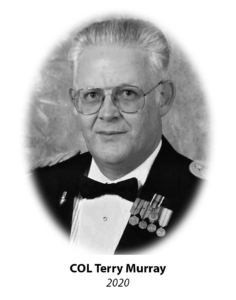
Chaplain (COL) Terry L. Murray was born on May 14, 1946, in Wichita, Kansas, where he was raised and spent much of his life. He graduated from Wichita South High School and Friends University, Wichita. During his time in the seminary he served at Mount Zion and the Reserve, Kansas United Methodist Churches, as well as the United Methodist Churches in Netawaka, Kansas, and Whiting, Kansas. He received a Master of Divinity degree from St. Paul School of Theology, Kansas City, Missouri, in 1971.
After graduating from St. Paul School of Theology he started his ministry as Associate Pastor of the First United Methodist Church in Manhattan, Kansas, and then at Grace Memorial United Methodist Church in Independence, Kansas. He later served in the Wesley Medical Center CPE program as Chaplain and then as co-pastor of the Haysville United Methodist Church and pastor at Zion United Methodist Church, Central Avenue United Methodist Church, and Grace United Methodist Church, all in Wichita. He was a member of the Kansas West Conference of the United Methodist Church until his retirement in 2006.
The last church Chaplain Murray served before his retirement was an inner-city parish that was about to close its doors when he was appointed there. The church immediately began to thrive under his style of leadership, in which he gave permission and encouragement to those in the church who had good ideas and the ability to bring those ideas to reality. As a result, the church rapidly grew in numbers. It hosted a large day care center and a variety of street fairs and parking lot block parties that brought diverse individuals form the neighborhood together. It also built bridges between the community and the Wichita Police Department.
He was an influential community minister through South Central Wichita Neighborhood programs and several school site councils. He was a member and chaplain for the Downtown Cosmopolitan Club of Wichita. His passions included model railroading and Western US and Civil War history. He also owned a couple of small businesses during his time in Wichita, centered on his passion for trains and model railroading.
Chaplain Murray was accessioned as a chaplain in the Kansas Army National Guard and received a direct commission as a First Lieutenant in 1974. He graduated from the U. S. Army Chaplain Basic Course, the U. S. Army Chaplain Advanced Course, and the U. S. Army Command and General Staff College.
He served as battalion chaplain for the 174th Supply and Service Battalion, Coffeyville, Kansas; as group chaplain for the 331st Medical Group, 89th Army Reserve Command (his only four years in the Army Reserve); and Deputy Chaplain, 35th Infantry Division, Fort Leavenworth, Kansas. He was promoted to the rank of Colonel in 1996 and appointed the State Chaplain, Kansas State Area Command, Topeka, Kansas. As State Chaplain he had responsibility for the Kansas Army and Air National Guard and Civil Air Patrol.
He was the first state chaplain in the United States to include both Army and Air Guard chaplains and chaplain assistants in joint training, and was responsible for Kansas being the first state to use both Army and Air Guard chaplains together in support of state emergency operations. He also opened Kansas Guard chaplain training to Civil Air Patrol chaplains and saw them as valuable partners and state assets. He led statewide training in Critical Incident Stress Management. He was extremely effective at recruiting chaplains for the Kansas Army and Air National Guard. He fostered cooperation between Kansas Guard chaplains and the newly-established Family Readiness program, a relationship that paid big dividends in soldier/airmen family support and care when the mission of the Kansas Guard expanded to include combat deployments in the years following 9-11.
In 1998 he hosted representatives of the Ukranian National Guard who were seeking to implement a United States military chaplain style ministry in their post-Soviet armed forces which would ensure the exercise of religion by their service members. In 1999 he led a delegation of Kansas National Guard chaplains into Ukraine to meet with senior military, civilian, and church leadership to further explore the American military style of chaplaincy.
Chaplain (COL) Murray retired from the Kansas National Guard in 2004 after 30 years of service. His awards and decorations during his career included the Legion of Merit, the Army Commendation Medal, the Air Force Commendation Medal, the Army Reserve Component Achievement Medal, and the National Defense Service Medal.
Chaplain (COL) Murray passed away on August 28, 2009, with services at West Heights United Methodist Church in Wichita. He was survived by his wife of 42 years, Ann; his son Aaron (Vicki) Murray of Denver, Colorado; his daughter Tara Cunningham of Wichita; his step-mother Jane Murray of Honolulu, Hawaii; stepsister Rosa Mitchell and Chris Cook; step-brother Richard Webster, and three grandchildren, Dane, Lane, and India.
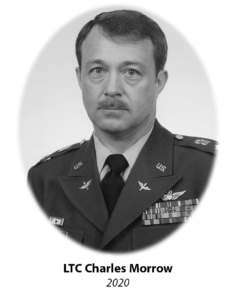
![]()
![]() LTC Charles H. “Chuck” Morrow was born on Nov. 21, 1947 at Ord, Nebraska, where he was raised and graduated from North Loup-Scotia High School, Scotia, Nebraska, in 1966. He attended the University of Nebraska at Lincoln, Nebraska, graduating in 1970 with a degree in Animal Science and Industry. He later attended the pre-veterinary medicine program at Kansas State University, Manhattan, Kansas.
LTC Charles H. “Chuck” Morrow was born on Nov. 21, 1947 at Ord, Nebraska, where he was raised and graduated from North Loup-Scotia High School, Scotia, Nebraska, in 1966. He attended the University of Nebraska at Lincoln, Nebraska, graduating in 1970 with a degree in Animal Science and Industry. He later attended the pre-veterinary medicine program at Kansas State University, Manhattan, Kansas.
He completed the Reserve Officer Training Program (ROTC) at the University of Nebraska, Lincoln, in May 1970. He was commissioned in the U. S Army and served in the U. S. Army Reserve Control Group from January to April of 1971. He served on Active Duty from April 15, 1971 to June 30, 1975. He completed the Armor Officer Basic Course at Fort Knox, Kentucky from April to June of 1971, then was assigned as the Executive Officer/Commander of Company C, 3d Battalion, 1st Brigade at Ft. Knox. He attended Primary Helicopter School at Fort Wolters, Texas from September 1971 to January of 1972, then additional training at the Aviation Center, Fort Rucker, Alabama.
He was deployed to the Republic of Korea in August of 1972, and served as Section Leader and Asst. Operations Officer for the 128th Aviation Company (AHC) in the Republic of Korea until March of 1974. He was then sent to Germany, where he served as Asst S-2/S-3 Air, 1st Battalion, 2d Infantry, 2d Brigade until November of 1974, when he became the Asst. S-3, 1st Aviation Bn, 1st Infantry Division at Ft. Riley, Kansas.
He was released from Active Duty at Ft. Riley on 30 June 1975, joining the Kansas Army National Guard on July 1, 1975. He was assigned as a Platoon Commander in the 137th Aviation Company in Topeka, then as Field Services Officer and Adjutant of the 174th Supply and Service Battalion at Coffeyville. He returned to the 137th Transportation Company in August of 1979, subsequently receiving assignments as a Platoon Leader (Heavy Helicopter) and Executive Officer in the 137th Transportation Company, until receiving command of the 137th Transportation Company (CH-54A Skycrane) in January of 1985. He later served as State Aviation Safety Officer, Executive Officer and Commander of the 1st Battalion, 108th Aviation, and finally as Army Aviation Support Facility Commander in Topeka. He retired on April 1, 1998 as a Lieutenant Colonel.
In addition to those already mentioned, his many schools also included the Transportation Officer Advanced Course, the UH-1 Instructor Pilot Course, the CH-54A (Skycrane) Instructor Pilot Course, the Aviation Unit Commander’s Course, and the C-12 Qualification Course.
His awards and decorations included Master Army Aviator, the Meritorious Service Medal, the Army Achievement Medal, the Army Commendation Medal (w/2d Award), the National Defense Service Medal, the Armed Forces Expeditionary Medal, the Armed Forces Reserve Component Achievement Medal (5th Award), the Armed Forces Reserved Medal (2d Award), the Army Service Ribbon, the Overseas Service Ribbon, the National Guard Service Medal, the KSARNG Distinguished Service Medal, the KSARNG Meritorious Service Ribbon, and the State Emergency Duty Medal (2d Award).
He is a Life Member of Alpha Gamma Nu Fraternity at the University of Nebraska, the Veterans of Foreign Wars, the American Legion, the National Guard Assn. of Kansas, and the Kaw Valley Chapter of the Military Officer Assn. He has served in many capacities in the Kaw Valley Chapter of MOAA and as a Board Member and volunteer of the Museum of the Kansas National Guard.
While on active duty he was the only aviator cleared to transport members of the team performing South Korean/North Korean peace talks into and out of Panmunjom for the period December 1973 to March, 1974. He coordinated and managed transfer of CH-54 aircraft from the Kansas Army National Guard to the Nevada Army National Guard while commander of Army Aviation Support Facility #1. He coordinated receipt of UH-1 aircraft and equipment for the KSARNG and managed training for aviator crews for both the UH-1 Huey aircraft and the UH-60 Black Hawk aircraft. He accomplished over 5000 accident-free flying hours while flying both rotary wing and fixed wing aircraft and maintained the 1st Battalion, 108th Aviation at 110% while commanding the unit. He assisted in developing a phased maintenance program for CH-54A helicopters which was adopted worldwide.
LTC Morrow has been active in the Highland Park United Methodist Church in Topeka, serving in many capacities over the years. He has been involved in many state and community emergency operations involving Army Guard aviation; in coordinating aircraft involvement for many drug demand reduction programs in schools and communities, including Red Ribbon events; in providing aircraft for community events; and in supporting Guard family programs.
He is married to Karen Morrow of Topeka. He has two children, Michelle and Bethany, both of Orange County, California. He has two step-children, Dillon M. Dreher (Michelle Albano) of Kansas City, MO, and Lindy M. Brewer (Jeff) of Topeka, Kansas. He has four step-grandchildren, Nolan and Camden Brewer and Jalen Moore of Topeka and Talia S. Dreher of Kansas City, MO.

Captain William A. Smith was born Dec. 30, 1888, in Valley Falls, Kansas. After high school graduation he attended the Washburn University School of Law and was admitted to the Bar as a practicing attorney.
He enlisted with Company B, 2d Regiment, Kansas Volunteer Infantry, on June 22, 1916, serving in Texas along the Mexican-American border. While serving with Company B in Texas he was elected Jefferson County Attorney, while only serving briefly before being mobilized in 1917 for World War I with the 139th Infantry Regiment.
His unit participated in the Meuse Argonne offensive, where they attacked in the Argonne sector and assaulted the German positions. By Oct. 1, 1918, the 139th was relieved after sustaining 65 percent casualties.
On Sept. 27, 1918, the second day of the battle in the Argonne, the going had been tough, and all day long Company B lay pinned in their foxholes, covered with mud and water, with enemy fire too hot to make the slightest advance. They had actually moved ahead perhaps fifty years when an order came for Company B to be part of an attack on the village of Charpentry.
Captain Smith, with mud from head to foot and one shirt sleeve torn off a the elbow, rose to his full stature and, with a forward motion of his hand high above his head, yelled, “Come on men. We’re gonna have a helluva fight.” Down over the hill he went with Company B, those still able to go right at his heels.
On return from his service in World War I, Smith continued a long an distinguished legal career. He was first appointed Assistant Attorney for the Kansas Utilities Commission, followed by Commissioner for the Court of Industrial Relations, before becoming an Assistant Attorney General for the State of Kansas in 1922.
Smith was elected Attorney General of Kansas in 1926 and was the only candidate out of seven to denounce the Ku Klux Klan. He was re-elected in 1928. He then became a Kansas Supreme Court Justice in 1930, where he served for 26 years. He became the Chief Justice of the Supreme Court of Kansas on Mar. 1, 1956, but only served for two years due to health reasons.
Smith and his wife, Ada, lived near Washburn University, often boarding law students. He passed away on July 22, 1968.
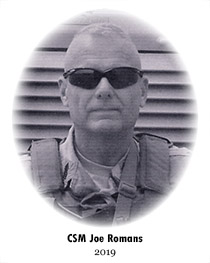
Command Sergeant Major Joe Romans enlisted in October of 1969, serving as a Corpsman with the Marine Corps for four years, followed by two years with the Navy Reserve.
Romans was the first Corpsman to attend the U. S. Marine Corps Non-Commissioned Officer (NCO) School at Camp Pendleton, CA in 1971.
He next served with a remote U. S. Air Force Radar Site as a Civilian Medical Technician in Arctic Alaska during the Cold War.
He enlisted in the Alaska Army National Guard Eskimo Scout Battalion in 1982, prior to transferring to the Kansas Army National Guard. He then served for 22 years in the Kansas Army National Guard. During that time, he graduated from every level of the Army Non-Commissioned Officer Education System, culminating with the Sergeants Major Academy.
He served as the NCO in charge of the Kansas National Guard Counter-Drug Special Operations Group, supporting Federal, State, and Local Law Enforcement agencies in counter-narcotics operations. He also served as the lead Instructor and NCOIC of the National Guard Bureau’s Counterdrug Ground Reconnaissance Training School.
Romans served during Desert Shield Desert Storm in 1990-91 as a M1 Tank crewman in the Gulf War. Romans deployed with the 5th Special Forces Group and Seal Team 3 as part of the Combined Joint Special Operations Task Force-Arabian Peninsula in Iraq during the surge in 2008.
His many assignments, at every unit level of the Army, culminated as the Command Sergeant Major of the 1st Bn, 635th Armor and as Commandant of the 235th Regional Training Institute NCO School.
During his career he served in the following campaigns or countries: Vietnam Era, Cold War Era, Operation Desert Shield/Desert Storm, Operation Joint Guardian, Operation Iraqi Freedom, Saudi Arabia, Kuwait, Kosovo, Macedonia, Japan, Germany, and Korea. He takes great pride in that he earned his Cavalry Spurs (Silver) from the 1st Bn, 635th Armor and his Cavalry Spurs (Gold) from the 3rd Bn, 32d Armor Regiment, 1st Cavalry Division, in Desert Storm.
Romans descended from an American Revolutionary War soldier, and is a member of the Sons of the American Revolution.
He pursued a career as an EMT, Paramedic, and Paramedic Supervisor for five years. He lived out one of his dreams in professional motor racing as a race car driver. His service to his fellow citizens continues today as a Jackson County Deputy Sheriff in charge of the school protection program and as a volunteer for the Civil Disaster Relief Organization “Team Rubicon.”
CSM Romans and his wife, Nancy, reside in Hoyt, Kansas, and have four children—Kyle, Debbie, Holly, and Joe, Jr., as well as three grandchildren.
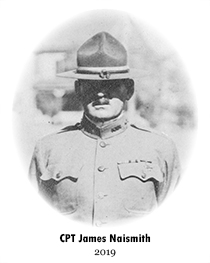
Chaplain (Captain) James A. Naismith was born on Nov. 6, 1861, in Almonte, Canada. He applied to be a Chaplain in the Kansas National Guard in 1916. The motivation for this was the same as that for devising the rules for the game of basketball—to help young people and guide them to their full potential.
After quickly obtaining an endorsement as a Presbyterian minister, Naismith was commissioned as a Captain and Chaplain in the 1st Kansas Infantry Regiment.
Naismith and the 1st Kansas mobilized at Ft. Riley in late June of 1916, and then spent nearly four months at Eagle Pass, Texas on the Rio Grande River where they assisted in keeping the Mexican-American border secure. Naismith’s duties during this time included the traditional roles of a chaplain—conducting services, counseling homesick soldiers, and advising his command on the spiritual needs of the unit. With his expertise in athletics, he organized numerous boxing matches, basketball games, and a baseball league to keep his soldiers occupied during their off-duty time.
The 1st Kansas prepared to return home in October 1916. They were released from Active Duty, and Captain Naismith returned to his duties at the University of Kansas and continued service in the 1st Kansas Infantry.
The 1st Kansas Infantry was mobilized in August of 1917 for World War I and was reorganized into the 35th Infantry Division. Captain Naismith wanted to continue his military service and applied for a commission as a U. S. Army Chaplain. However, he was 55 years old and was not an American citizen, so the option was denied. Naismith found another route by working as a volunteer chaplain for the YMCA.
In September, 1917, the YMCA sent Naismith to France, where he worked as one of the organization’s “overseas secretaries” in the war zone. Based out of Paris, Naismith spent most of his time near the front lines, working to improve the social hygiene of the troops. For his work he was ideally fitted, with his background as a clergyman, medical doctor, athlete, educator, and National Guardsman.
He always considered his time in uniform and his work with the soldiers of the U. S. Army to be among his most significant accomplishments.
Naismith and his wife, Maude, had five children. He passed away on Nov. 28, 1939, and is buried in Lawrence, Kansas.

Colonel Wayne L. Cline was born 10 August 1935, in Neodesha, Kansas. In 1953, shortly after graduation from high school, he enlisted in the Kansas Army National Guard (KSARNG) as a Private 1, beginning the life of military service. He attended Officer Candidate School at Ft Sill, Oklahoma commissioning 21 July 1959. He holds branch qualification in Field Artillery, Engineer, Transportation, and Aviation with broad experience in combat service support, combat support and combat units. His many assignments include Platoon Leader, Rotor Wing Aviator, Flight Commander, Operations Officer, Company Commander, Assistant Logistics Officer, Executive Officer, and Army Aviation Facility Commander.
He commanded one of the five Army National Guard Heavy Helicopter (sky crane) units in the nation. He then was tasked to start Kansas’ first Army Aviation Support Facility (AASF) at Forbes Field and commanded the AASF from 1972 – 1979. He served as AASF Commander from 1972 – 1979 and State Aviation Officer from 1979 – 1990. Wayne was the first full-time instructor pilot for the KSARNG, the first KSARNG aviator to fly helicopters in actual instrument weather conditions, the first rotor wing instrument examiner in the KSARNG, and fielded the first CH-54 Sky Crane company in the National Guard. He implemented a phase maintenance system for CH-54A helicopters, which was adopted world-wide, improving readiness 100%.
Wayne has approximately 10,000 accident-free flying hours, while flying sixteen different types of aircraft. His numerous awards include the Legion of Merit, Army Commendation Medal, State Emergency Duty Medal w/2 Award, and the Award for Army Excellence – the only Kansas National Guard Aviator to receive this award. Wayne and his wife Twila reside in Topeka and have three children, nine grandchildren, and 12 great grandchildren.
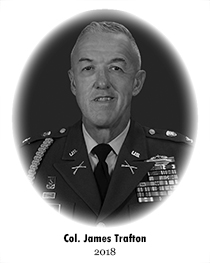
Colonel James E. Trafton was born 10 October 1951, in Nashville, Tennessee, where he attended elementary and high school. In 1971, shortly after graduation from high school, he enlisted in the U.S. Army as a Private, beginning a life of military service. Following initial training he was assigned to a Reconnaissance Platoon in the 1st Cavalry Division in Vietnam. He joined the Kansas Army National Guard where he served ten years as an enlisted man and as a Noncommissioned Officer, reaching the rank of Sergeant First Class. He graduated from the Kansas National Guard Officer Candidate School in 1982 commissioning as an Engineer Officer. He served in various positions including Engineer Platoon Leader, Operations Officer, Assistant Logistics Officer, and Commander, Headquarters and Headquarters Company, all with the 69th Infantry Brigade. On 23 November 2003 he became the Commander, 2nd Battalion, 137th Infantry transitioning from the M113 Armored Personnel Carriers to the M1A1 Bradley Fighting Vehicles. He led the battalion to Baghdad, Iraq serving under the 4th Infantry Division with responsibility for the Joint Visitor’s Bureau and security for the many high-level visitors that passed through Iraq. He was promoted to Colonel in 2006 and began his culminating assignment as the Kansas Army National Guard Strength Management Officer. He was well known as a “Soldier’s Soldier” and a natural leader, providing leadership, counseling, empathy, career advice, and an interest in the lives of his soldiers and their families. Upon retirement after 37 years of military service, he was inducted into the Kansas National Guard Officer Candidate School Hall of Fame. His numerous awards include the Legion of Merit, Bronze Star Medal (2nd Award), Meritorious Service Medal (4th Award), and the Combat Infantryman’s Badge (2nd Award-Star). Jim was married to Theresa for 17 years, had four daughters, and five grandchildren. Colonel James Trafton passed away 5 April 2010 and was buried with full military honors in the Leavenworth National Cemetery, Leavenworth, Kansas.
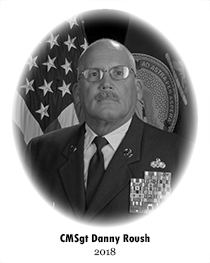
Chief Master Sergeant Danny M. Roush was born 2 November 1952 in Kansas City, Kansas. He graduated from Tonganoxie High School in 1970 and joined the 190th Civil Engineer Squadron, Kansas Air National Guard in 1973 as an Interior Electrician. He was assigned to the Interior Electric Shop remaining until 1984 rising through the ranks to Master Sergeant. He was selected as the Exterior Electric Shop supervisor serving three years. He was the Squadron First Sergeant from 1987 – 1991. He was the first Squadron member to attend the Air National Guard / Air Force Reserve First Sergeants’ Academy at Keesler Air Force Base, Mississippi. He was selected as the First Sergeant of the 1701st Strat Wing in Kuwait. Upon returning home he was promoted to Senior Master Sergeant and served as the Electrical Superintendent, 190th Civil Engineer Squadron and the Facility Manager 190th Air Refueling Wing. Danny was promoted to Chief Master Sergeant in 1995 and assigned as the Civil Engineer Manager, holding this position until retirement in 2012. He deployments include Kirkuk, Iraq in support of Iraqi Freedom, Camp Justice at Guantanamo, Cuba, and Haiti in support of humanitarian efforts after their earthquake. After serving 39 years in the Kansas Air National Guard he continued serving in the Kansas Division of Emergency Management. His numerous awards include Meritorious Service Medal with 1 Oak Leaf Cluster, Air Force Commendation Medal with 9 Oak Leaf Clusters, Humanitarian Service Medal, Military Outstanding Volunteer Service Award, Kansas Senior NCO of the Year, and Kansas Airman of the Year. Danny is heavily involved in the American Legion Post 125, the Veterans of Foreign Wars, and the Museum of the Kansas National Guard. Danny and his wife Carol reside in Lyndon and have two daughters and seven grandchildren.
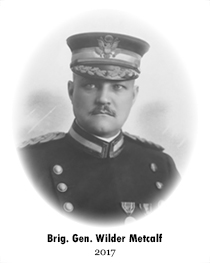
Brigadier General Wilder S. Metcalf was born at Milo, Maine, 1855. He was reared by
his family in Elyria, Ohio. He joined the Co G, 5th Ohio National Guard Infantry on May 6,
1884 at the age of 29. He served in his unit until July, 1886. In 1887 he came to Kansas and was
located in Lawrence, Kansas. He became a partner of Edward Russell in the farm mortgage
business. In 1888 he enlisted as a Private in Co H, 1st Kansas Infantry at Lawrence, Kansas,
rising in rank to Colonel over the next nine years. He was Colonel of the Regiment in 1898 when
the Spanish American War broke out.
He was commissioned a Major in the 20th Kansas Infantry, under Colonel Frederick
Funston. The 20th Kansas was mustered for Federal Service on May 9, 1898 at Topeka. Three
days later they were sent to Camp Merritt, California, at San Francisco. He later moved to
Indiana and steamed for Manila in the Philippines. They arrived and were encamped in the
tobacco warehouses. In 1899 the 20th Kansas was ordered to the front. The regiment advanced
on and was the first to enter Caloocan on February 10, 1899. In March, the regiment swam the
Tuliahan River, captured a blockhouse, and then was involved in the engagements of Malinta
and Maycuayan three days later. Upon Colonel Funston’s promotion to Brigadier General, Major
Metcalf was elected Colonel of the 20th Kansas. He was awarded the Order of Purple Heart in
recognition of being wounded twice.
On September 6, 1899 the war was declared to be over, and the 20th Kansas boarded
transports and steamed for the United States. Upon his return to Lawrence, Kansas, he again
became the Colonel of the First Kansas Infantry, and served until 1915, when , as part of a Civil
war in Mexico, Pancho Villa, a Mexican warlord attached to the 13th U.S. Cavalry. President
Woodrow Wilson ordered the mobilization of the National Guard to assist on the border. Led by
Colonel Metcalf they marched several miles into the desert and established camp. Colonel
Metcalf was appointed a Brigadier General of the National Army on August 22, 1917, and
honorably discharged on May 24, 1918. He was promoted to Brigadier General in the Kansas
National Guard on February 24, 1919.
General Metcalf was a delegate at large to the Republican National Convention in 1900
when McKinley and Roosevelt were nominated. In 1901 he was appointed by President
Theodore Roosevelt as United States Pension Agent in Topeka, Kansas. He was the only person
to hold the office for two terms. In 1909 he was appointed by Secretary of War as a member of
the National Militia Board. In 1916, while serving in the Philippines, he was elected for a seat in
the Kansas Senate. For eighteen years he served as a member of the Lawrence School Board and
for several years as its president.
His fraternal associations included being a Knight Templar and a Noble of the Mystic
Shrine in the Masonic Order. He was a member of the Benevolent and Protective Order of Elks,
the Army and Navy Club of Washington, D.C. , the University Club of Kansas City, the Topeka
Club, Phi Delta Phi, and Phi Gamma Delta. He also belonged to the Military Order of Foreign
Wars, the Spanish-American War Veterans, the Army of the Philippines, and the Military Order
of Carabas. During his lifetime he was listed in the “Who’s Who in America” listing for several
years.
The National Guard Armory at Lawrence, Kansas is named the Wilder S. Metcalf
Armory.
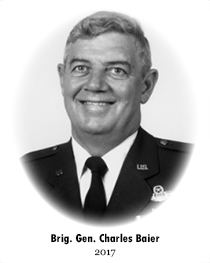
Brigadier General Charles M. Baier was born in Larned, Kansas in 1942. He grew up on
a farm near Seward, Kansas. After high school, Baier attended Fort Hays State College. In early
1963 the Kansas Air National Guard was recruiting pilots for the 190th Tactical Reconnaissance
Group at the Hutchinson Air National Guard base. He was commissioned as a second lieutenant
in 1963. He trained in the Air Force Undergraduate Pilot training program at Moody Air Force
Base, Georgia. He received his wings on March 28, 1966.
After graduating he returned to Kansas and qualified as a pilot flying the Martin RB-57A.
He was hired by TWA in 1967. His two careers complimented and enhanced each other, as the
basic skills were the same, even though the environment was vastly different. In 1972, the 190th
Tactical Reconnaissance Group received new aircraft, a new mission and a new designation. It
gained Martin B-57G aircraft for precision all weather night bombing and became the 190th
Tactical Bombardment Group. In 1974, they saw another transition to the 190th Defense
Systems Evaluation Group. 1977 brought some of the most significant changes to the 190th.
They became the 190th Air Refueling Group.
In 1980 he became the Commander of the 117th Air Refueling Squadron. In 1984, Baier
became the State Director of Operations at Kansas State Headquarters. In this position he
provided leadership and advice, not only to the 190th, but also to the 184th Tactical Fighter
Training Group in Wichita. Early on the morning of January 16, 1991 the communications
center notified Baier they had received an Immediate Flash Top Secret, “eyes only” message for
him. It was the notification that combat operations would commence the next morning. Desert
Shield was about to become Desert Storm. The pace was hectic for the next weeks. Baier flew
several refueling missions during both Desert Shield and Desert Storm. After several weeks of
intense operations, Operation Desert Storm ended. They returned home in March to a crowd of
over 10,000 people.
During his time as a group commander, Baier encouraged and expanded community
relations and involvement in the Air Guard’s mission and the importance of support of the
community. He was involved with the Chamber of Commerce, Metropolitan Topeka Airport
Authority Board of Directors. Baier was promoted to Brigadier General in the Kansas National
Guard on August 2, 1992. General Baier retired in 1993 after 30 years of service.
His awards include: Legion of Merit-1Oak Leaf Cluster, Meritorious Service Medal, Air
Force Commendation Medal, Air Force Achievement Medal, Air Force Outstanding Unit
Ribbon-1 Oak Leaf Cluster, Combat Readiness Ribbon –6 Oak Leaf Clusters, National Defense
Service Ribbon, Southwest Asia Service Medal-2 Bronze Stars, Kuwait Liberation Medal-
Kuwait, Kuwait Liberation Medal-Saudi Arabia, Aerial Achievement Medal, Air Force Overseas
Short Tour Ribbon, Air Force Longevity Ribbon-6 Oak Leaf Clusters, Armed Forces Reserve
Medal with Hour Glass Device, Small Arms Expert Marksmanship Ribbon, and Air Force
Training Ribbon.
He and his wife Jane reside in Lecompton, Kansas
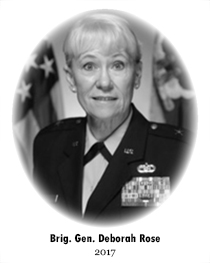 Brigadier General Deborah Rose entered military service with a direct commission into the United States Air Force Nurse Corps in March 1983, assigned to the 184th Tactical Fighter Group. She transferred to the 190th Clinic in December 1985. In October 1990, she deployed to Jeddah, Saudi Arabia, where she served in an Air Transportable Hospital during Desert Shield. In February 1991, she was activated and deployed to Offutt AFB, Nebraska, assigned to the hospital.
Brigadier General Deborah Rose entered military service with a direct commission into the United States Air Force Nurse Corps in March 1983, assigned to the 184th Tactical Fighter Group. She transferred to the 190th Clinic in December 1985. In October 1990, she deployed to Jeddah, Saudi Arabia, where she served in an Air Transportable Hospital during Desert Shield. In February 1991, she was activated and deployed to Offutt AFB, Nebraska, assigned to the hospital.
In April 1994, the 190th leadership requested she fill a critical leadership position as the Services Flight Commander, leaving the professional corps for a line position. In 1996, she transferred from her fulltime position at the Colmery-O’Neil VA Medical Center, where she had served for 14 years, to become the Logistics Squadron Commander, serving as a military technician.
In 2000, she became the Aircraft Maintenance Squadron Commander. In October 2001, she became the Mission Support Group Commander, and in April 2002, became the first female Colonel in the Kansas National Guard. In February 2003, she was activated to become the deployed Mission Support Group Commander for the 171 st Expeditionary Wing, leading a team of Active Duty, National Guard, and Civilians, into Afyon, Turkey. Their pre-Operation Iraqi Freedom tasking was to complete the bed down plan for a deployed KC-135 Wing. She remained there until the beginning of the war. Subsequently, her team was extracted when the Turkish Parliament declined the use of Turkey as a staging area for the war. Hers was the only team led by an Air National Guardsman.
In 2004, she became the Vice Wing Commander where she remained until her promotion to Brigadier General in 2007, when she became the Director of the Joint Staff, Joint Forces Headquarters-Kansas. She is the first female in the Kansas National Guard to be promoted to the rank of Brigadier General. In November 2010, General Rose was assigned in a dual hat position as the Air National Guard Assistant to the Commander of the 17 th Air Force, the Air Force component of the United States African Command. General Rose retired in September 2011, having served 28 ½ years.
General Rose holds a Bachelor of Science Degree in Nursing from Washburn University in Topeka, KS, and a Master of Science Degree in Nursing from Wichita State University, Wichita, KS. She received an Honorary Doctorate Degree in Public Service from Washburn University in Topeka, KS.
Her military education includes, but is not limited to the following:
Marine Corps Command and Staff College, Air Command and Staff College, and Air War
College.
General Rose’s major awards and decorations include the Legion of Merit, Meritorious Service Medal, Air Force Commendation Medal, Air Force Achievement Medal, National Defense Service Medal, Armed Forces Expeditionary Medal, Southwest Asia Service Medal, Global War on Terrorism Expeditionary Medal, Kuwait Liberation Medal Government of Kuwait, Kansas National Guard Commendation Ribbon, Kansas National Guard Achievement Ribbon, and the Kansas National Guard Kansas Emergency Duty Ribbon.
General Rose has been an active member of the community, serving as a board of director, and in leadership positions of the following organizations: Topeka YWCA, Stormont-Vail Foundation, Washburn University Foundation, National Guard Association of Kansas, and Kansas STARBASE. She has been the church accompanist at the Overbrook United Methodist Church for over thirty years.
She and her husband, Col. (Ret.) Joe Rose, reside in rural Overbrook on the family century farm. They have two children, Jessica (Andy) Frye and Joe (Jessica) Rose III, and six grandchildren.
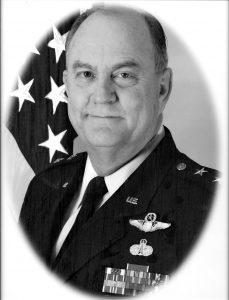
In 1968 while attending the Wichita State University’s R.O.T.C. program, General Axtell joined the Kansas Air National Guard and received a direct commission in May 1969. He received Pilot training at Reese Air Force Base from July 1969 until July 1970. Afterwards he attended F-100 Combat Crew Training School with the 162nd Tactical Fighter Group, Arizona Air National Guard, Tucson, AZ and was in the first F-105 Combat Crew Training School class conducted by the KSANG, 184th Tactical Fighter Group, McConnell AFG, Wichita, KS receiving honors and graduating as the Outstanding Graduate, in 1972.
General Axtell became a full-time technician with the KSANG as an F-105 Instructor Pilot in 1973 with the 184th Tactical Fighter Group. During this time he served as an academic, simulator and flight instructor. He moved through a succession of positions, from Life Support Officer to Squadron Operations Officer to Chief of Academics.
In 1979 he transitioned to the F-4 Fighter by attending upgrade training with the 426th Tactical Fighter Training Squadron at Luke AFB, AZ. He also resumed his college education, graduating with a Bachelor of Science Degree in Aeronautical Engineering in 1977.
Other assignments include Deputy Commander, Resources and the Air National Guard Advisor to the Air Force’s Tactical Air Command for Plans and Operations at TAC Headquarters at Langley AFB, Virginia. He was responsible for advising the Staff on policies, plans and programs. He also coordinated issues between TAC-gained ANG units, States Adjutants General, National Guard Bureau, ANG Support Center and TAC. Additionally he coordinated war plans, exercises and deployments.
In 1990 General Axtell returned to Kansas as the Commander of the Smoky Hill Weapons Range, 184th Tactical Fighter Wing, Salina, Kansas. During this time he resumed his flying career in F-16 Fighter Aircraft as an Instructor Pilot. While at the 184th he led the unit to the best ever Unit Effectiveness Inspection with the ultimate reward as the Outstanding Unit Award, the first ever awarded to a gunnery range.
After a short stint as the Director, Fighter Forces for the ANG, Andrews AFB, DC, he was selected as Commander of the 184th Fighter Group which converted to a heavy bomber unit, the first ANG unit in the nation to receive the B-1B Bomber.
In 1997 General Axtell was appointed as the Chief of Staff for the KSANG. In 2000 he was appointed as the Assistant Adjutant General-Air for Kansas. In 2003 he was selected as the ANG Assistant to the Commander, Air Force Space Command, Peterson AFB, Colorado.
His awards and decorations include the Legion of Merit, Meritorious Service Medal with three Oak Leaf Clusters and numerous other Air Force and Kansas National Guard Awards.
He lives in Wichita, KS with his wife Joleen. They have one daughter, Alecia and Husband Chris who have two children. They have one son Eric and wife Regan and three children.
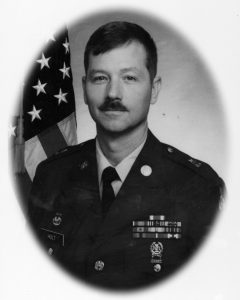 Sergeant Major Lynn E. Holt built his distinguished Kansas Army National Guard career developing strength, retaining Soldiers and insuring Soldiers received proper training. He served from the Detachment through State level. He is known for his ability to recognize Soldier needs at all levels. The same care he felt for Soldiers carried over into his community activities. SGM Holt’s passion for people and their needs exemplifies his true character. He devoted his entire adult life to the betterment of our nation, our state and the Kansas National Guard.
Sergeant Major Lynn E. Holt built his distinguished Kansas Army National Guard career developing strength, retaining Soldiers and insuring Soldiers received proper training. He served from the Detachment through State level. He is known for his ability to recognize Soldier needs at all levels. The same care he felt for Soldiers carried over into his community activities. SGM Holt’s passion for people and their needs exemplifies his true character. He devoted his entire adult life to the betterment of our nation, our state and the Kansas National Guard.
Lynn Edward Holt, born 27 July 1951 in Topeka, Kansas, graduated from Topeka High School in 1969. Soon after graduating he enlisted in the Kansas Army National Guard with Company A 169th Support Battalion as a cook. He completed his basic and AIT at Ft. Leonard Wood, Missouri in 1971.
Shortly after returning from basic he became the Unit Supply Specialist until May 1973. He assumed the duties of Unit Supply Sergeant and was employed as the Unit Administrative Supply Technician where he was promoted to Sergeant. He was promoted in May 1974 to Staff Sergeant in the same assignment.
In July 1977 he was assigned as the Personnel Supervisor, Record Section, 69th Infantry Brigade Adjutant General Section and promoted to Sergeant First Class in April 1978 and Master Sergeant in 1982.
MSG Holt transferred to HHC, 35th Infantry Division at Ft. Leavenworth, Kansas in October 1985 where he served as the Replacement Detachment Supervisor. August of 1992 he transferred to HQ STARC in Topeka and promoted to Sergeant Major. After graduating from the United States Sergeants Major Academy in 1995 he was assigned as the Personnel Sergeant Major in the Directorate of Personnel Office. In 2001 he was assigned as the HQ STARC TDA Battalion Sergeant Major until he retired in December 2003.
SGM Holt’s military training includes: Basic Combat Training, Advanced Individual Training, NCO Academy, Admin Supply Technician Course, USAR Senior NCO Course, US Army Professional Development Course, Personnel Senior Sergeants Course, NCOES Advanced Course, US Army Pre-Commission Course, Military Personnel Officers Course, Personnel/Administration Technician Course, Adjutant General Officer Basic and Advanced Course, and the United States Army Sergeants Major Academy.
Lynn Holt served his community as president Tecumseh North Elementary School Parent Teachers Organization; Coach, Fundraiser and Building Committee Shawnee County Amateur Baseball Association; Coach and Manager Dorrnwood Girls Softball Association; former Tornado Spotter Kaw Valley Amateur Radio Club; Assistant Chapter Dad DeMolays; THS Reunion Committee Class of 69 from 1989 to present; Arab Shrine Past Potentate- 2005, Arab Shrine Clown, and past president Arab Shrine Past Potentates Association 2011 and it’s Secretary Treasurer since 2012.
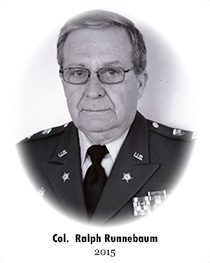 Ralph Runnebaum enlisted as a Wrecker Operator in Company D, 169th Support Battalion, 69th Infantry Brigade on 13 January 1964. He completed his basic and advanced individual training at Fort Leonard Wood, MO and Fort Carson, CO in August 1964. After completing Kansas National Guard Officer Candidate School he was commissioned a Second Lieutenant in July 1966. Lieutenant Runnebaum attended the Ordnance Officer Basic Course from January thru March 1967 before returning to Company D, 169th Support Battalion as a Platoon Leader. In April1968 his unit was mobilized and he was sent to Fort Carson, CO until being deployed to Vietnam and assigned as the Battalion Maintenance Officer, 7th PSYOP Battalion, USARPAC Vietnam. He continued this assignment until December 1969.
Ralph Runnebaum enlisted as a Wrecker Operator in Company D, 169th Support Battalion, 69th Infantry Brigade on 13 January 1964. He completed his basic and advanced individual training at Fort Leonard Wood, MO and Fort Carson, CO in August 1964. After completing Kansas National Guard Officer Candidate School he was commissioned a Second Lieutenant in July 1966. Lieutenant Runnebaum attended the Ordnance Officer Basic Course from January thru March 1967 before returning to Company D, 169th Support Battalion as a Platoon Leader. In April1968 his unit was mobilized and he was sent to Fort Carson, CO until being deployed to Vietnam and assigned as the Battalion Maintenance Officer, 7th PSYOP Battalion, USARPAC Vietnam. He continued this assignment until December 1969.
After his release from active duty, Lieutenant Runnebaum returned to the Kansas National Guard and served in a number of assignments, including Platoon Leader, Company Commander, S-1, and Executive Officer in the 169th Support
Battalion. He served in several principal staff positions before being selected to Command the 287th Maintenance Battalion in July 1985. After over three years of command, he was assigned to several staff positions including S-2/3, Executive Officer, and Deputy Chief of Staff in Headquarters, Troop Comnr1and, Kansas Army National Guard. In Apri11992, Colonel Runnebaum was selected as Commander of Troop Command.
Colonel Runnebaum served over two years in this command assignment before being assigned as the Chief of Staff, Headquarters, State Area Command. During this period he also represented the Kansas National Guard on the Fort Riley Council of Colonels. He retired from the Kansas Anny National Guard in September 1996 with over thirty-two and one half years service.
Although Colonel Runnebaum held many principal staff and command assignments at the company, battalion, brigade and higher levels his legacy will more than likely be his contribution to the Maintenance programs of the Army National Guard and the United States Army. One endorser states that Ralph has broader recognition than anyone in the active Army or National Guard in the logistics and maintenance field.
In addition to the many assignments listed in his biography, Colonel Runnebaum was the director of the MATES (Mobilization and Training Equipment Site) at Fort Riley for thirteen years. He hosted hundreds of units over the years, both active and reserve. Every commander who ever drew equipment at the MATES knew they were getting the best maintained equipment to train with. It was during this time and through the leadership of Colonel Runnebaum that the MATES was expanded making it one of the finest maintenance facility in the entire Army National Guard.
Upon his retirement from the National Guard, Ralph become the civilian Site Manager for the RETRO Europe Maintenance. This was a Congressional mandated program to return all of the pre-positioned equipment that was stored in Europe as contingency stock for mobilizing units. This equipment including trucks up to 20 tons, artillery track vehicles, M-1 tanks and heavy equipment transporters to be repaired and distributed to Guard, Reserve and active Army units. Ralph lead the charge to establish one of these Sites in Kansas. Kansas was one of four states selected out of eighteen states that competed. This program not only filled equipment shortages, but provided up to 87 full time employee positions and an increase in funding level from six million to eight million dollars annually.
In 1998 the National Guard Bureau established the Readiness Sustainment Maintenance Program to fill equipment on hand and increase equipment readiness throughout the entire Army National Guard. Once again Ralph chaired the committee and presented a business plan to establish a facility in Kansas. After the bidding process, Kansas was the first facility sel4~cted. Starting out in older buildings obtained from Fort ·Riley and using maintenance tents, this facility soon employed up to 220 full time maintenance employees. It was the first sift~ in the nation to meet all standards established by the International Standards Organization. By using savings from an efficiently managed budget three new maintenance structures were built. The annual budget for the Kansas Site increased to 22 million.
Colonel Runnebaum ‘s success in the maintenance community was now well established and the National Guard Bureau was needing an Oversight Manager for the Readiness Sustainment Maintenance Program. Ralph was selected and the became responsible for the overall operations of five and on occasion seven RSMP sites to include the Kansas Advance Turbine Engine Maintenance (THE A TEAM) also located at Fort Riley. These sites were located in seven different states. The overall budget varied between 120 million and 240 million dollars. Ralph served for over ten years in this capacity and retired again in 2011.
Ralph has also represented the National Guard well in the communities he served. He is very well known in the community as well as several veterans organization in which he is an active member. He is a supporter of the Museum of the Kansas National Guard and has been a m1ember of the Museum Maintenance Crew for several years. His membership and accomplishments are include in an addendum to his biography.
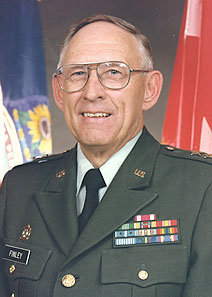 Philip B. Finley
Philip B. Finley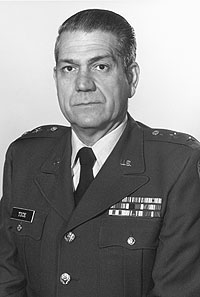 Ralph T. Tice
Ralph T. Tice
Kansas’ 30th Adjutant General
October 01, 1980 – October 17, 1987
Major General Ralph T. Tice began his military career on May 1943 when he enlisted in the U.S. Army. He served overseas in the Pacific Theater with the 78th Engineer Combat Battalion 1944-1945. Following the termination of hostilities, he was assigned to the 8th Engineer Combat Squadron in Tokyo, Japan. He returned to the United States in July 1946, was released from active duty in October, and assigned to the Officer Reserve Corps, 835th Aviation Engineer Battalion.
General Tice joined the Kansas Army National Guard in March 1950 as a First Lieutenant with the 35th Division Artillery. He later served with the 127th Artillery Group and Headquarters, Kansas Army National Guard. He was appointed Commanding General, 69th Infantry Brigade, and promoted to Brigadier General in July 1977. He served in this capacity until being appointed as The Adjutant General of Kansas in October 1980. He was promoted to Major General in March 1981.
As a civilian, General Tice first began working for the National Weather Service in Topeka, in 1941 and then returned to the Weather Service after his military active duty in 1947. He retired from the National Weather Service in Kansas City, Missouri, as Chief of the Observations Branch, Central Region Headquarters, in March 1979.
His military awards and decorations included the Distinguished Service Medal, Legion of Merit, Meritorious Service Medal, Army Commendation Medal, Good Conduct Medal, American Campaign Medal, Asiatic Pacific Campaign Medal, World War II Victory Medal, American Occupation Medal, Philippine Liberation Medal, Armed Forces Reserve Medal, Army Reserve Components Achievement Medal, Kansas State Service Medal and the Distinguished Service Medal of the National Guard Association of the United States.
General Tice was a member of the Veterans of Foreign Wars; American Legion; Topeka Optimist Club; American Meteorological Society; National Association of Federal Retirees; and Masonic Lodge and Shrine. He was Chairman of the Committee on Logistics and Facilities, and a Committee Member on the Personnel and Manpower Committee, Adjutants General Association of the United States. In addition, he was also a member and past president of the National Guard Association of Kansas and served on the Executive Council at the National level and a member and past president of the Topeka Chapter of the Association of the U. S. Army. General Tice was the President of Topeka Chapter 086, Military Order of World Wars; and a former member (at the National level) of the Army Reserve Forces Policy Committee; and of the Military Affairs Committee, and the Topeka Chamber of Commerce.
Major General Ralph T. Tice was born on February 23, 1924 in Topeka. He graduated from Seaman High School and attended Washburn University, the University of Florida, Pennsylvania State University, and received a BA from Columbia College. He died October 5, 1994 and is buried at Memorial Park Cemetery in Topeka, Kansas.
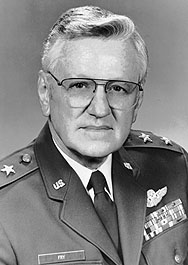 Edward R. Fry
Edward R. Fry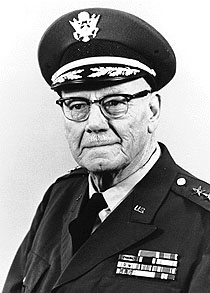 Joe Nickell
Joe NickellRetired Col. William “Bill” Vonderschmidt was born in Falls City, Nebraska, and attended Hiawatha High School, graduating in 1964. He enlisted in Headquarters and Headquarters Battery, 2nd Battalion, 130th Field Artillery Sept. 30, 1965.
In the spring of 1968, he was attending the Kansas National Guard Officer Candidate School when his unit was mobilized for federal duty. OCS Class Number 12 was accelerated and Vonderschmidt was commissioned a second lieutenant and reported for active duty on May 13, 1968, along with many other Kansas Guardsmen. While on active duty, he completed the Field Artillery Officer Basic Course and the Jungle Operations Training Course, after which he was sent to Vietnam and assigned to the 1st Infantry Division as a forward observer and aerial observer from January through December 1969.
Vonderschmidt completed the Field Artillery Advanced Course in 1978 and the Command and General Staff College Nonresident Course in 1985 and many other military schools.
His assignments included various staff positions and commander of Battery B, 2nd Battalion, 130th Field Artillery. He also served as the commander of the 1st Battalion, 127th Field Artillery and commander of the 130th Field Artillery Brigade and several positions within the 35th Division Artillery.
Vonderschmidt was also branch qualified as an engineer officer. He held numerous staff assignments, including the director of Facilities Engineering for the State Area Command for nearly eight years. He was assigned as the deputy commander of State Area Command in July 1999 and later as the deputy commander of the Kansas Army National Guard and his final assignment was the chief of the joint staff, Joint Forces Headquarters Kansas – Land Component, Kansas National Guard. Vonderschmidt retired in 2006 with more than 40 years of commissioned and enlisted military service.
Among Vonderschmidt’s awards are the Silver Star, Legion of Merit, Bronze Star, Meritorious Service Medal with oak leaf cluster, Air Medal with six oak leaf clusters, Army Commendation Medal with oak leaf cluster, Air Force Commendation Medal, Vietnamese Service Medal with four Silver Stars, Vietnamese Cross of Gallantry with Palm Citation, Air Crew Wings, and numerous other awards and decorations.
Vonderschmidt is active in many organizations within his community. Recently, he served as the president of the Brown County Chapter of Quail Forever, which provides youth hunting education, clay shooting and fishing derby opportunities. He was instrumental in establishing a new game habitat for the Klinefelter Farm of Highland Community College. He has been involved in the honor guard of Brown County. He is also involved with the community Memorial Day service, Veterans Day Celebration and is a frequent speaker at his church.
COL Vonderschmidt and his wife, Carol, reside in Hiawatha, Kansas.
 Milton Robbins McLean
Milton Robbins McLeanRetired Command Sgt. Maj. Dale L. Putman was born Oct. 14, 1945, in Junction City, Kansas, and graduated from White City High School in 1964. Soon after graduation he enlisted in the Kansas Army National Guard with the 242nd Engineers, which in 1965 became the 169th Engineer Company, Bridge Platoon.
He completed his Basic Training and Advanced Individual Training at Fort Leonard Wood, Missouri. He was mobilized for federal service with the 69th Brigade in 1968 assigned to Fort Carson, Colorado. He returned home and received an honorable discharge on Aug. 6, 1970.
Putman re-enlisted on Nov. 27, 1974, in his old company, the 169th Engineers, as a maintenance squad leader and was promoted to staff sergeant as a combat construction foreman in 1976. In 1978 he was promoted to sergeant first class as the operations sergeant and then was made first sergeant and promoted in 1981. In 1985 he served as the sergeant major of the 891st Engineer Battalion becoming the command sergeant major in 1986. In 1987 he became the command sergeant major of the 69th Infantry Brigade and in 1996 the command sergeant major of the 130th Field Artillery Brigade.
In 2003 he became the first command sergeant major of the Joint Forces Headquarters Kansas-Land Component. On Feb. 5, 2006 he returned to active duty as the command sergeant major senior mentor with the Headquarters Security Support Command, Combined Security Transition Command, Afghanistan, where he mentored his Afghan National Army counterparts in conducting daily security operations for the president and defense minister of Afghanistan. He retired from the military March 16, 2007, after serving almost 39 years.
Putman’s military decorations include the Legion of Merit, Bronze Star, Meritorious Service Medal with oak leaf cluster, Army Commendation Medal with oak leaf cluster, Army Achievement Medal, Good Conduct Medal, Nation Defense Service Medal with three Bronze Stars, Armed Forces Reserve Medal with M-device, Army Reserve Components Achievement Medal with three oak leaf clusters, Afghanistan Campaign Medal, Global War on Terrorism Service Medal, Overseas Service Ribbon, NATO Medal and numerous other awards and decorations.
Putman has been an avid member of the Flint Hills Beef Fest for many years, serving as president and is a current board member. He has done several radio interviews and a TV interviews promoting the beef industry. For several years he served as a 4-H leader and countywide coordinator in Lyon County, establishing the bucket calf competition and is still a 4-H sponsor. He volunteers his time for the Emporia Community Foundation and Bowyer 79 Fund golf tournament and auction.
As a member of IBEW 304, he has been a judge for the International Lineman’s Rodeo competition each year. As a former competitor, he was a member of the International Lineman’s Rodeo Senior Division Championship team in both 1995 and 2004. He received the prestigious IBEW Life Saving Award in 1990 for helping save the life of a fellow lineman.
He is a life member of the Noncommissioned Officers Association of the United States of America and a Life Member of the Enlisted Association of the National Guard of Kansas, serving as a vice president of the Army. He is a life member of the Enlisted Association of the National Guard of the United States, a lifetime member of the 35th Division Association, serving as its president in 2014, and also a lifetime member of the Fifth Army Association. He is a member of the Association of the United States Army, the Veterans of Foreign Wars, and past member of the board of directors for the Kansas National Guard Hall of Fame and the Kansas National Guard Foundation Board. He is a Perpetual Sustaining Member of the Museum of the Kansas National Guard.
He and his wife, Judy, reside in Emporia, Kansas.
BG R. Neill Rahn was born March 25, 1875, at Clay Center, where as an adult he was engaged in the general mercantile business. While residing in Clay Center he enlisted in Company H, 4th Infantry, Kansas National Guard. In 1908, he was appointed First Lieutenant of Infantry. Moving to Topeka, he was appointed Assistant Adjutant General of Kansas in 1911 with the rank of colonel, which he held for nine years except during World War I, where he served in the Office of the Provost Marshal General in Washington. He was appointed Adjutant General of Kansas in 1923 and promoted to brigadier general the same year. He also served as: Chief Deputy United States Marshal, Chief of Protective Division of the Kansas Banker’s Association.
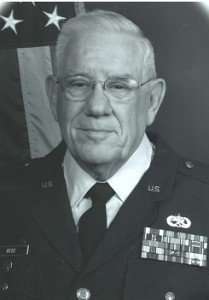 Lt. Col. Webb enlisted in the 127th Fighter Group, Kansas Air National Guard, at McConnell Air Force Base, Wichita, Kansas on 23 August 1956. He attended U. S. Air Force Basic Training in San Antonio, Texas followed by the Aircraft Maintenance School in Amarillo., Texas. After graduation from the Technical School, he returned to the 127th Fighter Group and became a full-time Technician as a jet aircraft mechanic on the flight line.
Lt. Col. Webb enlisted in the 127th Fighter Group, Kansas Air National Guard, at McConnell Air Force Base, Wichita, Kansas on 23 August 1956. He attended U. S. Air Force Basic Training in San Antonio, Texas followed by the Aircraft Maintenance School in Amarillo., Texas. After graduation from the Technical School, he returned to the 127th Fighter Group and became a full-time Technician as a jet aircraft mechanic on the flight line.
In May of 1962 Sergeant Webb volunteered to cross train in the Personnel Section and after 60 days Technical Sergeant Webb was asked to become a Personnel Technician. Through the next several years, with his outstanding leadership and his training of other personnel, he became the Superintendent for the 184th Personnel Section. It was in this position that Sergeant Webb would experience one of his biggest challenges.
On 26 January 1968 the 184th Tactical Fighter Group was called to active duty. Sergeant Webb and his personnel were responsible for the initial processing, re-enlistment, and separation for those personnel who did not have enough time left on their enlistments to complete the 24 months of active duty. By the middle of June, 1968, notice was received from the Tactical Air Command, U. S. Air Force, that a total of 400 personnel, to include officers, pilots, and enlisted personnel, would report to Kunsan Air Base, Republic of South Korea, for a 12-month tour of Active Duty. The remaining personnel would be assigned to other bases around the United States. Master Sergeant Webb and his personnel were responsible for all assignments and preparing orders for all personnel within two weeks. It was accomplished in an outstanding manner in 10 days. After completion of this task, MSgt Webb and four of his NCO’s were sent on early deployment to Kunsan Air Base to establish the in-processing of not only the 184th personnel, but also personnel form the 166th Fighter Group from Lockbourne Air Force Base, Ohio. Because of his knowledge of what had to be accomplished in accordance with Air Force regulations, MSgt Webb insured this process was accomplished without a hitch. During his tour at Kunsan Air Base, MSgt Webb and one other Master Sergeant were selected for promotion to Senior Master Sergeant, E-8.
In June of 1969, after nine months in South Korea, SMSgt Webb was selected by the Adjutant General of Kansas, Major General Edward R. Fry, to return to Wichita, Kansas to reconstitute the unit prior to the entire unit returning. After his release from Active Duty, he reverted to his Technician position as the Personnel Superintendent. Late in 1969 SMSgt Webb was recruited by Brig Gen “Speck” Gardner to move to the State Headquarters, as the Personnel/Administrative Superintendent for all of the Kansas Air National Guard. He would also be assigned numerous additional duties while on staff at the State Headquarters.
In this position SMSgt Webb was selected to attend the Air National Guard Academy of Military Science (AMS) and completed the six-week course leading to his commissioning as a Captain in the United States Air Force and the Air National Guard on 15 February 1973. Captain Webb was selected by name by the National Guard Bureau on several occasions to assist in rewriting Personnel Regulations and to assist in the update of officer master personnel records prior to arranging their movement to the Air Reserve Personnel Center in Denver, Colorado. He was asked on numerous occasions by the NGB to assist with various projects because of his knowledge and skills in the personnel area.
On 8 July 1977 he was promoted to Major and assigned as the 190th Combat Support Squadron Commander. In 1981 he became the full time Comptroller of the 190th Air Refueling Wing. He was promoted to Lieutenant Colonel on 16 September 1983.
He retired on 31 December 1987 after 31 years of military service with the following awards: Meritorious Service Medal, Air Force Commendation Medal, Air Force Achievement Medal, Air Force Outstanding Unit Award, Air Force Good Conduct Medal, Air Reserve Forces Meritorious Service Medal with 3 Oak leaf Clusters, National Defense Service Medal, Armed Forces Expeditionary Medal, Korean Defense Service Medal, and other awards. He also received the Kansas National Guard Association Distinguished Service Medal.
Lt Col Webb and wife, Arlene Joan Webb, live in Silver Lake, Kansas and have three sons: Dr. Craig Alan Webb and spouse Debbie, Scott Brian Webb and spouse Rhonda, and Captain Eric Robert Webb and spouse Jeni. They also have nine grandchildren and four great-grandchildren.
CW4 Cornelius Vandermotten was born in Glasgow, Scotland on 16 June 1933. His career spans over forty years of military service to his state and nation plus nearly two decades in the Kansas Army National Guard.
He graduated from Holyrood Catholic High School and departed Glasgow on 10 January 1951, arriving in the United States of America on 18 January 1951. After living in Wichita for two years, he enlisted in the United State Army on 5 June 1953 and was sent to Fort Riley, Kansas for Infantry Basic (Heavy Weapons) Training. After Basic Training, he was sent to Ft. Bragg, North Carolina, serving first in the 505th Airborne Infantry Regiment and later in the 15th Field Hospital. When released from active duty he was assigned to the USAR Control Group (Reinf).
Chief Vandermotten, known to everyone in the National Guard as “Van,” enlisted in the Kansas Army National Guard in October of 1955. His career in the Guard and Reserve would last for 38 years. His assignments in the 137th Infantry Regiment included First Sergeant in the Headquarters Company. He also served as a Master Sergeant in thethe 1st Battle Group, 137th Infantry.
Van became a naturalized citizen of the United States of America in 1959. He transferred to the 226th Engineer Battalion in February of 1962, serving as the First Sergeant. In 1963 he became the Personnel Warrant Officer in the unit. He also served as the unit Recruiting Officer and raised the unit to 100% strength and the unit remained at full strength during his assignment. The Adjutant General gave approval for Van to be the Officer-In-Charge of HHD, 226th Engineer Battalion as a Warrant Officer, normally a position only held by a commissioned officer.
Chief Vandermotten became the Facility Manager of Nickell Barracks Training Center (NBTC) in March of 1975. His devotion to improving the training center led to a huge build up of ranges and facilities, which were used many times by units of the active Army, Marines, and Air Force, as well as Reserve and National Guard units from Kansas, Missouri, Colorado and North Dakota. Without his vision and desire to make NBTC an outstanding training site it is doubtful whether the Kansas Regional Training Center would have ever developed.
Van remained in this position for over thirteen years and also continued to teach and mentor soldiers as much as possible. In May of 1990 Van transferred to the 5048th United States Army Reserve School and remained in that unit until his retirement from the military in June of 1993. During his time at Nickell Barracks, he also served as an instructor for many of the Officer Candidate School classes.
CW4 Vandermotten’s military awards include the Legion of Merit, the Meritorious Service Medal, the Army Commendation Medal, the Army Achievement Medal, the Good Conduct Medal, the Army Reserve Component Achievement Medal with Silver Oak Leaf Cluster, the National Defense Service Medal, the Armed Forces Reserve Medal with Gold and Bronze Hourglass Devices, the Army Service Ribbon, the Kansas National Guard Service ribbon with three Sunflower Devices, and the Army National Guard Recruiter Badge. He was also awarded the Honorable Order of Saint Barbara from the U. S. Army Field Artillery Association and the Bronze Order of the De Fleury Medal from the Engineers.
Mr. Vandermotten lives in Salina with his best friend, Gig Vandermotten and they have three grown daughters: Linda Kay Hall, Janelle Lee Heiser, and Connie Jean Lehman.
Command Sergeant Major Jana Harrison has the distinction of being the first female Command Sergeant Major in the Kansas Army National Guard. However, her contributions to this organization exceed that distinction. She was an exceptional NCO, a proven combat leader, and an avid trainer who found strength and value in every soldier.
CSM Harrison enlisted in the Kansas Army National Guard in 1975 in the 69th Infantry Brigade as a Private and culminated her career as the Command Sergeant Major of the 169th Corps Support Battalion. Her hard-charging service set the example for all future females in the Kansas Army National Guard. This leadership benefited all members of the Kansas Army National Guard, both male and female for over 30 years.
Until her retirement in April of 2006, CSM Harrison served in many capacities–first as s a traditional soldier, then as a National Guard technician, and finally as an Active Guard & Reserve (AGR) soldier. She trained in three different career fields (administration, chemical, and transportation) and became an expert in each. She was known throughout the state as a tough NCO who demanded high standards and refused to accept mediocrity. Her tough, mission-oriented mindset was balanced by a caring spirit that found the best in every soldier and encouraged many to pursue careers in the Kansas National Guard.
CSM Harrison’s care for individuals changed peoples’ lives and improved the units to which she was assigned. Her mentoring of junior soldiers, NCOs, and young officers developed a generation of leaders who led Kansas Army National Guard units to excel in both peacekeeping missions and the wars in Iraq and Afghanistan.
When deployed, CSM Harrison’s battalion led four active component logistrical units in successful missions, including delivery of 35 million gallons of fuel, one million convoy miles driven, thousands of maintenance work orders completed, and humane and efficient handling of hundreds of human remains. Her leadership also impacted the U. S. Air Force, as two of the soldiers which she mentored transferred to the Reserve and excelled on combat tours.
She even helped the U.S. Navy, by raising a son who enlisted and is currently serving as an Information Technology Specialist. In addition, after her retirement she continues to serve on a training team that prepares Active and Reserve units for their deployments overseas, ensuring that another generation of soldiers is prepared for combat.
With her husband Roger, Jana’s contributions reach into the civilian community by bringing hope to homeless families, sending young people to college, and enhancing the quality of life for many. She and her family have contributed countless hours and many dollars to agencies such as Leavenworth Parks and Recreation by coaching youth sports, and founding the Lanterne Rouge program promoting charity and safety at youth athletic events, veterans groups, and others.
Her military awards include the Legion of Merit, the Bronze Star Medal, the Meritorious Service Medal (5th Award), the Army Commendation Medal (5th Award), the Army Achievement Medal (2nd Award), the Good Conduct Medal (6th Award), the Army Reserve Component Achievement Medal (4th Award), the National Defense Service Medal, the Armed Forces Reserve Medal (2nd Award) the NCO Proficiency Development Ribbon (with Numeral 4 Device), the Army Service Ribbon, the Army Reserve Component Overseas Training Ribbon, the Kansas National Guard Meritorious Service Ribbon, the Overseas Service Ribbon, the Reserve Component Overseas Training Ribbon, the Armed Forces Reserve Medal with “M” Device, the Global War on Terrorism Service Medal, the Iraq Campaign Medal, the Kansas National Guard State Emergency Duty Service Ribbon, and the Kansas National Guard Service Medal (Class III).
CSM Harrison and her husband, Roger, a Vietnam veteran, live in the Leavenworth, Kansas community. They have raised three boys: Sam, Charlie, and Randy.
 Charles S. Huffman, M.D.
Charles S. Huffman, M.D.Lt. Governor of Kansas
Kansas State Senator
BG Charles S. Huffman was born in Vincennes, Indiana, October 8, 1865. Doctor Huffman served as assistant surgeon, with the rank of captain, in the Twentieth Kansas Regiment during the Spanish-American and Philippine Wars, having enlisted in April, 1898. He was a member ofColonel Funston‘s staff. He spent eighteen months in the service, and was mustered out at San Francisco, October 28, 1899.
His early youth was spent in the vicinity of old Vincennes, and he attended the public schools there, graduating from high school in 1883. Doctor Huffman was one of the early settlers in Cherokee County, having come to Kansas soon after leaving high school and locating near Columbus, on his father’s farm. While several succeeding summers were spent in assisting his father on the farm, he taught school during the winter months for four seasons, all his teaching being done in Cherokee County. Ambitious for a larger life fitted to his talents, he entered in 1887, the medical department of the State University of Missouri, and graduated in 1890. Doctor Huffman despite his many other interests, was a keen and alert student of medical science and was without question, one of the foremost representatives of his profession in the state at that time.
During the years 1895-1896 he took post-graduate work in the Bellevue Hospital Medical College of New York City. Beginning practice at Columbus, in 1890, he became busy looking after a large general and surgical practice, and was then the second oldest physician in point of continuous residence in that city. Doctor Huffman was a member of the Cherokee County Medical Society, had served as secretary of the Kansas State Medical Society starting in 1903, and also belonged to the Southeast Kansas Medical Society and the American Medical Association.
Over the state at large he was doubtless best known for his active participation in public affairs. For years he was one of the leading republicans in Southeast Kansas. He was first elected to the State Senate from the Tenth Kansas District in 1904 and was re-elected in 1908, 1912 and 1916. He, in many ways, wielded a strong influence in behalf of worthy legislation, and furthered some of the laws which gave Kansas an enviable distinction among the states of the Union. For four years he was chairman of the important Ways and Means Committee in the Senate, and later served as the chairman of the committee on military affairs, where his membership was in the nature of a fitting tribute to his long and active interest in the National Guard. He introduced and secured the passage of the 1907 Pure Food and Drug Act. This was a piece of advanced legislation which placed Kansas among the forefront of the states that were safeguarding the health of the people by securing the purity of foods and drugs. Doctor Huffman introduced and was instrumental in the passage of a number of laws relating to the protection and safety of miners engaged in the mining industries of the state. This was a subject of long continued study for him, and he was equally zealous on behalf of the maintenance of the educational institutions at a high standard. He was one who lead the movement for the reorganization of the old board of regents, formerly composed of six members for each institution, into the board of administration for the educational institutions, comprising three members and concentrating all power and responsibility in their hands, a change that resulted in great benefit and improvement in the administration of the educational institutions of Kansas.
Those who were in a position to know, say that Doctor Huffman deserved as much credit as any other member of the State Government for the construction of the splendid Memorial Building which adorns the capital city and stands a tribute to those brave soldiers of the Union. Doctor Huffman was chairman of the Ways and Means Committee in the Senate when the appropriation for that building was made. He concerned himself with every phase of its construction from the time the original appropriation was passed until the hall was opened for the public use. The feature of the building which more than any other makes it unique among the public structures of Topeka, is the beautiful white marble employed on a generous scale both inside and out.
The Huffmans originated in Germany, but members of the family came to Pennsylvania in colonial times. Doctor Huffman’s grandmother’s ancestors were from England. His grandfather, Solomon Huffman, was born in Pennsylvania, in 1800, and was one of the early settlers in the old French Town of Vincennes, Indiana. He came in the early days before the improved methods of transportation were in vogue, and made the trip down the Ohio River in a flat boat, and then voyaged up the Wabash until he arrived at his destination. He was a cabinetmaker by trade, a vocation he followed in his younger days, but most of his active life was spent in farming near Vincennes, where he died in 1877. In politics he was first a whig and later a republican, and was a member of the Methodist Episcopal Church. Solomon Huffman married Fannie Purcell, who was born at Vincennes, in 1810, and died there in 1873. She was of a Virginia family.
William P. Huffman, father of Doctor Huffman; was born at Vincennes, Indiana, on April 4, 1834, was reared and married there, and became a farmer. In 1882 he moved to Hallowell, Kansas, and continued farming until he retired. He died at Hallowell, April 19, 1914. He was a republican and a member of the Presbyterian Church. William P. Huffman married Mary Williamson, who was born at old Vincennes, June 11, 1841, and died at Hallowell, in Cherokee County, Kansas, July 24, 1907. The children of this worthy couple were: Dr. Charles S., Alvin, who was born October 1, 1867, a supervisor of bridges and the building department for the Missouri Pacific Railway; William P.; who was born September 26, 1869, and was a stockman at Ordway Colorado; Minnie L.; who was born February 9, 1872, and died in Cherokee County, Kansas, July 20, 1901, had resided until a short time before her death in Cheyenne, Wyoming, being the wife of Ray Cook, a resident of California; Lulu M., who was born September 13, 1879, and lived at Oswego, Kansas, the widow of Thad Rodenberger, a farmer.
Doctor Huffman was married at Columbus, Kansas, in 1893, to Miss Minnie Cowley, a daughter of W. R. and Florence (Smith) Cowley. Her father, though a resident of Columbus, Kansas, was general attorney for the Long-Bell Lumber Company, of Kansas City, Missouri. Doctor and Mrs. Huffman had one daughter: Mona Clare, who was born November 21, 1895, attended the University of Kansas, at Lawrence, and was an active member of the Sigma Kappa Sorority and was president of the Woman’s Governing Association of the University. Senator Huffman had one of the most attractive homes at Columbus, at 634 East Maple Street, and a farm of 240 acres in the southwest part of Cherokee County. He was a director in the Columbus State Bank, and for five years served as president of that institution. He had many associations with the social and business life of his home city, was active in the Columbus Commercial Club, was a prominent Mason, belonging to Prudence Lodge No. 100, Ancient, Free and Accepted Masons, at Columbus; Columbus Chapter No. 223, Royal Arch Masons; to Columbus Lodge No. 12, Uniform Rank Knights of Pythias; the Modern Woodman of America; and the Ancient Order of United Workmen.
He was appointed Adjutant General on October 1, 1917 as served in that position until January 27, 1919. BG Huffman served as Lt. Governor of the State of Kansas from 1919 to 1923. He retired from the Guard on January 23, 1920.
He died May 6, 1960 in Colombus, Kansas.
 Charles I. Martin
Charles I. Martin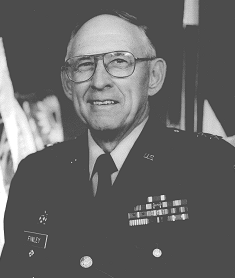 Major General Philip B. Finley served as The Adjutant General of Kansas from 1987 until 1990. Born in White City, Kansas, he graduated from Morrowville Rural High School. He then received a Bachel of Science Degree in Agriculture and a Reserve Officer Training Corps (ROTC) commission as a Second Lieutenant, Artillery, from Kansas State University.
Major General Philip B. Finley served as The Adjutant General of Kansas from 1987 until 1990. Born in White City, Kansas, he graduated from Morrowville Rural High School. He then received a Bachel of Science Degree in Agriculture and a Reserve Officer Training Corps (ROTC) commission as a Second Lieutenant, Artillery, from Kansas State University.
He entered active duty on September 4, 1951, and later was transferred to the 7th Infantry Division in Korea, servinig as a Forward Observer for Artillery, Team Leader for Divisional Counter Mortar Radar Coverage, Platoon Leader for Artillery Automatic Weapons, and Battery Executive Officer. Upon release from active duty in September of 1953, he served as an Infantry Platoon Leader in the 89th Division, U. S. Army Reserve, and in 1956 completed a Master of Science Degree in Agricultural Administration from Kansas State University.
During the period from November 1, 1966 to December 31, 1979, he served as a Guided Missile Special Weapons Officer, Ammunition Supply Officer, Ammunition Officer, Materiel Officer, Executive Officer, and Battalion Commander. He was appointed as a Captain, Ordnance, in Headquarters, 110th Ordnance Battalion, Kansas Army National Guard in Norton, Kansas on November 1, 1966. He was promoted to Major, Ordnance, on January 7, 1972, and to Lieutenant Colonel, Ordnance, on March 19, 1976. He was assigned as Detachment Commander, Command and Control Headquarters, Kansas Army National Guard, upon reorganization of the 110th Ordnance Battalion on January 1, 1979.
In February, 1979, he was transferred to Headquarters and Headquarters Detachment, Kansas Army National Guard, as Asst. G-1, Personnel Administration Section. With his assignment as Public Affairs Officer on March 29, 1979, he was promoted to the grade of Colonel. He was promoted to Brigadier General, Line, on April 1, 1982, and on September 30, 1982, he was assigned as Deputy Commander, State Area Command (STARC), Kansas Army National Guard.
On October 18, 1987, he was appointed as The Adjutant General of Kansas by Governor Michael Hayden and promoted to Major General on June 16, 1988.
General Finley is a member of Phi Delta Kappa, Spsilon Sigma Phi, the National Guard Association of the United States, the National Guard Association of Kansas, the American Legion, the Lions Club, Pioneer Country, Inc., and the 7th Infantry Division Association. He served as a member of the Committee on Integrity for Colby Community College for the North Central Accredition. His civilian occupation includes being a high school teacher, , a high school vice principal, and as director for the Northwest Kansas Area Kansas State University Extension.
MG Finley and his wife, Jackie, live in Colby, Kansas, and have two grown children and a granddaughter.
COL Robert Lyn Smith retired from the Kansas Army National Guard with more than 39 years of enlisted and commissioned service. During this time, he served on both Active Duty and in the Kansas Army National Guard.
COL Smith received a Direct Commission in the United States Army in 1974. He is a graduate of the U. S. Army Command and General Staff College and the Tactical Commander’s Development Course, both at Ft. Leavenworth, Kansas. He has a Bachelor of Arts Degree from Newman University in Wichita, with a major in Administration. He received the Combat Infantryman’s Badge and numerous military awards, which include the Legion of Merit, the Bronze Star, and the Purple Heart (for combat injuries).
He was mobilized in 1968 with the 69th Infantry Brigade (Separate) while serving with the 1st Battalion, 137th Infantry. It was while at Ft. Carson, Colorado with the 69the Infantry Brigade that he was levied to go to the Republic of Vietnam, where he served with the 1st Cavalry Division (Airmobile) as a Squad Leader and as a Platoon Leader in Company C, 2nd Battalion, 12th Cavalry as a Staff Sergeant, the latter a position normally held by a Lieutenant. During this duty, COL Smith received the Air Medal and several other awards.
COL Smith held many positions in the Kansas Army National Guard, including Mortar Fire Direction Chief, Scout Platoon Sergeant, Scout Platoon Leader, Executive Officer, Anti-Tank Platoon Leader, and Company Commander. He also served in serveral staff postitions of the 69th Infantry Brigade (Separate) and the 35th Infantry Division (Mechanized).
He served as the Battalion Commander for the 1st Battalion, 137th Infantry, and on the staff at Headquarters, Kansas Army National Guard in Topeka. His final assignment was as Commander, 69th Troop Command, Kansas Army National Guard.
In addition to his military awards, COL Smith has received many civilian community awards, including the Key to the City of Wichita, the Bronze Medal of Outstanding Service from the Sedgwick County Sheriff, and the Sedgwick County Community Enrichment Award. His community service includes being the initiator of and an ongoing volunteer for the Sedgwick County LAW (Leaders, Achievers, and Winners) Camp, which has served hundreds of “At Risk” children for the past 20 years. He was the leader in initiating the proposal for a new Guard and Community Center in November of 2010. He has also served as the Committee Chairman for the Nationwide Wichita Open Golf Tournament for many years, generating over $135,000 for local charities.
COL Smith continues to be active in the Cargill Retirees Group, assisting in packing lunches for kids in need through the Kansas Food Bank. During 2010 he also volunteered to distribute food to needy families in the Wichita area during Operation Holiday.
COL Smith and his wife, Patricia, live in Wichita, and have three children and nine grandchildren.
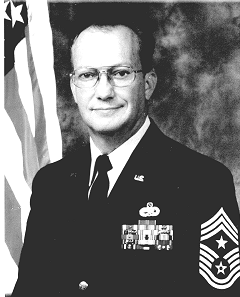 CCMSgt Roger K. Wilson served as the State Command Chief Master Sergeant for the Kansas Air National Guard from 1998 until 2003. He deployed for Operation Desert Shield/Desert Storm in 1990-1991, for which he was awarded the Bronze Star.
CCMSgt Roger K. Wilson served as the State Command Chief Master Sergeant for the Kansas Air National Guard from 1998 until 2003. He deployed for Operation Desert Shield/Desert Storm in 1990-1991, for which he was awarded the Bronze Star.
CCMSgt Wilson served honorably for over 40 years–4 years in the United States Air Force and 36 years in the Kansas Air National Guard. He brought substantial operational and occupational experience, as well as strong institutional skills, to the 190th Air Refueling Wing during his time in that unit. He deliberately developed subordinates into leaders, using the USAF “Core Values” of Integrity First, Service Before Self, and Excellence in All We Do. He routinely went above and beyond the requirements of routine duty through devotion of his own time and energy to improve the success of the 190th Air Refueling Wing missions.
As one of the first State Command Chiefs, CCMSgt Wilson was responsible for advising commanders and staff on mission effectiveness, professional development, military readiness training, resource utilization, health, morale, and welfare of the Enlisted Airmen and Women of the Kansas Air National Guard. He also constantly maintained visibility on the issues affecting Kansas Air National Guardsmen and women. He was always accessible and visible to the Enlisted troops, while tirelessly working to personally recognize the efforts and accomplishments of all Airmen and women.
He has always been a champion of community service, which resulted in the Kansas National Guard being viewed in a very favorable light. He continues to serve as the Asst. Program Manager for the Public Assistance Program of the Kansas Division of Emergency Management, using his leadership skills and operational knowledge to the benefit of State and Local Communities. He and his wife, Juanita, are staples in their church community and continue to provide a significant amount of support to Our Lady of Guadalupe Catholic Church in Topeka. CCMSgt Wilson is a person who makes everyone around him better, at the same time remaining strikingly humble. He has never been driven by a self-centered need for recognition, nor has he sought awards for his actions. He is solely motivated by the drive to always leave things better than he found them for the common good of others.
During his service, CMSgt Wilson clearly demonstrated courage and fidelity while serving his nation during wartime commitments. He served his fellow Airmen and women selflessly and contributed significantly to the successful air campaign during Operation Desert Shield/Desert Storm. His actions, as reflected by the Bronze Star Medal, clearly resulted in enhanced credibility and and a positive reputation for the Kansas Air National Guard.
CCMSgt has served for many years on the Board of Directors of the Museum of the Kansas National Guard, including several years as the President of the Board of Directors.
He and his wife, Juanita, reside in Topeka, Kansas.
 James White Frierson Hughes
James White Frierson Hughes
Kansas’ 22nd Adjutant General
April 01, 1905 – April 01, 1909
Mayor of Potwin
Mayor of Topeka
Chief of Police-Topeka
Topeka is a poorer city today because Colonel J.W.F. Hughes no longer walks its streets. He was born in Tennessee, but lived in Topeka from 1881 till his death in 1945, a period of 64 years. He was a college graduate, very intelligent, friendly, kindly, very original, vigorous in his defense of the right and of the underprivileged, extremely courageous, the essence of politeness and courtesy, a gracious host and a man of many accomplishments and talents. Colonel Hughes had a deep-seated love of city, county, state and nation. His patriotism was of the highest degree as is shown by his membership in the armed forces for most of his adult life.
It was a consequence of his refusal, as commander of the Kansas National Guard, to obey an illegal order to eject members of the Kansas Legislature from their hall (please see related link: Colonel Hughes and the Legislative War), issued to him by Governor Lorenzo D. Lewelling in February of 1893, that Hughes became a national figure over night. He was court-martialed and dishonorably discharged, but the next Governor called him back to service and made him a Brigadier General.
The Colonel was 33 years old at the time; very alert and keen. His courage and cool head averted bloodshed. The country at large had been watching Kansas indulge in a period of political aberration. The Colonel’s actions received editorial plaudits from every corner of the United States. Two or three huge scrape books now in the library of the Kansas State Historical Society preserve the hundreds of newspaper clippings.
Colonel Hughes was born at Columbia, Tennessee, January 12, 1860. He was the son of Judge and Mrs. A.M. Hughes. He had three brothers and two sisters. He graduated from the University of Tennessee in 1881 with a bachelor of science degree in civil engineering. He belonged to an honorary fraternity and also to an engineering fraternity, both Greek letter societies. He was married on October 6, 1885, to Miss Mary Adaline Clark, the daughter of Judge and Mrs. J. T. Clark of Topeka. To them three children were born: James C. Hughes, a retired U.S. Regular Army Colonel of Artillery of Long Beach, California; Mrs. Cecial W. Meredith, of Dallas, Texas, and Mrs. Juliet Newcomb, Los Angeles, California.
Colonel Hughes was always a loyal member of the Republican Party. Soon after coming to Topeka he became a member of the Topeka Republican Flambeau Club. (John A. McCall of Topeka patented the flambeau torch of 1879). It had a membership of 200. The club took part in some of the most prominent demonstrations in the United States, among them the nomination of President Harrison at Chicago in 1888. Colonel Hughes was the captain of their drill team of 80 picked men who executed 50 military, special and secret-order movements.
Apart from activities already mentioned the Colonel’s career in local public service covered many years.
Potwin, where he lived, was incorporated as a third class city. Col. Hughes was the Mayor of Potwin in 1898-99. After Potwin was taken into the city of Topeka, he served a councilman from the 6th ward (Potwin) in 1899 and 1900. In 1901 Col. Hughes was elected Mayor of Topeka. The canvassing board elected him. The Supreme Court counted him out after he had been in office ten months. The Supreme Court ruled his opponent had won by five votes. Hughes was chief of police of Topeka in 1913 during the latter part of Mayor Cofran’s administration.
Colonel Hughes last public office was as a member of the board of education of Topeka. He was first elected in 1931 and was re-elected each four years thereafter. He was a member of the Board at the time of his death. He served as president of the Board and also as the chairman of the Building and Grounds Committee. A set of tennis courts on West 8th street in named “Hughes Courts” in his honor.
When Hughes first came to Topeka in 1881 to apply to the Santa Fe for a position in the engineering department, he presented a letter of introduction. He was told that a job he might have had was gone and asked where he had been in the thirty days since the date of the letter. The Colonel replied he had so many kinfolks it took a long time to bid them goodbye. A short time later he became chief clerk to J.M. Meade, Santa Fe resident engineer, a position he held five years. In 1886 he became roadmaster at Arkansas City. He built 155 miles of track between Arkansas City and Purcell. Soon after, he came back to his old position as chief clerk to Meade. In 1891 he resigned from the Santa Fe and became the Topeka agent of the Pomeroy Coal Company of Atchison. Two years later, he purchased the coal yard and operated it for 12 years. After his period of service as adjutant general, he worked for Arthur Capper for a year on the front desk at the Daily Capital. This was the year 1909. Then he represented the Illinois Life Insurance Company till it failed during the depression of the 1930s. From then onhe was the Topeka agent of the Northwestern National Life Insurance Company of Minneapolis. During the 1920s he served as secretary of the State Poultry Association for several years.
J.W.F. Hughes had many titles, Major General, Brigadier General, Colonel, Captain, Lieutenant, Mayor and Chief. But of them all, he preferred to be called “Colonel.” And he was greeted with respect and affection as Colonel Hughes by many thousands of Topekans for over 60 years. Born just a week before the outbreak of the Civil War, his birthplace, Columbia, was in “middle Tennessee,” a region bitterly divided in its sentiments. His father was a United States district judge who was a believer in the Northern cause. Because of this sentiment, many of his kin folks “damned” him and never spoke to his branch of the family again. During the Civil War, Judge Hughes’ property was occupied first by the troops of one side and then by the troops of the other. By the end of War, Col. Hughes was old enough to be familiar with the trappings of war. Besides that, his ancestry included an officer of the American Revolutionary Army making him eligible to the Society of the Cincinnati which was formed in 1783 as an agency for mutual help to members and their friends. Eligibility is limited by descent through males only.
Whatever may have been his incitement, young Hughes joined the National Guard of his state when he was only 14 years old. At the University of Tennessee, military training was compulsory. He received his commission as second lieutenant when he was a sophomore, having already passed through the grades as private, corporal, sergeant and second sergeant. When he graduated, June 4, 1881, he had passed through the grades of first lieutenant and captain and was assistant commandant of cadets. Among his extra curricular activities he was the drum-major of the band. William Gibbs McAdoo was the bass drummer. A photograph of that band in full dress uniform hung on the wall of his office for years. In later years when McAdoo would go through Topeka on the train, Hughes would always go down to meet him. When the Colonel would say; “Hello, Billy,” Mr. McAdoo would say that sounded fine; that he was so tired of being called “Mr. Secretary.”
On coming to Topeka, Hughes joined the Kansas National Guard in which he became Captain, Co. A, of the 3rd Regiment, August 24, 1883, and Colonel of the regiment in the following year. Following his dismissal during the Legislative War in 1893, he was successively Brigadier General and Major General of the Kansas National Guard. From 1905 to 1909 he served as Adjutant General of the State in the administration of Governor E.W. Hock.
Other members of the Colonel’s family belonged to the Military establishment of the United States. A brother of J.W.F. Hughes was Archelaus Hughes, colonel of the 8th Immunes in the Spanish American War. William N. Hughes, another brother, was a U.S. Regular Army Colonel of Infantry. William N. Hughes had a son with the same regular army rank. The Col. James C. Hughes had two sons, both graduates of West Point. One son, James R. Hughes, is now a U.S. Regular Army Lieutenant Colonel on the General Staff; the other son is William R. Hughes, now a major in the U.S. Regular Army. Thomas Meredith, the son of Mrs. Alice Hughes Meredith, served in our army overseas in World War II. He was a sergeant, U.S.A.R.
The family has one interesting, non-military connection. They trace relationship to Thomas Hughes (1822-1896), English lawyer and author, who sat in Parliament from 1865 to 1874, and who wrote “Tom Brown’s School Days.”
A book could easily have been written about the beloved Colonel. He certainly supplied a wealth of material. He was a born showman; he loved to ride on horseback at the head of a parade. He just glowed when people made a fuss over him. Each year he would participate in the annual Elks Minstrel show at the City Auditorium. He was always “end man” and his costume nearly always the same boyish one. He could shake the “bones” and put on a dance just to perfection. One stunt was to fall asleep and nearly fall off his chair and then a watch, a huge alarm clock, would ring and wake him up.
He loved to play “Southern Colonel” to the ladies, bowing deeply, with a flourish, addressing all ages as “Madam,” so flattering to young women as well as to older ones. Because of the way he tipped his hat and spoke, more than one Topeka woman said she would rather speak to Colonel Hughes than to any other man in town.
The Colonel wore a white vest, broad brimmed felt hat, low cut shoes, black bow tie and collars too large for his neck, all of which set him apart from the more sober colors and cuts of his contemporaries. His coat was always unbuttoned to show the white vest, and often he walked up Kansas Avenue without his coat. Winter or summer his garb was the same. Mrs. Hughes tried every winter for the 60 years they were married to get him to wear overshoes and an overcoat; but she never succeeded.
During the years he was secretary of the State Poultry Association, he raised many chickens. He enjoyed his work. He had many runaways and small chick houses in his back yard. He tried pigeon raising, all kinds of pouters, etc., also pheasants and Japanese Silkies. He practically lived down at the city auditorium at the time of the annual poultry show. Many prizes were won by him. The large oval oak table in his living room was given him for his many years of devotion to the association and to bettering poultry strains. After many years, the table he cherished and believed solid oak was relegated to the barn, and after weathering there, it warped and turned out to be veneered. The family was amused but the Colonel was crushed.
The Colonel was a born farmer, too, but he never lived on one. He adored raising vegetables and utilized many vacant lots in the neighborhood for this purpose. Tomatoes, melons, corn, potatoes, beans and peas were some of his favorites. He loved food and was a tremendous eater in his earlier years. He made a great fuss over his food and wanted all others to enjoy theirs, too. The Colonel took eight or nine spoonfuls of sugar in his coffee. His classic story was of the waitress, who, after putting in four spoonfuls, threw down the spoon and said; “Shovel it yourself.” He did a lot of those shenanigans like using so much sugar, and later salting his drinking water, solely for effect, so some said. It created attention and interest, which he loved.
One terribly hot summer day the Colonel fried an egg on a frog of the street car track at Sixth and Kansas Avenue. The Associated Press carried the story all over the United States; the Colonel and Topeka were on the front page. His daughter, Alice, in the East at the time, felt embarrassed about it. When she returned to Topeka, she chided her father and said: “Why in the world did you do such a thing?” The Colonel replied that a reporter friend had been up to see him and had bemoaned the awful heat and lack of news and human interest stories; and that he just thought of trying to cook the egg and told the reporter to come on down to the street corner and they would “make some news.”
The Colonel was an inveterate cigarette smoker. He rolled his own from a mixture of Fruits and Flowers, with a bit of added perique, which he carried in his pocket in a metal soapbox. Carrie Nation once censored him severely for smoking cigarettes. The Colonel bowed low and commented that he had smoked them for 30 years and that God willing he would smoke them for another 30 years. The Colonel’s story of how he learned to smoke was this: He was the youngest child of six. His father was in straightened circumstances following the Civil War and couldn’t afford to purchase matches. They were too expensive. His folks smoked pipes. He was sent to the kitchen, quite a distance from where the adults were, to get coals to light the pipes. The pipes were so often cold by the time he could get clear back to his folks that he would take a puff or two to keep them going and thus save himself another trip.
In his conversation, Colonel Hughes used many unique expressions; his vocabulary was extensive. When he went to milk to cow, he would say he was going to “extract the lactic fluid from the bovine.” When he was asked how he was, he would sometimes reply “tollable like.” He used many little trick expressions of comparison, such as; “as pretty as a little red wagon”; “as independent as a hog on ice”; “as sure as Heaven made little green apples”; “as sharp as a new pin”; “no more notion what to do with it than a hog with a holiday”; “as sure as settin’ sin”; “sweet as molasses cake with sugar on it.” Certain kinds of desserts were “transparent puddin” or “atmosphere pie.” He wouldn’t eat chicken because he had raised so many. He said when he took a bite he could see his favorite poultry looking at him with reproachful eyes. Approximately 20 years ago Mrs. Hughes went on a strict diet; and made the Colonel go on it, too. It consisted of little more than citrus fruits for breakfast. The Colonel would meekly partake of the breakfast offered him and then go downtown to his favorite restaurant and eat his regular breakfast of bacon and eggs, hot cakes, toast and coffee. And he never disclosed to Mrs. Hughes that he had done so and that he wasn’t being greatly benefited by the diet.
The Colonel was an individualist if there ever was one. He lived, talked, ate and dressed absolutely in his own way. He stood out from the crowd. Everyone knew him; everyone liked him. Wherever he drove, people would call out “Hello, Colonel”; and he would reply, “Fine; how’s your family, Frank.” He was much beloved by all who knew him. He was a good man; good to his family; good to his friends. He was an indefatigable worker, he possessed tireless energy. He was up early every morning, milking the cow, feeding the livestock and tending the garden.
It was heartbreaking when his family and friends and Topeka had to part with this lovable, kindly man. Colonel Hughe’s funeral services were held in the large sanctuary of the First Presbyterian Church, his church since 1881. No mortuary chapel in Topeka would have accommodated the people and the flowers.
Taken from the Bulletin of The Shawnee County Historical Society, Number 17, December, 1952. Written by William MacFerran, Jr.
Poem “Cashiered” Written by Supporters of Hughes during his trial.
To the best of my recollection this poem was written by me I.J. Tray?, in the fall of 1893, after conclusion of the Hughes Court Martial Trial in the south wing of the state house. Mr. Gray, or Col. Hughes, had printed the poem on a sheet of paper of approximately the size of the sheet this statement is written on. I saw this poem when it was “fresh” and have a lasting recollection of Mr. Gray’s name being attached to the orginal poem. How it happened to be reprinted later, and autographed as it is, I am unable to explain.
“Guilty, as charged,” was the verdict
That came from the motley band —
From the packed “malish” court-martial
Convened at the Duke’s command;
For the socialistic Major,
And the young pop Brigadier,
And the other pop-gun warriors,
Were tools of the mighty peer.
Guilty of what? Of refusing
To do an unlawful deed;
Of failing to compass murder
To further a lawless greed;
Of saving his Royal Highness
>From a hasty trip through space,
By staying the hand of vengeance
Of an outraged populace.
“Cashiered and dismissed the service!”
And this by the wooden pegs
Who strutted around with sabres
That dangled between their legs;
Who got their clue from the Major,
Their law from an anarchist,
Their gall from as rank a party
As has ever dared exist.
And this is reform, O people!
Dash on on your senseless course,
Riding o’er law with militia,
Gaining your power by force.
Yet, spite of your old star chamber,
The “Colonel” is still ahead —
He still will be doing business
When the populist cranks are dead.
What! Down the popular dealer!
Why, blast their contracted soul,
When Duke Lewelling is busted
I still will be selling coal;
And I hope in the great hereafter,
When pops to their judgment go,
I may get the fuel contract
To warm their souls below.
September 1, 1893
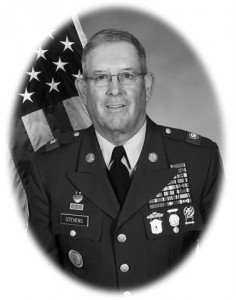 Retired Command Sgt. Maj. George E. Steven’s outstanding and dedicated service to the Kansas Army National Guard spans more than 40 years and continues today as he serves as a scout for the Kansas Division of Emergency Management. It began when he enlisted in the Kansas Army National Guard in 1965. He has served in field units his entire career and in 1988 he was promoted to the rank of sergeant major.
Retired Command Sgt. Maj. George E. Steven’s outstanding and dedicated service to the Kansas Army National Guard spans more than 40 years and continues today as he serves as a scout for the Kansas Division of Emergency Management. It began when he enlisted in the Kansas Army National Guard in 1965. He has served in field units his entire career and in 1988 he was promoted to the rank of sergeant major.
He has served as command sergeant major for the 1st Battalion, 161 Field Artillery; the 35th Division Artillery; and the 287th Sustainment Brigade. During a deployment to Bosnia-Herzegovina in 2003, Stevens served as Command Sergeant Major for Joint Military Affairs as part of the 35th Infantry Division’s peacekeeping mission.
In 1991, he led in the organization of the 18th Kansas Volunteer Cavalry Regiment, a unit of the Kansas Militia, a volunteer organization dedicated to preserving this important history of the Kansas military. He served as the regiment’s command sergeant major since it was chartered. During the 150th anniversary celebration of the Kansas National Guard, he appeared in a replicated 18th Cavalry uniform at a community presentation of a framed Heritage Print of the “Battle of Prairie Dog Creek” to the city library in Long Island, Kan.
In his community, he has been a member of the Pratt Fire Department for 40 years and serves as the assistant chief. In addition to these responsibilities, he built the announcers’ booth at the Pratt Sixth Street Ball Park, served as fund-raising co-chair for a new flag pole at the Pratt High School football field, as well as installing it and a new flag.
He serves as the coordinator of the community’s Independence Day celebration, organized at his own expense. Stevens is the vice-chairman and special projects coordinator of the B-29 museum and the All Veterans Memorial at the Pratt Industrial Airport. He has also been instrumental in partnering with the museum of the Kansas National Guard by securing and displaying aviation art. He holds membership in the American Legion, Patriot Guard, Veterans of Foreign Wars, Pratt Rifle and Pistol Association, Enlisted Association of the Kansas National Guard and many other community organizations.
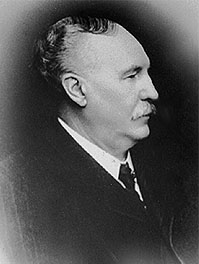 Samuel H. Kelsey
Samuel H. Kelsey
Kansas’ 21st Adjutant General
February 01, 1903 – March 31, 1905
BG Samuel Howell Kelsey was born on a farm in Rush County, Ind., March 14, 1844, and was there reared and educated in the rudimentary branches. He matriculated at the State University at Bloomington, Ind., but the war coming on caused the student to desert his books for the battlefield, for in August 1862, he enlisted as a private in Company I, 84th Indiana Volunteer Infantry, and served with this command until the cessation of hostilities.
He saw arduous service and participated in many of the fiercest battles of the Western armies, including Thompkin’s Station, Franklin (1863), Triune, Guy’s Gap, Shelbyville, War Trace, Tullahoma, Chickamauga, Franklin (1864) and Nashville. He was severely wounded on Sunday afternoon at Chickamauga, and during his convalescence was on detached duty at Nashville, Tenn., in charge of the commissary and quartermaster stores of the refugee barracks, which was under the control of Gov. Andrew Johnson of Tennessee.
In 1865, he was commissioned as assistant quartermaster in the United States Army, but was never mustered into the service, preferring to return to his home in Rush County, Ind. There, he attended Knightstown Academy for a nine months commercial course, and for the next year engaged in teaching in Henry County, Ind. In the spring of 1868 he was appointed steward and quartermaster of the Soldiers’ Home at Knightstown, which position he occupied until the fall of 1869, when he resign and removed to Leavenworth, Kan.
For a year he was engaged as a bookkeeper and then opened a large furniture and carpet business in Atchison. He prospered in this undertaking until 1893, when becoming imbued with the Oklahoma fever he sold out his business and sought the new Eldorado. He remained in Oklahoma for two years and took a prominent stand in the affairs of that remarkable territory. Kelsey then engaged as a traveling furniture salesman, following this occupation successfully until 1898, when he purchased an old line insurance agency at Atchison.
He was very popular in his home city, having served as mayor of Atchison from 1885 to 1889 and was a member of the city council and the school board. He was a leading Republican and high in the councils of that party. He was delegate to the national convention at Minneapolis in 1892 and attended many State and congressional conventions. He served on the State central committee and was the Chairman of the Atchison County Central Committee.
Kelsey was a prominent secret order man, being a Royal Arch Mason; a grand Patriarch of the Odd Fellows, having represented Kansas in the sovereign Grand Lodge from 1879 to 1891; a chancellor commander and a brigadier general of the Uniform Rank of Knights of Pythisa. He was also commander of John A. Martin post, No. 93, Grand Army of the Republic, of Atchison.
He was appointed Adjutant General by Governor Bailey.
Taken from The Province and the States: A History of the Province of Louisiana Under France and Spain, and of the Territories and States of the United States Formed Therefrom, Volume VII, page 330-331, printed in 1904.
 Retired Chief Warrant Officer 4 Steven D. Evans devoted more than three decades of outstanding and dedicated service to his nation, the state of Kansas and the Kansas Army National Guard. He built his military career around his love for music and the care and training of members of the 42nd and the 35th Division Bands of the Kansas Army National Guard.
Retired Chief Warrant Officer 4 Steven D. Evans devoted more than three decades of outstanding and dedicated service to his nation, the state of Kansas and the Kansas Army National Guard. He built his military career around his love for music and the care and training of members of the 42nd and the 35th Division Bands of the Kansas Army National Guard.
During this period, he worked as a band director for the Olathe, Kan., school district. He has conducted music groups performing in 14 states and six foreign nations, appearing before the president, vice-president, six governors and three foreign heads of state.
Evans entered the military in the 40th Army Band of the Mississippi Army National Guard on April 25, 1963. After Basic Combat Training, he was assigned to the Post Band, 60th United States Army Band, Fort Polk, La. Later in his military career he served in the 47th Army Band, Minnesota Army National Guard; the 1st Battalion, 156th Brigade; and the 31st Infantry Division of the Louisiana Army National Guard before joining the Kansas Army National Guard’s 42nd Army Band.
In 1984, he became the conductor of the band and in 1984 he became the bandmaster and commander of the 42nd, followed by the 35th Division Band for 17 more years.
Under Evans’ leadership, additional band members were recruited that shared his vision of a quality organization. The band doubled in size in 1984 and by 1987 it was at 100 percent authorized strength. The band was selected for missions in Costa Rica, Honduras, Guatemala, Panama and Ecuador.
Evans continues to dedicate a tremendous amount of time to civic and community organizations. One of his favorites is to teach radio communications in amateur radio clubs. As a current resident of Florida, his experience with radio communications proved invaluable to the communities experiencing the devastation from hurricanes Ivan and Katrina. Evans serves his community in his retirement by supporting civic, church and amateur radio operations for disasters.
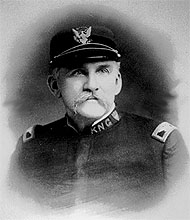 Hiram Allen
Hiram Allen
Kansas’ 19th Adjutant General
February 01, 1897 – February 21, 1899
COL Hiram Allen was born at Connersville, Indiana, on May 3, 1835. He attended college at Greenscastle, Indiana (Depaw University) and practiced law for a time. He was described as a “reformer” and at an early age became an active abolitionist.
At the start of the Civil War, his health prevented him from enlisting, but after recovering in 1862, he enlisted in the Union Army and was made Captain of an artillery company. He saw heavy combat and served until his discharge in August of 1865. On July 22, 1868, he was married to Minerva Murray, and shortly after came to Williamsburg, Kansas and set up a farm.
He was very active in the community. Among his activities were, the organization of the Methodist Sunday School, working to expand Williamsburg’s economic growth, Township Trustee, County Commissioner and School Director.
He was appointed Adjutant General on February 1, 1897, and was responsible for the organization and equiping of the four regiments that Kansas mustered during the Spanish American War.
Starting in 1901, COL Allen’s heath became very poor again. Around March 8, 1902, his daughter became very sick and he insisted on caring for her and staying by her bedside. For 12 consecutive days he went without real sleep, until his daughter was finally declared convalescent. Upon hearing this, COL Allen’s health quickly deterioriated and after suffering a severe chill, he caught pneumonia. He died at his farm in Williamsburg about 5 p.m. on March 29, 1902, leaving a widow and three children.
(Written by 1st Lt Dave Young, Public Affairs Officer, HQ-KSANG. Information taken from the Williamsburg Star on April 4, 1902, page 3.)
 Maj. Gen. Lloyd E. “Gene” Krase was born in Kingman, KS., raised on his parents’ farm near Murdock, KS., and attended Cheney Rural High School. After four years enlisted service as an infantryman, Krase was commissioned through the Kansas National Guard Officer Candidate School and is a graduate of the Infantry Officer Basic and Advanced Courses, the Command and General Staff College and many other military schools including the Army War College.
Maj. Gen. Lloyd E. “Gene” Krase was born in Kingman, KS., raised on his parents’ farm near Murdock, KS., and attended Cheney Rural High School. After four years enlisted service as an infantryman, Krase was commissioned through the Kansas National Guard Officer Candidate School and is a graduate of the Infantry Officer Basic and Advanced Courses, the Command and General Staff College and many other military schools including the Army War College.
His assignments included platoon leader, Company B, 1st Battalion, 137th Infantry, 69th Brigade, Wichita, Kan.; platoon leader, Company A, 1st Battalion, 137th Infantry, 69th Brigade, Fort Carson, Colo.; company commander, Company C, 1st Battalion, 137th Infantry, 69th Brigade, Fort Carson, Colo.; platoon leader, Company A, 2nd Battalion, 60th Infantry, 9th Infantry Division, U.S. Army, Republic of Vietnam; commander, Combat Support Company, 1st Battalion, 137th Infantry, Wichita, Kan.; commander 1st Battalion (Mechanized), 137th Infantry, 69th Infantry Brigade (Mechanized), Wichita, Kans; commander 69th Brigade, 35th Infantry Division (Mechanized), Topeka, KS., and deputy commander for maneuver, 35th Infantry Division (Mechanized), Fort Leavenworth, Kan.
He held numerous staff assignments including chief of staff, 35th Infantry Division (Mechanized) and chief of staff, Kansas Army National Guard. His final assignment was commanding general, 35th Infantry Division (Mechanized), Fort Leavenworth, KS.
Krase also served several years as the Deputy Director of Emergency Management for the state of Kansas in the Adjutant General’s Office.
He received a Master of Science degree from Shippensburg State University, Shippensburg, Pa., and holds a Bachelor of Science Degree from Wichita State University. Krase retired in 2003 with more than 30 years of commissioned service and a total of over 40 years military service.
Krase is a Master Gardener and has served on various Advisory and Board of Directors including the National Emergency Management Association and the Governor’s Council on Bio-Terrorism.
Among Krase’s awards are the Distinguished Service Medal, Silver Star, Legion of Merit, Bronze Star for Valor with oak leaf cluster, Purple Heart with oak leaf cluster, Meritorious Service Medal with oak leaf cluster, Army Commendation Medal for Valor with two oak leaf clusters, Air Medal, Vietnamese Cross of Gallantry with Silver Star, Vietnamese Cross of Gallantry with Bronze Star, Combat Infantryman Badge and many other awards including the Order of Saint Maurice, Primicerius Level and the Honorable Order of Saint Barbara.
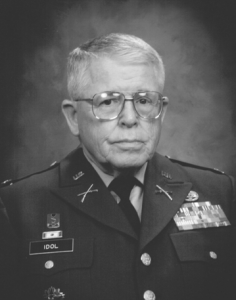 Col. Paul E. Idol graduated from Reserve High School in May 1950 and attended Highland Community College.
Col. Paul E. Idol graduated from Reserve High School in May 1950 and attended Highland Community College.
He enlisted in the United States Army in 1952 and served in Korea as a combat medic with the 14th Regiment of the 25thInfantry Division. Following his tour in Korea, he was assigned to the 32nd Division and then the 8th Division at Fort Carson Colo.
After discharge from the Army, he joined the Kansas Army National Guard’s 154th Field Artillery Battalion as a forward observer in Hiawatha, KS. He attended Emporia State University, receiving his Bachelor of Science degree in Education. Idol graduated from Class 1 of the Kansas National Guard Officers Candidate School in July 1957 and was commissioned a second lieutenant. His first assignment as an officer was the liaison officer with the 154th Field Artillery. He was promoted to first lieutenant in July 1960 and served with the 135th Anti-Aircraft Artillery Battalion and then the 235th Field Artillery Battalion at Hays, Kan.
In 1961, Idol received his master’s degree in School Administration at Emporia State University and transferred to the 137th Infantry Regiment as a liaison officer. His civilian occupation was as a principal at Winchester, KS. until he was called back to active duty in 1968 serving in the Selective Service Headquarters in Topeka. He was released from active duty in 1976 and began a short period of time working for the Kansas State Board of Agriculture. In 1980 he served as the director of the Decennial Census for Eastern Kansas. In 1985 he was promoted to colonel as the chief, Selective Service Section, Headquarters, State Area Command, Kansas Army National Guard. He retired from the military in May 1992 after serving almost 38 years.
His military decorations include the Legion of Merit, Meritorious Service Medal, Joint Service Commendation Medal, Army Commendation Medal, Army Achievement Medal, Combat Medical Badge, Good Conduct Medal, Nation Defense Service Medal, Korean Service Medal, Armed Forces Reserve Medal with two oak leaf clusters, Army Reserve Components Achievement Medal with three oak leaf clusters, United Nations Service Medal, Army Service Ribbon, Korean Presidential Unit Citation, Kansas National Guard State Service Medal with three oak leaf clusters, Adjutant General Badge for Kansas, Exceptional Service Medal Selective Service System, Korean War Service Medal, Kansas State Emergency Service Ribbon, the Order of St Barbara, and the Ancient Order of St. Barbara.
After the forced resignation of Adjutant General H. H. Artz because of charges of misappropriating state funds, Governor Lewelling appointed his friend, MAJ Albert J. Davis to fill the position of Adjutant General on April 1, 1894. MAJ Davis had been serving as assistant adjutant general since the beginning of the Lewelling Administration. The new position carried with it a salary of $1,500 a year.
Davis served as a member of Company I, 2nd Iowa Volunteer Cavalry from January 16 to October 13, 1865. Although only 17 at the time, Davis and a cousin ran away from home to join the fight.
He was admitted to the bar in Iowa, but he had never practiced law. He moved to Rooks County, Kansas in 1879. “He was formerly a Republican and from 1882 to 1886 was county clerk of Rooks County. He was for several years adjutant of Stockton post No. 76, G.A.R., and was a member of the board of education at Stockton at one time,” according to the March 1, 1894, Weekley State Journal.
The same article also says, “Major Davis will not wear the uniform of his office like his predecessor, but it is expect that he will perform the duties of the office with more satisfaction, at least to the administration.”
Davis served as Adjutant General of Kansas until February 28, 1895.
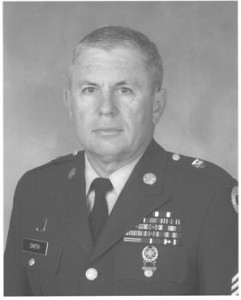 CSM Smith enlisted in the Kansas Army National Guard in September 1966 and completed his Basic and Advanced Individual Training at Fort Leonard Wood, MO. He was assigned as a Pioneer in the 226th Engineer Battalion.
CSM Smith enlisted in the Kansas Army National Guard in September 1966 and completed his Basic and Advanced Individual Training at Fort Leonard Wood, MO. He was assigned as a Pioneer in the 226th Engineer Battalion.
After serving as a traditional guardsman for six years, Sergeant Smith was hired in 1972 to be an Administrative Supply Technician (AST) for the 242 Engineer Company in Wichita, Kansas. In the early 1970’s, Sergeant Smith served in an additional duty status as Operation Sergeant at the Kansas Military Academy Officer Candidate School. In 1980 he was asked by the school’s leadership to examine and evaluate a proposed course that would affect all potential NCOs’. After reviewing and crafting a plan, Sergeant Smith proposed his plan to the leadership and it was approved. By the end of the year other states had heard of the plan and requested that their soldiers be allowed to attend in Kansas. This was the beginning of what was known as the Primary NCO Course and now is the Warrior Leadership course.
In 1983 after assignment to the 226th Engineer Battalion he was named Commandant of the Noncommissioned Officer School. By 1984 he was selected to be the Command Sergeant Major of the 1st Battalion 635th Armor. His assignment to the Armor Battalion was extremely short because of the activation of the 35th Infantry Division and the need for an Operations G-3 Sergeant Major in the Divison Headquarters.
In 1998 his family was selected as the “Fort Leavenworth’s Great American Family.” The Citation from the Commanding General reads, “Your family’s strong teamwork, love and service not only benefit you, but the community.” From this point on CSM Smith was assigned to represent the Reserve Components on the Future Leadership Doctrine Committees.
1n 1991, CSM Smith was selected to be the State Command Sergeant Major. In 2000, CSM Smith retired from the Kansas National Guard and was quickly hired by USAA and assigned as the Military Affairs Representative covering all military organizations from Texas to North Dakota and from Kansas to Illinois. His is now the National Guard Program Manager representing all Army and Air National Guard personnel in the Fifty States and four territories.
CSM Smith has served his community equally as well as a Scout leader, and as a Church leader. He has also been involved in the “Seasons of Sharing Holiday Program” in San Antonio by coordinating, collecting and delivering gifts to the less fortunate children of the community.
Inducted Into the Kansas National Guard Hall of Fame on November 8, 2009.
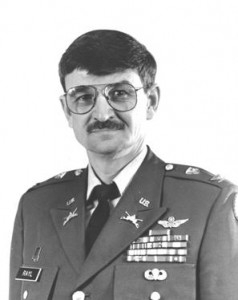 COL Rayl enlisted in the USAR in January 1964 and was commissioned in the United States Army on March 1, 1965. In 1970 he was commissioned in the Kansas National Guard and remained in the Guard until his retirement in 1994.
COL Rayl enlisted in the USAR in January 1964 and was commissioned in the United States Army on March 1, 1965. In 1970 he was commissioned in the Kansas National Guard and remained in the Guard until his retirement in 1994.
COL Rayl completed Armor Officer Basic Course in 1965 as well as Airborne Training. He became an Army aviator in 1967 and was assigned to A Troop, 7th Squadron, 17th Air Cavalry in the Republic of Vietnam in 1968. He held various command positions in Armored Cavalry Regiments from November 1968 until May of 1970 in Germany.
In September of 1970 he was commissioned in the Kansas National Guard serving in the 137th Aviation Company and the Headquarters of the State Area Command, KSARNG. During his time in the Kansas National Guard he also served as the Commander 920th Medical Detachment (Air Ambulance) and as the Battalion Commander of several units including the 135th Aviation Battalion, the 108th Aviation and the 635th Armor Battalion, and as the Brigade Commander of the Troop Command, KSARNG. He served on the Headquarters staff as the Director of Security and was the State Aviation Officer during his last assignment in the KSNG.
He is the recipient of the Purple Heart and the Legion of Merit along with numerous other military medals, ribbons and badges. He was the Distinguished Military Graduate of the Kansas State University ROTC program. He has a Masters Degree in Agricultural Economics from Kansas State and Juris Doctorate (Law) Degree from Washburn University and is the President and Attorney at Law for Rayl and Jones, LLC, of Cottonwood Falls, KS. He has received numerous Honors and Awards from Kansas State University, and from Iowa State University. He received the Kansas Preservation Alliance Award for Excellence in Preservation Advocacy in 2003.
He considers his most personal special achievement in getting the name of SGT Henry Jackson, A troop, 7th Squadron, 17th Air Cavalry added to the Viet Nam Wall on Memorial Day in 1999
Inducted Into the Kansas National Guard Hall of Fame on November 8, 2009.
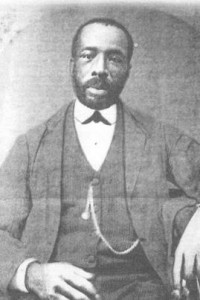 James Whitfield Ross was born into slavery. In 1862, at the age of twenty six, he escaped and found his way to a Union Army Regiment heading for Kansas.
James Whitfield Ross was born into slavery. In 1862, at the age of twenty six, he escaped and found his way to a Union Army Regiment heading for Kansas.
Upon reaching Topeka, in August of that year he joined Company F, of the First Kansas Colored Volunteer Infantry. His service and ability was such that on January 13th of 1863 he was promoted to the rank of Corporal. He remained with Company F of the 1st Kansas, which on 13 December 1864, became the 79th Regiment, United States Colored Troops until mustered out in October of 1865.
Corporal Ross showed tremendous courage and dedication to a country that had dealt him such a terrible moral blow. Relinquishing the personal freedom that he and the others had finally obtained risking their lives fleeing from the oppression of slavery, they volunteered to again risk their lives for a freedom not only for themselves and their race but for all oppressed Americans.
Contrary to modern movie makers, the First Kansas Colored Volunteer Regiment was the first African American unit to engage the Confederates in the American Civil War. Their valor and success at the Battle of Island Mound, Missouri on 29 October 1862, convinced President Lincoln to proceed with the Emancipation Proclamation and allow black men to join the Union Army. He served over three years in a regiment that lost more soldiers than any other USCT regiment, and all but nineteen regiments in the rest of the Union Army. Feared by the enemy and greatly respected by his fellow solders, Corporal Ross and his men were lauded by their commanders as some of the finest fighting men they had the pleasure to command.
After mustering out of the Union Army, James Ross returned to Topeka where he lived on a small farm just north of the city. In addition to farming he also worked laying stone for the basement and interior walls of the first portion of what is now the Kansas State Capitol building.
In 1868 he met and married Margaret Elizabeth Chapman from Mound City, Kansas. They lived on a farm that he bought and produced a family of seven children, including two girls, both of who died in infancy. Their sons, however, went on to become educators and prominent members of their respective communities.
Inducted Into the Kansas National Guard Hall of Fame on November 8, 2009.
 John N. Roberts
John N. RobertsCOL John N. Roberts was born at Mecca, Trumbull County, Ohio, July 3, 1838, of parents who in early life moved from near Hartford, Conn., to Trumbull County, Ohio. His family was of Scotch decent; tracing their lineage to a Scotch Highlander, Major Roberts, an officer in the British Army, who came to this land in the 17th century. His grandfather was also a military man, serving in the Revolutionary war as a member of a body of dragoons known as the Scotch Highlanders.
John Roberts was skilled in the manufacture of engines and machinery, having learned this trade in his father’s factory in Ohio. His knowledge of machinery was a major factor in his success in his business life, as a manufacturer.
In April, 1861, in response to Lincoln’s first call for troops, he enlisted as a private in the 19th Ohio Infantry, and with his regiment, was mustered in at Columbus, Ohio, for 90 days. This regiment was assigned to the Army under command of General McClellan, and served in western Virginia, taking part in the battles of Rich Mountain and Beverly Ford, where the Confederate General Garnett was killed and his army captured.
Upon being mustered out, by reason of expiration of term of service, he assisted in organizing the 6th Ohio Cavalry, which in October, 1861, was mustered into service for three years. Roberts was commissioned 1st Lieutenant of Company G. In August, 1863, he was transferred and promoted to be Captain of Company D, same regiment, and in November, 1864, was commissioned Major of the regiment.
Upon organization of the Cavalry Corps, Army of the Potomac, commanded first by General Stoneman, then by General Pleasanton, and during the last 18 months of the war, by the matchless Phil Sheridan, the 6th Ohio Volunteer Cavalry was assigned to that organization and served therein until the close of the Civil War, taking part in the many battles and raids which have made that organization famous and the name Phil Sheridan immortal. On June 21, 1863, Roberts was very severely wounded while taking part in a cavalry charge at Upperville, Va., but remained in the army until the winter of 1864-65, when, by his military obligation expired.
About two years after leaving the Army he was married at Warren, Ohio, to Emily S. Sutliff. They had one child, Isabel Brandon, the wife of H.L. Armstrong of Topeka.
Roberts was elected as the candidate of the Republican Party to the Kansas Legislature and served during the regular session of 1885 and the special session of 1886. In 1889, he was appointed Adjutant General of the State of Kansas, and held that position for four years.
He died November 21, 1927 in San Diego, California. He is buried in Lawrence’s Oak Lawn Cemetery Section 8 Lot 291.
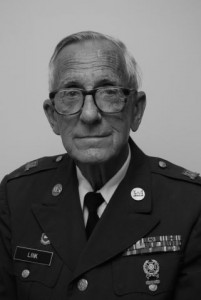 Alfred E. Link enlisted in the Headquarters Battery, 195th Field Artillery Group in Iola, Kansas on 15 December 1948. CSM Link enlisted in the Armory located at Riverside Park in Iola, KS and received the military rank of Recruit E-1. He received his military and MOS training under the guidance and supervision of MSG Swiggett, the HHB Communications Chief. The unit had drill every Monday night for a 2 hour period. While serving in the HHB 195th Field Artillery Group he performed duties as a Field Wireman, Wire Team Chief, and Communications Chief.
Alfred E. Link enlisted in the Headquarters Battery, 195th Field Artillery Group in Iola, Kansas on 15 December 1948. CSM Link enlisted in the Armory located at Riverside Park in Iola, KS and received the military rank of Recruit E-1. He received his military and MOS training under the guidance and supervision of MSG Swiggett, the HHB Communications Chief. The unit had drill every Monday night for a 2 hour period. While serving in the HHB 195th Field Artillery Group he performed duties as a Field Wireman, Wire Team Chief, and Communications Chief.
The 195th Field Artillery Group was re-designated and reorganized on 1 May 1959 as the 195th Engineer Group. Citizen Soldier Link served as the Construction Foreman and the Group’s Operations Sergeant. On 1 May 1962 he was promoted to HHC First Sergeant and served in that position until 15 September 1965 when he was promoted to Sergeant Major of the Group served in that position until the 195th Engineer Group was reorganized as the 3rd Battalion, 137th Infantry.
Link served as the Sergeant Major with the 3rd Battalion 137th Infantry until August 1969 at which time the Army added the rank of Command Sergeant Major. He was selected and promoted to that grade and he has the honor of becoming the First Command Sergeant Major in the Kansas National Guard. He served in that position until 15 December 1970 at which time he elected to retire from the Kansas National Guard.
After a short period of one year and fifteen days, he reenlisted in the National Guard and served as the Assistant Operations Sergeant. On 31 July 1972, he assumed the duties as the full-time Operations, Training, and Readiness Specialist with the 3rd Battalion, 137th Infantry Battalion.
On 1 February 1976 the 3rd Battalion of the 137th Infantry was reorganized as the 891st Engineer Battalion. At that time he became the Battalion Operations Sergeant and served in that position and as the Fulltime Operations, Training, and Readiness Sergeant until retirement on 31 July 1990.
His awards include: The Meritorious Service Medal, Army Commendation Medal with one Oak Leaf Cluster, Army Achievement Medal with two Oak Leaf Clusters, Army Reserve Components Achievement Medal with one Oak Leaf Cluster, Armed Forces Reserve Medal with 3 Hourglass Devices, NCO Professional Development Ribbon with the Numeral 4, Army Service Ribbon, the KSNG Emergency Duty Service Ribbon with 1 Sunflower Device, KSNG Service Medal with three Sunflowers, and the Citizen Soldier Award for Outstanding Achievement for 1965.
Inducted Into the Kansas National Guard Hall of Fame on November 2, 2008.
 COL Paul A. Cannady was born in 1895 and graduated from Yates Center High School in 1912. It was during High School he enlisted in the First Kansas Infantry of the Kansas National Guard. In 1915 he was discharged as an enlisted member and was commissioned as a First Lieutenant.
COL Paul A. Cannady was born in 1895 and graduated from Yates Center High School in 1912. It was during High School he enlisted in the First Kansas Infantry of the Kansas National Guard. In 1915 he was discharged as an enlisted member and was commissioned as a First Lieutenant.
In June 1916 his unit was mustered into Federal Service to serve on the Mexican Border then mustered out in October 1916. Then in August 1917 he again entered Federal Service with the 137th Infantry, part of the 35th Infantry Division that was preparing to go to war. While in France in 1918 he was given command of the 139th Infantry Regiment which he led for the duration of the war. At the end of WWI he returned to the Kansas National Guard and the 114th Cavalry Regiment.
Following graduation from Kansas State College he became a Military Instructor at Haskell Indian School in Lawrence from 1919 until 1931. Here he was responsible for the morale and discipline of 1200 students. With the assistance of other Kansas National Guardsmen he helped form Company D (Machine Gun), 137th Infantry Regiment in 1921 and later the C Troop of the114th Cavalry both all Indian units.
When he left Haskell, he became the State Superintendent of the Boys Industrial School of Topeka where he fought for changes to inefficiency and politics that were institutionalized at the school. He also fought for better trained leaders and teachers that would remain even after the State Administration changed.
In 1935 he resigned from the Boys Industrial School and went to work in the civilian market. During this time he was promoted to Full Colonel and assumed command of the 114th Cavalry, 24th Cavalry Division. In the late 1940’s he was mobilized as the commander of the 127th Field Artillery prior to becoming the commander of the 195th FA Group which was headquartered at Fort Ord, California. He became ill in a Field Training exercise in the desert and even though still commanded the 195th he was classified as non deployable. He died from this illness on 21 July 1944. The commanding general of Camp Roberts, CA stated about COL Cannady: “He died a soldier’s death as much as those now dying on the battlefield.”
Inducted Into the Kansas National Guard Hall of Fame on November 2, 2008.
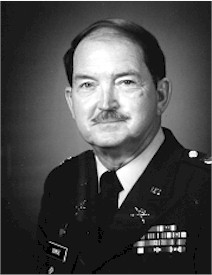 COL Malen “Butch” Dowse was born on 2 March 1942 in Dodge City, Kansas. He was raised southwest of Dodge City in Copeland, Kansas, and moved with his family to Grand Junction, Colorado where he graduated high school and joined the Colorado National Guard in January 1960. He moved back to Kansas and transferred to Headquarters Battery, 1st Battalion, 161st Field Artillery, Dodge City in 1962.
COL Malen “Butch” Dowse was born on 2 March 1942 in Dodge City, Kansas. He was raised southwest of Dodge City in Copeland, Kansas, and moved with his family to Grand Junction, Colorado where he graduated high school and joined the Colorado National Guard in January 1960. He moved back to Kansas and transferred to Headquarters Battery, 1st Battalion, 161st Field Artillery, Dodge City in 1962.
In 1965 Dowse, then the Battalion Communications Chief, accepted the challenge of attending the Kansas National Guard Officer Candidate School. He graduated in June of 1966 and was commissioned 2nd Lieutenant, Field Artillery. He served many staff positions within the battalion and as Headquarters Battery Commander. He became a fulltime guardsman in July 1979 as the S-3 and later Executive Officer. He was appointed Battalion Commander in 1983. In 1985, he was transferred to the 130th FA Brigade in Hutchinson as Executive Officer and remained in that position as the unit was redesignated the 35th Division Artillery.
In 1991 he was transferred to KSTARC as Military Personnel Officer and in 1994 as Director of Maintenance, the position from which he retired in December of 1997. Upon retirement, he became the Executive Director of the National Guard Association of Kansas. He served in this position until December 2005. In 1999 he also became the Insurance Administrator for the association and remains in that role.
He is past president of the National Guard Association of Kansas, the National Guard Executive Directors Association and Kaw Valley Chapter of the Military Officers Association of America. He currently serves as a Trustee on the National Guard Association of the United States Insurance Trust, member of the National Guard Executive Directors Association Payroll Deduction Coordinating Board and Treasurer of the Museum of the Kansas National Guard.
His awards and decorations include the Legion of Merit, Meritorious Service Medal (3rd award), Army Commendation and Achievement Medals, Army Reserve Component Achievement Medal (6th award) National Defense Service Medal, Armed Forces Reserve Medal (3rd award), Army Service Medal and many Kansas National Guard Service Ribbons. He was also awarded the Kansas Medal of Excellence, NGAKS and NGAUS Distinguished Service Medals and the Honorable and Ancient Orders of St Barbara and the Col Jim Gamble Award.
Inducted Into the Kansas National Guard Hall of Fame on November 2, 2008.
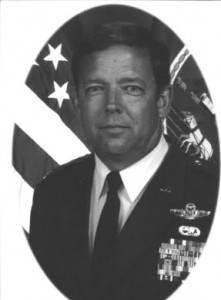 Colonel Michael Joseph O’Toole was born in Hiawatha, Kansas on January 1, 1952. He attended Topeka West High School for a one year and graduated from the Parsons High School in 1970. He enlisted in the Kansas Air National Guard in 1970 after graduation and began Basic Training in September of that year. Ultimately Col. O’Toole commanded the Wing that he had enlisted for, the 190th Air Refueling Wing of the Kansas Air National Guard.
Colonel Michael Joseph O’Toole was born in Hiawatha, Kansas on January 1, 1952. He attended Topeka West High School for a one year and graduated from the Parsons High School in 1970. He enlisted in the Kansas Air National Guard in 1970 after graduation and began Basic Training in September of that year. Ultimately Col. O’Toole commanded the Wing that he had enlisted for, the 190th Air Refueling Wing of the Kansas Air National Guard.
While serving in the Air Guard he attended college at Washburn University and was a member of the ROTC program. Upon his graduation he was commissioned a Second Lieutenant and served on Active Duty at Cannon Air Force Base, New Mexico. He completed his active duty in 1979 and was appointed as an officer in the 190th ARG. In 1980 he graduated from Pilot Training and served as a Traditional Guard Pilot until 1986 when he became a Full Time Instructor Pilot. During his career he served in numerous Leadership and Command positions as all levels. He accumulated over 7,000 flying hours and obtained the Master Pilot Rating. He graduated from the Air War College in 1999.
Col. O’Toole was mobilized to serve during the Desert Shield/Desert Storm War and the Kosovo Campaign being one of the first Air Refueling Crews in support of both Kosovo and the War with Iraq.
As a citizen he served as a Trustee for the Stormont-Vail Foundation, as a board member of the Topeka Chamber of Commerce and a member of “Go Topeka.” He was a member of Leadership Topeka, Class of 2001 and Leadership Kansas, Class of 2003. He served the National Guard Association of Kansas as the second and first Vice President and as the Executive Director of the National Guard Association of Kansas from 1985-1986.
He started a “Wings” Leadership Program for Fifth Grade students a Pauline south Elementary School in Pauline, and was an active volunteer in the program. He also was a volunteer in the Kansas STARBASE program and gave orientation flights for the Wright Flight and Young Eagles, using his own airplane.
His military awards and decorations include the Legion of Merit, the Meritorious Service Medal, the Air Medal, the Aerial Achievement Medal, the Air Force Commendation Medal, the Air Force Achievement Medal, the Southwest Asia Services Medal, the Kosovo Campaign Medal, the Armed Forces Expeditionary Medal, the Kuwait Liberation Medal, the Overseas Short Tour Medal, the and National Guard Association of Kansas Distinguished Service Medal and other awards to numerous to mention. he was inducted into the Hall of Fame in 2007 following his father, COL Donald J. O’Toole, inducted into the Hall of Fame in 1991.
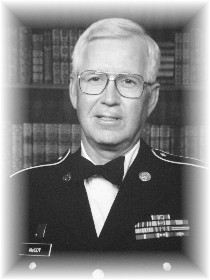 Command Sergeant Major McCoy was born February 3rd, 1936 in Wichita, Kansas. He enlisted in the Kansas Army National guard on the Twenty-fourth of March in 1952 and was assigned as Assistant Squad Leader in the First Platoon of Company A, First Battle Group 137th Infantry.
Command Sergeant Major McCoy was born February 3rd, 1936 in Wichita, Kansas. He enlisted in the Kansas Army National guard on the Twenty-fourth of March in 1952 and was assigned as Assistant Squad Leader in the First Platoon of Company A, First Battle Group 137th Infantry.
He concluded his distinguished forty-four year career by retirement in 1996. CSM McCoy has the distinctive honor of serving as Battalion Command Sergeant Major for two Infantry Battalions, 1-137th Infantry and 2-137th Infantry. He served on Active Duty when the 69th Brigade was ordered to Active Duty in 1968.
As a civilian, he worked 40 plus years for Boeing Aircraft Company in Wichita, Kansas as a printer. During this time he coached and mentored countless young men teaching them the skills of his trade.
While in the Kansas National Guard he found time to umpire basketball and softball from many organizations in the Wichita Area. He provided countless role modeling for many youths on the court and fields. His ability to connect with youth throughout his life made him an excellent role model and leadership figure for the youth of the Wichita community. He served at Umpire in Chief for the Two Rivers Youth Club and for the youth programs of Sedgwick and Butler counties.
He set an excellent example for the soldiers with whom he served. After his retirement he continued to serve his fellow soldiers by being a mentor and provided guidance for unit members and their families. He became an honorary member of the Infantry Regimental Staff to assist with the Family Readiness Group and Rear Detachment soldiers while the Infantry Battalion was deployed to Iraq.
During his career he recognized the need for standard training and promotion of the best qualified personnel. The curriculum he developed was adopted and expanded for use at the State NCO Academy in Salina, Kansas. He has been called a true patriot and a model citizen-soldier by his superiors and subordinates.
His military awards include the Legion of Merit, the National Defense Service medal, the armed Forces Reserve Medal with two Hourglass Devices, the Army Reserve Components Achievement Medal, (fourth award), the NCO Professional Development Ribbon with the Numeral 4, the Army Achievement Medal, the Army Reserve Components Overseas Training Ribbon, the Korean Service Medal with Hourglass Device, the Kansas National Guard Service Ribbon with two Hourglass Devices and the Kansas National Guard Meritorious Service Ribbon. He was inducted into the Kansas National Guard Hall of fame on 4 November 2007.
 Brigadier General Edward H. Gerhardt was born 16 June 1941 at Whiting, Kansas. He graduated from Netawaka Rural High School in 1959, and enlisted in the Kansas Army National Guard on 20 March 1960.
Brigadier General Edward H. Gerhardt was born 16 June 1941 at Whiting, Kansas. He graduated from Netawaka Rural High School in 1959, and enlisted in the Kansas Army National Guard on 20 March 1960.
He served for over 38 years in the Kansas Army National Guard, enlisting originally as a Light Weapons Infantryman in Company C, 2nd Battle Group, 137th Infantry. He was commissioned in 1963 as the Honor Graduate of the Kansas National Guard Officer Candidate Class 7. In succeeding years he served as commander of the 105th Public Information Detachment, the 174th Supply and Service Battalion, and the Troop Command brigade. Other assignments included Tactical Officer in the Kansas Military Academy and Personnel Officer, Inspector General, and Public Affairs Officer in Headquarters, Kansas Army National Guard.
From 1980-83 he served as Commandant of the Kansas Military Academy, Salina, Kansas. Following over 15 years of command, he was assigned as Director of Plans, Operations, and Training for the Kansas Army National Guard. His final assignments were as Deputy Director, State Area Command, and Asst. Adjutant General-Army and commander of the Kansas Army National Guard. He retired in 1998.
During his career, he served as president of both the National Guard Association of Kansas and the STARBASE Board of Directors; as chairman of the Kansas Army National Guard Council; as a member of the Board of Directors of the Museum of the Kansas National Guard, the Officer Candidate School Hall of Fame Board, and the Kansas Military Advisory Board; and as the 5th Army representative on the National Guard Bureau Quality Advisory Council.
General Gerhardt’s awards include the Legion of Merit, Meritorious Service Medal with Oak Leaf Cluster, Army Commendation Medal with Oak Leaf Cluster, Adjutant General’s Award of Excellence, and numerous other federal and state awards.
General Gerhardt graduated with an EDD in education and served over 39 years as principal. He was active in his local PTO. As a part-time Guardsman and fulltime school administrator, he was a champion of the citizen-soldier. He was active in many community, church, and political organizations, and ensured that the voice of the traditional Guardsman was heard as decisions were made affecting the Guard. He was instrumental in bringing the “quality management” concept to the Kansas Guard, in encouraging personnel strength in the units, which he commanded, and in ensuring that all units met standards through the Command Inspection and Mobilization Readiness programs which he led. In retirement he devoted considerable energy to preserving the Kansas militia heritage in the Museum of the Kansas National Guard. He was inducted into the Hall of Fame on 4 November 2007.
No complete biography of COL Alexander B. Campbell has been found as of this date. The information about him is from the article below, printed in an unnamed Chicago newspaper. It was contained in a Department of Kansas Grand Army of the Republic (G.A.R.) book for Lincoln Post No. 1, located at the Kansas State Historical Society. COL Campbell was born in Rushville, Ind., in 1841, and committed suicide on December 20, 1897 in Chicago, Ill.
Chicago, Dec. 21 — General A.B. Campbell, ex-adjutant general and ex-chaplain of the state’s prison of Kansas, for years one of the most noted Republican orators and lawyers of that state, committed suicide in a Clark street hotel last night by taking morphine. He wrote a letter fully explaining his act, bathed and dressed himself carefully, and took a draught of morphine. The deed was committed at Kuhn’s hotel, No. 163 South Clark street.
The suicide left the following touching letter:
I, Alexander B. Campbell, make this statement of the cause of my death to relieve the coroner of the necessity of an inquest, and also let my friends know the motive that led me to take my own life. My death will be caused by morphine, which I have deliberately taken with suicidal intent. The purpose was fully formed when I left Rushville, Ind., and came to this city. I have not drank to great excess since I left home, and now write without being at all under the influence of whisky.
The reason why I take my life is because I want to go to my wife and boy. My usefulness in this world is at an end. I can not be satisfied in any business and can not be without their companionship. I have never been able to devote myself to business since my wife died, and after Bliss [his son] was killed I lost all interest in life, but lived for the sake of living. When she died I wanted to die also. In Los Angeles, Cal., I tried to commit suicide but did not take enough of the drug. I then concluded I would go home to Rushville and try to rebuild my life. But I found no comfort there. My friends all regarded me as a man of unsound mind because I held the view that my wife was with me in spirit always. I have lived with her spirit guiding me every day and she is with me now as I write this letter, and helps me to do as I am now doing.
I will be with her before another day goes by, and I died with pleasure. I am glad to go with my wife and baby boy.
I have not one single doubt or fear about my future life with them. I believe in God and immortality. My trust and faith are perfect. I do not regard it as wrong to take my life, because I simply change my place of residence and go where my wife and baby are. I will be reunited with them, and we will all be made happy by the change. Besides, my usefulness here is destroyed because all of my friends think me a man of unsound mind. If I go among strangers the story of my insanity soon follows, and I do not care to live such a life when I can in a few hours go to my wife and boy.
In the other life I will be better able to establish my sanity, and hope to meet all my friends when they come. What few things I have left in my room may be sent by express to my brother, George W. Campbell, Rushville, Ind., and he is the proper person to notify of my death. I do not want any funeral services over my body, and where I buried is of no concern to me whatever. I am through with this body, and what becomes of it will make no difference with me in the future. I have no ill will in my heart against anybody in this world. I am sorry to cause my close friends the pain they will feel in their hearts when they read of my death; but in the aftertime it will be clear to them how much they have wronged me by refusing to recognize my sanity and not giving me a fair chance in the race of life, after I have been declared sane by the authorities. But I do not desire to complain about this treatment now, as I much prefer to die than to live, no matter what my condition might have been under different treatment. I go gladly to my wife and boy, and I leave this world at peace with every one in it and at peace with God.
I hope and trust the infinite, the eternal, and merciful and loving God. I worship Him and feel no guilt in my heart before him for what I am going to do. Next to God I worship my wife and boy and will soon be with them and with my father and mother, who are there waiting my coming.
I bid all my friends a tender and loving good-by.
God be with you all until we meet again.
A. B. Campbell
P. S. Since writing the above I have bathed and dressed myself and am in a perfect condition for burial. I want to be buried just as I am and as soon as possible.
The Will
The little watch and chain which will be found in my small valise I give to Bruce. The watch was the first and only one Bliss had. I gave it to him and he wore it until he was killed. The Lizzie [his wife] put aside her gold watch and wore this one until she died, and after I took it and have worn it ever since. I want Bruce to wear it in memory of Bliss and his mother and me. The amethyst ring, which was originally given to my wife by me as a birthday present, I want to Celia to wear and hold her uncle tenderly in that dear heart, and to Mary I send my sweetest and tenderest love, and to all the rest of the relatives, both the Campbell and Bliss families, I send my best love, especially to my sister Mary.
Campbell had been at the hotel since December 14, having registered from Santa Monica, California. His conduct had not attracted any particular attention. He was of prosperous appearance and excellent address.
At 6:45 o’clock last night Maggie Evans, a chambermaid, was passing his room and heard groans. She summoned help from the office, and Mr. Campbell was found to be still alive. Dr. Campbell of No. 138 South Clark street was called in and the patient was given restoratives, but he died at 7:10 o’clock.
His Career in Kansas
General Campbell was the son of a minister of the Christian Church, which was founded by his uncle, Alexander Campbell. He was born near Rushville, Ind., 56 years ago, and on attaining his majority he became a minister of the Christian Church. In 1866 he became an attorney, and in 1870 was elected county attorney of Rush County, Ind. This led to conviviality, and for a time he seemed lost to good. Then he met Luther Benson, the temperance apostle, and was reformed by him. In 1874 he went to Bloomington, Ill., and for six years was the leading lawyer there. Several times he fell for temperance grace, but reformed each time and finally returned to the Christian ministry. In 1880 he went to Kansas, settling at Manhattan as pastor of the Christian church there. Tiring of the ministry, he was admitted to the bar of Riley County, Kansas, as a practicing attorney.
In 1881, General Campbell was appointed chaplain of the state penitentiary by Gov. St. John and served until 1883, when Governor Glick was inauguriated.
From 1885 until 1889 he was adjutant general by appointment of Governor Martin. This office was given to him on account of his work for the Republican party in 1884 as president of the State Temperance union. In 1893 and 1894 he was adjutant general of the Kansas Department of the G.A.R. The killing of his son, aged nine, by a street car in Topeka caused him intense grief, and soon after his retirement from the position of G.A.R. adjutant general he went to Los Angeles, Cal., where he undertook to practice law. His wife died there of a lingering illness early in 1896. He took her body to Indiana for burial, and on his way back to California stopped at Topeka, apparently in good health.
On his return to California General Campbell was deeply affected by his wife’s death, and soon brain fever developed. He broke down completely during a public speech, and soon afterward was found ragged and disheveled in a suburb of Los Angeles. He was examined, declared a maniac and confined for a time in an asylum. On his release as cured, he went to his old home at Rushville, Ind., and resumed the practice of law. Last fall he made many speeches in Indiana for McKinley. He then became an ardent Spiritualist and had lately neglected his business to devote himself to that belief.
Campbell was in the habit of drinking in private places nearly all the time he was in Kansas, and after his retirement from office he was frequently drunk in public. Notwithstanding his faults, he was a man of good impulses, and on that account his sins were overlooked by his friends, who frequently helped him to places of profit.
Wood Campbell, manager of the Star theater, Cleveland, Ohio; the Rev. W. S. Campbell and George W. Campbell were his brothers.
His Life at Rushville
General Alexander B. Campbell was the son of a Christian minister and was born 56 years ago. Ten years ago A. B. Campbell was one of the leading Republicans of Kansas and adjutant general of the state. He was the first prison chaplain at Leavenworth, Kansas, and afterwards adjutant general under the Governor. He was a fine speaker and lecturer and was the possessor of a modest fortune, when a accident occurred that ruined his life. It was the sad death of his nine-year-old son, who was killed by street cars in Topeka. Campbell tried to bury his sorrow in drink and in a few months was penniless. With his wife he went to Los Angeles, Cal., where she became ill and died two years ago. This last bereavement preyed so heavily on Campbell’s mind that for a time he that he was thought to be insane and was confined in an asylum but subsequently released. Coming back to Indiana, he began the practice of law in Rushville, and stumped Rush and surrounding counties last fall for McKinley. He prepared a new lecture entitled, “The Essential Elements of a Good Character,” which he was preparing to give in the principal cities between here and California. Two weeks ago on the evening of his departure for the west he got on another “tear” and was thrown into jail. His release was secured by influential friends and a ticket given him for Chicago.
The Campbell family are descendants of Alexander Campbell, the founder of the Disciples church.
 Brigadier General Ronald D. Tincher was born 26 June 1939 at Medicine Lodge, Kansas. Tincher graduated from Garden City High School in 1957. Tincher entered the Kansas National Guard as a field artillery cannoneer on 23 February 1957 in A Battery, 161st Armored Field Artillery Bn at the age of 17. He served in this battery for more than 12 years rising through ranks from Private to 1LT serving as cannoneer, Fires Direction team computer, Survey Chief, Chief of Firing Battery, Fire Direction officer, Executive Officer, and Commander.
Brigadier General Ronald D. Tincher was born 26 June 1939 at Medicine Lodge, Kansas. Tincher graduated from Garden City High School in 1957. Tincher entered the Kansas National Guard as a field artillery cannoneer on 23 February 1957 in A Battery, 161st Armored Field Artillery Bn at the age of 17. He served in this battery for more than 12 years rising through ranks from Private to 1LT serving as cannoneer, Fires Direction team computer, Survey Chief, Chief of Firing Battery, Fire Direction officer, Executive Officer, and Commander.During his enlisted service with Battery A, his leadership and natural team building abilities were quickly recognized by his commanders. Typical of his concern for others, was his organizing of a drive-through facility at the armory for the citizens of Garden City to obtain polio vaccine promptly. This effort was prompted by then Sergeant Tincher following a discussion with a fellow postal employee who suffered from polio. This program was very successful and brought great credit upon his unit and the Kansas National Guard.
Tincher was commissioned a 2LT Field Artillery in July 65, having graduated from Kansas Military Academy and was assigned as Assistant Executive Officer, A Battery, 1st Bn, 161st FA. During this same period he served additional weekends and AT’s as Platoon and senior Tactical Officer at the KSARNG OCS. Promoted to 1LT, in July 68, he assumed command of Battery A. In 1972 he was assigned to the Kansas Military Academy as the Assistant Commandant of OCS. He was a key member of the team that developed, organized and launched the Non-Commissioned Officers School for the State of Kansas. The NCO school was chartered to begin by requiring all senior NCOs’ in the state to attend the school before they could send their junior NCOs’. The senior NCOs ’selected from class 1, would become the school’s instructors, which reinforced the importance of NCO education throughout the Kansas Army National Guard. During his tenure with the OCS/NCO program he was promoted to Captain and subsequently to Major 1974.
Tincher was assigned as the Battalion S-3 (Operation & Training), 1st Bn, 127th FA in 1975 and then Bn Executive officer about one year later. He served with the 127th FA until his separation to USAR control group in 1978 with more than 22 years of service. Rejoined the active Guard in 1979, serving in a number of staff positions in the KSARNG Headquarters including Staff Supply Officer, Asst Inspector General, and S-3, Command and Control HQ where he was promoted to Lieutenant Colonel in March 1980.
Following his promotion he assumed command of the 1st Bn, 127th FA, 69th INF Bde (M). In 1983 he was reassigned to the HQ KSARNG serving as Civil-Military Ops Officer and later Asst G-3 Ops Training Officer. He assumed command of the 130th Field Artillery Brigade and was promoted to Colonel in August 1985.
In October 1985 the 130th Field Artillery Brigade was reorganized as the Division Artillery, 35th INF Division. This command required that he put together 5 Artillery Battalions from 3 states into a well functioning team that could support the Divisions’ varied missions. This challenge meant dealing with three different Adjutant Generals in the various states and gaining the support of all units and personalities involved. His concern for the individual soldier was quickly noted as “Quality of Life” was one of his top priorities for all units and training and activities.
He received federal recognition and was promoted to Brigadier General in June 1995. In October 1998 he was reassigned as the Assistant Adjutant General for Army. In February 1999 he was appointed Commander of the Kansas Army National Guard.
Tincher retired 30 June 1999 with more than 42 years of dedicated service to the State of Kansas, the United Sates Army, The National Guard, its Soldiers and our Nation.
General Tinchers awards include Legion of Merit, Meritorious Service Medal with Oak Leaf Cluster, Army Commendation Medal and numerous other State and Federal awards. He was inducted into the Kansas National Guard Hall of Fame on 5 November 2006.
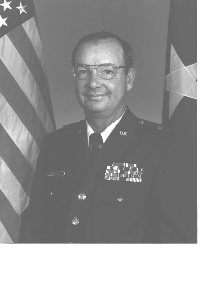 Brigadier General Bunting is a native of Kennett, Missouri where he enlisted in the United States Army at the age of 17 in February 1948. His Army service was as an Infantryman in both Korea and Japan as well as at Fort Ord, California and Fort Riley, Kansas.
Brigadier General Bunting is a native of Kennett, Missouri where he enlisted in the United States Army at the age of 17 in February 1948. His Army service was as an Infantryman in both Korea and Japan as well as at Fort Ord, California and Fort Riley, Kansas.
He became a member of the 127th Fighter Bomber Squadron, Kansas Air National Guard in Wichita after completing his Army enlistment in March 1953. He subsequently was instrumental in the successful conversion of his unit to the F-80, F-86, F-100, and F-105 aircraft. Enlisting as a staff Sergeant (E-5), he ultimately attained the highest enlisted grade, of Chief Master Sergeant (E-9). Nine years after his enlistment with the 127th Fighter-Bomber Squadron he was appointed to the grade of 1st Lieutenant on 31 January 1962 and was assigned as Chief of Personnel. As Chief of Personnel, 184th TFG, Bunting coordinated with the host base to integrate the KSANG sports program into McConnell AFB’s recreational services. This afforded the members of the 184th the opportunity to share base resources and facilities. He then expanded on the success of the integration with the base to develop a similar program with the city of Wichita.
He was recalled to active duty, as a Captain, in January 1968, in reaction to the “Pueblo Incident” and served at Kunsan AB, Korea until his release from active duty in 1969.
In September 1972, he entered a tour of active duty at the National Guard Bureau, the Pentagon, as Chief of the Manpower and Organization Branch for the Air Directorate. Responsible for 22,500 air technicians, their distribution, budgetary assessments and allocations across 91 flying units and dozens of non-flying units.
General Bunting returned to Kansas in July 1977 and began his new assignment as Commander, 190th Combat Support Squadron, Kansas Air National Guard at Forbes Field, in Topeka. He served as Executive Support Staff Officer in the ANG State Headquarters from May 1978 through May 1980. During this assignment in concert with the Chief of Staff of the Army National Guard (Colonel Dick Eckert) he developed the concept, designed and gained legislative approval of the National Guard vehicle license plates.
He again entered a tour of active duty in the ANG National Guard Bureau on 1 June 1980 as Chief of the Manpower and Personnel Division for the Air Directorate. He, then, served as Chief of Staff from June 1983 through 31 August 1985. This position was created June 1983 and Bunting was the first person to hold the office. Recognizing that the Air National Guard had no program to provide awards for personnel recognition, he fought to establish the Awards and Decorations program enabling the State Adjutant General to authorize various medals. He also established a national level board for more significant medals. Bunting was instrumental in establishing the AGR program which enhanced the growth of the full time force to maintain sophisticated weapon systems.
Bunting returned to Kansas on 1 September 1985 and was appointed Assistant Adjutant General and Commander of the Kansas Air National Guard. He retired from the Air National Guard on 30 September 1990 and entered the Inactive Reserve at that time. He was ultimately honored by the NCOs under his command with the “Order of the Sword”. This honor dates back in history as the highest honor that can be bestowed on an officer by enlisted men and women.
General Bunting’s awards include Distinguished Service Medal, Legion of Merit with 2 Oak Leaf Clusters, Meritorious Service Medal, Air Force Commendation Medal with Oak Leaf Cluster, Army Commendation Medal and numerous other State and National awards. He was inducted into the Kansas National Guard Hall of Fame on 5 November 2006.
 Thomas Moonlight
Thomas Moonlight Major General Michael W. Ryan was born on 6 January 1945 in Clay Center, Kansas. His military career began when he enlisted in the Kansas Army National Guard in 1963 in the 891st Engineer Battalion, Manhattan, Kansas. He attended Basic Training in Fort Leonard Wood, Missouri and was assigned to the 121st Signal Battalion, Fort Riley, Kansas for On-the-job-Training. He attended Kansas State University, receiving a degree in Architecture. He attended Infantry Officer Candidate School in Fort Benning, Georgia in 1964, was commissioned Second Lieutenant and attended Engineer Officer Basic Course at Fort Belvoir, Virginia.
Major General Michael W. Ryan was born on 6 January 1945 in Clay Center, Kansas. His military career began when he enlisted in the Kansas Army National Guard in 1963 in the 891st Engineer Battalion, Manhattan, Kansas. He attended Basic Training in Fort Leonard Wood, Missouri and was assigned to the 121st Signal Battalion, Fort Riley, Kansas for On-the-job-Training. He attended Kansas State University, receiving a degree in Architecture. He attended Infantry Officer Candidate School in Fort Benning, Georgia in 1964, was commissioned Second Lieutenant and attended Engineer Officer Basic Course at Fort Belvoir, Virginia.
His first assignment as an officer was as Platoon Leader, Company B, 891st Engineer Battalion in Clay Center. He continued to serve in the Company as Executive Officer and Station Commander in Beloit. During this time he served additional duties as Tactical officer, Weapons and Map Reading Instructor at the Kansas Military Academy. In 1968 he transferred to the 169th Engineer Company, 69th Infantry Brigade and was mobilized to Fort Carson, Colorado. He served as platoon Leader, Executive Officer and Company Commander. He was levied for duty in Vietnam where he served as a Land Clearing Company Commander and Civil Engineer with the 45th Engineer Group. Upon return from Vietnam, he was assigned as transportation Officer of the 69th Infantry Brigade and soon returned to the 891st Engineer Battalion serving as S-4 and S-3. He completed Engineer officer Advanced Course and obtained a Law Degree from Washburn University School of Law. In February 1976 the Engineer Battalion was reorganized into the 1-635th Armor. He served the 1-635th Armor as S-3, Executive officer and Battalion Commander and Chemical Officer of the 69th Infantry Brigade.
He was reassigned from Battalion Command to Administrative Officer of Headquarters, State Area Command and G-1 of the 35th Infantry Division upon its Reactivation. During this time, he completed Armor Officer Advanced Course and Command and General Staff College. In 1986 he was promoted to Colonel and assigned as Director of Plans, Operations and Training and then a Director of Personnel with the State Area Command.
In 1988 he was promoted to Brigadier General Serving as Assistant Division Commander (Maneuver) with the 35th Infantry Division. He was later assigned as the Deputy Commander of the State Area Command and assistant Adjutant General for Army. In 1993 he was selected for promotion to Major General serving as Deputy Commanding General of the 5th US Army, Fort Sam Houston, Texas. He retired on 10 February 1997 with 34 years of service to his state and nation.
General Ryan’s awards include the Distinguished Service Medal, Bronze Star, Meritorious Service Medal (2nd Award) Army commendation Medal with V Device and numerous other federal and state awards.
General Ryan continues to practice Law in Clay Center, Kansas and is also a Licensed Real Estate Broker, Abstractor and Title Insurance Agent. He is active in Professional Organizations and numerous community affairs. General Ryan and his wife, Marcia, live in Clifton, Kansas where she is a 6th grade Teacher. Between them they have five children, one Daughter-in-Law, three Sons-in-Law and five Grandchildren. He was inducted into the Kansas National Guard Hall of Fame, 6 November 2005.
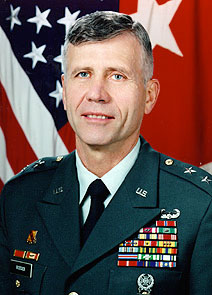 Major General James F. Rueger was born on 14 September 1937 in Axtell, Kansas. His military career began when he enlisted in the Kansas Army National Guard in 1957 in the 154th Field Artillery, serving as an enlisted member until 1962. He was mobilized in 1961 during the Berlin Crisis and rose to the rank of Staff Sergeant. In 1962, General Rueger graduated from the Kansas Army National Guard Officer Candidate School, and was commissioned a Second Lieutenant in the 250th Ordnance Company. His commands include Company, Battalion, Brigade and Assistant Division Commander, 35th Division. General Rueger was mobilized in 1968 for duty in Vietnam and served as Commander of the 377th Light Maintenance Company near Cam Ron Bay.
Major General James F. Rueger was born on 14 September 1937 in Axtell, Kansas. His military career began when he enlisted in the Kansas Army National Guard in 1957 in the 154th Field Artillery, serving as an enlisted member until 1962. He was mobilized in 1961 during the Berlin Crisis and rose to the rank of Staff Sergeant. In 1962, General Rueger graduated from the Kansas Army National Guard Officer Candidate School, and was commissioned a Second Lieutenant in the 250th Ordnance Company. His commands include Company, Battalion, Brigade and Assistant Division Commander, 35th Division. General Rueger was mobilized in 1968 for duty in Vietnam and served as Commander of the 377th Light Maintenance Company near Cam Ron Bay.
In 1990, General Rueger was appointed the Adjutant General of Kansas. While Adjutant General, Rueger brought expansion to facilities, new programs and modern equipment to the Kansas National Guard. The facilities included are armories, creating the Leadership Development Center at Fort Leavenworth, a one of a kind automatic tank wash facility at Fort riley, completely relocating the Regional Graining Center at Salina to a State-of-the-Art Facility and coordinating efforts to break ground for the Kansas National Guard Museum. New programs were the Drug Demand Reduction Program and Partnership for Peace Program with the Ukraine. The Starbase Program was also developed. Other programs include the Retroeurope Equipment Rebuild Site, M1 Tank Engine Rebuild Site and Major expansion of the General Support Maintenance Facility at Fort Riley.
New equipment and weapons systems include the B-1 Bomber, the M1-IP Abrams Tank, the Multiple Launch Rocket System (MLRS), the Paladin Howitzer (Kansas Being the first state to receive the Paladin in a National Guard Battalion), the UH-60 Blackhawk Helicopter and the Palletized Load System.
General Rueger served on numerous national boards including then National Guard Safety and Occupational Health Committee, National Interagency Counterdrug Institute and Vice President of the Adjutants’ General Association of the United States. He also served on the Army Reserve Forces Policy Committee and Chaired the 35th Division Council, made up of six states. Rueger was one of two State Adjutants General to be selected as a Member of the Total Army Analysis General Officer Study Advisory Group. He also served for six years as the Area IV Adjutants General Representative on the National Guard Association of the United States Executive council.
General Rueger’s awards include the Legion of Merit with Oak Leaf Cluster, the Bronze Star, and the Valley Forge Cross for Heroism and numerous other Federal and State awards.
General Rueger’s civic activities include Life Membership in the VFW, member of the American Legion and Chairman of the Local Economic Development Committee. He is a member of the Military order of World Wars, Board of Governors of the Guise/Weber Foundation, the Kansas National Guard OCS Hall of Fame, Board of Governors and president of the Major General James F. and Kathryn Reuger Foundation. He was inducted into the Kansas National Guard Hall of Fame, 7 November 2004.
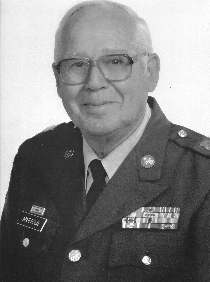 Master Sergeant Anderson was born on December 22, 1928 in Clay Center, Kansas. He joined Battery B, 154TH Field Artillery, Kansas Army National Guard on January 32, 1949 in Marysville, Kansas. He served in this unit until June 1956 when he became a full time unit support employee at Organizational Maintenance Shop #5, Sabetha. He was assigned as the Battalion Supply NCO at Headquarters Battery, Hiawatha. In 1968, he was activated with the command during the Pueblo Crisis and volunteered for service in Vietnam. Following active duty service he was assigned as the Battalion Communications Sergeant and promoted to Master Sergeant. He concluded his career on December 31, 1988, having spent nearly 40 years service, 32 of which were as a full time employee.
Master Sergeant Anderson was born on December 22, 1928 in Clay Center, Kansas. He joined Battery B, 154TH Field Artillery, Kansas Army National Guard on January 32, 1949 in Marysville, Kansas. He served in this unit until June 1956 when he became a full time unit support employee at Organizational Maintenance Shop #5, Sabetha. He was assigned as the Battalion Supply NCO at Headquarters Battery, Hiawatha. In 1968, he was activated with the command during the Pueblo Crisis and volunteered for service in Vietnam. Following active duty service he was assigned as the Battalion Communications Sergeant and promoted to Master Sergeant. He concluded his career on December 31, 1988, having spent nearly 40 years service, 32 of which were as a full time employee.
Throughout his career, MSG Anderson was looked upon as a key leader, trainer, mentor and recruiter for the command. His legacy with the Guard is reflected in the dozens of Field Artillery Commissioned and Non-Commissioned officers he mentored and trained in Organizational Supply and Field Artillery Communications. Leaders from Battalion trough platoon level could count on MSG Anderson for straight answers, honest guidance and helpful observations on all topics related to the Field Artillery problem in a field environment.
MSG Anderson served to support the United States Armed Forces; an Active Live Member of the Sabetha VFW Post 7285, the VFW Military Order of Cooties, PupTent #3, Topeka Chapter and Fairview American Legion Post, he was known throughout Northeast Kansas for his work with elementary schools. For over 30 Years he presented an in-school program about the Flag of the United States, its origin, meaning, care and the importance of Patriotism. As the VFW Post Commander in Sabetha, he was appointed National Aide-De-Camp and special Aide to the VFW Commander-In-Chief. He has held numerous other offices in support of the VFW and American Legion.
He served as advisor for the Explorer Scout Program. He is a Charter Member, Former Junior Governor and Member of the Drill Team of the Marysville Moose Lodge. He is a Charter Member of the Albany Historical Society in Sabetha and Active in the Development of Local Historical Displays and Events. Since retirement, he has continued to serve fellow Veterans by transporting them and others to the VA Hospitals, donating untold hours and miles in his service. MSG Anderson was instrumental in starting an annual luncheon for military retirees held at the Sabetha VFW Post. He serves as Master Gunner for the 130th Field Artillery Regiment and remains active in maintaining Camaraderie within the membership. He is also a Life Member of the Enlisted Association of the National Guard of Kansas and the Untied States. He is also an Active Volunteer and Sustaining Member of the Museum of the Kansas National Guard.
MSG Anderson’s awards and decorations include: The Vietnam Campaign Medal, the Vietnam Service Medal, Overseas Ribbon, Army Commendation Medal, Army Reserve Components Achievement medal, Armed Forces Reserve Medal, Kansas Service Medal (30 years) and the National Defense Service Medal. He was inducted into the Kansas National Guard Hall of Fame on 7 November 2004.
COL Peter S. Noble was born Nov. 30, 1844 in Rennssilaerville, New York. His father moved the Noble family to Michigan in 1855, settling in Joseph County. When the Civil War broke out, Peter and his three brothers enlisted as privates. Peter enrolled in Company E, 11th Michigan Volunteer Infantry.
The young private was involved in the Battles of Belmont, Chicamanga, Resaca, Buzzard’s Roost/Rocky Face, Dalton, Ringgold, Kenesaw and Marietta. Throughout the entire was, Noble was never injured. He had served a total of three years and two months.
After the war, he settled in southern Michigan and entered into the manufacturing business. He married Emma Flagg of Decatur, Michigan. During the Chicago fire, Noble lost $32,000 and had to completely start over. He studied shorthand and became a court reporter, doing his first work in the courts of Independence, Kansas, where he moved in 1872.
He moved to Atchison and entered the law firm of Horton and Waggoner, reading law and acting as court reporter until the firm dissolved when the senior partner, Albert Horton, became the Chief Justice of Kansas.
After the election of Governor George T. Anthony, Noble was appointed Adjutant General on April 8, 1878. When Governor John P. St. John was elected to office, he again selected Noble for the position. When George W. Glick was elected governor, Noble accepted a position in Washington, D.C. as a Special Examiner with the U.S. Pension Bureau. When Groover Cleveland was elected President, he was dismissed, but later was re-appointed to the same position under President William McKinley.
Noble later wrote of his time as Adjutant General, “At the time I took the position of Adjutant General of Kansas, I believe that there had not been such an officer in the State from the close of the War. I resurrected the position from obscurity, and through my solicitation, Gov. Anthony caused to be built the Armory, and I succeeded in exchanging all the old rubbish called arms, that had accumulated from the close of the War for modern guns, and started what is known to day as the militia of Kansas out of which have come to Kansas much glory in our late skirmish with Spain.”
– Memorial Record of Lincoln Post No. 1, Department of Kansas, G.A.R., Topeka, Kansas, page 71
For additional information about COL Noble, please visit his great great grandson’s (Dean A. Desalvi) web page at: Dean A. DeSalvi
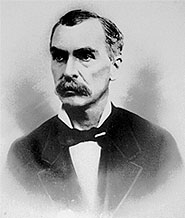 Hiram T. Beman
Hiram T. BemanCOL Hiram T. Beman was born in Attica, New York, August 22, 1827. He was engaged in mercantile business until he moved to Lecompton, Kansas in December of 1858. In May of 1862 he moved to Topeka and four years later was appointed Assistant Adjutant General of Kansas. One year later, in 1867, he was elected a Shawnee County Treasurer. He was re-elected in 1869. In 1872 he became involved with the Commonwealth newspaper.
In January of 1874, he was re-appointed Assistant Adjutant General, and on March 4, 1876, was appointed Adjutant General of Kansas by Governor Thomas A. Osborn. He served in this position until March 5, 1878.
COL Beman died August 19, 1885.
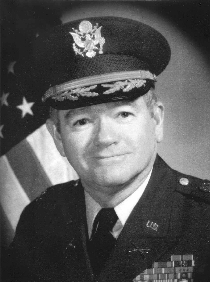 Brigadier General Harold D. Sommers was born on 21 April 1930 in Hiawatha, Kansas. His military career began when he enlisted in the Kansas Army National Guard in 1951 and received a direct Commission to Second Lieutenant on 12 May 1952 in Headquarters Battery, 154th field Artillery Battalion in Hiawatha. He was ordered to active duty during the Korean War in March 1953. He remained on active duty until March 1956 having served in communications officers positions in the 2nd and 64th Field Artillery Battalions and the 25th Division Artillery. While on active duty, he completed his basic Field Artillery courses. Upon returning from active duty, General Sommers was again assigned to Headquarters Battery, 154th Field Artillery Battalion serving as Forward Observer, Radar Officer, and assigned as Battery Commander, Headquarters Battery , 2nd Battalion 130th Field Artillery (formerly the 154th Field Artillery Battalion) In may 1959 as a Captain. He continued to serve in the Battalion Headquarters as the Battalion Personnel Officer, Assistant Operations/Training Officer.
Brigadier General Harold D. Sommers was born on 21 April 1930 in Hiawatha, Kansas. His military career began when he enlisted in the Kansas Army National Guard in 1951 and received a direct Commission to Second Lieutenant on 12 May 1952 in Headquarters Battery, 154th field Artillery Battalion in Hiawatha. He was ordered to active duty during the Korean War in March 1953. He remained on active duty until March 1956 having served in communications officers positions in the 2nd and 64th Field Artillery Battalions and the 25th Division Artillery. While on active duty, he completed his basic Field Artillery courses. Upon returning from active duty, General Sommers was again assigned to Headquarters Battery, 154th Field Artillery Battalion serving as Forward Observer, Radar Officer, and assigned as Battery Commander, Headquarters Battery , 2nd Battalion 130th Field Artillery (formerly the 154th Field Artillery Battalion) In may 1959 as a Captain. He continued to serve in the Battalion Headquarters as the Battalion Personnel Officer, Assistant Operations/Training Officer.
He was again activated for active duty during the Vietnam Conflict with his unit, a portion of the 69th Infantry Brigade with duty in Fort Carson, Colorado. During this tour of active duty, General Sommers completed his advanced Field Artillery Course at Fort Sill, Oklahoma and was sent to Vietnam where he served as the Artillery Liaison Officer to the US Military Assistance Command. Upon release from active duty, he returned to the 2nd Battalion, 130th Field Artillery as the Battalion S-3 and Executive Officer. In March 1974, Sommers was promoted to the grade of Lieutenant Colonel and assumed Command of the 2nd Battalion, 130th Field Artillery. In June of 979 he assumed command of the 130th Field Artillery Brigade and was promoted to colonel on 19 July.
In April, 1981, Sommers was assigned to Headquarters and Headquarters Detachment, Kansas Army National Guard as the assistant Chief of Staff, G-3 and also served as the Assistant Chief of Staff G-2. In September, 1981, he was appointed as the deputy Commander of the 69th Infantry Brigade. In September, 1983, he was reassigned to HQ, State Area command as the Operations and Training Officer and then as Deputy Commander in March of 1984. He was promoted to Brigadier General on 25 august 1984 continuing as the Deputy Commander, State Area Command until September 1986. He transferred to the Retired Reserve at that time.
General Sommers is highly active in community affairs; a volunteer licensed Ham Operator, 4-H Group Leader, deacon and elder of the Highland Christian Church, Board member, Hiawatha Community Hospital, Member and Past Master of the Masonic Lodge in Highland, Private Instrument rated pilot who performed agricultural soil conservation services with aerial photography, Sunday school teacher and life member of National Guard Association of the United States and Kansas. He was awarded the ancient Order of Saint Barbara for Sustained outstanding Support of the Field Artillery Community.
The General’s awards and decorations include the Legion of Merit, the Bronze Star Medal, Air Medal, Meritorious Service Medal, Army Commendation Medal with Oak Leaf Cluster, Army Achievement Medal with oak Leaf Cluster, Army Reserve Component Achievement Medal with Oak Leaf Cluster, Armed Forces Reserve Achievement Medal with Silver Hour Glass, Korean Service Medal, Vietnam Service Medal, national Defense Service Medal with Oak leaf Cluster, Republic of Vietnam Campaign Medal and the United Nations Service Medal. He was inducted into the Kansas National Guard Hall of Fame, 2 November 2003.
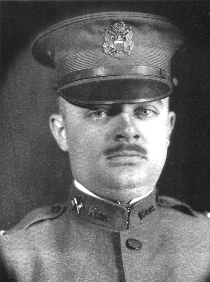 Captain Louis Phil Billard was born on 27 April 1891 in Topeka, Kansas. His entire childhood was spent in the Capital City. As he grew, he earned a reputation as a Daredevil and lover of speed from his wild automobile driving around Topeka. His father, J.B. Billard, a native of France, moving to Topeka in 1894, was elected mayor of Topeka and served in that capacity from 1910 to 1913.
Captain Louis Phil Billard was born on 27 April 1891 in Topeka, Kansas. His entire childhood was spent in the Capital City. As he grew, he earned a reputation as a Daredevil and lover of speed from his wild automobile driving around Topeka. His father, J.B. Billard, a native of France, moving to Topeka in 1894, was elected mayor of Topeka and served in that capacity from 1910 to 1913.
Another Topekan, Albin K. Longren, started building aeroplanes in Topeka about the time Billard turned 21. The two became friends and Billard, in search of a new adventure, bought his first airplane from Longren and made his first flight on 7 April 1912. His flight instruction consisted of “Ground Instructions” and observing Longren’s flying. His first flight lasted 20 minutes at an average height of 125 feet above ground. Longren believed him to be a natural pilot. He becamd a “Barnstormer” of sorts, taking people aeropland rides for pay. There was never a shortage of people willing to ride with him, even though he had crashed a few airplanes around the state while flying at County Fairs. The novelty of flight was a new adventure for many.
Because of the popularity of both Billard and facination with flying and the future it might have for the military, Brigadier General Charles I. Martin, The Adjutant General, commissioned young Billard in the Kansas National Guard on 19 February 1916 with the mission of forming the first aviation unit, Company B, Signal Aero Corps. The unit began with Billard as Commander, six Lieutenants and 23 Enlisted Men. Equipment included one motorcycle and four aeroplanes, the first of which was Billard’s personal aircraft. This made Kansas one of the very first states to have an aviation unit and made Captain Billard the “Father of Kansas Army and Air National Guard Aviation.”
On 18 October 1916 Billard made history by flying non-stop from Russell, Kansas to Topeka in 2 hours, 18 minutes. In December of that year he qualified as an officailly licenced pilot with certificate No. 80 from the Federal Aeronitique Internationale of America as an Expert Aviator. Becoming impatient with the military’s adoption of the airplane as a weapon, he enlisted in the Army on 27 August 1917 hoping to see combat action in the World War. Instead of combat aviation, he was assigned as a test pilot, which was a dissapointment for the aviator, but with his love of flying, he made the best of it. On 15 June 1918, he flew an aircraft to the small village in France by the name of St Leon. It had been the home of the Billard family before they moved to America. His Grandfather, Gilbert Billard had served as the village Mayor in 1848. When they found out he was the Grandson, he was treated like royalty. On 24 July 1918, Billard and his mechanic were testing a DeHaviland 4 over France when the engine stopped. Unable to restart the engine soon enough, the airplane crashed into the French countryside and Billard was killed. The cause of the accident was never known. Topeka mourned his death.
Captain Billard was memorialized in several ways; he was cremated and his ashes were scattered over a garden plot in France that was once owned and tended by his Mother. A statue was commemorated in his honor and stands at the Metropolitan Airport Authority of Topeka on Forbes Field, which ironically, was the site of many of Billard’s flights on a grass field Southeast of Pauline. Topeka’s first airport is named after him. His second aircraft, built by Longren, is on display at the Kansas Museum of History. He was inducted into the Kansas National Guard Hall of Fame, 2 November 2003.
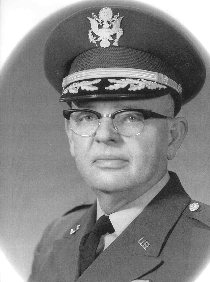 Brigadier General W. Keith Weltmer was born on July 30, 1913 in Hiawatha, Kansas. His military career began when he enlisted in Battery E, 130th Field Artillery Regiment, Kansas National Guard. Rising through the ranks, he was commissioned as a Second Lieutenant on December 1, 1937. He entered active duty on December 23, 1940 when the 35th Infantry Division was mobilized for World War II and sent to Camp Joseph T. Robinson, Little Rock, Arkansas. After a year of training, his unit was sent to California to defend the West Coast. In June 1942, he was sent with the 154th Field Artillery to Alaska and the Aleutian Islands, which although owned by the United States, was occupied by the Japanese. After heavy fighting, Japan was driven off the islands. After this success, the battalion was sent to Camp Van Dorn, Mississippi, Fort Benning, Georgia and then to Frot Bragg, North Carolina.
Brigadier General W. Keith Weltmer was born on July 30, 1913 in Hiawatha, Kansas. His military career began when he enlisted in Battery E, 130th Field Artillery Regiment, Kansas National Guard. Rising through the ranks, he was commissioned as a Second Lieutenant on December 1, 1937. He entered active duty on December 23, 1940 when the 35th Infantry Division was mobilized for World War II and sent to Camp Joseph T. Robinson, Little Rock, Arkansas. After a year of training, his unit was sent to California to defend the West Coast. In June 1942, he was sent with the 154th Field Artillery to Alaska and the Aleutian Islands, which although owned by the United States, was occupied by the Japanese. After heavy fighting, Japan was driven off the islands. After this success, the battalion was sent to Camp Van Dorn, Mississippi, Fort Benning, Georgia and then to Frot Bragg, North Carolina.
Brigadier General Weltmer was unable to deploy with his unit to the Pacific Theatre due to an injury and he was reassigned to Fort Bragg as an Instructor. He also served as a Battalion Executive Officer for the Field Artillery Board Support Battalion. He was released from active duty on January 23, 1946 with the rank of Major. He rejoined the Kansas National Guard on May 24, 1948, serving as Executive Officer and Battalion Commander of the 127TH Field Artillery Battalion and later as Executive Officer and Commander of the 35TH Infantry Division Artillery until 1961. He commanded the 127TH Field Artillery Group from 1962 until 1967. In December 1967, he was assigned as Deputy Chief of Staff for Operations and Training, Kansas Army National Guard. He was federally recognized as a Brigadier General of the line on May 9, 1968. He retired from the Kansas Army National Guard on July 31, 1973. His career spanned more than 43 years of military service to his state and nation.
He graduated High School in Hiawatha in 1931, then received an AA Degree from Highland Junior College in 1933. He attended Washburn University, Topeka, receiving an LLB Degree in 1937. He then attended the University of Kansas, Lawrence receiving a Masters Degree in Accounting in 1948. He returned to Washburn University and received a BA Degree in Business Administration in 1951. He also did post graduate work at Harvard University, Boston, MA in the Graduate Business School in 1961. On the military side, he attended the Field Artillery Advanced Course, 1944, Command and General Staff College, 1959 and the Senior Field Artillery Officer Course in 1961.
His awards and decorations include; The Legion of Merit, American Defense Service Medal, American Campaigh Medal, Asiatic-Pacific Campaign Medal with 1 Battle Star, World War II Victory Medal, Armed Forces Reserve Medal, National Guard Bureau Eagle Award, Army Reserve Components Achievement Medal, Kansas National Guard Service Medal with 30 Year Device and the 130TH Field Artillery Regiment Distinghished Member Award.
General Weltmer also had a very distinguished career in education and state government in Kansas. He was appointed to the faculty at the University of Kansas and taught at the Washburn School of Law. He received numerous awards in the civil education sector including University Distinguished Professor Emeritus by the Kansas Baord of Regents in 1978. He served as Secretary of Administration under Governor Robert Bennett. He was inducted into the Kansas National Guard Hall of Fame, 3 November 2002.
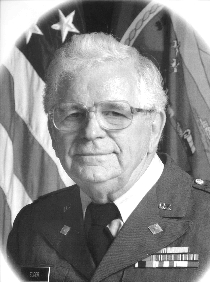 Colonel Elder was born on September 13, 1920 in Wichita County, Kansas. He began his military career by enlisting in Headquarters Detachment of the Kansas Army National Guard on 3 October 1940 where he was assigned to the Kansas Selective Service Headquarters. From June 1943 until November 1945 he was mobilized and served with the 250th Station Hospital in England and Europe. Upon his return, he received a direct commission in the Finance Corps on November 15, 1949 while with the United States Army Reserve. In October 1950 he again joined the Kansas National Guard, serving with the Selective Service Section of the State Headquarters. He served on active duty with the Selective Service from June 1951 to January 1970 and retired in November of 1970 as the State Director.
Colonel Elder was born on September 13, 1920 in Wichita County, Kansas. He began his military career by enlisting in Headquarters Detachment of the Kansas Army National Guard on 3 October 1940 where he was assigned to the Kansas Selective Service Headquarters. From June 1943 until November 1945 he was mobilized and served with the 250th Station Hospital in England and Europe. Upon his return, he received a direct commission in the Finance Corps on November 15, 1949 while with the United States Army Reserve. In October 1950 he again joined the Kansas National Guard, serving with the Selective Service Section of the State Headquarters. He served on active duty with the Selective Service from June 1951 to January 1970 and retired in November of 1970 as the State Director.
Colonel Elder attended Leoti Grade School (Wichita County), Wichita County High School, Clark’s Business School in Topeka and Washburn University, Topeka, Kansas. He received a BBA Degree from Washburn University in 1949 and a Juris Doctorate Degree from the Washburn University School of Law in 1951. From the time of his military retirement in 1970, he was the Kansas State Director of Selective Service and served in that capacity in Federal Civil Service until his retirement in June 2001. Combining his military and Civil Service status between 1940 and 2001, COL Elder gave over sixty years to the state and nation in the Selective Service Program.
Colonel Elder was promoted to First Lieutenant on 31 January 1952, then to Captain on 12 August 1955. His Field Grade appointments began with his promotion to Major on 5 March 1962, Lieutenant Colonel on 12 April 1966 and Colonel on 3 June 1970. Colonel Elder’s decorations and awards include; the Good Conduct Medal, American Defense Service Medal, American Campaign Medal, European-African-Middle Eastern Campaign Medal, World War II Victory Medal, Army of Occupation Medal, National Defense Service Medal and Armed Forces Reserve Medal. He was also decorated by the Selective Service with the Selective Service Meritorious Award (Bronze Medal), Selective Service Exceptional Service Award (Silver Medal) (Two Awards) and the Selective Service Distinguished Service Award (Gold Medal) which is thee agency’s Highest Honor.
Colonel Elder is credited as having been the first Selective Service Director who was not the Adjutant General of Kansas. His tenure expanded through three wars; World Ward II, Korea and Vietnam, all of which drew on the Selective Service System for Fair and Impartial Induction of Kansas youth into the military ranks when our country was at war. Through his long career, Colonel Elder was recognized by his superiors at state and national levels for his knowledge, experience and fairness in administration of the program. When the Selective Service was change to a Standby Status following the Vietnam War, Colonel Elder was asked to serve on National Committees to formulate policies and maintain the importance of the Selective Service to the United States Military System.
Colonel Elder also found time to be highly involved in the community with church, civic clubs, professional clubs, military associations, the Kansas Bar Association, the Boy Scouts of America, Masonic Lodge and others. He is also a generous supporter of United Way, Stormont-Vail Medical Center and Washburn University. He was inducted into the Kansas National Guard Hall of Fame, 3 November 2002.
 Chief Master Sergeant Bernard E. Carbon was born on August 25 1929 in Fort Scott, Kansas. He began his military career by enlisting in the United States Air Force in 1949 where he was trained as a Life Support Technician. He served in Texas, California, Guam, Japan and Georgia. During the Korean War, he was an Anti-Aircraft Gunner in Anita Air Base, Tokyo, Japan. At the conclusion of the Korean War, he served the remainder of his enlistment at Warner Robins Air Force Base in Georgia, being discharged in 1952.
Chief Master Sergeant Bernard E. Carbon was born on August 25 1929 in Fort Scott, Kansas. He began his military career by enlisting in the United States Air Force in 1949 where he was trained as a Life Support Technician. He served in Texas, California, Guam, Japan and Georgia. During the Korean War, he was an Anti-Aircraft Gunner in Anita Air Base, Tokyo, Japan. At the conclusion of the Korean War, he served the remainder of his enlistment at Warner Robins Air Force Base in Georgia, being discharged in 1952.
Chief Carbon joined the Kansas Air National Guard with the 127 th Fighter Bomber Squadron in Wichita, Kansas in 1953. He was assigned as a Supply Technician until 1968 with the 184th Resource Management Group. In February, 1968, during the Pueblo Crisis, he was called to Active Duty with the 184th Tactical Fighter Group as First Sergeant of the Supply Squadron, deployed to Kusan Air Force Base, Korea. This deployment ended in June, 1969 and he returned to be the first Sergeant of the 184th Supply Squadron. During his years in the Supply Squadron, several aircraft transitions were experienced in the 184th including the F-80 in 1954, F-86 in 1958, F-100 in 1961, F-105 in 1971 and F-4 in 1979. As a Resource Manager, these transitions required a great deal of planning for projection of manpower and facilities to accommodate the changing aircraft and missions. Often he had set up two separate supply functions during aircraft transitions. The unit never went wanting for fast and accurate supplies under Chief Carbon, even in the toughest transitions.
In August, 1983, Chief Carbon was selected to serve as the Senior Enlisted Advisor to the Director, Air National Guard, the Pentagon, Washington, D.C., being the third person to serve in this, the Highest Enlisted Position in the Air National Guard. Here, he traveled extensively, maintaining close communication with men and women in the field in all the United States, Guam, Puerto Rico and the Virgin Islands. He also maintained close liaison with his counterparts in the Air Force and other Major Commands. He also served on the Department of Defense, Reserve Forces Advisory Council while assigned to the Washington, D.C. post.
Following the Pentagon Tour, Chief Carbon was reassigned to the Chief of Management Procedures at Andrews air Force Base, Maryland, with the Air National Guard Support Center. He retired from Active service on July 31, 1987 with thirty-seven years service to his state and nation. Chief Carbon is a Charter Member of the Enlisted Association of Kansas and served as President for four years. He was one of the Kansas Guardsmen attending the First enlist Association of the United States Conference. Chief Carbon is involved in many civic organizations, National Guard Related Activities and the Department of Emergency Management of Kansas.
His awards and decorations include the Meritorious Service Medal with One Oak Leaf Cluster, the Air Force Commendation Medal, the Air Force Good Conduct Medal with 2 Oak Leaf Clusters, the Army Good Conduct Medal, the Army Occupation Medal, the National Defense Service Medal with 1 Bronze Star, Korean Service Medal with 1 Oak Leaf Cluster, Overseas Service Ribbons( Short Tour and Long Tour), Armed Forces Expeditionary Medal, the Air Force Longevity Ribbon with 1 Silver and 3 Bronze Oak Leaf Clusters, The Armed Forces Reserve Medal with 1 Gold Hourglass Device, the Air Reserve Forces Meritorious Service Award with Four Oak Leaf Clusters, the Small Arms Expert Marksmanship Badge, The Air Force Outstanding Unit Award with Two Oak Leaf Clusters, and the Kansas Air National Guard Service Medal with 3 Sunflower Devices. He was inducted into the Kansas National Guard Hall of Fame, 3 November 2002.
 Charles A. Morris
Charles A. MorrisCharles A. Morris was born July 2, 1839, in Clinton County, Pennsylvania. The history of the Morris family in America extends back into the remote annals of colonial settlement, when the ancestors of the American branch emigrated from England, and settled in Pennsylvania. During the Revolution they were assisting their colonial brethren to throw off the British Government. Of this family was Robert Morris, one of the ablest financiers of the young republic, and a signer of the Declaration of Independence, and Stephen Morris, the grandfather of Charles A. Morris. Stephen Morris was born in Pennsylvania in 1763, subsequently settled in the Catskill Mountains in New York, and afterward removed to Allegany County, where he died in 1860. He was a soldier of the War of 1812, and a farmer during his entire life. William A. Morris, the father of Charles, was born in the Catskill Mountains in 1805. At the age of twenty-one he entered the United States marine service and cruised among the South Sea Islands for three years, settled in Clinton County, Pennsylvania, in 1831, moved to Allegany County, New York, in 1843, served in the 85th New York Infantry from 1861 to 1863, removed to Fort Scott, Kansas, in 1868, was a farmer during his business life, but has now retired from active duty, and is spending the evening of his life in Fort Scott. The mother of Charles was Elizabeth Quay, a descendant of Lord Bond of Ireland. Her grandfather immigrated to Pennsylvania prior to the Revolution, and was in the colonial army during that struggle. Her father, John Quay, was a Pennsylvania farmer. She intermarried with William A. Morris in 1831.
Charles was the fourth of ten children. His early instructions were received in the common schools of Allegany County, which he attended when not employed on the farm. In 1854 he attended the Richburg Academy, and afterward that at Friendship, both in Allegany County. In 1858 he returned to his native county and was for three years employed in teaching. In September, 1861 he enlisted as a private in Co. E, 5th New York Cavalry, which joined the army in the Shenandoah Valley. He took part in the battles of New Market, second Winchester, and on August 2, 1862, the engagement at Orange Court House, where he was wounded [shot in the left arm] and disabled for duty. Having been discharged, he returned to Clinton County, Pennsylvania, and taught school. In the spring of 1863 he was appointed deputy provost marshal of the 18th Pennsylvania district. In September, 1864, he resigned this position, recruited Co. G, 203rd Pennsylvania Infantry, and was , on its organization, commissioned captain. The regiment joined the Army of the James and was engaged in the battles of Deep Bottom and Chapin Farm. In January, 1865, the 2nd Brigade, 2nd Division, 10th Army Corps, was detached and joined the expedition against Fort Fisher, North Carolina, and in the battle there his company suffered heavy loss. He was also in the skirmishes which preceded the capture of Wilmington, North Carolina. He was discharged June 22, 1865, and in the fall of that year he located at Fort Scott, Kansas, where he was employed as a salesman in a dry-goods house. In March, 1866, he was appointed deputy treasurer of Bourbon County. In November, 1868, he was elected county treasurer, re-elected in 1870 and held that office until 1872. From the expiration of his term until January, 1873, he was engaged in merchandising, but being appointed adjutant general of Kansas and private secretary to Governor Osborn, he removed to Topeka. In 1874 he commanded the state troops during the Indian troubles on the Kansas border, resigning his position in 1876. In December, 1874, he was appointed register in the United States land office at Larned, Pawnee County.
Politically, he is a Republican. He was a delegate to the National Convention at Philadelphia in 1872, and was a member of the committee on resolutions. He has also served as a delegate to different state, and Congressional conventions. He is liberal in his religious opinions. He was married May 17, 1864, to Miss Elizabeth F. Stewart, daughter of Robert and Mary (Gamble) Stewart, of Clinton County, Pennsylvania. They have had four children. He is Mason and a Knight Templar, having held the position of captain-general of Hugh de Payne Commandery, of Fort Scott. He is also an Odd Fellow and a member of the Encampment.
Morris is recognized as a leading citizen in whatever community he resides. He has many traits of character which push him irresistibly to the front, and his personal attractionsare such that as to render him immensely popular. He has led a life of more that ordinary activity, and his well-earned reputation will descend as a rich legacy and heritage to his children.
From the United States Biographical Dictionary
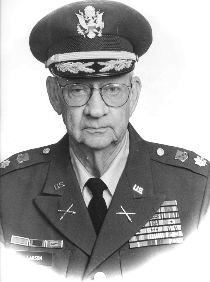 Major Larson was born on 28 July 1932in Horton, Kansas. He began his military career by enlisting in Battery C, 154th Field Artillery at Horton as Fire Direction Computer on 12 June 1950, the year he graduated from Horton High School. In October 1956, he received a direct commission as Second Lieutenant with assignment as Assistant Executive Officer of Battery C, 154th Field Artillery which was redesignated Battery B, 2nd Battalion 130th Field Artillery in April 1959. He was promoted to First Lieutenant that year and was assigned as Executive Officer where he served until 1964 when he was promoted to Captain. He was then reassigned to Headquarters, 2nd Battalion 130th Field Artillery as Liaison Officer then later as Battalion Communications Officer. In February 1966, he returned to Battery B as Commander. He was reassigned in 1967 as Commander of Headquarters Battery.
Major Larson was born on 28 July 1932in Horton, Kansas. He began his military career by enlisting in Battery C, 154th Field Artillery at Horton as Fire Direction Computer on 12 June 1950, the year he graduated from Horton High School. In October 1956, he received a direct commission as Second Lieutenant with assignment as Assistant Executive Officer of Battery C, 154th Field Artillery which was redesignated Battery B, 2nd Battalion 130th Field Artillery in April 1959. He was promoted to First Lieutenant that year and was assigned as Executive Officer where he served until 1964 when he was promoted to Captain. He was then reassigned to Headquarters, 2nd Battalion 130th Field Artillery as Liaison Officer then later as Battalion Communications Officer. In February 1966, he returned to Battery B as Commander. He was reassigned in 1967 as Commander of Headquarters Battery.
In April 1968, the Battalion was mobilized as part of the 69th Infantry Brigade in response to the Pueblo Incident and stationed at Fort Carson, Colorado. He was reassigned as the Assistant S-3 and promoted to the grade of Major in October 1968. The following month, he was levied for service in Vietnam. He was assigned to the 9th Infantry Division as assistant S-3, then to 2nd Battalion, 4th Field Artillery as Liaison Officer to the 3rd Battalion of the 9th Infantry Division at Tan An. He was the Tan An Airfield Commander until November 1969 when he was released from active duty. He returned to the 2nd Battalion, 130th Field artillery and in April 1970 was transferred to Headquarters, 69th Infantry Brigade. He served as the Brigade Provost Marshall, Inspector General and Assistant S-3. He transferred to the Control Group, United States Army Reserve in May 1975.
In May 1979, he returned to the Kansas Army National Guard as a Chief Warrant Officer Two in the Personnel Section of Company A, 169th Support Battalion. In September 1985, he was reassigned to Headquarters, 35th Infantry Division in Fort Leavenworth, Kansas, then returned to the 2nd Battalion, 130th Field Artillery in May 1986 as the Unit Supply Technician until August 1992 when he retired as Chief Warrant Officer Four with a retired rank of Major.
He is active in his community, serving as Past Commander of VFW Post 5210, Member, Hiawatha Elks and American Legion Post 373. He is active in St. Ann’s Catholic Church. He has worked Hiawatha High School Football as a member of the “Chain Gang” for over 25 years. He is a Life Member of the National Guard Associations of Kansas and the United States, serving three terms on the Board of Directors and volunteers for the Museum of the Kansas National Guard.
His awards and decorations include; the Silver Star Medal, Bronze Star Medal with Oak Leaf Cluster, Legion of Merit, Air Medal, Army Commendation Medal with V Device, Army Commendation Medal with three Oak Leaf Clusters, Army Achievement Medal, Army Reserve Component Achievement Medal with four Oak Leaf Clusters, Armed Forces Reserve Medal with Silver Hourglass Device, Korean Service Medal, Vietnam Service Medal, National Defense Service Medal with two Oak Leaf Clusters, Civil Action Medal, Republic of Vietnam Campaign Medal, Good Conduct Medal, Three Overseas Service Ribbons and the Army Service Ribbon. He was inducted into the Kansas National Guard Hall of Fame, 4 November 2001.
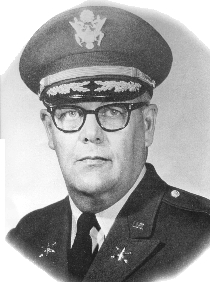 Colonel Bennett was born on April 6, 1911 in Hutchinson, Kansas. He began his military Career by enlisting in Battery C, 1st Battalion, 130th Field Artillery Kansas Army National Guard on October 17, 1929. As a private his military duty consisted of caring for the unit’s horses, which pulled the gun carriages for the unit’s French 75mm Guns. He was activateD with that unit for World War II in December 1940 and was assigned to Battery B and Commissioned as a Second Lieutenant. The unit mobilized to Camp Joseph T. Robinson, Arkansas and participated with the 35th Division in the Louisiana Maneuvers in 1941 after the attack on Pearl Harbor, the 130th was sent to California as part of the Western Defense Command and he was reassigned to Battery D, 2nd Battalion 130th Field Artillery as Battery Commander. The unit was reorganized into the 154th Field Artillery and he commanded Battery A. The 154th served in Alaska, Aleutian Islands, he was transferred to the Battalion Staff as S-2 and worked with the ADAK Intelligence Operation. The Field Artillery unit returned to the United States, assigned at Camp Dorn, Mississippi, Fort Benning, Georgia and Fort Bragg, North Carolina. In April 1945 the unit participated in President Roosevelt’s Funeral Procession in Washington, D.C. On June 18, 1945 the 154th Field Artillery moved back to Fort Bragg, North Carolina then to the Philippine Islands in preparation of the advance to Japan. The war ended that year and the 154th was deactivated in the Philippines. Colonel Bennett was reassigned to Command Company L, 145th Infantry Regiment of the 37th Division and was separated from active service on May 27, 1946 completing over five and a half years on active duty.
Colonel Bennett was born on April 6, 1911 in Hutchinson, Kansas. He began his military Career by enlisting in Battery C, 1st Battalion, 130th Field Artillery Kansas Army National Guard on October 17, 1929. As a private his military duty consisted of caring for the unit’s horses, which pulled the gun carriages for the unit’s French 75mm Guns. He was activateD with that unit for World War II in December 1940 and was assigned to Battery B and Commissioned as a Second Lieutenant. The unit mobilized to Camp Joseph T. Robinson, Arkansas and participated with the 35th Division in the Louisiana Maneuvers in 1941 after the attack on Pearl Harbor, the 130th was sent to California as part of the Western Defense Command and he was reassigned to Battery D, 2nd Battalion 130th Field Artillery as Battery Commander. The unit was reorganized into the 154th Field Artillery and he commanded Battery A. The 154th served in Alaska, Aleutian Islands, he was transferred to the Battalion Staff as S-2 and worked with the ADAK Intelligence Operation. The Field Artillery unit returned to the United States, assigned at Camp Dorn, Mississippi, Fort Benning, Georgia and Fort Bragg, North Carolina. In April 1945 the unit participated in President Roosevelt’s Funeral Procession in Washington, D.C. On June 18, 1945 the 154th Field Artillery moved back to Fort Bragg, North Carolina then to the Philippine Islands in preparation of the advance to Japan. The war ended that year and the 154th was deactivated in the Philippines. Colonel Bennett was reassigned to Command Company L, 145th Infantry Regiment of the 37th Division and was separated from active service on May 27, 1946 completing over five and a half years on active duty.
Returning to Kansas, he was a member of the United States Army Reserve. On July 1, 1947 the 130th Armored Field Artillery was organized in Hutchinson, Kansas and he was assigned as Battalion Commander. He commanded the Battalion for fourteen years, relinquishing command in 1961. He was also the Station Commander in Hutchinson for ten years, form 1951 to 1961. He transferred to the United States Army Reserve on September 1, 1961 and retired on April 5, 1971 as a Colonel. He ended his career with over thirty six years of military service to his credit.
In his years with the National Guard, Colonel Bennett was legendary in his leadership and insistence on adherence to standards. The Hutchinson Armory Complex is testament to his foresight, tireless effort and supervision of construction and maintenance. He is considered a benefactor to many organizations and is widely recognized for his generosity to organizations and institutions. He is a significant contributor to the Museum of the Kansas National Guard. He is also a major contributor of time and money in the construction of the Hutchinson Cosmosphere, a world class restoration and display site for space artifacts and is rated the number one tourist attraction in Kansas. Hs also maintain his live membership in numerous organizations and associations.
His numerous awards and decorations include; The Asiatic-Pacific Ribbon with one Battle Star, The American Service Medal, American Defense Medal, Philippine Liberation Medal, World War II Victory Medal, Armed Forces Reserve Medal with two Ten-Year devices, and State ribbons signifying over 30 Years Service. Other awards and recognitions are: The Historical Society of the Militia and National Guard Award, The honorable Order of Saint Barbara, 35th Division Artillery Award for Excellence and Many other commendations. He was inducted into the Kansas National Guard Hall of Fame, 4 November 2001.
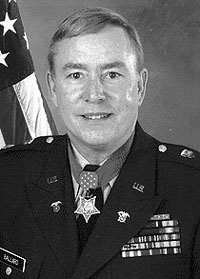 The only Medal of Honor winner in the reserve component who is still active in the military, Lt. Col. Donald E. Ballard, was promoted to colonel on April 5, 1998, during a ceremony surrounded by friends and colleagues at the State Defense Building in Topeka, Kan.
The only Medal of Honor winner in the reserve component who is still active in the military, Lt. Col. Donald E. Ballard, was promoted to colonel on April 5, 1998, during a ceremony surrounded by friends and colleagues at the State Defense Building in Topeka, Kan.
Maj. Gen. James F. Rueger, the adjutant general, pinned on Ballard’s new rank and remarked, “Donald has had some great experiences in the military including earning the Congressional Medal of Honor and commanding Guard units. He is a true Guardsman, and I’m very proud to be a part of this ceremony today.”
Ballard has been a member of the Kansas Army National Guard since 1970. In his remarks, Ballard reached out to his friends and comrades in arms, “You are my family. I’m proud to be here and to be in the National Guard.” The crowd responded with tremendous applause.
During his 27 years in the Guard, Ballard has been an ambulance platoon leader, company commander and served in several key positions. “What kept me from retiring was the honor of being asked to start a new unit — Medical Detachment 5,” said Ballard. He was the first person in the unit, and the executive officer. “Detachment 5 is the most cost-efficient organization I’ve ever seen in the Army,” said Ballard. “It saves the Guard thousands of dollars by performing physicals for Guard members instead of contracting them out.”
Ballard, who is a Special Assistant to The Adjutant General, has recently been asked to establish a new training program for the certification of all medics in the Kansas Guard. Ballard said he plans on using the same philosophy he learned as a Corpsman, “Preserving the force as far forward as possible” which means taking the training closer to the units rather than having unit personnel come to a central training site.
Ballard lives in North Kansas City, Mo., where he is a captain in the fire department’s emergency medical technician division, and owner of two funeral homes.
Ballard earned the Congressional Medal of Honor while a Navy Corpsman assigned to the Marines in Vietnam. The unit he was with was ambushed. Ballard repeatedly exposed himself to hostile fire to pull wounded Marines to a safer location and treat them. Later, this location was engulfed in a crossfire between the Marines and the enemy. An enemy hand grenade landed amongst the wounded. Ballard picked it up and threw it back. After a few minutes under direct fire, another grenade was thrown at his position. This time he didn’t have enough time to pick it up, so Ballard selflessly threw his body onto the grenade in order to protect his patients. After what seemed like an eternity, and no explosion, Ballard reached underneath him to grasp the grenade, rolled over, and in the same motion threw the grenade away. A split second later, witnesses say, the grenade exploded in midair, but out of harms way.
Ballard says he didn’t have time to think about what he did that day in 1968. It was instinct. Ballard said, “It was the right time to be in the wrong place.”
Ballard left the Navy in 1970 and was selected for Army officer candidate school. Ballard was called to the White House to receive the Medal of Honor from President Richard M. Nixon, General Westmoreland, and Admiral Moore. Upon finding out Ballard was switching over to the Army, Westmoreland offered him a direct commission to be an active duty Army officer. However, for family reasons Ballard turned the offer down but was persuaded to join the Kansas Army National Guard.
There are only three Medal of Honor winners still in military service in the U.S. In addition to Ballard, there are two active duty Army officers.
 Colonel Robert Baker was born on 8 March 1923. He began his military career by enlisting in the 3rd Battalion, 137th Infantry, and Kansas Army National Guard in 1938 when he was still a student at Wichita East High School. He was activated with the unit for World War II in 1940 and participated in the Normandy Landing at Omaha Beach and was in continuous combat in Europe. He had been through Ranger training and served with the Rangers for a year before returning to the 137th. Baker was captured by the enemy twice, the first, during the Battle of the Bulge from which he alone escaped and the second, when he and several other soldiers overpowered the German guards, allowing about three hundred prisoners to escape. During the war, he was wounded twice. He returned to his unit and continued the combat operations until the end of the war.
Colonel Robert Baker was born on 8 March 1923. He began his military career by enlisting in the 3rd Battalion, 137th Infantry, and Kansas Army National Guard in 1938 when he was still a student at Wichita East High School. He was activated with the unit for World War II in 1940 and participated in the Normandy Landing at Omaha Beach and was in continuous combat in Europe. He had been through Ranger training and served with the Rangers for a year before returning to the 137th. Baker was captured by the enemy twice, the first, during the Battle of the Bulge from which he alone escaped and the second, when he and several other soldiers overpowered the German guards, allowing about three hundred prisoners to escape. During the war, he was wounded twice. He returned to his unit and continued the combat operations until the end of the war.
Returning to Kansas with the 137th Infantry Regiment, he rose to the rank of First Sergeant of Headquarters Company. In 1953, when it was anticipated the unit would be mobilized for Korea, he received a direct commission as Second Lieutenant. As a member of the 1st Battalion, 137th Infantry, COL Baker rose to the rank of Major, serving as the Battalion S-3. In May 1968, the 137th was activated for Vietnam as part of the 69th Infantry Brigade in Fort Carson, Colorado. He was levied for duty in Vietnam and served as an Advisor to a South Vietnamese Infantry Regiment. Upon release from active duty in December 1969, Colonel Baker returned with the Battalion as Executive Officer and in 1971 was selected as Battalion Commander. He remained in that position until 1974 when he transferred to the Army Reserve and later retired.
Colonel Baker served over thirty four years in the military with thirteen of those being on active duty. In that time, twenty four years were as an officer and ten as an enlisted man, beginning at the age of fourteen. During his career he was constantly sought after for the difficult tasks. His leadership was exemplary and his legacy is that of a very dedicated, experienced and savvy soldier. His mentorship of both enlisted soldiers and officers reached legendary status from many other high-ranking individuals who were privileged to serve with him during his career. He was well respected by all who knew him and was held as the epitome of what a Guardsman should be. His entire Guard career, with the exception of short tours in training, with the Rangers and with the Vietnamese as Advisor, was spent in units of the 137th Infantry, Kansas Army National Guard.
In civilian life, Colonel Baker worked for the United States Postal Service and was Service Officer with the Wichita Police Department. He was active in the 137th Regimental affairs, serving as the Honorary Operations Officer for the Regiment. He continued to support the unit, the Kansas army National Guard and the National Guard Association of Kansas. He was instrumental in several reunion events and could always be counted on for his leadership and full participation.
His numerous awards and decorations amassed during his long career include; Combat Infantry Badge, Third Award, Prisoner of War Ribbon, Purple Heart, Second Award, Bronze Star Medal, Second Award, Campaign Star, Eight Awards and thirty three other awards, ribbons and medals. He was inducted into the Kansas National Guard Hall of Fame, 4 November 2001.
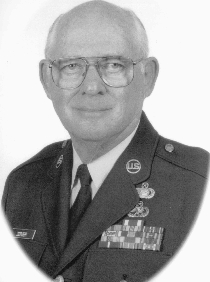 Chief Master Sergeant Duane Zerger was born on 16 May 1934 in Selkirk, Kansas. His military career began when he enlisted in the Kansas Air National Guard on 20 May 1957. He first served as an Administrative Clerk, and then later became a Maintenance Analyst for the 190th Consolidated Aircraft Maintenance Squadron. His expertise in this field made him one of the most effective in the Air National Guard community relating to summarization of aircraft schedules, performance data and maintenance trend analysis. He was later assigned as First Sergeant of the Maintenance Squadron. Chief Zerger retired on 16 May 1994 as the Chief of Administration of the 190th Air Refueling Wing, ending another highly successful segment of his long career.
Chief Master Sergeant Duane Zerger was born on 16 May 1934 in Selkirk, Kansas. His military career began when he enlisted in the Kansas Air National Guard on 20 May 1957. He first served as an Administrative Clerk, and then later became a Maintenance Analyst for the 190th Consolidated Aircraft Maintenance Squadron. His expertise in this field made him one of the most effective in the Air National Guard community relating to summarization of aircraft schedules, performance data and maintenance trend analysis. He was later assigned as First Sergeant of the Maintenance Squadron. Chief Zerger retired on 16 May 1994 as the Chief of Administration of the 190th Air Refueling Wing, ending another highly successful segment of his long career.
Chief Zerger probably came to be recognized for his true passion and legacy, that of an organizer. His organizational and motivation abilities brought many innovations to the Air Guard, most of which still benefit Guardsmen and their families today. He started, organized, nurtured and maintenance such entities as the Credit Union, the family Support Newsletter, the Welcome Home Pageant for the 190th after Desert Shield/Storm, computer training programs, physical fitness programs and facilities and Air Guard membership in the Adjutant General’s Ceremonial Platoon. He established classes, workshops and training programs that put the 190th on the leading edge of the tide into computers. He has organized recognition programs for the retired community, placed emphasis on the entire team, not just segments and generally enhanced the morale and well being of airmen and their families through his dedication to enhancing the quality of life for the military members. An accomplished artist, Chief Zerger used his talent to design the 190th Air Refueling Wing’s official emblem and the “Wylie Coyote” distinctive patch which can be observed all over the world due to various unit deployments.
His mentorship talents and loyalty served not only his fellow Airmen, but also commanders and staff members alike. Always available for counsel from all facets of the organization, he quickly offered advice, counsel and leadership where it counted; for the betterment of the total organization.
Outside his National Guard duties, Chief Zerger was active in the community. He was a Boy Scout Leader, promoted YMCA Baseball and Basketball programs as well as the Junior Achievement Program. Chief Zerger is a Life Member of the Enlisted Association of the National Guard of Kansas, served as Chair of the Nominations and Selection Committees and President of the Board of Governors of the Kansas National Guard Hall of Fame. He is a supporter of the Museum of the Kansas National Guard.
His awards and decorations include the Meritorious Service Medal, the Air Force Commendation Medal, the Air Force Achievement Medal, the National Defense Service Medal, the Air Force Longevity Ribbon with seven Oak Leaf Clusters, the Air Reserve Forces Meritorious Service Award with seven Oak Leaf Clusters, the Small Arms Expert Marksmanship Ribbon, the Air Force Outstanding Unit Award with one Oak Leaf Cluster, the Armed Forces Reserve Medal with two Hourglass Devices, the Air Force Training Ribbon, the Kansas Air National Guard Meritorious Service Ribbon, the Kansas Air National Guard Service Ribbon, the Kansas Air National Guard Recruiting Ribbon, the Master Information Managers Badge, the Master Aircraft and Munitions Maintenance Badge and the Adjutant General’s Ceremonial Platoon Badge. Chief Zerger was inducted into the Kansas National Guard Hall of Fame, 5 November 2000.
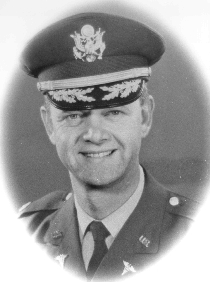 Colonel Steinkruger was born on 26 March 1928 in Franklin, Nebraska. His military career began when he enlisted in the US Army Reserve program and attended the South Dakota State College in the Army Specialized Training Reserve Program. Upon graduation, he was ordered to active duty from 19 July 1946 to 21 April 1947. He returned to Kearny State College, Kearny, Nebraska in 1950 and participated in the ROTC program at the University of Nebraska until 1953. After completing his internship as a Medical Doctor, he joined the Kansas National Guard as Battalion Surgeon of the 728th Field Artillery in 1956. He transferred from the 1st Battalion 235th Field Artillery of the 35th Infantry Division on 1 May 1959 as Battalion Surgeon. In April 1963, he was assigned as Surgeon of the 2nd Battalion, 130th Field Artillery. He was named Brigade Surgeon of the 69th Infantry Brigade on 1 August 1966.
Colonel Steinkruger was born on 26 March 1928 in Franklin, Nebraska. His military career began when he enlisted in the US Army Reserve program and attended the South Dakota State College in the Army Specialized Training Reserve Program. Upon graduation, he was ordered to active duty from 19 July 1946 to 21 April 1947. He returned to Kearny State College, Kearny, Nebraska in 1950 and participated in the ROTC program at the University of Nebraska until 1953. After completing his internship as a Medical Doctor, he joined the Kansas National Guard as Battalion Surgeon of the 728th Field Artillery in 1956. He transferred from the 1st Battalion 235th Field Artillery of the 35th Infantry Division on 1 May 1959 as Battalion Surgeon. In April 1963, he was assigned as Surgeon of the 2nd Battalion, 130th Field Artillery. He was named Brigade Surgeon of the 69th Infantry Brigade on 1 August 1966.
On 13 May 1968, then Major Steinkruger was mobilized with the 69th Infantry Brigade for the Pueblo Crisis. He continued to serve as Brigade Surgeon until September 1968 at which time he was assigned Chief, Department of Clinics MEDDAC, Fort Carson, Colorado. He was promoted to Lieutenant Colonel on 18 November 1968 and transferred to Camp McCoy, Wisconsin as Post Surgeon. He was released from active duty on 12 December 1969 and returned to Kansas to his former position as Brigade Surgeon with the 69th Infantry Brigade.
In November 1973, Colonel Steinkruger was appointed as the State Surgeon of the Kansas Army National Guard. He held this position until February 1988. He continued to serve on the Adjutant General’s Staff until his retirement in March 1995 with almost 50 years from the time he entered service in 1945 with over 41 years credible service to his state and nation.
His service to the military continued as a Contract Doctor with the Irwin Army Hospital in Fort Riley, Kansas where he served and treated many Guardsmen during his tenure in civilian status.
Colonel Steinkruger has always been an active supporter of military and civic organizations with membership in the National Guard Associations of Kansas and the United States, Retired Officers Association, Kiwanis International, Benevolent and Protective Order of Elks, Rotary Club, Kansas Academy of Family Practices, American Academy of Family Practices and Riley County Medical Society.
Colonel SteinKruger’s awards and decorations include the Legion of Merit, Army Commendation Medal with Oak Leaf Cluster, Army Achievement Medal, Armed Forces Reserve Medal, National Defense Service Medal and Kansas National Guard Service Medal. He was inducted into the Kansas National Guard Hall of Fame, 5 November 2000.
 Brigadier General Edgar L. DeGraw was born on March 4, 1922 in Nanuet, New York. His military career began when he enlisted in the New Jersey Army National Guard 16 November 1939. He was ordered to active duty for World War II with his New Jersey Guard Unit on 16 September 1940. On 1 September 1942 he was commissioned as a Second Lieutenant in the Army of the United States after having completed the Engineer Officer Candidate School. He served as a Second Lieutenant, First Lieutenant and Captain with the 4th Armored Division through 18 September 1945. His service in the 4th Armored Division took him through Normandy, Northern France, Southern France, Rhineland and the Ardennes Battle Campaigns. At the End of World War II, General DeGraw found himself in Czechoslovakia, having served in five major Battle Campaigns. He was awarded the Bronze Star for rescuing two disabled Tanks while under direct enemy fire. He was released from active duty on 15 April 1947 and assigned to the Officer’s Reserve Corps.
Brigadier General Edgar L. DeGraw was born on March 4, 1922 in Nanuet, New York. His military career began when he enlisted in the New Jersey Army National Guard 16 November 1939. He was ordered to active duty for World War II with his New Jersey Guard Unit on 16 September 1940. On 1 September 1942 he was commissioned as a Second Lieutenant in the Army of the United States after having completed the Engineer Officer Candidate School. He served as a Second Lieutenant, First Lieutenant and Captain with the 4th Armored Division through 18 September 1945. His service in the 4th Armored Division took him through Normandy, Northern France, Southern France, Rhineland and the Ardennes Battle Campaigns. At the End of World War II, General DeGraw found himself in Czechoslovakia, having served in five major Battle Campaigns. He was awarded the Bronze Star for rescuing two disabled Tanks while under direct enemy fire. He was released from active duty on 15 April 1947 and assigned to the Officer’s Reserve Corps.
On 12 May 1950, General DeGraw reentered the National Guard as Battery Commander, Headquarters Battery of the 135th Anti-Aircraft Artillery Battalion, Kansas Army National Guard, in Hays, Kansas. His service with the 135th included assignments to Headquarters, 35th Infantry Division Artillery, Topeka, Kansas as the S-1. On 28 March 1962 he was promoted to Lieutenant Colonel. His service continued with the 35th Infantry Division Artillery until 31 March 1963 during which time he served as the S-3 and Fire Support Coordinator. On 1 April 1963 he was assigned as Executive Officer of the 127th Field artillery Group, Topeka, Kansas. On 1 February 1965 he was assigned to Headquarters Kansas Army National Guard as Chief of the Military Support Section. On 30 March 1965 he was promoted to Colonel and assigned as the Military Support Plans Officer. During his tenure in this position he spearheaded the riot control training that prepared the Kansas National Guard for Riot Control Duty conducted in the 1960s. On 4 February 1971 he was promoted to Brigadier General and assigned as the Assistant Adjutant General for the Kansas Army National Guard. Brigadier General DeGraw retired from that position in March of 1982 with almost 40 years of service to his state and nation.
General DeGraw served on many committees with the National Guard Association of Kansas. He was President of the organization in 1977 and 1978. He was one of the two officers who conceived and developed the Kansas National Guard Hall of Fame. He was also instrumental in supporting the development and approval of the National Guard Association Distinguished Service Medal which is still in use and worn by many deserving individuals. He is a member of many military and civic organization and honor societies.
The General’s awards and decorations include the Legion of Merit, the Bronze Star Medal, Army Commendation Medal, Good Conduct Medal, European-African Middle Eastern Campaign medal, American Defense Service Medal, American Campaign Medal, World War II Victory Medal, Army Occupation Medal, Armed Forces Reserve Medal with 3rd Oak Leaf Cluster, Army Reserve Components Achievement Medal with 2nd Oak Leaf Cluster, Presidential Unit Citation, Distinguished Unit Badge, French Fourragere, Kansas National Guard Service Medal with 3rd Oak Leaf Cluster, Kansas Emergency Duty Service Ribbon, Kansas National Guard Distinguished Service Medal and the National Guard Association of Kansas Distinguished Service medal. He was inducted into the the Kansas National Guard Hall of Fame, 5 November 2000.
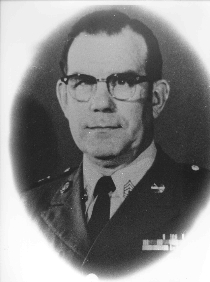 Sergeant Major John D. Trost was born on 3 November 1928 in Concordia, Kansas. His military career began when he enlisted in the United States Air Force on 14 February 1948 where he served as a Photographer until 7 November 1949. After a short break in service, he joined the United States Navy during the Korean Crisis on 31 October 1950, serving as a Hydraulics and Structural Mechanic on the U.S.S Randolph in the Mediterranean Sea Being discharged on 10 August 1954. SGM Trost joined the Kansas Army National Guard on 14 June 1963, serving initially as a Fire Direction Computer in Headquarters and Headquarters Battery 2nd Battalion, 130th Field Artillery. He had several other assignments in Headquarters and Headquarters Battery including; First Cook, Mess Steward, Chief Fire Direction Computer, Operations Sergeant, Personnel Staff NCO, Supply Sergeant, First Sergeant, Battalion Personnel Services NCO, Battalion Operations NCO and finally as the Sergeant Major of the Battalion.
Sergeant Major John D. Trost was born on 3 November 1928 in Concordia, Kansas. His military career began when he enlisted in the United States Air Force on 14 February 1948 where he served as a Photographer until 7 November 1949. After a short break in service, he joined the United States Navy during the Korean Crisis on 31 October 1950, serving as a Hydraulics and Structural Mechanic on the U.S.S Randolph in the Mediterranean Sea Being discharged on 10 August 1954. SGM Trost joined the Kansas Army National Guard on 14 June 1963, serving initially as a Fire Direction Computer in Headquarters and Headquarters Battery 2nd Battalion, 130th Field Artillery. He had several other assignments in Headquarters and Headquarters Battery including; First Cook, Mess Steward, Chief Fire Direction Computer, Operations Sergeant, Personnel Staff NCO, Supply Sergeant, First Sergeant, Battalion Personnel Services NCO, Battalion Operations NCO and finally as the Sergeant Major of the Battalion.
Sergeant Major Trost began his fulltime Career with the National Guard, serving in the 2nd Battalion 130th Field Artillery in 1966 as an assistant Administrative Supply Technician, Administrative Supply Technician, Operations, Training and Readiness Specialist and Battalion General Supply Technician where he served until his retirement on 3 November 1988. This represents a 40- Year plus military commitment from his initial entry with over 30 years active service and over 24 years in the Kansas Army National Guard. During his tenure with the 2nd Battalion 130thth Field Artillery, SGM Trost was mobilized during the Vietnam conflict and Pueblo Incident from 13 may 1968 to 12 December 1969.
In addition to his military career, SGM Trost was deeply involved in Community Affairs. He helped form the Jaycee Chapter in Hiawatha, Kansas, becoming President, was the Jaycee Area Director, help numerous Leadership positions in the VFW and American Legion. He was an active volunteer in the American Legion Baseball Program, was an instructor for the Kansas Hunter Safety Program, coordinator of Hiawatha Kids wrestling, officiated baseball, football and basketball and was a volunteer for the Hiawatha Elks Charitable Endeavors. SGM Trost was a strong supporter of the Museum of the Kansas National Guard, making significant personal Contributions and serving a fund-raiser for the Artillery Battalion. He served on the museum Board from its inception in 1986. He was also a volunteer museum host every month. SGM Trost is also a charter member of the Enlisted Association of the National Guard of Kansas. He served on the board for many Years and was elected President of the Association. He first attended the National Conference in 1976 and had only missed one conference upon his selection for the Hall of Fame.
His awards and decorations include the Meritorious Service Medal, the Army Commendation Medal, the Army Reserve Components Achievement Medal with 4th Oak Leaf Cluster, the Armed Forces Reserve Medal with third Oak Leaf Cluster, the Good Conduct Medal, Navy Overseas Medal, The National Defense Service Medal, and the Kansas National Guard Service Medal with 10 and 20 year devices. SGM Trost was inducted into the Kansas National Gaurd Hall of Fame, 7 November 1999.
 Chief Master Sergeant John S. Hayworth was born on 13 April 1931 in Fort Scott, Kansas. His military began when he enlisted in the 127th Fighter Squadron, Kansas Air National Guard on 26 August 1947. He first served as an Aircraft Mechanic on the F-51 aircraft. He was employed by the Beech and Boeing Aircraft Companies in Wichita until the activation of the 127th Fighter Squadron in October 1950 during the Korean conflict to activate Alexandria Air Force Base (now England AFB) in Louisiana. After mobilization, he assisted in the transition of the 127th Fighter Interceptor Squadron. In 1953 Chief Hayworth became a fulltime employee of the 127th Fighter Interceptor Squadron. In January 1968 the 127th was activated and deployed in July to Korea and upon return, Chief Hayworth assumed the duties ads Flight Chief. In 1971, he was assigned as Flight Line Superintendent and in 1977 promoted to the rank of Chief Master Sergeant.
Chief Master Sergeant John S. Hayworth was born on 13 April 1931 in Fort Scott, Kansas. His military began when he enlisted in the 127th Fighter Squadron, Kansas Air National Guard on 26 August 1947. He first served as an Aircraft Mechanic on the F-51 aircraft. He was employed by the Beech and Boeing Aircraft Companies in Wichita until the activation of the 127th Fighter Squadron in October 1950 during the Korean conflict to activate Alexandria Air Force Base (now England AFB) in Louisiana. After mobilization, he assisted in the transition of the 127th Fighter Interceptor Squadron. In 1953 Chief Hayworth became a fulltime employee of the 127th Fighter Interceptor Squadron. In January 1968 the 127th was activated and deployed in July to Korea and upon return, Chief Hayworth assumed the duties ads Flight Chief. In 1971, he was assigned as Flight Line Superintendent and in 1977 promoted to the rank of Chief Master Sergeant.
He was later assigned to Headquarters, Kansas Air National Guard as the Senior Enlisted Advisor. As such, he was responsible to the Kansas Air National Guard Headquarters, the 184th Tactical Fighter Group and 190th Air Refueling Group in all matters relating to the enlisted personnel with in the Kansas Air National Guard. His leadership, innovation and many years of experience made him a natural for this task: Interfacing with the commanders, enlisted members and leadership in crafting solutions to personnel and readiness problems facing the Air Guard. During his career, he was instrumental in the successful conversion of his unit form the F-51, to the F-84, to the F-80, to the F-86, to the F-100 to the F-105 and ultimately, to the F-4D aircraft.
Chief Hayworth introduced many innovations to resolve personnel difficulties during his tenure and was looked upon as an enlisted leader that could be counted upon. His solutions were palatable for line, midlevel and upper management while enhancing readiness. Many of his programs were adopted by other National Guard units and the active Air Force as models to accomplish the most complex of missions.
In addition to his National Guard duties, Chief Hayworth was active in the community, supporting various church activities, including responsibilities of Sunday School Teacher and member of the Church School Board. He was a Scout Leader and established an Air Explorer Post at Bethany Lutheran Church in Wichita. He also worked with the Boy Scout Quivera Council of Chatuaqua County. He served on the Southwest Boys Club Organization Committee and volunteered to assist with YMCA sports activities. Chief Hayworth is a life member of the Enlisted Association of the National Guard of Kansas, Life Member of the Veterans of Foreign Wars, a member of the National Rifle Association and supporter of the Museum of the Kansas National Guard.
His awards and decorations include the Meritorious Service Medal with one Oak Leaf Cluster, the Air Force Commendation Medal, the Air Force Outstanding Unit Award wit two Oak Leaf Clusters, the Air Force Good Conduct Medal, the Army Good Conduct Medal, the Air Reserve Forces Meritorious Service Award with four Oak Leaf Clusters, the National Defense Service Medal, the Armed Forces Expeditionary Medal, the Air Force Longevity Ribbon with seven Oak Leaf Clusters, the Armed Forces Reserve Medal with two Oak Leaf Clusters, the Air Force NCO Professional Military Education Ribbon, the Small Arms Expert Marksmanship Badge, the Air Force Training Ribbon and the Kansas Air National Guard Service Medal. He was inducted into the Kansas National Guard Hall of Fame, 7 November 1999.
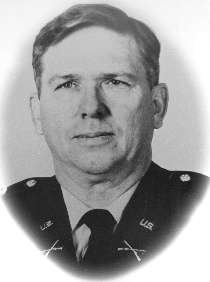 Colonel Rex H. Bartlow was born on 7 August 1932 in Aline, Oklahoma. His military career began when he enlisted in the Oklahoma Army National Guard on 23 May 1950. In September 1950 his unit, part of the 45th Infantry Division was mobilized. He served with the 45th Infantry Division through Basic training at Fort Polk, Louisiana, and in combat in Korea. He was released from active duty on 12 June 1952. He continued to serve in the Oklahoma Army National Guard until 22 May 1953. On 10 October 1956, he enlisted in Company B, 226th Engineer Battalion, Harper, Kansas as a Charter Member of this newly formed Engineer Battalion. He served as an Engineer Platoon Sergeant. In May 1957 he entered the Kansas Army National Guard Officer Candidate School and graduated in July 1958. He was commissioned a Second Lieutenant, Engineer Branch on 21 July 1958 in Company B, 226th Engineer Battalion. He served as a Platoon Leader and Executive Officer. In May 1963 he assumed command of Company C, 226th Engineer Battalion and served as Commander until July 1965. He served on the staff of the 226th Engineer Battalion as S-2 and Later S-4 until February 1968.
Colonel Rex H. Bartlow was born on 7 August 1932 in Aline, Oklahoma. His military career began when he enlisted in the Oklahoma Army National Guard on 23 May 1950. In September 1950 his unit, part of the 45th Infantry Division was mobilized. He served with the 45th Infantry Division through Basic training at Fort Polk, Louisiana, and in combat in Korea. He was released from active duty on 12 June 1952. He continued to serve in the Oklahoma Army National Guard until 22 May 1953. On 10 October 1956, he enlisted in Company B, 226th Engineer Battalion, Harper, Kansas as a Charter Member of this newly formed Engineer Battalion. He served as an Engineer Platoon Sergeant. In May 1957 he entered the Kansas Army National Guard Officer Candidate School and graduated in July 1958. He was commissioned a Second Lieutenant, Engineer Branch on 21 July 1958 in Company B, 226th Engineer Battalion. He served as a Platoon Leader and Executive Officer. In May 1963 he assumed command of Company C, 226th Engineer Battalion and served as Commander until July 1965. He served on the staff of the 226th Engineer Battalion as S-2 and Later S-4 until February 1968.
Colonel Bartlow then transferred to the 891st Engineer Battalion, Manhattan, Kansas where he served as S-1, S-3 and Executive Officer until April 1974 when he assumed command of the Battalion. He served as the 891st Engineer Battalion Commander until he was transferred to Headquarters, Kansas Army National Guard in October 1977. He served as Facilities Officer, Adjutant and Inspector General. On 30 September 1983 he was appointed Chief of Staff of the 35th Infantry Division (Mechanized) Fort Leavenworth, Kansas. He served as the first Chief of Staff of the Reactivated Division until 1 April 1985, when he returned to Headquarters, State Area Command, KSARNG as the Assistant Chief of Staff for Personnel (G-1). He continued to serve in this capacity until his retirement on 28 May 1986.
Colonel Bartlow served on many committees in the National Guard Association of Kansas throughout his career. He served with great distinction as the first Secretary and Interim President of the Kansas National Guard Museum Board. He also served two terms on the Hall of Fame Nomination Committee, one as president. He served as a volunteer reservist for the Kansas Division of Emergency Preparedness during the 1993 Flood, which included four months of work with the citizens of Elwood, Kansas. He continues today as a Volunteer Host at the Kansas National Guard Museum each month. He also continues to serve at the Museum and various other boards and committees.
Colonel Bartlow possessed a commitment to service that extended beyond his military assignments to include Past President of the Pamona Lyons Club International, Chairman, Faith Fund, Franklin County Gideon’s International, Deacon/Trustee, North Ottawa Baptist Church was the National Guard Coordinator for the President Dwight D. Eisenhower funeral and volunteer, for the Elderly and Handicapped transportation in Franklin County.
His awards and decorations include the Legion of Merit, National Defense Service Medal, Korean Service Medal, Japan Occupation Medal, United Nations Service Medal, Republic of Korea Presidential Unit Citation, Armed Forces Reserve Medal with Second Oak Leaf Cluster, Army Reserve Components achievement Medal with 4th Oak Leaf Cluster, Good Conduct Medal, Meritorious Service Medal, Army Service Ribbon, Army Commendation Medal and the Kansas national Guard Service Medal with 10 and 20 year devices. He was inducted into the Kansas National Guard Hall of Fame, 7 November 1999.
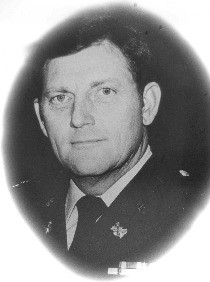 COL William E. Searcy was born on 2 October 1935 in Cresco, Iowa. His military career began in October 1953 when he enlisted in the Kansas Army National Guard, serving in Headquarters and Headquarters Battery, 195th Field Artillery Group in Iola, Kansas. After three years enlisted service, he attended OCS Class #1 in Topeka and was commissioned a Second Lieutenant on 19 July 1957. His first assignment was Automotive Officer, 496th Ordnance Group in Topeka. He later served as Personnel Officer (S-1) for the Group then was assigned as a Platoon Leader with the 714th Maintenance Company, serving until September 1963.
COL William E. Searcy was born on 2 October 1935 in Cresco, Iowa. His military career began in October 1953 when he enlisted in the Kansas Army National Guard, serving in Headquarters and Headquarters Battery, 195th Field Artillery Group in Iola, Kansas. After three years enlisted service, he attended OCS Class #1 in Topeka and was commissioned a Second Lieutenant on 19 July 1957. His first assignment was Automotive Officer, 496th Ordnance Group in Topeka. He later served as Personnel Officer (S-1) for the Group then was assigned as a Platoon Leader with the 714th Maintenance Company, serving until September 1963.
He returned to the 496th Ordnance Group as the Adjutant, then transferred to Headquarters, Headquarters Detachment of the Kansas Army National Guard, Topeka. His various assignments there include; Assistant G-3, Headquarters Commandant, Detachment Commander, Supply Staff Officer and Ordnance Maintenance Officer. In January 1973 he assumed command of the 110th Ordnance Battalion in Norton, Kansas. In November 1974, he returned as Personnel Officer with HHD, KSARNG. He was later assigned as Assistant G-1 (Personnel) then as the State Maintenance Officer and Assistant Chief of Staff for Logistics. In December 1981, COL Searcy was appointed as the United States Property and Fiscal Officer (USPFO) for Kansas. He held this position until his retirement in December 1990.
While serving as the USPFO, COL Searcy became most knowledgeable in the area of purchasing and contracting. With this, he started improving the facilities by either modification or new construction. Both Air Guard Bases during his time were undergoing changes in mission and equipment, which required many facility upgrades. Colonel Searcy worked closely with the National Guard Bureau and Legislators in Washington, and was able to bring millions of dollars to Kansas and improve the overall effectiveness of both Army and Air Guard units. The Kansas Army National Guard Mobilization and Training Equipment Site at Fort Riley is due in large part to Colonel Searcy’s knowledge and work in procurement of facilities for Kansas. This facility employs over one hundred Kansas Guardsmen on a full-time basis.
During his career in the Kansas Army National Guard, Colonel Searcy was active in many supporting entities. He is a member and Past President of the Association of the United states Army, a Life Member of the National Guard Association of The United States and Kansas, member of the American Legion and the Topeka West Rotary Club. He served on the National Guard Bureau Maintenance advisory Committee and was Chairman in 1979. He served on the USPFO Advisory Council from 1988 until retirement. He is a member of the USA Ordnance Center and School and served on the Reserve Components Advisory Group in 1980 and 1981. COL Searcy is well respected nationwide for his professionalism, attention to duty and drive to get things accomplished.
His awards and decorations include the Legion of Merit, Meritorious Service Medal with one Oak Leaf Cluster, Army Commendation Medal wit two Oak Leaf Clusters, armed Forces Reserve Medal with two Oak Leaf Clusters, Army Reserve Components Achievement Medal with two Oak Leaf Clusters, Army Service Ribbon, Kansas National Guard Service Ribbon, Kansas Emergency Duty Ribbon and the National Guard Association of Kansas Distinguished Service Medal. COL Searcy was inducted into the Kansas Officer Candidate Hall of Fame. He was inducted into the Kansas National Guard Hall of Fame, 1 November 1998.
 Colonel James E. Fox was born on 15 July 1934 in Hamilton, Ohio. His military career began on 6 March 1953 when he enlisted in the United States Army where he saw duty in Korea. He joined the Kansas Army National Guard, serving in Company B, 174th Military Police Battalion on 1 November 1956. He then attended the Kansas National Guard Officer Candidate School and was commissioned Second Lieutenant, Infantry on 21 November 1961. He was initially assigned as Platoon Leader with Company C, 2nd Battle Group, 137th Infantry. He was later transferred to the 1120th Transportation Company. In 1964, COL Fox attended the Army Aviators Course to become Fixed Wing qualified. The following year, he became qualified in Rotary Wing Aircraft. This paved the way for his assignment as Platoon Leader with the 137th Transportation Company. He then transferred to Company D, 169th Support Battalion in charge of the Aircraft Maintenance Platoon. On 13 May 1968, COL Fox was mobilized with the 69th Infantry Brigade during the Vietnam conflict. The following December, he was assigned to the 34th Group USARV in Vietnam with the 58th Transportation Battalion where he served as Aircraft Maintenance and Operations Officer.
Colonel James E. Fox was born on 15 July 1934 in Hamilton, Ohio. His military career began on 6 March 1953 when he enlisted in the United States Army where he saw duty in Korea. He joined the Kansas Army National Guard, serving in Company B, 174th Military Police Battalion on 1 November 1956. He then attended the Kansas National Guard Officer Candidate School and was commissioned Second Lieutenant, Infantry on 21 November 1961. He was initially assigned as Platoon Leader with Company C, 2nd Battle Group, 137th Infantry. He was later transferred to the 1120th Transportation Company. In 1964, COL Fox attended the Army Aviators Course to become Fixed Wing qualified. The following year, he became qualified in Rotary Wing Aircraft. This paved the way for his assignment as Platoon Leader with the 137th Transportation Company. He then transferred to Company D, 169th Support Battalion in charge of the Aircraft Maintenance Platoon. On 13 May 1968, COL Fox was mobilized with the 69th Infantry Brigade during the Vietnam conflict. The following December, he was assigned to the 34th Group USARV in Vietnam with the 58th Transportation Battalion where he served as Aircraft Maintenance and Operations Officer.
Released from active duty in December 1970, he was reassigned to Company D, 169th Support Battalion, then to the Headquarters Detachment as Intelligence Officer. COL Fox became a full time technician for the 169th and later became the Battalion Operations Officer and Executive Officer, culminating as Battalion Commander in September 1976. In December 1977 he was reassigned as Executive Officer and Deputy Brigade Commander of the 69th Infantry Brigade. In July 1981, he was reassigned to Headquarters Detachment of the Kansas Army National Guard as assistant Chief of Staff, Plans, Operations and Training. In October 1986, COL Fox was assigned as Chief of Staff of the Kansas Army National Guard and served in this position until his retirement on 15 July 1989. COL Fox finished his career with over 36 years of Military Service.
COL Fox possessed a commitment to service that extended beyond his military assignments to include Past President of the Association of the United States Army (Topeka Chapter), Past President of the National Guard Association of Kansas and life member of the National Guard Association of the United States. Member of the 35th Infantry Division Association, American Legion Post #1, Past President of the American Society of Industrial Security, Member of Crime Research of Topeka, The Topeka Chamber of Commerce and Fundraising Chairman of the Children’s Crime Victim Fund.
Undeniably, Colonel Fox is one of the best known and well-respected Kansas National Guard officers of his era. He leaves a legacy of excellent standards of performance and dedication to service. A true American Patriot.
His awards and decorations include the Legion of Merit, Bronze Star, Meritorious Service Medal with one Oak Leaf Cluster, Air Medal, 7th Award, Army Commendation Medal with four Oak Leaf Clusters, Army Reserve Components Achievement Medal with four Oak Leaf Clusters, National Defense Service Medal with one Oak Leaf Cluster, Korean Service Medal, Vietnam Service Medal with four Campaign Stars, Armed Forces Reserve Medal with two Hourglass Devices, United Nations Service Medal, Vietnam Campaign Medal with 60 Device, Army Service Ribbon, Kansas National Guard Service Ribbon Kansas Emergency Duty Ribbon, Master Army Aviator Badge and three Overseas Bars. He was inducted into the Kansas National Guard Hall of Fame, 1 November 1998.
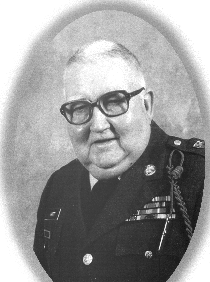 Master Sgt. Clarence I. Hart was born Feb. 14, 1923 in Perry, Kan. He grew-up working on the family farm and going to school until he was forced to take jobs in a fish canning factory and a construction company to help the family after his father’s health deteriorated.
Master Sgt. Clarence I. Hart was born Feb. 14, 1923 in Perry, Kan. He grew-up working on the family farm and going to school until he was forced to take jobs in a fish canning factory and a construction company to help the family after his father’s health deteriorated.
On February 1, 1943, Hart was inducted into the U.S. Army to serve during World War II. He was assigned to the 3204th Quartermaster (QM) Service Company and completed his basic training at Indio, California. He was shipped overseas on January 18, 1944 and served with the 3204th QM Svc Co., landing on Omaha Beach, Normandy, D Day + 1, as an amphibious duck and light truck driver. He also served in other Central European Battles. He returned to the United States on December 26, 1945. During this period of service in Europe he was awarded the World War II Victory Medal, the Good Conduct Medal. EAME Theater Ribbon with three Bronze Service Stars and one Bronze Arrowhead, Distinguished Unit Badge, Croix de Guerre with Palm Order of the Day and Meritorious Unit Award. Private First Class Hart was separated from active duty on January 3, 1946 at Ft. Chaffee, Arkansas.
Hart enlisted in Company B, 174th Military Police (MP) Battalion, Kansas Army National Guard as a Corporal on February 2, 1949. He entered active military service with Company B on October 7, 1950 in the grade of Sergeant to serve during the Korean conflict. On June 22, 1951, Hart was transferred to HQ Co. 505th MP Battalion at Camp Roberts, California and later was separated from active duty on May 14, 1952. During the above period he was sent active duty to Camp Desert Rock, Nevada for participation in the atmospheric nuclear test program the United States conducted from 1945 to 1962. Hart witnessed 17 atomic bomb tests. In some of the tests he was in fox holes as close as three miles from the detonation.
From 1953 to 1983, Hart served in a wide variey of positions within the Kansas Army National Guard including supply sergeant and food service supervisor. In 1964, Hart won a recruiting contest and a free trip to Washington, D.C. when he recruited 39 new soldiers. During this period he received many letters of commendation and appreciation from Kansas governors, generals, colonels, and heads of volunteer organizations. He retired from full-time duty on February 14, 1983.
Hart was a very active community volunteer over the years. He provided numerous hours of work for the Salvation Army, the Methodist Church, the Boy Scouts, the Red Cross, the Kansas Neurological Institute, and many others. He was also instrumental in the inauguration ceremonies of Governors William Avery, Robert Bennett and Mike Hayden.
Hart married Wilma Gantz in 1947 and raised three children, Sarah, Shelli and Stanley.
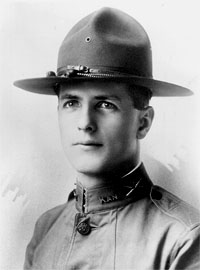 On June 6, 1917, 22-year-old Erwin Russell Bleckley, a bank teller with the 4th National Bank of Wichita, rushed down to enlist as a private in Battery F, First Field Artillery, Kansas National Guard. He was the second man to enlist according to Col. Bruce Griffith, unit commander, who organized the unit for World War I.
On June 6, 1917, 22-year-old Erwin Russell Bleckley, a bank teller with the 4th National Bank of Wichita, rushed down to enlist as a private in Battery F, First Field Artillery, Kansas National Guard. He was the second man to enlist according to Col. Bruce Griffith, unit commander, who organized the unit for World War I.
In another Wichita history book, Bear Grease Builders and Bandits by Beccy Tanner (1991), eyewitnesses described the pairs heroics: “Goettler skidded his plane, he made turns, he side-slipped a little occasionally, he climbed and then dived. Each time the plane turned and its great mottled belly flopped back into normal position, the men of the lost battalion expected to see it tumble from the sky… But on its way it went like a charmed thing, roaring up and down and across, rocked occasionally by the ash of big shells that had just passed… the plane finally crashed into the French terrain.”
They were flying so low they were just clearing tree tops to drop bundles of chocolate, cigarettes and medical supplies in that area 350 by 50 yards.
COL David Whittaker was born on July 9th, 1831, in the town of Herringdon, Nerrlingdon County, Pennsylvania. He moved to Doniphan County, Kansas Territory on April 10, 1857. In the summer of 1859, he moved to Atchison.
In June of 1861, he was appointed and commissioned by Governor Charles Robinson as the County Clerk of Atchison County, after the Governor had heard of the holder of the office, “a conspicuous pro-slavery man named Duff Green.” Whittaker later described Mr. Green as “obnoxious to the loyal free-state people at that time by reason of his detestable secession and disloyal utterances.”
Whittaker qualified as County Clerk by giving bond and taking the necessary oath of office, but was only that that position a few weeks when the Civil War came. After deputizing a young man to act in his place, he and a company of Volunteers marched to Fort Leavenworth, where he was enrolled and sworn into the United States service on the 16th day of July, 1861. He was commissioned a 2nd Lieutenant in Company B, 10th Regiment Kansas Volunteer Infantry.
During the summer of 1861 he was on active duty with the unit in southwest Missouri to suppress guerrillas and participated in the capture of West Point, Papinsville and Osceola, Missouri. In the summer of 1862, he participated in the invasion of the Cherokee Nation and was present at the capture of the rebel Colonel Clarkson, with over one hundred of his band at Locust Grove, Cherokee Nation, July 3rd, 1862. Whittaker had the honor of capturing two rebel flags in the engagement.
Later, he was involved in a battle at Newtonia, Missouri on September 29, 1862, where Kansas forces sustained severe losses, and also at the same place on October 4, 1862, in which the 10th Kansas was successful in routing the enemy. Whittaker was also at the engagement at Old Fort Wayne, Cherokee Nation, on October 22, 1862, where Confederate General Cooper sustained a heavy loss of men and the capture of a four-gun battery.
On October 25, 1862, Whittaker received an order from General Blunt, detaching him from his company to act as Provost Marshal of the 1st Division of the Army of the Frontier. He was at the capture of Cane Hill, Arkansas and the defeat of Confederate General Shelby at that place on November 23, 1862. He also participated in the glorious victory over the flower of “Southern Chivalry,” under Confederate General Hindman, at Prairie Grove, Arkansas on December 7, 1862.
On the July 4, 1863, his regiment was ordered to St. Louis, Missouri for Provost duty. In August of 1863, in compliance with orders from the War Department, he became a member of a Board of Officers to examine and report upon the qualifications of applicants for appointments as commissioned Officers of Colored Troops. He remained on this board until August, 1864. He had spent over three years on duty and was mustered out of the United States services on August 19, 1864.
He returned to Kansas and in 1869, ran for, and was elected State Representative from Doniphan County. He was re-elected from the same district, the 5th Representative District, and served on various Committees of the House, including Chairman of the Committee on Claims. On March 5, 1869, he was appointed as one of the commissioners to audit Price Raid Claims. During the 1870 Legislative session, Whittaker was appointed by Governor Harvey to the position of Adjutant General of the State of Kansas. He was confirmed by the Senate and on March 5, 1870, became Colonel David Whittaker, Kansas Adjutant General. He served in that position during Governor Harvey’s term of office.
Colonel Whittaker died September 6, 1904 and is buried in Topeka Cemetery 69, Loy 150.
Adapted by 1st Lt. Dave Young, HQ-KSANG, from a personal history written by David Whittaker on July 30, 1892, for the Kansas State Historical Society
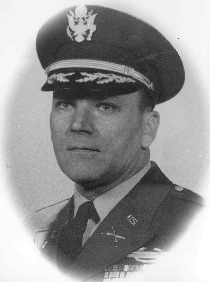 Col. Newby served in the Kansas Army National Guard, the U.S. Army Reserve, and on active duty for more than 40 years, rising in the ranks from private to colonel.
Col. Newby served in the Kansas Army National Guard, the U.S. Army Reserve, and on active duty for more than 40 years, rising in the ranks from private to colonel.
He enlisted with Headquarters Troop, 114th Cavalry, 24th Cavalry Division, Topeka, in 1934 and served with the Guard until 1938. He returned to the Guard in 1939 and was activated along with the remainder of the 35th Infantry Division in December 1940.
Newby achieved the rank of staff sergeant by 1942 but took a career turn and attended Officer Candidate School at Fort Benning, Ga. After commissioning, he became a platoon leader at the Branch Immaterial Training Center, Fort McClellan, Ala., followed by another stint as platoon leader in 1943, this time in Europe with Company A, 313th Infantry Division. In September 1944, he moved up to regimental headquarters as liaison officer/assistant S-1 (personnel officer) and liaison officer to the French 2nd Armored Division.
During his World War II service, Newby earned two Bronze Stars, the Purple Heart, the Combat Infantry Badge, the French Croix de Guerre with palm, and several campaign medals and service ribbons.
Newby returned to the United States in June 1945 to serve a a company commander with a training battalion at Camp Robinson, Ark., and was assigned to the officer reserve corps by year’s end. He returned to the Kansas Army National Guard in 1947 with Headquarters, 137th Infantry Regiment, 35th Infantry Division.
Newby continued a distinguished career with the Guard for the next 20 years. He served in the G-4 (logistics), G-3 (training and operations), and G-1 sections at 35th Infantry Division headquarters and was the S-3 at the 137th Infantry Regiment before becoming executive officer of the 2nd Battle Group, 137th Infantry Regiment in 1959.
He played a critical role on state duty during the 1951 floods in Topeka, protecting the Topeka water works. He also served as an instructor for Class #1 of the Kansas National Guard Officer Candidate School.
Newby went on to command three battalions: the 135th Transportation Battalion; the 169th Support Battalion; and 2nd Battalion, 137th Infantry.
His command of 2nd Battalion, 137th Infantry came at a time when his unit and the rest of the 69th Brigade were chosen to be part of the Selected Reserve Force and was authorized to become fulled staffed, supplied, and trained in order to achieve and maintain mobilization and combat-ready posture during the Vietnam War. This proved to be critical because shortly after Newby transferred from the Guard, the brigade was mobilized for active duty.
With his promotion to colonel, Newby transferred to the U.S. Army Reserve and remained there until his retirement in 1976. In 1993, Newby was inducted into the Officer Candidate School Hall of Fame at Fort Benning.
He is a lifelong member of the American Legion, the Retired Officers Association, the Reserve Officers Association, the National Guard Association, the 35th Infantry Division Association, and the Military Order of World Wars.
As a civilian, Newby served as a special agent for the intelligence division of the Internal Revenue Service from 1948 until 1973. He belongs to the National Association of Treasury Agents and is a member of the Masonic Lodge and a trustee with Grace Christian Church, Kansas City, Kansas.
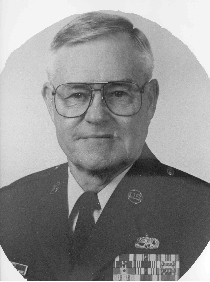 Chief Master Sgt. James A. Goetz grew up in Indiana and joined the U.S. Air Force in 1952. He received initial training on electronic fundamentals and upon graduation was selected for nuclear weapons electronics and mechanical training.
Chief Master Sgt. James A. Goetz grew up in Indiana and joined the U.S. Air Force in 1952. He received initial training on electronic fundamentals and upon graduation was selected for nuclear weapons electronics and mechanical training.
He came to Kansas as a member of the 36th Aviation Depot Squadron at Smoky Hill (later renamed Schilling) Air Force Base, Salina. He qualified in both nuclear and conventional weapons handling, including explosive ordnance disposal.
Goetz was discharged in 1957 and joined the Air Force Reserve while beginning what proved to be a 31-year career with the U.S. Postal Service. He came into the Kansas Air National Guard in 1965 with the 190th Tactical Reconnaissance Group in Hutchinson and ultimately became noncommissioned officer-in-charge (NCOIC) of the disaster preparedness section. He remained with the unit when it moved to Topeka.
Goetz served as first sergeant with the Supply Squadron, Group Headquarters, and the 190th Resource Management Squadron on five separate occasions among those units. His other assignments included supervisor of vehicle maintenance and a second tour as NCOIC of disaster preparedness.
In 1988, Goetz was promoted to chief master sergeant and was appointed senior enlisted advisor (SEA) for the Kansas Air National Guard, the top enlisted position in the state.
His tour as SEA was marked by his drive to improve NCO education and professionalism. He actively promoted resident school attendance of Professional Military Education (PME) courses such as Leadership School, NCO Academy, and the Senior NCO Academy. The Kansas Air National Guard became the leader in the number of PME graduates.
Goetz strengthened senior NCO leadership by initiating the First Sergeants Council at the 184th Fighter Group, Wichita, and co-organized the council at the 190th Air Refueling Group, Topeka. At the Topeka Council, Goetz created the Airman of the Quarter Program. He also used his own funds to create an award of a plaque and membership in the Enlisted Association of the National Guard of Kansas to deserving graduates of the Kansas Air National Guard Leadership School.
During Operation Desert Shield in 1990, Goetz was diagnosed with cancer. In spite of this, he postponed his treatment and asked to be excused from his SEA duties to serve as first sergeant of the newly-created 1701st Air Refueling Wing, Provisional, in Saudi Arabia. He was responsible for managing a unit with a mix of active duty, reserve, and Guard airmen.
Goetz returned to serve the Kansas Air National Guard until his retirement in 1992. He worked closely with his Army National Guard equivalent, the state command sergeant major, to put into place many of the joint Army and Air National Guard projects in use today.
He is a lifetime member of the Enlisted Association of the Nation Guard of Kansas and the Air Force Association. Goetz also belongs to the Air Force Sergeants Association and the Air Force Sergeants Diamond Club. His leadership extended to the civilian sector as well. Goetz was United Way coordinator for the Postal Service for five years and assisted the Muscular Dystrophy Association Telethon in Wichita for ten years. He continues to serve as chairman of the board of the Government Employees Credit Union in Wichita and acts as financial advisor for the Wichita Area Postal Employees Assistance Program.
Goetz is now retired from both the Air Guard and the Postal Service, living in Rose Hill with his wife, Marilyn.
 CSM George first tasted military life during ROTC at Kansas State College, but he didn’t join until his enlistment with Battery C, 1st Battalion, 127th Field Artillery, Paola, in 1949. In 1953, he became a full time technician with the U.S. Property and Fiscal Office (USPFO) at Fort Riley and transferred to the 110th Ordnance Company.
CSM George first tasted military life during ROTC at Kansas State College, but he didn’t join until his enlistment with Battery C, 1st Battalion, 127th Field Artillery, Paola, in 1949. In 1953, he became a full time technician with the U.S. Property and Fiscal Office (USPFO) at Fort Riley and transferred to the 110th Ordnance Company.
George made his move with the USPFO to Topeka and joined the 714th Ordnance Company, a newly-organized unit. He played an important role as a section sergeant to help build unit personnel strength.
He became a part of another new unit, Headquarters and Headquarters Detachment, 496th Ordnance Group, 19 1954. He was promoted to sergeant first class and given the position of group sergeant major with additional duties as detachment first sergeant.
When the 496th was activated at Fort Riley in 1961 during the Berlin Wall crisis, George ran the administration and supply line during mobilization and served as command sergeant major until the unit deactivated and returned to state service in 1962.
Though he continued to fill the position as sergeant major, George received the promotion commensurate with his duties in 1965. In 1966, he was appointed staff administrative specialist for the 496th , making him responsible for all administrative and supply technicians (ASTs) in the two battalions and eight separate units in the 496th.
When the 496th deactivated in 1967, George transferred to Headquarters and Headquarters Detachment, State Area Command (STARC) as administrative noncommissioned officer-in-charge. He played a role in assisting the inauguration of Gov. Robert B. Docking in 1969 and served as an official staff member at the Midwestern Governor’s Conference in Wichita.
George spent many additional weekends during the 1960s and 70s assisting the Kansas Military Academy in the administrative office for Officer Candidate School.
Throughout his career, George made a reputation for outstanding supply and administrative discipline. He received numerous citations and commendations for outstanding inspections. Those efforts through his career earned him a nomination in the Outstanding Army Guardsman competition in 1976.
George remained at STARC until his retirement in 1988. He continued to assist STARC as a volunteer for another four years.
One of his most significant achievements was organizing the Kansas National Guard Enlisted Association and serving as the first acting president. He also organized the Topeka Armory NCO Club, which became well respected for its annual Christmas dinner for the youth of the Kansas Neurological Institute.
George chaired the Combined Federal Campaign for the Nation Guard in the Topeka area. He was also involved with youth activities during his career with the Guard as a Little League baseball coach and as a leader with the Boy Scouts of America.
George lives in Topeka with his wife, Maxine.
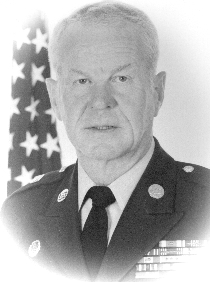 Command Sergeant Major Jack L. Elliott was born 9 February 1931 in Topeka, Kansas. He began his military career on 1 December 1948 when he enlisted in Company B, 174th Military Police Battalion, Kansas Army National Guard. He served as a Military Policeman and Squad Leader prior to being mobilized with the 174th Military Police Battalion for service in Korea.
Command Sergeant Major Jack L. Elliott was born 9 February 1931 in Topeka, Kansas. He began his military career on 1 December 1948 when he enlisted in Company B, 174th Military Police Battalion, Kansas Army National Guard. He served as a Military Policeman and Squad Leader prior to being mobilized with the 174th Military Police Battalion for service in Korea.
CSM Elliott was ordered to active duty on 20 October 1950 as a Corporal with an initial assignment at Fort Sheridan, Illinois. His duties included training other soldiers to become Military Policemen. He was then assigned to the Republic of Korea from July 1951 through June 1952 where he served as a Military Policeman and Military Police Investigator in the 58th Military Police Company. He was released from active duty on 21 June 1952.
He reenlisted in the 174th Military Police Battalion upon release from active duty serving at the rank of Sergeant and later becoming company First Sergeant effective 11 July 1956. With the reorganization of the Kansas Army National Guard in 1959, he was assigned to Headquarters and Headquarters Company, 35th Infantry Division as an Operations Sergeant. He was promoted to Master Sergeant on 19 October 1961.
Effective 1 April 1963 with another reorganization of the Kansas Army National Guard, he was assigned as the First Sergeant for Headquarters and Headquarters Company, 69th Infantry Brigade (Sep). On 13 November 1967 he was assigned as Chief Operations Sergeant and promoted to Sergeant Major on 20 November 1967. He was assigned as the Brigade Sergeant Major on 1 April 1968. CSM Elliott was again ordered to active duty with the mobilized 69th Infantry Brigade on 13 May 1968 as a result of the Pueblo Crisis and conflict in Vietnam. CSM Elliott served as the Brigade Command Sergeant Major at Fort Carson, Colorado from 13 May 1968 through 12 December 1969 when the Brigade was released from active duty.
Upon return to state status, CSM Elliott was again appointed as the 69th Brigade Command Sergeant Major. He served in that position until 1 June 1985 when he was appointed Command Sergeant Major for the Kansas Army National Guard. He retired effective 8 February 1991 with over forty one years of military service. CSM Elliott was awarded the Legion of Merit upon his retirement. CSM Elliott has the distinction of having served as Command Sergenat Major for seven General Officers.
With the support and guidance of MG Phil Finley, the Adjutant General of Kansas, CSM Elliott recruited, trained and established the Governor’s Adjutant General Ceremonial Platoon.
Beginning in 1993, two years following his retirment, CSM Elliott spent continuing time leading the volunteer effort to construct the Kansas National Guard Museum and continued as Museum Curator and President of the Museum Board of Directors to preserve the Kansas National Guard heritage.
His awards and decorations include the Legion of Merit, Meritorious Service Medal W/2 OLC, Army Commendation Medal W/3 OLC, Army Achievement Medal W/OLC, Good Conduct Medal W/Clasps, Army Reserve Components Achievement Medal W/3 OLC, National Defnese Service Medal W/Oak Leaf Cluster, Korean Service Medal W/3 Battle Stars, Armed Forces Reserve Medal W/3 Hour Glass Devices, NCO Professional Development Ribbon W/Numeral 4, Army Service Ribbon, Army Reserve Components Overseas Training Ribbon, United Nations Service Medal, Kansas National Guard Meritorious Service Ribbon, Kansas Emergency Duty Service Ribbon W/Sunflower Device, Kansas National Guurd Service Medal W/2 Sunflower Devices and Republic of Korea Presidential Unit Citation. CSM Elliott was inducted into the Kansas National Guard Hall of Fame on 5 November 1995.
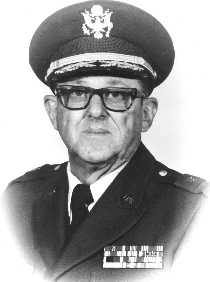 Brigadier General Leo P. Tritsch was born 27 October, 1924, in Colby, Kansas. He began his military career by enlisting in 1943, and serving in the AUS at Camp Plauche, LA, Ft. Leavenworth and the European Theater. Upon separation from active duty in 1945, he was assigned to the US Army Air Corp Enlisted Reserves. In 1947, he enlisted in Headquarters Battery, 154th Field Artillery Battalion shortly after it was reorganized. On 20 May 1949, he received his commission as a second lieutenant in the Kansas Army National Guard, beginning thirty-four years of commissioned service. In all, his career spanned forty years and three months total service, with duty in Europe during World War II, and the Republic of Vietnam in 1968-69.
Brigadier General Leo P. Tritsch was born 27 October, 1924, in Colby, Kansas. He began his military career by enlisting in 1943, and serving in the AUS at Camp Plauche, LA, Ft. Leavenworth and the European Theater. Upon separation from active duty in 1945, he was assigned to the US Army Air Corp Enlisted Reserves. In 1947, he enlisted in Headquarters Battery, 154th Field Artillery Battalion shortly after it was reorganized. On 20 May 1949, he received his commission as a second lieutenant in the Kansas Army National Guard, beginning thirty-four years of commissioned service. In all, his career spanned forty years and three months total service, with duty in Europe during World War II, and the Republic of Vietnam in 1968-69.
Serving as a Field Artillery Officer, General Tritsch completed the Field Artillery Officer Basic, Officer Advanced and Special Weapons Schools. He completed communications training and a field artillery refresher upon mobilization with the 69th Brigade in 1968, and served as an Inspector General with Headquarters, United States Army Vietnam for 7 months. He completed Command and General Staff Officers Course in 1976. Throughout his career in the 154th and 130th Field Artillery, he was noted for his calm, caring leadership and personal commitment to the Guard. In 1971, General Tritsch was assigned to command his home battalion, the 2nd Battalion 130th Field Artillery. He served in several staff positions in the 69th Brigade and State Headquarters, until 1978 when he assumed command of the 130th Field Artillery Group. On 26 June 1979, he was assigned as the Director, State Area Command and appointed as Brigadier General, subsequently becoming the Assistant Adjutant General, Kansas Army National Guard. General Tritsch retired from military service in September 1983.
In his civilian endeavors, General Tritsch embodied the ideals of the citizen soldier. A father of nine, he was an active religious leader and youth volunteer. He initiated a little league baseball program in the community and was an active organizer of youth sports programs. He served on numerous county and community boards over the years and was an active volunteer with the Hiawatha Chamber of Commerce. In 1988 he ran for the office of Mayor and was elected twice. During his tenure, the city lake and park was renovated, emergency dispatch was consolidated county wide, and the 911 emergency systems were initiated throughout the county. The completion of these three contentious and divisive projects are testimony to his leadership abilities. General Tritsch was also an active participant in the National Guard Association of Kansas, serving on many committees, and was an active organizer of the Kansas National Guard Hall of Fame.
Brigadier General Tritsch’s awards and decorations include the Legion of Merit, Bronze Star with oak leaf cluster, Meritorious Service Medal, Army commendation Medal, Army Good Conduct Medal, American Defense Service Medal, American Campaign Medal with three battle stars, European-African Middle East Campaign with battle star, Armed Forces Reserve Achievement medal with hour glass, World War II Victory Medal, Army Occupation Medal, National Defense Service Medal, Vietnam Service Medal, republic of Vietnam Campaign Medal with campaign bar, Armed Forces Reserve Medal with three awards, Army Reserve Component Achievement Medal, Army Service Ribbon, Kansas State Service Medal. Brigadier General Leo P. Tritsch has been a leader in the military, the nation, his community and his family. He was truly a great National guardsman, Kansas and American. General Tritsch exemplified the role of the citizen-soldier. He was inducted into the Kansas National Guard Hall of Fame 5 November, 1994.
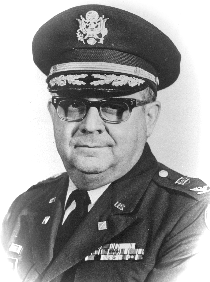 Colonel Clarence E. Laughon was born 18 November 1917. A native of Kansas, he began his military career by enlisting as a Private in the Kansas Army National Guard on 1 August 1939 and was assigned to Headquarters and Headquarters Detachment as a Finance Clerk. On 10 October 1940, he was ordered to active duty with the State Headquarters and assigned as Fiscal Accounting Clerk in the office of the United States Property & Fiscal Office. On 5 September 1943, he was assigned as a Cadreman in the 611th Grave Registration Company, Francis E. Warren Army Base, Cheyenne, Wyoming and in May 1944, was transferred to the Eurpoean Theater of Operations for duty in England, France, Belgium, Holland and Germany. He returned to the United States and was released from active duty 19 October 1945 at Fort Leavenworth, Kansas. After his release from active duty, he was instrumental in the reorganization of and finding a suitable location for the United States Property and Fiscal Office, the Maintenance Shops and warehouse.
Colonel Clarence E. Laughon was born 18 November 1917. A native of Kansas, he began his military career by enlisting as a Private in the Kansas Army National Guard on 1 August 1939 and was assigned to Headquarters and Headquarters Detachment as a Finance Clerk. On 10 October 1940, he was ordered to active duty with the State Headquarters and assigned as Fiscal Accounting Clerk in the office of the United States Property & Fiscal Office. On 5 September 1943, he was assigned as a Cadreman in the 611th Grave Registration Company, Francis E. Warren Army Base, Cheyenne, Wyoming and in May 1944, was transferred to the Eurpoean Theater of Operations for duty in England, France, Belgium, Holland and Germany. He returned to the United States and was released from active duty 19 October 1945 at Fort Leavenworth, Kansas. After his release from active duty, he was instrumental in the reorganization of and finding a suitable location for the United States Property and Fiscal Office, the Maintenance Shops and warehouse.
On 9 September 1947, he received a direct commission to Second Lieutenant, serving as Assistant Finance Officer. Promoted to First Lieutenant on 1 November 1949, he was the Finance Officer and Officer in Charge of the Finance Corps. He was promoted to Lieutenant Colonel 18 November 1962, and assigned as the Budget and Fiscal Office for Headquarters and Headquarters Detachment. LTC Laughon was reassigned as the Comptroller, Finance Corps, 15 December 1967 and promoted to Colonel on 10 February 1970. He became the Assistant Chief of Staff, G-4, Logistics, Headquarters, Kansas Army National Guard on 1 March 1971. COL Laughon had advanced through the ranks from Private to Master Sergeant, then Second Lieutenant to Colonel. He retired from the Guard on 10 February 1977 with over 37 years of service.
Colonel Laughon’s awards and decorations are many. He earned the Meritorious Service Medal, Good Conduct Medal, American Defense Medal, American Campaign, American-African-Middle East Campaign with three battle stars, World War II Victory Medal, Army of Occupation with German Bar, Armed Forces Reserve Medal with two Hour Glass Devices, Army National Guard Achievement Medal, Medal of Liberated France and the National Guard Association of Kansas Distinguished Service Medal.
Other achievements include assisting in the formation of the National Guard Association of Kansas and becoming a Charter Member, providing training for all the Guard Finance Section Personnel in Kansas, and assisted the Michigan National Guard USP&FO in mechanizing their civilian payroll. One of his most signifcant contributions to the Kansas was as an additional duty. Colonel Laughon, as a young officer, maintained the plans, specifications and supporting documents to control state and city funds for the Adjutant General to build 59 armories throughout Kansas in the 1950s and 1960s. He maintained bank accounts, received and disbursed funds for construction and processed final payments. This job was absolutely essential to the growth of the Kansas National Guard.
Colonel Laughon has been a leader and instrumental in the building program that made the Kansas Army National Guard what it is today. He is a great Kansas National Guardsman, Kansan and American. He was inducted into the Kansas National Guard Hall of Fame on 6 November 1994.
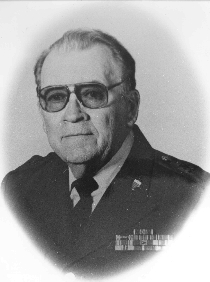 Sergeant Major George J. Perry began his military career in 1943 by enlisting in the U.S. Army. He attended Basic Combat Training at Camp Joseph T. Robinson, Arkansas. He trained as a Medical Technician at Fitzsimmons Army Medical Hospital in Colorado. In late 1943, he was shipped to Camp Ellis, Illinois to await his next duty assignment. His new assignment took him to Kickatan, Virginia to a veterans Hospital to work as an Aidman and eventually working in the mess hall. Next, he was shipped to Newport News, Virginia and assigned to the USS Gideon Wells, a Liberty Ship and sailed to Excabier, Africa, a Submarine Base. Later, he sailed to Oran, Africa. As rumors and tension mounted about the invasioin of Sicily, his ship was completely unloaded and with him aboard, sailed to Hoboken, New Jersey. SGM Perry’s next duty station was back to Kickatan, Virginia where he became Second Cook and promoted to E-4, then promoted to First Cook and E-5. In 1944, he shipped to Camp Patrick Henry, Virginia and promoted to Mess Sergeant where he served until being discharged in 1946 at Fort Leavenworth, Kansas.
Sergeant Major George J. Perry began his military career in 1943 by enlisting in the U.S. Army. He attended Basic Combat Training at Camp Joseph T. Robinson, Arkansas. He trained as a Medical Technician at Fitzsimmons Army Medical Hospital in Colorado. In late 1943, he was shipped to Camp Ellis, Illinois to await his next duty assignment. His new assignment took him to Kickatan, Virginia to a veterans Hospital to work as an Aidman and eventually working in the mess hall. Next, he was shipped to Newport News, Virginia and assigned to the USS Gideon Wells, a Liberty Ship and sailed to Excabier, Africa, a Submarine Base. Later, he sailed to Oran, Africa. As rumors and tension mounted about the invasioin of Sicily, his ship was completely unloaded and with him aboard, sailed to Hoboken, New Jersey. SGM Perry’s next duty station was back to Kickatan, Virginia where he became Second Cook and promoted to E-4, then promoted to First Cook and E-5. In 1944, he shipped to Camp Patrick Henry, Virginia and promoted to Mess Sergeant where he served until being discharged in 1946 at Fort Leavenworth, Kansas.
Upon release from active duty, he was assigned as a Military Policeman in the Army Reserve in Manhattan, Kansas. An Army National Guard Armory was being constructed at St. Marys, Kansas and he was approached about the need for five people to start the unit there. He accepted the challenge and became the First Sergeant of the Headquarters Company, 174th Military Police Battalion. The unit also needed a Mess Sergeant and he was sent to the Advance Camp Mess Sergeant School where he became in instructor. In October 1951, he was mobilized and assigned to Fort Sheridan, Illinois and was selected as the new Sergeant Major. In 1952 the unit was released from active duty and sent home. At home he reverted to the First Sergeant and in 1954 was approached by the Company Commander to be the Administrative Supply and Maintenance Technician. He served in this capacity until his retirement. In 1968, he was mobilized again and served as the Sergeant Major for the Operations Section of the 69th Infantry Brigade at Fort Carson, Colorado during the Pueblo Crisis.
Some of the highlights of his career included maintaining over 100% authorized personnel strength and his units never received an unsatisfactory on his Annual General Inspections or Command Maintenance Management Inspections. SGM Perry was so dedicated to the National Guard that three of his seven children followed in is footsteps, all three now serving in the Kansas Army National Guard full time force.
Service to his community has always been a high priority of Sergeant Major Perry. He served as a Reserve Officer of the St. Marys Police Department for seven years, Fireman on the St Marys Fire Department for 16 years, Quartermaster/Founder of the Veterans of Foreign Wars and has been a very active member of the American Legion. He is also very active in the activities City of St. Marys, Kansas.
Serving for over 40 years in the military, Sergeant Major Perry is the epitome of a leader. He was inducted into the Kansas National Guard Hall of Fame on 7 November 1993.
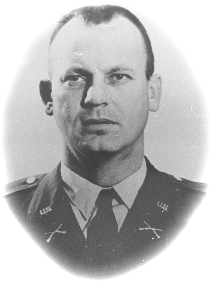 Lieutenant Colonel William J. L. Porter began his military career on 23 July 1949, enlisting in the 140th Infantry Regiment, 35th Infantry Division at Cape Giradeau, Missouri. He was commissioned a Second Lieutenant in 1952 and assigned as Infantry Platoon Leader, Company E, 140th Infantry Regiment. He was promoted to Captain in 1957 and assigned as Company Commander, Administrative Company, 35th Infantry Division and later commanded the Headquarters and Headquarters Company, 69th Infantry Brigade. Promoted to Major in 1964, he was assigned as Assistant S-3 for the 69th Infantry Brigade with the additional duty as Assistant Commandant, Kansas Army National Guard Officer Candidate School. Upon call of the 69th Infantry Brigade to active duty in May 1968, Major Porter became Executive Officer, 2nd Battalion, 137th Infantry, 69th Infantry Brigade and stationed at Fort Carson, Colorado until his assignment to the Republic of South Vietnam in December 1968.
Lieutenant Colonel William J. L. Porter began his military career on 23 July 1949, enlisting in the 140th Infantry Regiment, 35th Infantry Division at Cape Giradeau, Missouri. He was commissioned a Second Lieutenant in 1952 and assigned as Infantry Platoon Leader, Company E, 140th Infantry Regiment. He was promoted to Captain in 1957 and assigned as Company Commander, Administrative Company, 35th Infantry Division and later commanded the Headquarters and Headquarters Company, 69th Infantry Brigade. Promoted to Major in 1964, he was assigned as Assistant S-3 for the 69th Infantry Brigade with the additional duty as Assistant Commandant, Kansas Army National Guard Officer Candidate School. Upon call of the 69th Infantry Brigade to active duty in May 1968, Major Porter became Executive Officer, 2nd Battalion, 137th Infantry, 69th Infantry Brigade and stationed at Fort Carson, Colorado until his assignment to the Republic of South Vietnam in December 1968.
In Vietnam, Major Porter was promoted to Lieutenant Colonel and assigned to the Military Assistance Command with duty as Advisor to the Vietnamese Armed Forces as an Information Officer. He was released from active duty in Vietnam in December 1969 and assigned as Brigade S-3 (Operations) of the 69th Infantry Brigade (Separate). On 1 August 1972, he assumed the duties as Brigade Executive Officer and on 24 December became Battalion Commander, 2nd Battalion, 137th Infantry, 69th Infantry Brigade (Separate). On 9 January 1977, he was reassigned as Civil Affairs Officer, Headquarters 69th Infantry Brigade. LTC Porter retired form the Kansas Army National Guard on 14 June 1977.
In addition to having a distinguished career as a Traditional National Guardsman, Lieutenant Colonel Porter has served his community through his civilian occupation in several states. He began his career as a sports writer in 1956 for the Topeka Capitol-Journal. He was Editor and Publisher of Shawnee, Oklahoma New-Star from 1977 to 1982 and then Editor and Publisher of the Ardmore, Oklahoma Daily Ardmoriete from 1982 to 1986. He became Editor and Publisher of the Topeka Capitol-Journal in 1986.
He received the National Newspaper Association Award for Best Editorial in the Nation in 1986. He received an award for Best Editorial of the Year in Oklahoma Press Association competition. His expertise in the military was recognized when he was chosen to testify before a House Armed Services Subcommittee of the United States House of Representatives, studying Reserve Component field training. His military decorations include the Bronze Star, Army Commendation Medal with Oak Leaf Cluster, Vietnamese Service Medal, Armed Forces Reserve Medal, Army Reserve Components Achievment Medal, National Defense Service medal, Vietnamese Honor Medal, Vietnamese Campaign Medal and the National Guard Service Medal.
Lieutenant Colonel Porter’s faithful service embodies the best of the true “Citizen Soldier”. He was inducted into the Kansas National Guard Hall of Fame on 7 November 1993.
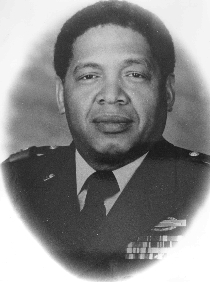 Brigadier General Alonzo D. Dougherty Jr. was born 19 July 1936 in Leavenworth, Kansas. He began his military career by enlisting in 1955 with Company A, 174th Military Police Battalion, in Leavenworth. In 1962 he was selected as the second African American to attend and graduate from the Kansas Officer Candidate School and was commissioned as a Second Lieutenant on 18 June 1962. During the next six years he attended various schools and served as Platoon Leader and Executive Officer of Company A, 2nd Battalion, 137th Infantry. In April 1968, he was called to active duty, became a Company Commander and successfully commanded an Infantry Rifle Company in combat in Vietnam. He also served in the 3rd Battalion, 7th Infantry Birgade as S-3 and S-3 (Air) before returning to Kansas in 1969.
Brigadier General Alonzo D. Dougherty Jr. was born 19 July 1936 in Leavenworth, Kansas. He began his military career by enlisting in 1955 with Company A, 174th Military Police Battalion, in Leavenworth. In 1962 he was selected as the second African American to attend and graduate from the Kansas Officer Candidate School and was commissioned as a Second Lieutenant on 18 June 1962. During the next six years he attended various schools and served as Platoon Leader and Executive Officer of Company A, 2nd Battalion, 137th Infantry. In April 1968, he was called to active duty, became a Company Commander and successfully commanded an Infantry Rifle Company in combat in Vietnam. He also served in the 3rd Battalion, 7th Infantry Birgade as S-3 and S-3 (Air) before returning to Kansas in 1969.
In 1974 Major General Edward Fry, the Adjutant General of Kansas, chose him to develop and implement the Race Relations/Equal Opportunity Program for the Kansas National Guard. He remained in this fulltime position until 1977 before returning to the infantry as a Lieutenant Colonel, becoming the Battalion Commander of the 2nd Battalion, 137th Infantry in Kansas City, Kansas. He then served as Deputy Training Officer, State Area Command in Topeka. In 1981 he was promoted to Colonel and became the G-2 Intelligence Officer, then was assigned as Deputy Brigade Commander, 69th Infantry Brigade from 1983 to 1984. On 19 November, he made history when he became the first African American in the Kansas National Guard to be promoted to Brigadier General of the line and Commander fo the 69th Infantry Brigade. His career culminated as the Assistant Division Commander (Maneuver), Headquarters, 35th Infantry Division (Mechanized), Fort Leavenworth, Kansas. He retired in 1987.
Bridadier General Dougherty’s awards, decorations and accomplishments are many. He graduated in the top five percent of his Command and General Staff College course. He has received the Army Service Ribbon, National Defense Medal, Army Commendation Medal, Armed Forces Reserve Medal, Air Medal (Third Award), Meritorious Service Medal, Vietnam Service Medal, the Combat Infantry Badge and Bronze Star with 2 Oak Leaf Clusters.
Among his other achievements is working three years as Program Analyst in the Force Design Directorate, Combined Arms Combat Development activity, Fort Leavenworth, where he worked for General Colin Powell, designing the current Army Force Structure and Equipment that proved so effective in Operation Desert Storm. He has a “Doctorate of Humane Letters” from Benedictine College, was Past President of the National Guard Association of Kansas, Grand Marshal of the Famed Exoduster’s Parade and a key advisor to the Buffalo Soldier Monument Committee, Fort Leavenworth, Kansas.
Brigadier General Dougherty has been a leader in the military, the nation, his community and his family. He is truly a great Army National Guardsman, Kansan and American. He was inducted into the Kansas National Guard Hall fo Fame on 7 November 1993.
 Major General Jack Strukel Jr. began his military service by enlisting in the U.S. Air Force in 1953. Following release from duty with the Air Force he joined the Kansas Army National Guard in February 1956 and was commissioned a 2nd Lieutenant of Field Artillery in June of 1956 with assignment as a Platoon Leader with Battery A, 195th Field Artillery Battalion, Pittsburg, Kansas. Upon reorganization he was assigned as Platoon Leader and later Commanding Officer of the 132nd Ordnance Company (SD) with promotion to Captain in 1965. He was appointed as Commanding Officer, Company A, 3rd Battalion 137th Infantry in December 1967.
Major General Jack Strukel Jr. began his military service by enlisting in the U.S. Air Force in 1953. Following release from duty with the Air Force he joined the Kansas Army National Guard in February 1956 and was commissioned a 2nd Lieutenant of Field Artillery in June of 1956 with assignment as a Platoon Leader with Battery A, 195th Field Artillery Battalion, Pittsburg, Kansas. Upon reorganization he was assigned as Platoon Leader and later Commanding Officer of the 132nd Ordnance Company (SD) with promotion to Captain in 1965. He was appointed as Commanding Officer, Company A, 3rd Battalion 137th Infantry in December 1967.
Captain Strukel volunteered for active duty during the Vietnam War with the activated 69th Infantry Brigade (Sep) and was initally stationed at Fort Carson, Colorado where he served in several assignments to include Assistant Secretary to the General Staff, 5th Infantry Division and Protocol Officer for the Divison and Fort Carson until his assignment to Vietnam in November 1968. He served as an infantry officer in Vietnam with assignments as Adjutant, 1st Battalion 508th Infantry; Assistant Brigade Plans and Operations Officer with the 3rd Brigade, 82nd Airborne Division; and Executive Officer, 1st Battalion 505th Infantry, being promoted to Major and returning to duty with the 69th Infantry Brigade during December 1969. Assignments with the brigade staff included Intelligence Officer (S-2), Personnel Officer (S-1), and Operations and Training Officer (S-3) prior to assignment in July 1973 as Commanding Officer, 3rd Battalion, 137th Infantry and promotion to Lieutenant Colonel. He was appointed Commanding Officer, 1st Battalion, 635th Armor, in February 1976. Following assignments included Assistant Comptroller, Operations and Training Officer and State Recruiting and Retention Officer with Headquarters, Kansas Army National Guard in Topeka. Upon activation of the Command and Control Headquarters for Kansas Army National Guard in Topeka he was named Commanding Officer and promoted to Colonel. His next assignment was as Commanding General, 69th Infantry Brigade from 1980-1983 with promotion to Brigadier General.
Strukel transferred to the U.S. Army Reserve as Commanding General, 89th Army Reserve Command in 1984 with headquarters in Wichita, Kansas, and units in Kansas, Nebraska, South Dakota and North Dakota. He was promoted to Major General in 1985 with subsequent assignment as Assistant Deputy Chief of Staff for Operations and Plans (IMA), Headquarters, Department of the Army at the Pentagon. In 1989, he was named Commanding General of the 122nd Army Reserve Command with headquarters in North Little Rock, Arkansas and units in Arkansas, Louisiana and Oklahoma. He retired from the military in June of 1991 after 37 years of service.
While in the rank of Lieutenant Colonel, he served as president of the National Guard Association of Kansas during the years 1973-74. As Chairman of a three-man committee, he was the primary driving force and writer of the constituion and bylaws for the Kansas National Guard Hall of Fame. He served as the first chairman of the Hall of Fame Board of Directors. The Kansas National Guard Hall of Fame, as it currently exists, is a product of his vision and determined labors. Following his retirment, he was inducted into the Kansas National Guard Hall of Fame in 1992.
General Strukel, during a distinguished military career, was known as a “tough, but fair leader.” His units were consistently recognized as being among the most mission ready in the reserve components of the United States Army. He served on the Army Reserve Forces Policy Board followed by appointment to the Department of Defense Reserve Forces Policy Board.
Among his awards and decorations are the Combat Infantry Badge, Department of Defense Staff Identification Badge, Distinguished Service Medal with Oak Leaf Cluster, Bronze Star Medal with two Oak Leaf Clusters, Meritorious Service Medal with Oak Leaf Cluster, Air Medal with Numeral Two, Army Commendation Medal with three Oak Leaf Clusters, Good Conduct Medal, Army Reserve Component Achievement Medal with three Oak Leaf Clusters, National Defense Service Medal with Oak Leaf CLuster, Republic of Vietnam Service Medal with four Campaign Stars, Armed Forces Reserve Medal, Army Service Ribbon, Army Reserve Overseas Ribbon, Valorous Unit Award, Vietnam Cross of Gallantry with Palm (Unit Citation), Vietnam Cross of Gallantry with Silver Star (Two Awards), Vietnam Campaign Medal with Device (1960), Kansas National Guard Meritorious Service Ribbon, Kansas National Guard Service Ribbon, Kansas National Guard Emergency Duty Ribbon, Oklahoma National Guard Medal, National Guard Association of Kansas Distinguished Service Medal, Armor Association “Order of St. George” Bronze and Silver Medals.
His military education includes Artillery Officer Basic, Ordnance Officer Basic and Advance Courses, Infantry Officer Basic and Advance Courses, Armor Officer Associate Course, Command and General Staff College and the Army War College. Civilian higher education includes three degrees from Pittsburg State University (Kansas) – BS in Education, MS in Education and Educational Specialist Degree.
He has been a teacher, coach, building principal and central office administrator. He was elected Mayor of Girard, Kansas in 1965 and 1968. He is a member of many military organizations to include: 82nd Airborne Division Association, 35th Infantry Division Association, the Association of the United States Army, The Reserve Officers Association, the Military Officers Association of America, the Military Order of World Wars, the National Guard Association of Kansas and the USA, the Senior Army Reserve Commanders Association, American Legion, Veterans of Foreign Wars and Vietnam Veterans of America.
He served for eight years as a member with five of those years as chairman of the Kansas Commission on Veterans Affairs, plus membership on numerous other boards, councils and commissions. He serves as the “Honorary Regimental Colonel” for the 635th Armor Regiment as outlined by Army Regulation. He also enjoys special ceremonial titles bestowed by governors to include: “Honorary Kentucky Colonel”, “Honorary Admiral of the Nebraska Navy”, and “Honorary Arkansas Traveler.”
He was born at Arma, Kansas on 20 September 1931. General Strukel married the former Janet Gayle Holmes of Pittsburg, Kansas on 2 September 1956 and they have three grown children and eight grandchildren. His home is at 5125 SE 10th Street, Tecumseh, Kansas 66542.
 CMSgt Melvin D. Simpson, Overbrook, began his military career in 1952 when he enlisted in the U.S. Air Force and went through basic training at Sheppard Air Force Base in Texas. He became a personnel specialist and then first sergeant servingin Tennessee and Oklahoma. He joined the Kansas Air National Guard as the first sergeant with the 117th Fighter Intercepter Squadron in March 1957 at the Hutchinson Naval Air Station, later becoming the first sergeant, personnel superintendent, and chief of personnel for the 190th Tactical Reconnaissance Group and the 190th Bombardment Tactical Group (forerunners of the 190th Air Refueling Group). On May, 1974, he became the personnnel superintendent of Headquarters, Kansas Air National Guard, until his retirement in May 1988 as a full-time employee and a Guardsman. During his tenure, the 190th moved from Hutchinson to Topeka in 1967 and through his efforts most of the unit was retained.
CMSgt Melvin D. Simpson, Overbrook, began his military career in 1952 when he enlisted in the U.S. Air Force and went through basic training at Sheppard Air Force Base in Texas. He became a personnel specialist and then first sergeant servingin Tennessee and Oklahoma. He joined the Kansas Air National Guard as the first sergeant with the 117th Fighter Intercepter Squadron in March 1957 at the Hutchinson Naval Air Station, later becoming the first sergeant, personnel superintendent, and chief of personnel for the 190th Tactical Reconnaissance Group and the 190th Bombardment Tactical Group (forerunners of the 190th Air Refueling Group). On May, 1974, he became the personnnel superintendent of Headquarters, Kansas Air National Guard, until his retirement in May 1988 as a full-time employee and a Guardsman. During his tenure, the 190th moved from Hutchinson to Topeka in 1967 and through his efforts most of the unit was retained.
In 1966, Simpson performed Guard disaster duty following the Topeka tornado of June 1966. He received the Governor’s Commendation for Exceptionally Meritorious Service for his efforts.
Simpson was always recruiting airmen for the Guard. His biggest recruiting achievement was getting Col Joe Engle, the former astronaut, into the Kansas Air National Guard.
He has been involved in many community activities to include being chairman of the Combined Federal Campaign for the Adjutant General’s Department to raise money for the United Way. After three years of work for the United Way, he received the United Way Volunteer Award for Outstanding Service to the people of Topeka.
He also He also was involved with the Overbrook Rotary Club since 1972, being elected president twice, Rotarian of the Year 1976-77, hosted seven foreign students in his home and in 1988 was named the “Paul Harris Fellow” for substantial charitable service to Rotary International.
Simpson is a life member of the Enlisted Association of the National Guard of Kansas serving as vice president (Air), chairman of the resolutions committee, 1983-89.
Among his many awards and decorations are the Meritorious Service Medal; Air Force Commendation Medal; Good Conduct Medal; National Defense Service Medal; Air Force Longevity Service Ribbon; Air Reserve Forces Meritorious Service Ribbon; Kansas National Guard Meritorious Service Ribbon, and the Kansas National Guard Longevity Service Ribbon.
In addition to organizations mentioned, he also has served with the National Guard Association of Kansas receiving the National Guard Association of Kansas Distinguished Service Award in 1980; National Guard Association of the U.S.; Enlisted Association of the Nation Guard of the U.S.; Air Force Association; Air Force Sergeants Association; American Legion; and Masonic Lodge.
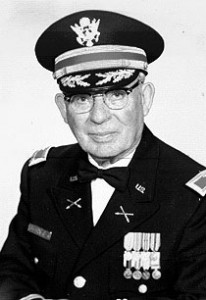 Col. Elmer L. Lentz, Hutchinson, enlisted in Battery A, 1st Kansas Artillery of the Kansas Army National Guard on July 28, 1920 in Hutchinson, where he served in the communications section. He became a second lieutenant in 1922 with Battery A, 130th Field Artillery Battalion and served as the communications officer, executive officer, and commander. In 1935 he became the Battalion Executive Officer for the 130th Field Artillery Battalion. He was activitated for World War II in December of 1940 and went to Camp Robinson, Arkansas.
Col. Elmer L. Lentz, Hutchinson, enlisted in Battery A, 1st Kansas Artillery of the Kansas Army National Guard on July 28, 1920 in Hutchinson, where he served in the communications section. He became a second lieutenant in 1922 with Battery A, 130th Field Artillery Battalion and served as the communications officer, executive officer, and commander. In 1935 he became the Battalion Executive Officer for the 130th Field Artillery Battalion. He was activitated for World War II in December of 1940 and went to Camp Robinson, Arkansas.
By November of 1941, he had been appointed the commander of the 127th Field Artillery Battalion and participated in the Louisiana maneuvers during the summer months. Later, he went with the unit to Fort Ord, California.
In early 1942, Lentz was sent to Fort Mason, California to activitate the 736th Military Police Battalion for port security at the Port of Embarkation in San Francisco. He went to the Military Police Officers Advanced Course and returned to command the 736th. The next year, Lentz was sent to Fort Sam Houston, Texas to activitateand command the 508th Military Police Battalion and deployed with them to England in December of 1943. His unit supported the First U.S. Army throughout Europe during the war with emphasis on prisoner of war operations.
The 508th had occupation duty in Munich, Germany in support of the Third U.S. Army until 1946.
Upon his return to the states, he was assigned to the United States Army Reserve. Then in September 1946, he joined the Kansas Army National Guard as executive officer of the 130th Artillery Group, Hitchinson, becoming commander in May with promotion to colonel in 1947.
Lentz was activitated for federal duty for the second time in september of 1950. For a year and a half he was assigned to Headquarters, Fifth U.S. Army as the education officer. Lentz spent a year as the staff personnel officer with Headquarters, Eighth U.S. Army in Seoul, Korea.
In 1954, a heart attack sent him to General Hospital in Osaka, Japan. From February to May of 1955, he was the training officer with the First U.S. Army. He retired on May 31, 1955 from the Kansas Army National Guard upon separation from active duty.
As a Guardsman, he participated in several state activations to support flood relief operations and for tornado cleanup operations in May of 1926 in the Hutchinson area.
When not involved in the military, Lentz was active in events in his hometown. He was a lifelong member of the Masonic Lodge, advancing to a 32-degree Mason in the Wichita Consistory. He also became a Noble in the Midian Shrine. He was also active in his church.
Among his awards and decorations are the American Defense World War II Medal, American Campaign World War II Medal, European, African, Middle East World War II Medal with Central Europe and the Rhineland Campaign Stars, World War II Service Medal, Army of Occupation World War II Medal, National Defense (Korea), United Nations Service (Korea), Armed Forces Reserve Medal with 2 Oak Leaf Clusters, the Kansas Army National Guard Service Ribbon with 30 year device, and the Honorable Order of St. Barbara, and the Ancient Order of St. Barbara.
In 1948, he received direct commission to second lieutent and reported for flight training, graduating from the Fort Sill, Okla., Air Training Department as a liaison pilot. He has had three careers also ranging from serving in the military, then as a pilot and security aid to Governor John Carlin, and then working with computerizing genealogy records and computer consulting.
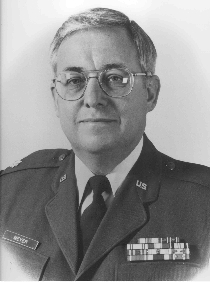 Maj Meyer was activated and served at Kunsan Air Base in South Korea in 1968 with the 354th Combat Support Group.
Maj Meyer was activated and served at Kunsan Air Base in South Korea in 1968 with the 354th Combat Support Group.
In 1973, he became the outstanding airman for the state of Kansas for his enlisted service. By 1975, Meyer received a direct commission to captain and has since served as chief administrator, base services officer, executive staff officer and management and procedures officer with the 184th Tactical Fighter Group.
He is presently the representative for Kansas retirees for the National Guard Association of the United States and in 1990, Meyer became president of the Kansas National Guard Museum Board and has actively worked toward the establishment of the museum. In addition, Meyer was involved with numerous community projects including the loaned executive program of the United Way, the Lion’s Club with special projects such as Leader Dog and as advisor to a Derby High School LEO Club.
Col Richard E. Eckert was in the 11th Airborne in the Philippines, Okinawa and Japan during World War II. He was activated with Company E, 137th Infantry Regiment of the Kansas Guard on December 23, 1940, and participated in the Louisiana Maneuvers.
He began as the Senior TAC Officer in 1956 at the Kansas Military Academy, on a part-time basis. From 1965 to 1972, he was Commandant at the Academy where he believes he made a lasting effect on the Kansas Army National Guard. When the 69th Brigade was mobilized for Vietnam, there was a chance to accelerate the academy and graduate people in Class 22.
In 1963 Eckert began working full time for the Kansas Army National Guard serving as Operations and Training Officer, Executive Officer and Chief of Staff.
 Major General Ralph T. Tice began his military career on May 1943 when he enlisted in the U.S. Army. He served overseas in the Pacific Theater with the 78th Engineer Combat Battalion 1944-1945. Following the termination of hostilities, he was assigned to the 8th Engineer Combat Squadron in Tokyo, Japan. He returned to the United States in July 1946, was released from active duty in October, and assigned to the Officer Reserve Corps, 835th Aviation Engineer Battalion.
Major General Ralph T. Tice began his military career on May 1943 when he enlisted in the U.S. Army. He served overseas in the Pacific Theater with the 78th Engineer Combat Battalion 1944-1945. Following the termination of hostilities, he was assigned to the 8th Engineer Combat Squadron in Tokyo, Japan. He returned to the United States in July 1946, was released from active duty in October, and assigned to the Officer Reserve Corps, 835th Aviation Engineer Battalion.
General Tice joined the Kansas Army National Guard in March 1950 as a First Lieutenant with the 35th Division Artillery. He later served with the 127th Artillery Group and Headquarters, Kansas Army National Guard. He was appointed Commanding General, 69th Infantry Brigade, and promoted to Brigadier General in July 1977. He served in this capacity until being appointed as The Adjutant General of Kansas in October 1980. He was promoted to Major General in March 1981.
As a civilian, General Tice first began working for the National Weather Service in Topeka, in 1941 and then returned to the Weather Service after his military active duty in 1947. He retired from the National Weather Service in Kansas City, Missouri, as Chief of the Observations Branch, Central Region Headquarters, in March 1979.
His military awards and decorations included the Distinguished Service Medal, Legion of Merit, Meritorious Service Medal, Army Commendation Medal, Good Conduct Medal, American Campaign Medal, Asiatic Pacific Campaign Medal, World War II Victory Medal, American Occupation Medal, Philippine Liberation Medal, Armed Forces Reserve Medal, Army Reserve Components Achievement Medal, Kansas State Service Medal and the Distinguished Service Medal of the National Guard Association of the United States.
General Tice was a member of the Veterans of Foreign Wars; American Legion; Topeka Optimist Club; American Meteorological Society; National Association of Federal Retirees; and Masonic Lodge and Shrine. He was Chairman of the Committee on Logistics and Facilities, and a Committee Member on the Personnel and Manpower Committee, Adjutants General Association of the United States. In addition, he was also a member and past president of the National Guard Association of Kansas and served on the Executive Council at the National level and a member and past president of the Topeka Chapter of the Association of the U. S. Army. General Tice was the President of Topeka Chapter 086, Military Order of World Wars; and a former member (at the National level) of the Army Reserve Forces Policy Committee; and of the Military Affairs Committee, and the Topeka Chamber of Commerce.
Major General Ralph T. Tice was born on February 23, 1924 in Topeka. He graduated from Seaman High School and attended Washburn University, the University of Florida, Pennsylvania State University, and received a BA from Columbia College. He died October 5, 1994 and is buried at Memorial Park Cemetery in Topeka, Kansas.
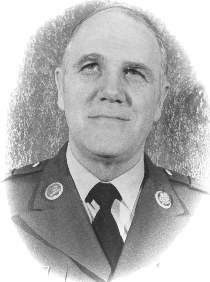 A native Kansan, Command Sergeant Major Robert N. Shaumeyer was born 18 June 1923 at Kansas City, Kansas and began his military career on 8 February 1943 by enlisting in the U.S. Army at Fort Leavenworth, Kansas. He served overseas in campaings at Normandy, Northern France, Rhineland and Germany in Central Europe, receiving the World War II Victory Medal, European-African-Middle Eastern Campaign Medal with four Bronze Stars, the Good Conduct Medal and American Campaign Medal.
A native Kansan, Command Sergeant Major Robert N. Shaumeyer was born 18 June 1923 at Kansas City, Kansas and began his military career on 8 February 1943 by enlisting in the U.S. Army at Fort Leavenworth, Kansas. He served overseas in campaings at Normandy, Northern France, Rhineland and Germany in Central Europe, receiving the World War II Victory Medal, European-African-Middle Eastern Campaign Medal with four Bronze Stars, the Good Conduct Medal and American Campaign Medal.
CSM Shaumeyer enlisted in the Kansas Army National Gaurd on 10 October 1952 with Company G and served in the 137th Infantry Regiment until his retirement on 18 June 1983. He spent the last 14 years of his military service as a Sergeant Major, seven years as Battalion Sergeant Major and seven years as the Command Sergeant Major for the 2nd Battalion, 137th Infantry.
As Command Sergeant Major, he was responsible for directing the Kansas Army National Guard Satellite Noncommissioned Officer Academy in Lawrence. He organized the school, selected the Tactical NCOs, instructors and clerical personnel, made arrangments for the subsistance for students, contributed to the development of the cirriculum and served as instructor on occasion. He also served as Director of the school through March 1981 and later Advisor to a similar school which became operational at the Topeka armory in November 1981.
Command Sergeant Major Shaumeyer campaigned on behalf of a Kansas City, Kansas bond election in the early 1950s which included provisions for the Kansas City, Kansas Armory. He canvassed door-to-door before the election and was a definate part of the success of the election. An armory was built and occupied by the National Guard in January 1956.
During the Vietnam mobilization in April 1968, Shaumeyer organized and led a wives and families club of the famliies of the activated National Guardsman so they would be informed of their rights and privileges and how to handle problems during the mobilization period.
For his years of dedicated service to his community, the Henry Leavenworth Chapter of the Association of the United States Army named CSM Shaumeyer “National Guardsman fo the Year” in 1966 and again in 1973. The Kansas Army National Guard also awarded CSM Shaumeyer the Army Commendation Medal with Oak Leaf Cluster, Army Achievement Medal with Oak Leaf Cluster, Armed Forces Reserve Medal with Ten Year Device and the Army Reserve Components Achievement Medal with two Oak Leaf Clusters. He was inducted into the Kansas National Guard Hall of Fame on 4 November 1990.
 Colonel Michael P. Sarras was born on 7 September 1922 in Kansas City, Kansas and began his military career by enlisting in the Machine Gun Troop, 114th Cavalry Regiment, 24th Cavalry Division in Kansas City, Kansas. He was ordered to active duty with the 127th Field Artillery on 23 September 1940. He was promoted to First Sergeant with the 635th Tank Destroyer Battalion and served in that unit both in the States and Europe. He participated in D-Day landings in France. He was released from active duty on 21 October 1945.
Colonel Michael P. Sarras was born on 7 September 1922 in Kansas City, Kansas and began his military career by enlisting in the Machine Gun Troop, 114th Cavalry Regiment, 24th Cavalry Division in Kansas City, Kansas. He was ordered to active duty with the 127th Field Artillery on 23 September 1940. He was promoted to First Sergeant with the 635th Tank Destroyer Battalion and served in that unit both in the States and Europe. He participated in D-Day landings in France. He was released from active duty on 21 October 1945.
Colonel Sarras received a direct commission on 29 June 1951 and served as Platoon Leader in Company F, 2nd Battalion, 137th Infantry Regiment. He was promoted to Captain and served as Company Commander, Headqauarters Company, 2nd Battalion, 137th Infantry Regiment from 18 July 1955 to 30 April 1959, then was promoted to Major and served in various staff assignments in the 135th Transportation Battalion and 169th Support Battalion.
Colonel Sarras was ordered to active duty on 1 May 1968 as Battalion Commander, 169th Support Battalion. During this tour, he served in Vietnam with Headquarters, MACV Military Assistance Command and MACV Defense Force Battalion. After his release from active duty on 13 December 1969, he served as Battalion Commander, 169th Support Battalion, Deputy Brigade Commander, 69th Infantry Brigade and Recruiting and Retention Officer, Hedquarters, State Area Command.
Colonel Sarras graduated form Columbia College, Columbia, Missouri in 1975 with a Bachelor of Arts Degree and the University of Kansas Graduate School with a Masters Degree in Public Administration in 1978. He is a member of numerous civic and community organizations. He was instrumental in organizing the Columbia College Outreach Program. He was President of the Citizens Military Committee which was responsible for the bond issue to build the Kansas City, Kansas Armory and many other improvements at no cost to the State or Federal Government.
Colonel Sarras’ decorations include the Legion of Merit with Second Award, Purple Heart, Bronze Star Medal, Joint Service Commendaiton Medal, Army Commendation Medal with Second Award, Bronze Service Arrowhead, French Croix De Guerre with Bronze Star, French Croix De Guerre with Palm and eleven Service Ribbons. Colonel Sarras’ long and faithful service embodies the best of the true “Citizen Soldier”. He was inducted into the Kansas National Guard Hall of Fame on 5 November 1989.
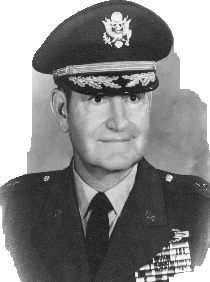 Brigadier General William J. Mullins, Jr. began his military career by enlisting in the United States Army on 27 June 1942 and was commissioned a Second Lieutenant, Infantry on 9 March 1943. He served in the European Theater of Operations during World War II as a Platoon Leader and later Company Commander of Company K, 318th Infantry, 80th Infantry Division, one of General George S. Patton’s “Iron Divisions.” During World War II, he was awarded the Silver Star, the Bronze Star with “V” Device for Valor and the Combat Infantry Badge.
Brigadier General William J. Mullins, Jr. began his military career by enlisting in the United States Army on 27 June 1942 and was commissioned a Second Lieutenant, Infantry on 9 March 1943. He served in the European Theater of Operations during World War II as a Platoon Leader and later Company Commander of Company K, 318th Infantry, 80th Infantry Division, one of General George S. Patton’s “Iron Divisions.” During World War II, he was awarded the Silver Star, the Bronze Star with “V” Device for Valor and the Combat Infantry Badge.
After release from active duty, he was commissioned a Captain in the Kansas Army National Guard and assigned on 1 March 1949 as S4, 3rd Battalion, 137th Infantry, 35th Infantry Division. He was promoted to Major on 4 March 1952, serving as S2 of the 137th Infantry Regiment. He was promoted to Lieutenant Colonel in 1962 and assigned as Executive Officer, Brigade Section, Headquarters, 35th Infantry Division. Upon reorganization of the Kansas Army National Guard in 1963, he was assigned as Civil Affairs Officer and later as S3, 69th Infantry Brigade (Sep).
Mullins assumed command of the 2nd Battalion, 137th Infantry on 6 October 1967 and served in that capacity until ordered to active duty in April 1968 as a result of the Pueblo Crisis. He continued to serve in that position at Fort Carson, Colorado until ordered to service in the Republic of Vietnam in 1969. From May 1969 until November 1969, he served as Deputy Chief, Revolutionary Development Cadre Division, Military Assistance Command, Vietnam. This assignment took him into all four Corps Tactical Zones of that country. As a result of his exemplary performance in the Republic of Vietnam, General Mullins was awarded the Legion of Merit.
General Mullins was released from active duty, 12 December 1969 and returned to state status. He was appointed on 10 February 1971 as Deputy Brigade Commander, 69th Infantry Brigade (Sep). He was subsequently assigned as Assistant Chief of Staff, State Headquarters, Kansas Army National Guard, effective 1 August 1973 and promoted to Brigadier General on 27 June 1974. He was assigned as Deputy Comnander (Army) upon reorganization of State Headquarters, Kansas Army National Guard, effective 1 December 1976 and served in that capacity until his retirement on 27 June 1979.
In recognition of his accomplishments, General Mullins received his second Legion of Merit for meritorious service between the period of 1970 and his retirement in 1979. After retirement, his name was placed on the Honor Roll of the Infantry Officer Candidate Hall of Fame at Fort Benning, Georgia on 7 December 1979.
In addition to his outstanding military career, Brigadier General Mullins was a dedicated public servant, educator, attorney and community leader. He holds a Bachelors Degree from the Southwest Missouri State University in Springfield, a Masters Degree from the University of Missouri at Columbia and a Juris Doctorate from the University of Missouri at Kansas City. He is also a graduate of the Command and General Staff College at Fort Leavenworth, Kansas. Brigadier General Mullins’ long and dedicated service as soldier and public servant truly embodies the meaning of Citizen Soldier. He was inducted into the Kansas National Guard Hall of Fame on 5 November 1989.
 Col. Albert S. Bigelow was born in Cloud County, Kansas, January 23, 1888. He was raised in Minnesota where he completed his preparatory education in 1909. He graduated from the University of Chicago with an A.B. degree in 1915, completing his senior year by attendance at three successive summer quarters. He was an instructor in academic subjects and Commandant of Cadets at Pillsbury Academy in Minnesota during the years 1912 – 1914. He served in the Second Minnesota Infantry from 1907 to 1914 as private, corporal, sergeant, and battalion sergeant-major. In 1914 he return to Kansas as high school principal at Hiawatha. He was appointed second lieutenant in the First Kansas Infantry in 1916 and served in that capacity on the Mexican border in that year. On August 5, 1917, he entered federal service again with the 137th Infantry of the 35th Division in the A.E.F. He participated in the Vosges Defensive and St. Mihiel and Meuse-Argonne Offensives. Twice wounded in action, he received the Purple Heart Medal with Oak Leaf Cluster. In 1922, he was appointed captain of the 130th Field Artillery Regiment and entered active duty as a lieutenant colonel, with that organization on December 23, 1940. Becoming over-age-in-grade for combat branches in 1941, he was detailed as Base Quartermaster, Merced (California) Army Air Base. Separated for physical disability in 1944, he returned to duty as Special Assistant Adjutant General, a position he had held until 1934. Appointed Assistant Adjutant General in 1947, with State rank of colonel, AGC. At his request, he reverted to Special Assistant in 1952. His additional civilian positions held included Superintendent of the Kansas State Industrial Reformatory, and Deputy Collector of Internal Revenue.
Col. Albert S. Bigelow was born in Cloud County, Kansas, January 23, 1888. He was raised in Minnesota where he completed his preparatory education in 1909. He graduated from the University of Chicago with an A.B. degree in 1915, completing his senior year by attendance at three successive summer quarters. He was an instructor in academic subjects and Commandant of Cadets at Pillsbury Academy in Minnesota during the years 1912 – 1914. He served in the Second Minnesota Infantry from 1907 to 1914 as private, corporal, sergeant, and battalion sergeant-major. In 1914 he return to Kansas as high school principal at Hiawatha. He was appointed second lieutenant in the First Kansas Infantry in 1916 and served in that capacity on the Mexican border in that year. On August 5, 1917, he entered federal service again with the 137th Infantry of the 35th Division in the A.E.F. He participated in the Vosges Defensive and St. Mihiel and Meuse-Argonne Offensives. Twice wounded in action, he received the Purple Heart Medal with Oak Leaf Cluster. In 1922, he was appointed captain of the 130th Field Artillery Regiment and entered active duty as a lieutenant colonel, with that organization on December 23, 1940. Becoming over-age-in-grade for combat branches in 1941, he was detailed as Base Quartermaster, Merced (California) Army Air Base. Separated for physical disability in 1944, he returned to duty as Special Assistant Adjutant General, a position he had held until 1934. Appointed Assistant Adjutant General in 1947, with State rank of colonel, AGC. At his request, he reverted to Special Assistant in 1952. His additional civilian positions held included Superintendent of the Kansas State Industrial Reformatory, and Deputy Collector of Internal Revenue.
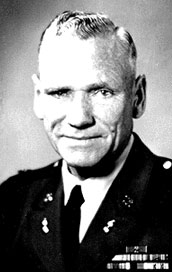 COL Weller was born July 21, 1909 in Hardtner, Kansas. He began his military career on April 11, 1927 by enlisting as a private in Troop E, 114th Cavalry, 35th Division, Kansas Army National Guard.
COL Weller was born July 21, 1909 in Hardtner, Kansas. He began his military career on April 11, 1927 by enlisting as a private in Troop E, 114th Cavalry, 35th Division, Kansas Army National Guard.
On August 9, 1930, he was promoted to First Sergeant in Troop E, 114th Cavalry. He served in this position until November 10, 1939, when he transferred to the 110th Ordnance Company.
On December 23, 1940, he was inducted into federal service as a 2nd Lieutenant with the 35th Division when it was mobilized for World War II. Weller moved rapidly through the ranks gaining greater responsibility along the way. He was promoted to Lieutenant Colonel on Octeber 20, 1943 and serving as the 35th Division Ordanance Officer when the division was sent to Europe in June of 1944.
The 35th Division landed on Omaha Beach, Normandy in July 1944 and fought tirelessly in numerous campaigns. Among their many battles was the rescue of “The Lost Battalion” of the 30th Division.
Lt. Col. Weller returned to the states and was seperated from active service on January 31, 1946. When the Kansas National Guard was reorganized after the war, they called upon Capt. Weller to head the 110th Ordnance Company. He again excelled in his duties and progressed rapidly, being promoted to Colonel in September of 1954, as Commander of the 496th Ordnance Group.
Weller’s contributions to the citizens of Kansas included exceptional emergency service during the 1951 Flood and once again during the devastating Topeka tornado of 1966. Weller was Topeka Station Commander when the tornado struct and immediately established emergency operations, immeasurably aiding civil authorities during this tragic ordeal.
Weller was an outstanding athlete who possessed great equestrian and boxing skills (he was the 35th Division boxing champion in the light weight class).
Among his other accomplishments as a guardsman, he was a charter member of the National Guard Association of Kansas and twice served as its president.
Weller’s decorations include the Bronze Star Medal with Oak Leaf Cluster, the American Campaign Medal, the European-African Middle-Eastern Campaign Medal with five Battle Stars, the World War II Victory Medal, the Army of Occupation Medal with Germany Device, and the Army Commendation Medal.
 First Sergeant Leonard J. Miller was born 12 September 1930 in Wilson, Kansas. His military service began with his joining Battery C, 130Th Field Artillery, Kansas Army National Guard on 2 February 1949. In keeping with the traditions of National Guard Service as our Founding Fathers had planned, First Sergeant Miller would retire form this same unit some 35 years later on 6 August 1984. Shortly after his enlistment and assignment as Assistant Gunner on a Howitzer Section, his leadership skills and ability to motivate soldiers was recognized and he was promoted ahead of his peers to Gunner then Chief of the Howitzer Section. First Sergeant Miller proved to be an outstanding military instructor and had the ability to impart the intricacies of Field Artillery Gunnery to younger soldiers. His keen sense of duty and clear understanding of the mission made him an invaluable trainer. He also demonstrated the ability to motivate young people to join the National Guard and exercise their patriotic duty. Once in the National Guard unit, he had a personal agenda to assure each one was fully trained and dedicated to reach their maximum potential. He was responsible for scores of enlistments in the battery, which was split between Great Bend and Ellsworth, Kansas. His penchant for training and energizing the soldiers is legendary in his unit.
First Sergeant Leonard J. Miller was born 12 September 1930 in Wilson, Kansas. His military service began with his joining Battery C, 130Th Field Artillery, Kansas Army National Guard on 2 February 1949. In keeping with the traditions of National Guard Service as our Founding Fathers had planned, First Sergeant Miller would retire form this same unit some 35 years later on 6 August 1984. Shortly after his enlistment and assignment as Assistant Gunner on a Howitzer Section, his leadership skills and ability to motivate soldiers was recognized and he was promoted ahead of his peers to Gunner then Chief of the Howitzer Section. First Sergeant Miller proved to be an outstanding military instructor and had the ability to impart the intricacies of Field Artillery Gunnery to younger soldiers. His keen sense of duty and clear understanding of the mission made him an invaluable trainer. He also demonstrated the ability to motivate young people to join the National Guard and exercise their patriotic duty. Once in the National Guard unit, he had a personal agenda to assure each one was fully trained and dedicated to reach their maximum potential. He was responsible for scores of enlistments in the battery, which was split between Great Bend and Ellsworth, Kansas. His penchant for training and energizing the soldiers is legendary in his unit.
First Sergeant Miller continued his career within the battery. Through several reorganizations over the years, he remained in the same unit although it was to become an element of three different battalions. Upon enlistment, the 130th Field Artillery, then later the 1st Battalion, 130th Field Artillery and then the 1st Battalion, 161st Field Artillery. Finally, in 1983, the unit again came under the flag of the 130th Field Artillery as a unit of the 2nd Battalion, 130th Field Artillery. During these years of transition, on man provided the steadfast continuity required assuring that the unit remained a viable national defense asset at the highest possible state of readiness. It was this battery that won the gunnery competition at Fort Riley, Kansas against active component counterparts. First Sergeant Miller was a core reason for these accomplishments.
During his long and credible career as a Traditional Guardsman, First sergeant Miller was also employed in the private sector at the Journeyman level. He and his wife Betty raised eight children and five stepchildren, which well credits him as a family man. He also found time to be active in the community. He is a Deacon and Trustee for his church in Great Bend, Kansas. He serves as an Executive Council Member with the American Legion of Great Bend and participates in the senior Citizen Food Distribution Program and Meals on Wheels.
First Sergeant Miller is also a Charter Life Member of the Enlisted Association of the National Guard of Kansas. He attended every State Conference since the association began in 1970. He remains active in the association and has served on numerous committees through the years. His dedication to the enlisted soldiers is clearly demonstrated through his extra service to this association.
His decorations include the Army Commendation Medal, Army Achievement Medal, Armed Forces Reserve Medal with two Hourglass Devices, the Army Reserve Components Achievement Medal with Oak Leaf Cluster, NCO professional Development Ribbon, Armed Services Ribbon, the Kansas National guard Service Medal with three Sunflower Devices, the Kansas Emergency service Ribbon and the Expert Rifle Marksman Badge. He was inducted into the Kansas National Guard Hall of Fame, 1 November 1998.
 Thomas J. Anderson
Thomas J. Anderson
Kansas’ 6th Adjutant General
April 01, 1865 – August 18, 1867
Mayor of Topeka
Kansas State Representative
Kansas State Senator
Civil War Campaign MedalBorn in Ohio, Col. Thomas J. Anderson came to Valley Falls with his parents in the spring of 1857. The following year, when he was 19 years old, he was elected surveyor of Jackson County of a Free-State ticket.
When the Civil War broke out, Anderson enlisted as a private in Co. A, Fifth Kansas Cavalry and served throughout the war. When he resigned in the spring of 1865 to accept the appointment as Kansas Adjutant General, he had attained the rank of colonel. He was 26 years old.
Employment with Kansas expanding railroad system beckoned Anderson and within a year he resigned as Adjutant General to become agent of the Kansas Pacific at Topeka. The railroad was then building toward Colorado in western Kansas.
On March 1, 1873, Anderson became general freight and passanger agent of the Kansas Midland railroad and when that line was absorbed into the Santa Fe, in 1875, he was made general passanger agent. When the Santa Fe became involved in a controversy with the Denver and Rio Grande Western railroad over right-of-way through the Grand Canyon of the Colorado, Anderson was placed in charge of the Santa Fe forces. Several times it appeared as if the opposing forces of the two roads would actually engage in battle, so intense was the situation. Gun fighters from Dodge City, under command of Sheriff Bat Masterson, were hired and hurriedly shipped to the line of contest. Fortunately, the controversy was ultimately settled amicably though some blood was shed.
In May of 1881, Anderson resigned from the staff of the Santa Fe and was appointed Topeka Postmaster. He had served as Mayor for two years in 1875 and 1876, and was responsible for much of the success of the capital city’s United States centennial celebration.
Anderson was Postmaster for four years and when that job was relinquished, he accepted employment with the Rock Island at Topeka as general agent and as assistant general passanger agent for the lines west of the Missouri River. He terminated his railroad service in December of 1897, to become secretary of the Commercial Club of Topeka. He finally retired in 1908.
Anderson, besides serving as Jackson County surveyor and Topeka Mayor, was a member of the Kansas House of Representatives from 1879 to 1883 and of the State Senate in 1899 and 1900. Earlier, in 1866, he had been State Agent to Washington to secure the state’s claim for military expenditures and in 1883 he was Departmental Commander of the Grand Army of the Republic. He died at his home in Topeka on January 31, 1912. He is buried in Topeka Cemetery – Section 13, Lot 10, Space 1.
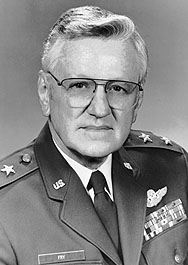 Maj Gen Edward R. Fry, the Adjutant General of Kansas from 1973 to 1980, was a veteran of more than 38 years of active and reserve service. He was elected to a two year term as President of the National Guard Association of the United States in 1978. In this position he actively worked to complete implementation of the “Total Force Policy” in which increased responsibilities upon reserve forces were accompanied by improved equipment and additional manpower.
Maj Gen Edward R. Fry, the Adjutant General of Kansas from 1973 to 1980, was a veteran of more than 38 years of active and reserve service. He was elected to a two year term as President of the National Guard Association of the United States in 1978. In this position he actively worked to complete implementation of the “Total Force Policy” in which increased responsibilities upon reserve forces were accompanied by improved equipment and additional manpower.
Fry graduated from Army Air Corps Pilot Training in September of 1942 and was commissioned a second lieutenant. In the early days of World War II he served as an instructor pilot and in August of 1944 transferred to the European Theater of Operations. Flying a P-51 aircraft, he completed 53 combat missions and was credited with 4.5 enemy aircraft and one probably destroyed.
Following the war, Fry served with the occupation forces in Germany until 1946. Upon his return to Wichita, he was instrumental in the reactivation of the 127th Fighter Squadron, Kansas National Guard, which is known today as the 184th Bomb Wing. During the Korean War, the 127th Fighter Squadron was activitated and served with NATO forces in France with Fry in the position of Director of Operations.In the mid-1950s, Fry moved to the position of Deputy Chief of Staff (Air), Kansas Air National Guard, where he worked to obtain a second Air National Guard unit for the state. This unit, the 117th Fighter Interceptor Squadron, is today the 190th Air Refueling Wing, Topeka.Fry was promoted to Brigadier General in February 1960 and assumed the duties of the Assistant Adjutant General (Air). He was responsible for the rapid mobilization of the 184th Tactical Fighter Group during the “Pueblo Crisis” of 1968.
Fry became the Adjutant General of Kansas in 1973. Also in 1973, he oversaw the creation of the Smoky Hill Weapons Range southwest of Salina. This range is a valuable training area for Guard, Reserve, and Active Air Force crews as well as Army National Guard units.
Fry retired in October, 1980. During his military career, Fry remained active in community service. In 1957 and 1958 he was Campaign Chairman for the United Fund Drive of Wichita, and remained a member of the United Way Board of Directors in Wichita through 1970. In 1970, working with the Wichita Chamber of Commerce he was able to establish the “Citizen-Soldier Award” which is presented annually to the most outstanding enlisted person in a Kansas Guard or Reserve unit. This award is still being presented annually in the Wichita area. Fry was also very active in the Veterans of Foreign Wars and volunteering for the Veterans Hospitals.
Maj. Gen. Fry was the first Adjutant General of Kansas from the Air National Guard.
Ericsson first saw active duty during the Mexican border campaign of 1916 and participated in the hike of the first and second Kansas National Guard Regiments from Eagle Pass, Texas, to San Antonio under the command of MG Frederick Funston.
He was next mustered into Federal Service for World War I duty in August of 1917. In April of 1918 he preceded his unit to southeastern France to make arrangements for quarters and training. Bu August of 1918 Ericsson’s unit, the 35th Infantry Division was placed in reserve behind the battle-front at St. Mihiel and then near the Meuse-Argonne front. On September 16, 1918 Ericsson led Company E into battle. On the fifth day of the battle he was wounded and hospitalized. After release from the hospital he served in various staff duties until discharged from active duty in 1919.
Ericsson returned to the Kansas Army National Guard as the captain of Company D, 4th Infantry Regiment. In the 1920s, his units were activated on several occassions to counter violence associated with strikes. He was promoted to major in 1922 and given command of the 1st Battalion, 137th Infantry. Also in 1922, Ericsson was married to the former Joy E. McAuley. In 1923 he was elected to the Kansas House of Representatives and served through 1926. He became Superintendent of the Boy’s Industrial Reformatory and later was the Utilities Commissioner of the City of Emporia. In this capacity, he was instrumental in the development of Lake Kahola which assured the city of a constant water supply.
Even with increasing responsibilities in civilian life, Ericsson maintained his association with the Kansas National Guard and in 1940, was called to active Federal service again. He served as Regimental Executive Officer as the unit prepared for the upcoming war. In 1941, he assumed command of the 137th Infantry and was promoted to colonel. After the outbreak of hostilities, the men of the 137th were reassigned to combat units by the Army and Ericsson was given command of the prisoner of war camp (German and Japanese) located at Medford, Oregon. His excellent leadership in organizing a camp that contained up to 6,000 prisoners earned him the Army Commendation Ribbon.
Immediately following World War II, Ericsson was assigned to Brake, Germany as commandant of the only military police school in the European Theater.
Ericsson retired from the military in 1948, following 36 years of outstanding service. He continued to serve his community in other capacities. He was Bank Examiner for the State of Kansas for 12 years and was the Executive Director and Secretary of the United Way of Emporia for nine years.
From 1968 to 1983 Ericsson gave speeches about American History and the freedoms we enjoy as citizens of the United States to eighth-grade students in the Emporia area. The Sertoma Service Club awarded Ericsson their highest honor in 1982 to recognize his efforts.
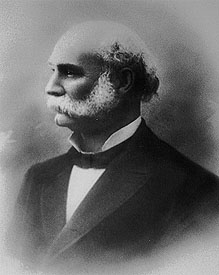 Cyrus K. Holliday
Cyrus K. Holliday
Kansas’ 5th Adjutant General
May 02, 1864 – March 31, 1865
Mayor of Topeka
Civil War Campaign MedalCol. Cyrus K. Holliday, one of the founders of Topeka, and father of the Santa Fe Railroad, was born near Carlisle, Pennsylvania on April 3, 1826.
Holliday was educated at Alleghant College, Meadville, Pennsylvania, for the legal profession, which he followed to some extent, although his natural taste seemed to be for large business undertakings. His knowledge of law and his talents as a public speaker gave him a splendid equipment. His first important business venture was as a contractor for the construction of a short line of railroad in his native state, on which he realized a profit of $20,000.
Holliday came to Kansas and settled in Lawrence in 1854. He took an active interest in the free state movement and believed that Kansas would become a free state. He, with some of his friends, determined on the site of Topeka for their new town which they intended to be a permanent capital of the new state. Holliday was the first president of the Topeka Town Company. He continued to direct the affairs of the company until all of the lots were disposed of and when the company went out of business, Holliday was made trustee for the purpose of curing all defects of title. Many of the lots remained in his name up to the time of his death, and for many years he was the largest individual taxpayer in Topeka.
His greatest satidfaction and his most enduring fame resulted from his connection with the Atchison, Topeka & Santa Fe Railroad, of which he was the inspiration, promoter, builder, first president and director from the date of its organization. He firmly believed in its ultimate sucess, while others ridiculed what they thought a preposterous idea.
Holliday was the first Mayor of Topeka and later was recalled to that position for several terms.
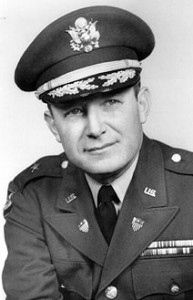 Brigidier General Philip W. Smyth, Holton, an Assistant Adjutant General for the Kansas Army National Guard, established the competitive marksmanship program and the Kansas Army National Guard radio communications network for mobilization exercises. This network was also used as a backup during times of emergency. Additionally, he established the first version of the Guard newspapaer which is now called the Plains Guardian, which was originally called the Kansas National Guard Newsletter. Smyth also established the first state headquarters public affairs section which became the 105th Public Affairs Detachment.
Brigidier General Philip W. Smyth, Holton, an Assistant Adjutant General for the Kansas Army National Guard, established the competitive marksmanship program and the Kansas Army National Guard radio communications network for mobilization exercises. This network was also used as a backup during times of emergency. Additionally, he established the first version of the Guard newspapaer which is now called the Plains Guardian, which was originally called the Kansas National Guard Newsletter. Smyth also established the first state headquarters public affairs section which became the 105th Public Affairs Detachment.
He worked with the Kansas Legislature to get support for armory maintenance and construction. Over 50 armories and ten organizational maintenance shops were constructed during his tenure. Smyth worked to secure authority and funding for the Kansas National Guard Officer Candidate School.
He enlisted in 1929 as a private in the 60th Field Artillery Brigade, serving with that unit until 1940 when he was commissioned a second lieutenant. In December of 1940, he was activitated with the 35th Infantry Division as Division Radio Officer and later was the commander of the 35th Signal Company. He served as the commander, 247th Signal Operations Company, the Signal Officer, 264th Antiaircraft Artillery Group, and was commander of the 444th Signal Aviation Battalion in the Aleutian Islands in 1945.
He graduated from the U.S. Army Signal School at Fort Monmouth, New Jersey, and the Command and General Staff College at Fort Leavenworth, Kansas.
Smyth served 13 years as brigidier general and Assistant Adjutant General (Army), from October 9, 1957 until his death on January 12, 1971.
He was a member of the American Radio Relay League, the Kaw Valley Radio Club, Veterans of Foreign Wars, American Legion, and Military Order of World Wars.
Smyth was born in Holton in 1911.
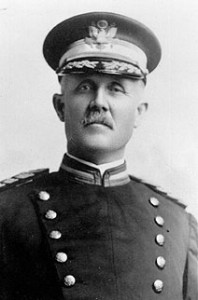 Col. Perry M. Hoisington, Newton, was one of three individuals that helped to organize the Kansas National Guard. He joined the Kansas Guard when it was still the Kansas Militia in 1890, enlisting as a private in Company D, 2nd Infantry at Hutchinson, Kansas. He commanded the 2nd Kansas Infantry from 1895-1917 when it was consolidated with the 1st Kansas to form the 137th Infantry Regiment. He was also the first regimental commander of the 137th Infantry Division, and later commanded the 4th Kansas Infantry.
Col. Perry M. Hoisington, Newton, was one of three individuals that helped to organize the Kansas National Guard. He joined the Kansas Guard when it was still the Kansas Militia in 1890, enlisting as a private in Company D, 2nd Infantry at Hutchinson, Kansas. He commanded the 2nd Kansas Infantry from 1895-1917 when it was consolidated with the 1st Kansas to form the 137th Infantry Regiment. He was also the first regimental commander of the 137th Infantry Division, and later commanded the 4th Kansas Infantry.
He was activated for the Mexican Border incident in 1916 and World War I.
Hoisington was promoted to colonel in 1895 and held that rank for over 25 years, until his retirement in 1921. Altogether he was in a national guard organization for 37 years; from 1875-1881 in Michigan, and from 1890-1921 in Kansas. He also had membership on the State Military Board (1895-1921) where he made an important contribution in upgrading and bringing about reforms in the Kansas National Guard, was for many years Secretary of the National Guard Association of the United States, a member of the General Recruiting Service, and commanded troops during the coal miners strike in southeast Kansas.
Hoisington was also an active civic leader in the state. In 1884, he moved to Newton. He was elected County Treasurer at Newton in 1891 and reelected again in 1893. He was also a member of the city council, on the school board, active in church organizations, and was a trustee for the College of Emporia. Hoisington was instrumental in organizing the waterworks plant at Newton while chairman of a chamber committee.
As a businessman in Newton, Hoisington was secretary and general manager of the Railroad Building, Loan and Savings Association of Newton for 20 years. He was president of the 1st National Bank of Newton. He also organized and was president of the Newton Hotel Company which financed and erected Hotel Ripley in Newton.
Born in Three Rivers, Michigan, Hoisington lived most of his life in Newton, Kansas. He died in 1933. His son, COL Gregory Hoisington, served in the U. S. Army and two of his chidlren–Maj Gen Perry M. Hoisington II, USAF, and Brig Gen Elizabeth P. Hoisington, U. S. Army, are the only brother and sister who have become generals in the history of the Armed Forces. Brig Gen. Elizabeth Hoisington was the first commander of the Women’s Army Corps.
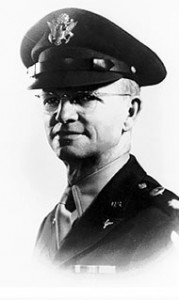 Col. Weltmer first entered the Kansas National Guard on April 1, 1904 as a private in F Company, 1st Regiment, Kansas National Guard in Hiawatha. Weltmer progressed rapidly through the ranks and was commissioned as a second lieutenant on April 19, 1913, remaining with F Company. Immediately before United States entry into World War I, Weltmer participated in the famous Mexican Border Campaign against Poncho Villa in the summer of 1916.
Col. Weltmer first entered the Kansas National Guard on April 1, 1904 as a private in F Company, 1st Regiment, Kansas National Guard in Hiawatha. Weltmer progressed rapidly through the ranks and was commissioned as a second lieutenant on April 19, 1913, remaining with F Company. Immediately before United States entry into World War I, Weltmer participated in the famous Mexican Border Campaign against Poncho Villa in the summer of 1916.
During the Mexican Campaign, Weltmer became company commander and maintained that post from the mobilization for World War I to the end February of 1918. Following his service, Weltmer served with the Aviation Signal Corps at Waco, Texas. He returned to the Guard in 1921, and was assigned Adjutant to the 2nd Battalion of the 130th Field Artillery in Hiawatha. Within four years, he was promoted to major as the Battalion’s commanding officer. Due to his leadership and a major change in the table of organizations, Weltmer was promoted to lieutenant colonel before the unit was activitated in 1940. With the mobilization on December 23, 1940, Weltmer was assigned to the Army Air Corps’ Air Transport Command.
During World War II, Weltmer held numerous noncombat roles for the Army Air Corps. He was the commanding officer for all the Air Corps schools in Kansas City, he commanded Camp Williams, which trained arctic rescue teams and arctic weather station crews, and he also served as an Air Inspector for the West Coast Wing Air Transport Command. With the end of the war, Weltmer was discharged on September 21, 1945, with the rank of lieutenant colonel and was reassigned to the Kansas National Guard. In 1948, Col. Weltmer retired from the military.
Col. Weltmer gave a total of 43 years of his life to military service. He was a strong supporter of civic affairs in Brown County and was first and foremost a citizen soldier in the Kansas National Guard.
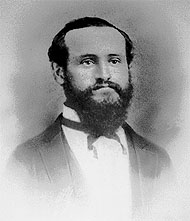 Guilford Dudley
Guilford Dudley
Kansas’ 4th Adjutant General
February 27, 1863 – May 02, 1864
Civil War Campaign MedalGuilford Dudley was one of the oldest and most wealthy settlers of Shawnee county. He was here during most of the territorial troubles of the state and during the civil war. For thirty-six years he conducted a banking business in Topeka.
Dudley was born Bath, New York on March 19, 1835, was educated at Oberlin College in Ohio. In 1856 he moved to Topeka, and on June 5, 1867, he married Samantha V. Otis and later had two children, Margaret and Guilford Jr.
Dudley served in 1856 as clerk of the territorial Legislature, in 1861 as city clerk and in 1863 as adjutant general under Governor Carney, taking an active part on the anti-slavery side in the exciting movements of that period. In business life Dudley devoted himself principally to real estate and banking. In 1869, Dudley founded a private bank, “Dudley’s Bank,” which was carried on with uninterrupted success from its foundation until within the last year when he voluntarily closed the institution on account of other business interests. The long, continuous career of his bank is remarkable when one considers the many trying time through which it was forced to pass in the early days of Kansas and is evidence of his wise and cautious management.
Dudley immigrated to Kansas early in the spring of 1855 and remained about three months at Lawrence. From there he removed to Topeka and engaged in the hotel business for a few months, subsequently dealing in real estate.
During the border troubles of 1856, he served under General James H. Lane and was later Lane’s guard. In 1857 he again resumed his real estate and brokerage business which he continued until 1862, when he was appointed Adjutant General of Kansas, the first political office he every held. He held this position for 18 months, but resigned his office to become a collecting agent in Colorado, Nebraska, New Mexico and Kansas for Carney & Stevens. The company was a wholesale grocery company, based in Leavenworth. After three years, he then resumed his old business. He started his regular banking business in 1869. Dudley also served as clerk of the territorial legislature in 1859 and Topeka City Clerk in 1861.
Dudley ranked foremost among the progressive agriculturist of the county. He was the first to demonstrate the value of bran as a feed for stock at a time when bran from the Topeka mills was considered to be worthless and was being dumped into the Kaw river by the ton. Additionally, Dudley was a regent at the State Agricultural college for a number of years. In this capacity, he authored papers and gave many lectures on agriculture issues.
In later years he had taken up the study of corn breeding and conducted some valuable experiments on his farm south of the city. He was one of the first to take up this work and originated several improved varieties of corn.
 One of Kansas’ greatest soldiers. Capt. Pliley was born in Ross County, Ohio in 1844. His family moved to Kansas around 1856, however, Pliley didn’t began his service in Kansas military forces until September 16, 1863, when he enlisted in F Company, 15th Kansas Volunteer Cavalry. During the Civil War, he progressed through the ranks serving as a corporal, 1st sergeant, and second lieutenant and participating in engagements in Missouri and Kansas against the forces of Confederate Major General Sterling Price.
One of Kansas’ greatest soldiers. Capt. Pliley was born in Ross County, Ohio in 1844. His family moved to Kansas around 1856, however, Pliley didn’t began his service in Kansas military forces until September 16, 1863, when he enlisted in F Company, 15th Kansas Volunteer Cavalry. During the Civil War, he progressed through the ranks serving as a corporal, 1st sergeant, and second lieutenant and participating in engagements in Missouri and Kansas against the forces of Confederate Major General Sterling Price.
He was discharged from service on July 31, 1865 and returned to civilian life in rural Topeka, where he began the study of law, but was interrupted by additional service to Kansas in 1867. Due to numerous reports of theft, murder, rape and kidnapping of settlers by Indian warriors, Governor Crawford called for volunteers which resulted in the formation of the 18th Kansas Volunteer Cavalry. Pliley worked as a civilian scout for this unit, and despite his civilian capacity, was lauded by witnesses for his leadership which included commanding units. Although being shot twice during the Battle of Prairie Dog Creek, he continued fighting and rallying troops, and later, made an incredibly brave dash, by himself, in the face of several hundred Indians for help.
Not long after his services were complete with the 18th Kansas, Pliley joined Forsyth’s Scouts and was involved in the bloody Battle of Beecher’s Island, where 50 scouts held off 1,000 Indian warriors over a nine day battle. Pliley was one of four men who were able to sneek through enemy lines and travel 73 miles on foot to Ft. Wallace, Kan., to arrange a rescue. Ironically, the commander of the troops who rode out to the battle, which was winding down by the time he arrived, later received the Medal of Honor. None of the four men who volunteered for the extremely dangerous mission and saved the unit, including Pliley, received the medal.
Following his service with Forsyth’s Scout’s, Pliley was commissioned a captain by the governor and was given command of Company A of the 19th Kansas Volunteer Cavalry. When the entire unit became lost during a tremendous blizzard, Pliley lead a group of soldiers through the blizzard at night for help. He personally found help, and the unit was saved from starvation and freezing to death. He served in this capacity from October 20, 1868 until April 18, 1869, and was consistently being chosen to lead scouting and rescue details.
After serving with the 19th Kansas, Pliley was selected to command Company A, 2nd Frontier Battalion, which had been formed after Indians raided several settler’s homes near Lincoln, Kan. There, Pliley commanded over 80 men and 90 horses at the camp which eventually became known as Camp Pliley. Although no major battles occured, the Indian hostilities in the area ceased while Camp Pliley was active.
Pliley eventually settled down and got married on July 30, 1871 to Martha “Mattie” L. Young. For several years he successfully worked in a variety of jobs, including laborer for hire and painter. Eventually, however, the call of adventure got the best of him and in 1876, he sent a letter to Gen. Custer, who he had served alongside during 1868 and 1869, asking him for a scouting job. When no reply came in the mail, Pliley concluded that he better forget his adventurous plans once and for all, and find other work. Later, a reply from Custer finally arrived, offering Pliley the job, but it was too late. Custer and his men had already started their mission, which would end in a little known place called Little Big Horn.
Pliley worked several different types of jobs, but eventually made a living by dredging sand for contractors in downtown Kansas City. In the winter, he would make money by cutting ice for storage. His home in Armordale, located in northern Kansas City, eventually filled with seven daughters. He aged quietly and eventually he became just another old man sitting on his porch reminiscing about his younger days.
On Feb. 22, 1917, the man who had saved the day so many times and had given so much to his country and state, died at his home in Kansas City, Kansas. He was 72 years old. Captain Pliley is buried in the Quindaro Cemetery located at 38th and Parallel, Kansas City, Kansas beside his wife,in lot 370, Section 5.
According to all accounts, Pliley was an extremely brave and modest man. A fellow soldier who had campaigned across the Plains of Kansas with Pliley, later wrote, “Mr. Pliley was one of the most effective scouts and one of the best cavalry officers of the day, but he is very modest, and never would push himself forward or toot his own horn. I know that Pliley was a tremendously prominent figure at that time…He is one of the gentlest, most unselfish and least calculating of men, simple-minded and frank, a man of great intelligence and common sense. Forty years ago courage was unnoticed — it was taken for granted on the plains; but Pliley’s courage was noticeably different from that of his fellows. He delighted in a desperate situation. He was a natural leader… Pliley always took the hard end of a job.”
 General Charles I. Martin, born on January 25, 1871 in Ogle County, Illinois, moved to Kansas as a youth and resided on a farm in Allen County. Martin’s family moved to the Fort Scott Area, and at the age of 19, he enlisted in F Company, 1st Kansas Infantry Regiment, Kansas National Guard.
General Charles I. Martin, born on January 25, 1871 in Ogle County, Illinois, moved to Kansas as a youth and resided on a farm in Allen County. Martin’s family moved to the Fort Scott Area, and at the age of 19, he enlisted in F Company, 1st Kansas Infantry Regiment, Kansas National Guard.
Promoted to Sergeant on March 30, 1892, he was eventually commissioned as a second lieutenant on April 6, 1893, and reached the rank of Captain on February 1, 1896. Martin was discharged from the Kansas National Guard on April 30, 1898, to accept a federal commission with the 20th Kansas Volunteers during the outbreak of hostilities with Spain. He and his unit were shipped to the Philippines and participated in the Pacification Campaign to bring order to the islands. While in that capacity, Martin reached the rank of major, which he held until his discharge on October 20, 1899.
Upon his return, Martin resumed his civilian occupation of teaching in Emporia. In 1901, he was elected as clerk of Bourbon County District Court and developed an interest in law. Both he and his wife enrolled at the University of Kansas Law School. He practiced law for a number of years, until he was again called to service. He rejoined the Kansas National Guard and rapidly advanced to the rank of colonel, serving as Inspector General. In 1909, Martin, then a practicing lawyer in Fort Scott, was selected to be Adjutant General of Kansas, with the rank of brigadier general.
Martin served as Adjutant General until June 21, 1917, when with the approach of World War I, he was appointed Brigader General of the Line. By August 5, 1917, the Kansas National Guard was called into federal service, and Martin was assigned to the 70th Brigade as the Commanding General of the 35th Division element where he remained until his relief on September 21, 1918. At the end of the war, Martin was promoted to major general and became the Commanding General of the 35th Division, a post he held until his retirement on January 31, 1935.
Martin died on May 8, 1953 in Cheyenne, Wyoming, at the age of 82. He is buried in the Fort Leavenworth National Cemetery – Section 43A, Rox 3, Grave 1.
BG Charles Chadwick was a native of Tompkins County, N. Y. Was educated in the common and select schools of that county. In 1841, went to Westfield, Chautauqua County, to write as a clerk in the Surrogate’s office of that county, and commenced the reading of law with his uncle, the Hon. Austin Smith, who was then Surrogate of the county. In 1851, at a general term of the Supreme Court of the Eighth Judicial District, he was admitted to the bar, and commenced the practice with his old preceptor, who took him in as a partner, continuing this partnership until 1857, when he struck out for Kansas, and settled in Quindaro, then a promising point on the Missouri River. Here he opened a law and real estate office, where he remained until 1860. In the spring of 1859, was elected a Justice of the Peace for Quindaro Township, and filled the office, until July, 1860, when he went to Doniphan County, and in the fall of 1861 went to Topeka, having been appointed by Gov. Charles Robinson, Adjutant General, to fill vacancy, and had the position of Private Secretary to Gov. Robinson, which position he held during the balance of the term. In the spring of 1863, settled in Lawrence, and opened a law office, entered into partnership with Hon. Nelson Cobb, which continued till Mr. Cobb moved to Kansas City, in the fall of 1867. In 1864, he was appointed Paymaster General, with rank of Major, by Gov. Thomas Carney, which position he filled during Gov. Carney’s term of office and in the fall of 1864, paid the State Militia for services in the spring of 1861 (sic) In 1865, was elected a Justice of the Peace, for the city of Lawrence, and has held the office continuously, except two years – 1872 and 1873. Was elected Police Judge in 1881, for a term of two years.
BG Chadwick died April 23, 1900 and is buried in Lawrence’s Oak Lawn Cemetery – Section 8, Lot 117.
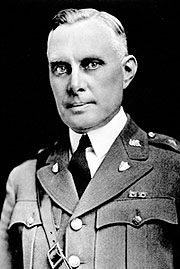 Born in Illinois, Milton McLean was born at Clinton, Illinois, on December 9, 1874, the son of James and Emma (Robbins) McLean. He attended the public schools of Clinton and later took electrical engineering courses at Northwestern University. He served the Illinois Central Railroad as a telegrapher for four years and in 1894 came to Wellington, Kansas, where he engaged in the banking business until 1917. He was married on October 19, 1898, to Mary Dougherty Share.
Born in Illinois, Milton McLean was born at Clinton, Illinois, on December 9, 1874, the son of James and Emma (Robbins) McLean. He attended the public schools of Clinton and later took electrical engineering courses at Northwestern University. He served the Illinois Central Railroad as a telegrapher for four years and in 1894 came to Wellington, Kansas, where he engaged in the banking business until 1917. He was married on October 19, 1898, to Mary Dougherty Share.
He enlisted in the Kansas National Guard and became a captain in the Signal Corps on November 26, 1907. He was promoted to major on May 14, 1909. When World War I broke out, he commanded the 110th Field Signal Battalion, 35th Division in World War I, and upon his return to his state, was appointed by the Governor as Assistant Adjutant General on June 12, 1919.
On May 24, 1923, he was appointed colonel of the 161st Field Artillery, Kansas National Guard. He was appointed Adjutant General of Kansas on February 10, 1925, giving him the rank of brigadier general. McLean held this position until his death, having served as Adjutant General for ten governors. Other positions he held include State Director of Selective Service, Secretary-Treasurer of the Adjutants General Association of the United States, and Treasurer of the National Guard Association of the United States (for more than 25 consecutive years).
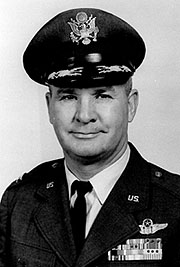 Col Carl L. (Curly) Boggs Sr. entered military service in January of 1942, and graduated from pilot training with both B-17 and P-51 aircraft qualification. He served as a bomber pilot in Europe (flying 31 missions over German-occupied territory) until April of 1945, and was released from active duty on March 11, 1946. He later was a charter member of the Kansas Air Guard’s 127th Fighter Squadron at McConnell Air Force Base. He was chief of aircraft maintenance. He served there until called on active duty for the Korean conflict in 1950. He then served in Louisiana until transferred to the 136th Fighter Wing in Korea, where he served until July of 1952.
Col Carl L. (Curly) Boggs Sr. entered military service in January of 1942, and graduated from pilot training with both B-17 and P-51 aircraft qualification. He served as a bomber pilot in Europe (flying 31 missions over German-occupied territory) until April of 1945, and was released from active duty on March 11, 1946. He later was a charter member of the Kansas Air Guard’s 127th Fighter Squadron at McConnell Air Force Base. He was chief of aircraft maintenance. He served there until called on active duty for the Korean conflict in 1950. He then served in Louisiana until transferred to the 136th Fighter Wing in Korea, where he served until July of 1952.
He returned to the Kansas Air National Guard in 1952 as commander of the 137th Maintenance and Supply Group, and later was commander of the 117th Fighter Interceptor Squadron at the Hutchinson Naval Air Station. He was named commander of the Hutchinson Air National Guard Base and then commander of the 190th Tactical Reconnaissance Group in 1962, operating B-57A aircraft in photo reconnaissance missions. The group was transferred to Forbes in 1967.
Col. Boggs retired at Forbes on May 24, 1976 after more than 34 years of service. During this time he received the Legion of Merit, Distinguished Flying Cross, Air Medal with three Oak Leaf Clusters, Presidential Unit Citation with Oak Leaf Cluster, and other service awards.
Col. Boggs passed away in a Topeka hospital on February 23, 1983.
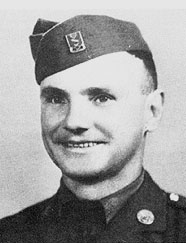 Master Sgt. Henry J. Bausch was born on May 3, 1899 at Hoyt, Kansas. He began his military career by enlisting in Company H, Fourth Infantry Regiment, Kansas Army National Guard on October 22, 1918. Since his enlistment came at the war’s end, Sergeant Bausch would spend the first 22 years of his military service in the peacetime National Guard. During this period, “Hank” Bausch served the state in various elements of the 137th Infantry Regiment and served in every enlisted rank from private to first sergeant.
Master Sgt. Henry J. Bausch was born on May 3, 1899 at Hoyt, Kansas. He began his military career by enlisting in Company H, Fourth Infantry Regiment, Kansas Army National Guard on October 22, 1918. Since his enlistment came at the war’s end, Sergeant Bausch would spend the first 22 years of his military service in the peacetime National Guard. During this period, “Hank” Bausch served the state in various elements of the 137th Infantry Regiment and served in every enlisted rank from private to first sergeant.
When the 137th Infantry Regiment was mobilized on December 23, 1940, Bausch became First Sergeant of the Antitank Company, a unit formed from the old Topeka Howitzer Company. Bausch continued to serve with this unit throughout the stateside service of the 137th and was still with the Antitank Company when the 35th Infantry Division landed in France on July 6, 1944. During his service in the European theater, Bausch saw combat in five major campaigns including Normandy, Northern France, Central Europe, Ardennes, and the Rhineland. He was awarded the Purple Heart for wounds sustained in combat and received the Combat Infantryman’s Badge.
At the end of the war, “Hank” returned to the United States, and despite the fact that his military obligation had long been fulfilled, he elected to stay in the reserves as a Master Sergeant.
This devotion to duty in the armed services, in addition to his unique ability to work with his men brought credit to him and to the units with which he served. In peace and war, Master Sgt. Henry Bausch was a soldier of special abilities, a quality which brought credit to the service and to the Kansas National Guard.
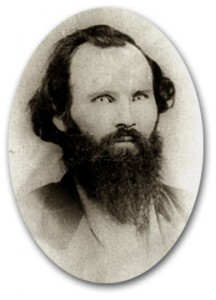 Lyman Allen
Lyman Allen
Kansas’ 2nd Adjutant General
June 23, 1861 – March 22, 1862
Free-State Legislator 1857-1858
Allen Signature
Brig. Gen. Lyman Allen was born December 18, 1827, in Groton, New York.
He was married to Ann Jeannette XXX on XXXXX.
Lived at 17 Connecticut
Occupation: salesman, tin, iron, and copper manufacturing,
Brig. Gen. Allen was highly involved in the free-state movement in Territorial Kansas. The northeastern Kansas was an extremely dangerous place during this time period. There were lootings, murder, arson, and many other acts of terriorism. In May of 1856, he and two other men were appointed by the people of Lawrence to “ask the Marshall to put a stop to the depravations committed by a large force of armed men in the vicinity of Lawrence.” The territory became so dangerous territorial Gov. A.H. Reeder escaped from Kansas with Lyman Allen’s help in early May of 1856. During the destruction of the Free-State Hotel in Lawrence by Sheriff Jones, he lost $574 in books, and on May 21, 1856, had his Sharp’s Rifle taken from his home by a force of bushwackers.
one of the earlier settlers of Douglas County and a member of the territorial council of 1857-1858. He came to Kansas on March 24, 1855
Children: Anna, Mary Jane, Jennie, Jessie (died at 7 months), Katie (died at 10 months)
Allen was active in the free-state movement in early Kansas and served in a variety of positions which included; member of the board of trustees of Lawrence University in 1859, a member of the Emporia Town Company in 1857, which selected the site for the town of Emporia, and the railroad convention of 1860.
The Allen family all took part in the border troubles, including his father, Asaph, who had his house attacked by bushwackers. “When the guerillas knocked roughly at his door and demanded admittance, threatening to kill all the inmates if resistance was offered, but making the usual promise that no one should be hurt if the door was opened and prompt surrender made. Mr. Allen was quite old but full of courage and resolution. He told the guerillas to come on in if they could get in, assuring them that he was good for at least six ruffians as soon as they might enter. The bushwackers left and no others returned,” according to the book, Quantrill and the Border Wars.
Lyman had two brother who served in the militia during the Civil War. Norman Allen, who was an editor of the Lawrence Republican which was destroyed in Quantrill raid, served as a captain in the 1st Kansas Volunteer Battery. Asaph Allen Jr., served as a captain in the 9th Kansas Volunteer Cavalry.
On July 23, 1861 Allen was appointed Adjutant General.
He served in this position until March 22, 1862.
He died at his home in Lawrence, Kansas on November 30, 1863, two months after Quantrill’s famous raid on Lawrence. He is buried at Oak Hill Cemetery in Lawrence, Kansas. His two sentence obituary in the Leavenworth Conservative, describes him as a man of “high character.”
Governor of New Mexico Territory
 Col. Montimer M. Hilleary, born in Humboldt, joined the U.S. Army on January 1, 1942. He received his commission on July 15, 1942 and was assigned for further training as an ordnance officer. After this advanced training and duty in the American Theater, he was assigned to Camp Naumoka, Fiji. The remainder of World War II he spent in the Pacific Theater; most of the time on Guadalcanal.
Col. Montimer M. Hilleary, born in Humboldt, joined the U.S. Army on January 1, 1942. He received his commission on July 15, 1942 and was assigned for further training as an ordnance officer. After this advanced training and duty in the American Theater, he was assigned to Camp Naumoka, Fiji. The remainder of World War II he spent in the Pacific Theater; most of the time on Guadalcanal.
After the war he returned to Kansas and as a major, joined Headquarters and Headquarters Battery, 130th Field Artillery Group in Hutchinson, Kansas. He was assigned to the 130th for the next three years serving as S-4, S-3, and Executive Officer. In September of 1950, his unit was ordered to active duty in Korea and Japan during the Korean War. He returned to Hutchinson in August of 1952 as a lieutenant colonel, serving first as Executive Officer of the 130th Artillery Group and beginning in 1965 as its commanding officer which he retained until July 31, 1974.
In addition to his meritorious service to his country in both World War II and the Korean Conflict, Hilleary gave meritorious service to the Kansas National Guard and the State of Kansas through his support of civil authorities in civil disasters. His exceptional leadership shown in the National Guard relief operations in the wake of the February 1971 blizzard that struck Reno County provided the area with vital assistance.
He also assisted in the reorganization and development of the 130th Field Artillery in the post World War II era.
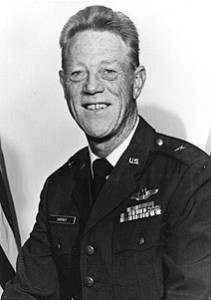 Brigadier General J E “Speck” Gardner, born in Carlton, Kansas, joined in the enlisted reserve corps of the Army of the United States on October 22, 1942, and compiled a varied and distinguished military career. He was given pilot training and received his pilot’s wings and commission on March 12, 1944. Gardner served a combat tour in France and Holland, flying 33 B-26 Martin Marauder combat missions in 1945.
Brigadier General J E “Speck” Gardner, born in Carlton, Kansas, joined in the enlisted reserve corps of the Army of the United States on October 22, 1942, and compiled a varied and distinguished military career. He was given pilot training and received his pilot’s wings and commission on March 12, 1944. Gardner served a combat tour in France and Holland, flying 33 B-26 Martin Marauder combat missions in 1945.
After the war, he joined the Kansas Army National Guard in June of 1948, serving as Battery Executive Officerand later as forward observer and liaison pilot of the 127th Field Artillery Battalion. In December 1950, Gardner transferred toAir Base Flight E, Air Section, State Headquarters and Headquarters Detachment. When the Headquarters, Kansas Air National Guard was organized in 1951, Gardner became the Headquarter’s first commander. After this assignment, he held a number of significant positions in the newly formed Air National Guard including the Chief of Staff, Operations Staff Officer, Administrative Staff Officer, Executive Support Officer, and Director of Personnel Management. Ultimately, he finished his career with duty as Assistant Adjutant General, Air, and Commander, Headquarters, Kansas Air National Guard.
Since he had served in both the Air and Army National Guard, Gardner had a unique career. While he was a command pilot with over 6,200 military and civilian flying hours, he also had service within a field artillery battalion giving him unique insights into both branches of the service. His devotion to both branches of the Kansas Nation Guard and his ability to relate and work with a wide range of individuals on both the State and National level, has made an important place for General Gardner in the history of the Kansas National Guard.
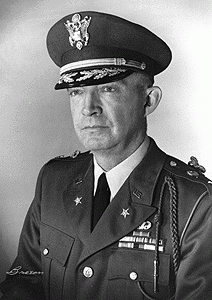 Col. Frank D. Boyd enlisted in the Kansas National Guard on October 2, 1932, first serving as a Private in Headquarters Troop, 114th Cavalry Regiment at Topeka. He served in the Headquarters Troop throughout the entire war period where he was promoted to First Sergeant in 1938. He entered the commissioned ranks on September 1, 1940. He was a member of the 127th Field Artillery, 35th Infantry Division, when it was mobilized for federal service on December 23, 1940.
Col. Frank D. Boyd enlisted in the Kansas National Guard on October 2, 1932, first serving as a Private in Headquarters Troop, 114th Cavalry Regiment at Topeka. He served in the Headquarters Troop throughout the entire war period where he was promoted to First Sergeant in 1938. He entered the commissioned ranks on September 1, 1940. He was a member of the 127th Field Artillery, 35th Infantry Division, when it was mobilized for federal service on December 23, 1940.
Boyd remained with the 35th Infantry Division until 1942, when he began parachute training. Upon its completion, he became a member of the 82nd Airborne Division and remained with the 82nd throughout the remainder of the war.
After the war, he rejoined the Kansas National Guard in 1947 as a Major, assisting with the reorganization of the Guard. He became a full-time Administrative Assistant in the Operating Headquarters of the 35th Division and was actively involved in the drive to purchase the present property where the Kansas National Guard is now headquartered. Following this purchase and the planning of the Nickell Memorial Armory, Boyd was directed to develop an Officer Candidate School. He organized the school and served as both an administrator and instructor. He resigned as Administrative Assistant in 1953, to engage in private business, but remained on the 35th Division staff for an additional ten years as Assistant G-2, Assistant Chief of Staff, Inspector General, and G-2. Colonel Boyd retired in 1963 after more than 30 years of military service.
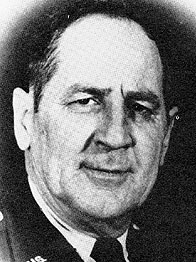 Born at Kansas City, Kansas, on January 18, 1919, Mr. Loftus completed nearly 35 years of service to his State and Nation with his retirement effective September 30, 1977. He served with distinction for three years in Europe during World War II and for two years in Korea during the Korean Conflict with the 2nd Infantry Division. His long association with the Kansas Army National Guard as a full-time technician at Pittsburg and Coffeyville brought credit to himself and the units in which he served. His work in manning the force (recruiting and retention) made him a legend in his own day and his actions serve as a model for others to follow. Mr. Loftus resided at Frontenac, Kansas, and died on April 23, 1982.
Born at Kansas City, Kansas, on January 18, 1919, Mr. Loftus completed nearly 35 years of service to his State and Nation with his retirement effective September 30, 1977. He served with distinction for three years in Europe during World War II and for two years in Korea during the Korean Conflict with the 2nd Infantry Division. His long association with the Kansas Army National Guard as a full-time technician at Pittsburg and Coffeyville brought credit to himself and the units in which he served. His work in manning the force (recruiting and retention) made him a legend in his own day and his actions serve as a model for others to follow. Mr. Loftus resided at Frontenac, Kansas, and died on April 23, 1982.
 Brigadier General Thomas J. Kennedy began his military career with enlistment on 26 September 1939, in Company B, 137th Infantry of the 35th Division at Emporia, Kansas. This decision would temporarily interrupt his college career since his unit was mobilized with the 35th Division on 23 December 1940. He left the Division and received a commission as Second Lieutenant, Field Artillery in 1941. By May 1943, he had been promoted to Captain and was reassigned to the newly activated 63rd Infantry Division as Commander, Headquarters Battery and Battalion Communications Officer of the 718th Field Artillery Battalion.
Brigadier General Thomas J. Kennedy began his military career with enlistment on 26 September 1939, in Company B, 137th Infantry of the 35th Division at Emporia, Kansas. This decision would temporarily interrupt his college career since his unit was mobilized with the 35th Division on 23 December 1940. He left the Division and received a commission as Second Lieutenant, Field Artillery in 1941. By May 1943, he had been promoted to Captain and was reassigned to the newly activated 63rd Infantry Division as Commander, Headquarters Battery and Battalion Communications Officer of the 718th Field Artillery Battalion.
In 1944, Kennedy and the 63rd Division were deployed to the European Theatre of Operations. They were in contact with the enemy for 125 continuous days during 1944-1945 in France and Germany, where the Division not only penetrated the Siegried Line, but was involved in crossing the Rhine and the Danube Rivers. For his service during World War II, General Kennedy was awarded the Bronze Star Medal, European, African and Middle East Campaign Medal with two Battle Stars and the National Defense Service Medal, to mention a few.
Following the war, General Kennedy returned to the Kansas National Guard and the 35th Division with successive appointments as Assistant G-3, Division Chemical Officer, Inspector General and Assistant Chief of Staff, G-2. With the 35th Division’s deactivation in 1963, he became the Executive Officer of the newly formed 69th Infantry Brigade and later, with his promotion to Colonel, became Deputy Brigade Commander. He held that post when the Brigade was ordered to active Duty in May 1968. In September 1968 he became the Briagde’s Commanding Officer when it was assigned to the 5th Infantry Division (M) at Fort Carson, CO. and held that position until December 1969 when the Brigade was released from Active Duty. For this period of service, Kennedy was awarded the Legion of Merit and two Army Commendation Medals.
In 1970, he was named Commanding General of the Brigade, a position he held for the next six years. On his retirement, Kennedy was awarded a second Legion of Merit for Distinguished Service. Following his retirement, he was appointed Director of Alcoholic Beverage Control for the State of Kansas, a position he held for seven years.
Kennedy has been active in many organizations including serving as President of the Topeka Chapter of the AUSA, President of the NGAKS, President of the Topeka Chapter of the MOWW and State Commander of MOWW, Commander of Capitol Post #1 of the American Legion, Chairman, Kansas Commission on Veterans Affairs, and Chairman, Military Academy Nomination Committee for Senator Sam Brownback. He also handled disasters and disorders at the scene, i.e., the flood of 1951, the Tornado at Meriden and the Riots of 1968 in Kansas City.
General Kennedy was inducted into the Artillery Officer Candidate School Hall of Fame at Fort Sill, OK in 1970. A graduate of Washburn University of Topeka, he was named a Distinguished Service Award recipient in 1978 and in 1982 he was inducted into the Kansas National Guard Hall of Fame. He is also recognized at KSU, Emporia where he is honored with Military Memorabilia on display in the Veterans Room of Honor.
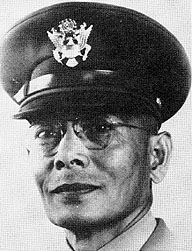 Born on Luzon in the Philippine Islands on February 16, 1889, Maj. Domingo came to America as a youth upon the loss of his parents. He was educated in Kansas and joined the Kansas Army National Guard in 1906. He served with distinction in the Mexican Campaign during 1916 and later with the 137th Infantry Regiment in Europe during World War I. He was commissioned a second lieutenant during March 1920, completing some 38 years of service to State and Nation prior to his retirement in 1944 while on active duty in World War II. His retirement was caused by respiratory illness brought on due to his exposure to poison gas in Europe in World War I. Maj. Faustino devoted truly outstanding services to the development of marksmanship training in the Kansas National Guard and is recognized as the father of the Kansas National Guard Marksmanship Program. The Topeka newspaper in 1920, in writing about Maj. Faustino, stated, “Faustino J. Domingo, a Philippino by birth and a 100 percent American in action.” Maj. Domingo died on January 4, 1961.
Born on Luzon in the Philippine Islands on February 16, 1889, Maj. Domingo came to America as a youth upon the loss of his parents. He was educated in Kansas and joined the Kansas Army National Guard in 1906. He served with distinction in the Mexican Campaign during 1916 and later with the 137th Infantry Regiment in Europe during World War I. He was commissioned a second lieutenant during March 1920, completing some 38 years of service to State and Nation prior to his retirement in 1944 while on active duty in World War II. His retirement was caused by respiratory illness brought on due to his exposure to poison gas in Europe in World War I. Maj. Faustino devoted truly outstanding services to the development of marksmanship training in the Kansas National Guard and is recognized as the father of the Kansas National Guard Marksmanship Program. The Topeka newspaper in 1920, in writing about Maj. Faustino, stated, “Faustino J. Domingo, a Philippino by birth and a 100 percent American in action.” Maj. Domingo died on January 4, 1961.
 Born in Horton, on December 5, 1909, Gen. Browne, during his 39 years of dedicated service to State and Nation, was the only person in the history of the 35th Infantry Division to serve in every enlisted and officer rank authorized in the Division. He joined the Kansas Army National Guard on March 23, 1926, as a private, and retired from the service on September 30, 1965, as a major general, having commanded the 35th Infantry Division and the 69th Separate Infantry Brigade. His service included truly laudatory action in the European Theater during World War II where he entered as a second lieutenant and was given a battlefield promotion to major. Gen. Browne was well known also in the field of newspaper work as the editor and publisher of the Horton Headlight. Gen. Browne died July 6, 1973.
Born in Horton, on December 5, 1909, Gen. Browne, during his 39 years of dedicated service to State and Nation, was the only person in the history of the 35th Infantry Division to serve in every enlisted and officer rank authorized in the Division. He joined the Kansas Army National Guard on March 23, 1926, as a private, and retired from the service on September 30, 1965, as a major general, having commanded the 35th Infantry Division and the 69th Separate Infantry Brigade. His service included truly laudatory action in the European Theater during World War II where he entered as a second lieutenant and was given a battlefield promotion to major. Gen. Browne was well known also in the field of newspaper work as the editor and publisher of the Horton Headlight. Gen. Browne died July 6, 1973.
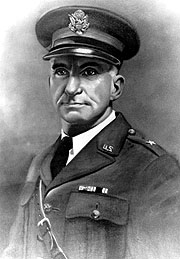 BG Wark was born near Liberty, Kansas on December 19, 1878. After graduating from Montgomery High School he entered the Law School of the University of Kansas, receiving his degree in 1903. He started a practice in Caney, Kansas, where he maintained his office throughout his legal career.
BG Wark was born near Liberty, Kansas on December 19, 1878. After graduating from Montgomery High School he entered the Law School of the University of Kansas, receiving his degree in 1903. He started a practice in Caney, Kansas, where he maintained his office throughout his legal career.
He joined the Kansas National Guard as a private in 1909, and was commissioned a few days later as a first lieutenant. In 1916, was elected to the Kansas State Senate. At the outbreak of World War I, he was asked to organize Company D, 3rd Kansas Infantry in Caney, Kansas. He was mobilized and commanded Company B, 129th Machinegun Battalion. Ordered to France in 1918, he participated in the Meuse-Argonne Offensive, and was awarded the Victory Medal and Ribbon. He was cited by the commanding general of the 35th Division for his bravery, coolness in the face of extreme danger, ability to command and for his conduct on the morning of September 26, 1918, in reforming and leading forward a line composed of scattered units of infantry and machinegun organizations near Cheppy, France, and by his example, inspiring and enabling them to complete their advance into Cheppy. The men of Company B, 129th Machinegun Battalion, later presented him with a gold watch inscribed with, “To Capt. Geo. H. Wark as a token of esteem from the members of Co. B, 129th M. G. Bn.”
During World War I, the Kansas Senate passed a resolution to compensate “Sen. Wark” for the pay he would have received in the 1919 Legislative session, if he were not in combat in Europe. He refused it, saying that the U.S. Government had paid him during this time.
After World War I, he retained his membership in the Kansas Army National Guard, continued as a Kansas State Senator, and became Federal Prohibition Director for Kansas, Missouri, Arkansas, and Oklahoma. In 1933, Wark was promoted to brigadier general, and served as Military Counsel for the State of Kansas. When the Guard was mobilized for World War II, Wark was made Commander of the Artillery Brigade. He was released from federal service for physical disability on August 17, 1941, whereupon he returned to his law practice in Kansas. The National Guard Armory in Coffeyville is named in his honor.
 Howard Sanford Searle was born October 24, 1891 at Edgar, Nebraska and raised in Kansas. He graduated from Topeka High School and Washburn University with an A.B. in 1914 and an L.L.B. in 1916. Enlisted in Headquarters & Headquarters Battery, 130th Field Artillery Regiment, Kansas Army National Guard in September 1917, and served overseas in World War I. He was commissioned a second lieutenant on October 3, 1918. He served continuously with the Kansas National Guard, and was mobilized in December of 1940 for World War II as a lieutenant colonel. He served as personnel officer and then Deputy Chief of Staff of the VII Corps during World War II. After the war, Searle became a brigadier general in the Kansas National Guard in October of 1946, and was assigned the responsibility of re-establishing the Kansas National Guard across Kansas. He was assigned Assistant Division Commander, 35th Infantry Division. He handled several disasters at the scene, specifically the flood in 1951 in Kansas City and the tornado at Udall.
Howard Sanford Searle was born October 24, 1891 at Edgar, Nebraska and raised in Kansas. He graduated from Topeka High School and Washburn University with an A.B. in 1914 and an L.L.B. in 1916. Enlisted in Headquarters & Headquarters Battery, 130th Field Artillery Regiment, Kansas Army National Guard in September 1917, and served overseas in World War I. He was commissioned a second lieutenant on October 3, 1918. He served continuously with the Kansas National Guard, and was mobilized in December of 1940 for World War II as a lieutenant colonel. He served as personnel officer and then Deputy Chief of Staff of the VII Corps during World War II. After the war, Searle became a brigadier general in the Kansas National Guard in October of 1946, and was assigned the responsibility of re-establishing the Kansas National Guard across Kansas. He was assigned Assistant Division Commander, 35th Infantry Division. He handled several disasters at the scene, specifically the flood in 1951 in Kansas City and the tornado at Udall.
His decorations include the Legion of Merit, Bronze Star Medal, the French Legion of Honor and the Croix de Guerre with Palm.
 MSG Hames enlisted in the Kansas Army National Guard in 1916, and served at the Mexican Border during the time of Pancho Villa. He served as first sergeant of the 35th Infantry Division, and was gassed and wounded at St. Mihiel, France, during World War I. After the war, he rejoined the Kansas National Guard, and served as first sergeant, Battery D, 161st Field Artillery. In 1940, as Chief Master Sergeant, he was in charge of Motors and Supply Service Battery, 2nd Battalion, 161st Field Artillery. In World War II, 1942-46, he was in charge of training aids and the School Library, Field Artillery School at Fort Sill. From 1946-56, he was Chief Master Sergeant, Personnel & Administration, Army of Occupation in Japan. In 1956, he retired to Olathe.
MSG Hames enlisted in the Kansas Army National Guard in 1916, and served at the Mexican Border during the time of Pancho Villa. He served as first sergeant of the 35th Infantry Division, and was gassed and wounded at St. Mihiel, France, during World War I. After the war, he rejoined the Kansas National Guard, and served as first sergeant, Battery D, 161st Field Artillery. In 1940, as Chief Master Sergeant, he was in charge of Motors and Supply Service Battery, 2nd Battalion, 161st Field Artillery. In World War II, 1942-46, he was in charge of training aids and the School Library, Field Artillery School at Fort Sill. From 1946-56, he was Chief Master Sergeant, Personnel & Administration, Army of Occupation in Japan. In 1956, he retired to Olathe.
 Colonel Fall began his military career on June 6, 1937 when he enlisted in Company G, 137th Infantry, 35th Infantry Division. He was activitated with this unit when the Guard was mobilized prior to World War II. He received a battlefield commission as second lieutenant of infantry. He was in all five major battles of the European Theater of Operations, including the capture of St. Lo and the Battle of the Bulge. He was awarded the Distinguished Service Cross, the second highest award for bravery in action. Following World War II, he was very active in the Kansas Army National Guard. In 1967, he was promoted to lieutenant colonel and assigned Commander, 1st Battalion, 137th Infantry, which was ordered to active duty in 1968 during the Pueblo Crisis. He served in Vietnam during 1969-70.
Colonel Fall began his military career on June 6, 1937 when he enlisted in Company G, 137th Infantry, 35th Infantry Division. He was activitated with this unit when the Guard was mobilized prior to World War II. He received a battlefield commission as second lieutenant of infantry. He was in all five major battles of the European Theater of Operations, including the capture of St. Lo and the Battle of the Bulge. He was awarded the Distinguished Service Cross, the second highest award for bravery in action. Following World War II, he was very active in the Kansas Army National Guard. In 1967, he was promoted to lieutenant colonel and assigned Commander, 1st Battalion, 137th Infantry, which was ordered to active duty in 1968 during the Pueblo Crisis. He served in Vietnam during 1969-70.
 Brigadier General Calvin E. Barry was born near Meriden, Kansas on January 9, 1898. After graduation from Meriden High School he entered Washburn College and participated in the Students Army Training Corps. He later completed a business course and was employed in the Auditor of Disbursements Office of the Atchinson, Topeka and Santa Fe general offices and quickly rose to the head of the department. He was enlisted in Headquarters & Headquarters Battery, 60th Field Artillery Brigade by another Hall of Famer, Howard S. Searle, in 1923. He was commissioned a second lieutenant July 1925. He was mobilized with the Guard in 1940 and saw action in North Africa and Italy. He received the Legion of Merit and Bronze Star Medals. In 1951, he became a Brigadier General assigned to Headquarters, 35th Infantry Division, and retired in February of 1958.
Brigadier General Calvin E. Barry was born near Meriden, Kansas on January 9, 1898. After graduation from Meriden High School he entered Washburn College and participated in the Students Army Training Corps. He later completed a business course and was employed in the Auditor of Disbursements Office of the Atchinson, Topeka and Santa Fe general offices and quickly rose to the head of the department. He was enlisted in Headquarters & Headquarters Battery, 60th Field Artillery Brigade by another Hall of Famer, Howard S. Searle, in 1923. He was commissioned a second lieutenant July 1925. He was mobilized with the Guard in 1940 and saw action in North Africa and Italy. He received the Legion of Merit and Bronze Star Medals. In 1951, he became a Brigadier General assigned to Headquarters, 35th Infantry Division, and retired in February of 1958.
 CPT Young served his State and Nation for over 40 years demonstrating exceptional skills and dedication as a military leader. He enlisted in Headquarters Company, 1st Battalion, 137th Infantry in Lawrence on April 3, 1923. He served as a private, corporal, sergeant and staff sergeant in that unit and then transferred to Company H, 137th Infantry on April 23, 1929. He was promoted to first sergeant on March 6, 1931, and transferred to M Company, 137th Infantry on April 6th, 1934, and served in that capacity when the Guard was mobilized on December 23, 1940.
CPT Young served his State and Nation for over 40 years demonstrating exceptional skills and dedication as a military leader. He enlisted in Headquarters Company, 1st Battalion, 137th Infantry in Lawrence on April 3, 1923. He served as a private, corporal, sergeant and staff sergeant in that unit and then transferred to Company H, 137th Infantry on April 23, 1929. He was promoted to first sergeant on March 6, 1931, and transferred to M Company, 137th Infantry on April 6th, 1934, and served in that capacity when the Guard was mobilized on December 23, 1940.
On September 27, 1941, he was appointed as captain in the armored forces and served the balance of World War II in that capacity. Following World War II, he resigned his commission and enlisted in the Kansas National Guard as first sergeant of M Company and served continuously in that company and its successor unit, Combat Support Company, until 1960. He was then assigned as sergeant major of the 2nd Battalion, 137th Infantry and promoted to the grade of sergeant major. He served as Battalion Sergeant Major until his retirement from the Kansas National Guard on September 23, 1963.
His career is marked by long years of service and exemplifies his unselfish interest to develop the Guard within his own community. He was instrumental in the reorganization of M Company, 137th Infantry after World War II.
Capt. Young died in Lawrence on Jan. 31, 1998 at the age of 94.
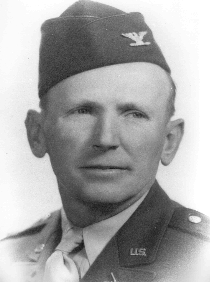 COL O’Connell was born February 16, 1911, at Cimmaron. He completed 44 years of military service to State and Nation with retirtement in February 1971, ranging from the rank of private to that of colonel. During World War II, Col. O’Connell commanded the 2nd Battalion, 137th Infantry Regiment in five major battles including the Battle at St. Lo and the Battle of the Bulge. He commanded more Kansans in any battalion size unit in Europe during World War II, than any other battalion commander.
COL O’Connell was born February 16, 1911, at Cimmaron. He completed 44 years of military service to State and Nation with retirtement in February 1971, ranging from the rank of private to that of colonel. During World War II, Col. O’Connell commanded the 2nd Battalion, 137th Infantry Regiment in five major battles including the Battle at St. Lo and the Battle of the Bulge. He commanded more Kansans in any battalion size unit in Europe during World War II, than any other battalion commander.
Following World War II, Col. O’Connell was highly responsible for reorganization of the 137th Infantry Regiment as an active unit in the Kansas Army National Guard which he commanded until 1951 when he was assigned as Regimental Executive Officer of the 137th Infantry. Col. O’Connell met with the Military Affairs Committee of the Chamber of Commerce in various cities in his area arranging for their support and for armory space. In 1947, he was successful in organizing the 1st Battalion, 137th Infantry with Headquarters Company C in Newton, Company D in Clay Center and the Medical Detachment in Cottonwood Falls.
Col. O’Connell volunteered for active duty October 12, 1951, and served as Commanding Officer of the 306th Logistical Command and also as Commandant for Camp McCoy, Wisconsin. He was assigned an overseas tour in Italy and Austria from July 1952 until December of that year. Col. O’Connell returned to the Kansas National Guard in January 1953, was transferred to the Inactive Reserve in August 1953, and retired as a colonel on February 16, 1971.
Colonel O’Connell was awarded the Silver Star Medal, the Bronze Star Medal with Oak Leaf Cluster, the Purple Heart Medal and the French Croix DeGuerre with Gold Star. He was also awarded the American Defense, American Theater, European Theater with five Battle Stars, Victory and Occupation Medals and the 20 year Kansas National Guard Medal.
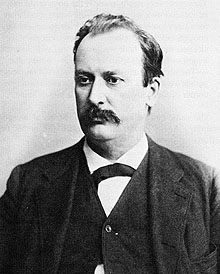 Born March 10, 1839, in Brownville, Pennsylvania, Col. Martin began his military career at the early age of 21 when he was called to duty during the War Between the States in 1860. He served with exceptional distinction as an organizer and commander of the 8th Kansas Volunteers participating in 15 major engagements which included Corinth in Mississippi, Chickamauga, Mission Ridge and Lookout Mountain in Tennessee and 18 lesser battles.
Born March 10, 1839, in Brownville, Pennsylvania, Col. Martin began his military career at the early age of 21 when he was called to duty during the War Between the States in 1860. He served with exceptional distinction as an organizer and commander of the 8th Kansas Volunteers participating in 15 major engagements which included Corinth in Mississippi, Chickamauga, Mission Ridge and Lookout Mountain in Tennessee and 18 lesser battles.
His regiment served with distinction under the command of the following General Officers: Halleck, Rosencrans, Thomas, Grant, Hooker, Sheridan and Sherman. During the numerous engagements they were opposed by the Confederate Army of Bragg, Hood, Polk, Longstreet and others.
Following the Civil War, Col. Martin returned to Kansas and was elected as the tenth Governor of Kansas and was inaugurated on January 12, 1885. He was re-elected in 1886 to serve a second term. His leadership as Governor led to the Kansas Legislature authorizing the “Kansas National Guard” as the successor to the Kansas Militia in which he served as the first Commander-In-Chief of the Kansas National Guard from 1885 to 1889.
During his lifetime, he gained fame as a publisher, soldier, patriot and politician. Col. Martin was instrumental in establishing the National Cemetery and Old Soldiers Home in Leavenworth, and the Soldiers Children Home in Atchison. He died October 6, 1889, in Atchinson.
 BG Browne, Sr. enlisted in Company F, 1st Infantry, Kansas National Guard in Hiawatha, Kansas, June 24, 1899. He served with the 1st Regiment during the Mexican Border War and with the 137th Infantry during World War I.
BG Browne, Sr. enlisted in Company F, 1st Infantry, Kansas National Guard in Hiawatha, Kansas, June 24, 1899. He served with the 1st Regiment during the Mexican Border War and with the 137th Infantry during World War I.
Promoted to colonel, he commanded the 137th Infantry from October 17, 1921, until February 25, 1941, when he retired from federal active service after being mobilized on December 23, 1940. He returned to Kansas and assumed the responsibility of organizing and training the Kansas State Guard which was created under the Act of Congress to preserve the internal security of the State while the National Guard was in federal service during World War II. He was promoted to brigider general January 1, 1947, while commanding the Kansas State Guard group which consisted of eight battalions. He was a member of the Kansas Military Board from 1921 until his death June 13, 1951.
He proposed and worked untiringly to obtain passage of the law creating the Kansas Armory Board making possible the construction of many armories in Kansas. In addition, he devoted a great amount time and attention to assist veterans of the World War in securing benefits which they were entitled that required considerable knowledge, letter writing, affidavit making and form completition of which the average ex-service man was not familiar. His military career consisted of more than 50 years of service to the State and Nation. His outstanding service and dedication was honored by the commemoration of the Browne Memorial Armory in Horton.
 BG John W. Breidenthal was active in the Kansas Army National Guard since World War II having completed over 30 years of military service to State and Nation with retirement in December 1970.
BG John W. Breidenthal was active in the Kansas Army National Guard since World War II having completed over 30 years of military service to State and Nation with retirement in December 1970.
During World War II, Gen. Breidenthal served in the Pacific Theater as an officer of the 1st Cavalry Division and was on the staff of General MacArthur’s headquarters. For his service during World War II, Gen. Breidenthal was awarded the Bronze Star Medal, the Philippine Liberation Medal, the Philippine Presidential Citation Medal, Victory Medal, American Theater Service Medal and other awards.
On March, 1947, Gen. Breidenthal served with the 1st Battalion, 137th Infantry and was assigned as Battalion Commander on July 28, 1950. He was further assigned as the Battle Group Commander of the 2nd Battalion, 137th Infantry May 1, 1959, and was promoted to colonel April 1, 1960. He was appointed Deputy Brigade Commander, 69th Infantry Brigade February 1963, and then assigned as commander and promoted to brigadier general on December 7, 1965. He was activitated with the 69th Infantry Brigade during the Vietnam War from May 13, 1968 to December 12, 1969, and was awarded the Legion of Merit and Meritorious Service Medal for this period of service.
His service in the military organizations included the presidency of the Henry Leavenworth Chapter of the Association of the United States Army, membership on the Kansas Military Board, the National Guard Association of Kansas, the 35th Division Association, the Sons of the American Revolution and the United Service Organizations, Inc. Gen. Breidenthal was an outstanding community worker serving on a multitude of civic organizations.
 BG Weed served this nation and his State with distinction for 44 years. He enlisted as a private on August 1, 1915 and retired as a brigadier general.
BG Weed served this nation and his State with distinction for 44 years. He enlisted as a private on August 1, 1915 and retired as a brigadier general.
He entered federal service as a corporal with Company H, 1st Kansas Infantry, during the Mexican Border Campaign in 1916. In World War I, he was called to federal service as a sergeant with Company H, 137th Infantry, 35th Division serving in France. He was awarded the Purple Heart for wounds received in the Meuse-Argonne Offensive. He again was ordered to federal service during World War II with the 137th Infantry and later commanded the 3rd Battalion, 137th Infantry, 35th Division. He later served in France and Belgium. Subsequent to World War II, Gen. Weed returned to the Kansas Army National Guard in command of the 137th Infantry and was assigned as Assistant Division Commander of the 37th Infantry Division at the time of his retirement.
Gen. Weed was instrumental in reestablishing the Kansas City station after World War II. He was highly influential in procurement of the real estate and raising of building funds for construction of the Kansas City, Kansas Armory. Through his dedicated initiative, the Orinrod Memorial Military Library was established in the Kansas City station. Early in his career, as a sergeant, he was delegate to a convention where he became founder of the American Legion. He served as the first Post Commander for the Lawrence, Kansas American Legion Post.
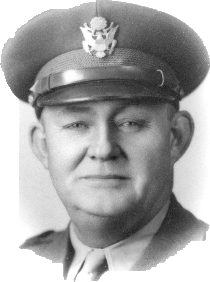
A veteran of the Mexican Border Campaign, CPT Smith was wounded by a German bayonet while leading his combat infantry command during the hand-to-hand and trench warfare of World War I. In World War II he landed on Omaha Beach with the 635th Tank Destroyer Battalion he had organized and trained, and later successfully held one sector against the Germans’ final drive in the Battle of the Bulge.
BG Smith was chosen as the first superintendent of the Kansas Highway Patrol, and in January of 1947, he began his first of fourteen years as the Representative of the Sixth Congressional District of Kansas, in the United States House of Representatives. As a citizen and soldier he demonstrated a keen sense of duty to be right and to act for the good of the people.
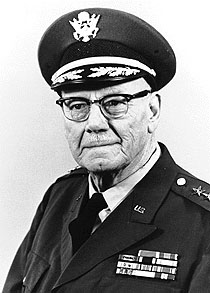 Lieutenant General Joe Nickell served as the Adjutant General of Kansas for more than 21 years, culminating an illustrious career as state legislator, lawyer, newspaperman, radio commentator, photographer, historian and soldier.
Lieutenant General Joe Nickell served as the Adjutant General of Kansas for more than 21 years, culminating an illustrious career as state legislator, lawyer, newspaperman, radio commentator, photographer, historian and soldier.
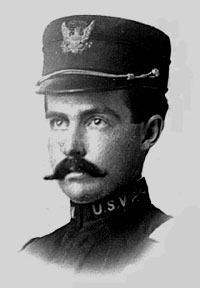 COL Ferguson was born to CPT and Mrs. R. W. Ferguson on December 11, 1877. He was awarded the Congressional Medal of Honor for extraordinary bravery above and beyond the call of duty, while serving as first lieutenant with the 36th U.S. Infantry in the Phillipine Campaign of the Spanish-American War. In this action at Porac, Luzon, Phillipine Islands on September 28, 1899, he single-handedly charged a body of the enemy and enabled his unit to advance.
COL Ferguson was born to CPT and Mrs. R. W. Ferguson on December 11, 1877. He was awarded the Congressional Medal of Honor for extraordinary bravery above and beyond the call of duty, while serving as first lieutenant with the 36th U.S. Infantry in the Phillipine Campaign of the Spanish-American War. In this action at Porac, Luzon, Phillipine Islands on September 28, 1899, he single-handedly charged a body of the enemy and enabled his unit to advance.
He had previously received a citation for gallantry in action while serving as a Corporal with Company E, 20th Kansas Volunteer Regiment. That action is described in the Burlington Daily Republican on February 21, 1923. “The insurgents were intrenched strongly at the Rio Grande and General Wheaton and his brigade, including the 20th Kansas, were bent on taking the position, by long odds the most formidable yet encountered. The ties and girders had been removed from the bridge and a small forticifaction at the end of the bridge commanded the approach so effectually that any attempt to carry it would be suicide. Colonel Funston was anxious to make the effort, however, and Ferguson volunteered to cross the bridge in the darkness and determine the feasibility of an attack. Stripping off his clothes, he made his way along the slippery and dangerous footing, where a misstep meant death in the river beneath, and the slightest noise meant death from an insurgent bullet. Ferguson got up to within 20 feet of the insurgent fortifactions and then returned. He reported that any assault was inpracticable and the project was abandoned. The next day Privates Trembley and White swam the river, and with 14 men, Colonel Funston put to rout 3,000 insurgents and captured the position, thereby winning the stars of a brigadier general.”
COL Ferguson later served in the Mexican Border Campaign and World War I. At the outbreak of World War I, he was assigned to Fort Riley , where he was an instructor at the first officers’ training camp. He then became Chief Instructor at the second officers’ camp at Fort Snelling. Afterward, he was assigned to the War Department as an assistant adjutant general of the U.S. Army, in charge of enlisted personnel. He received high praise from Secretary Baker and General Pershing. During the last five years of his military career, he served with distinction as Secretary, General Service Schools, Fort Leavenworth. He was instrumental in organizing the books division of the Fort Leavenworth schools, which publishes military textbooks for U.S. Army officers.
COL Ferguson died unexpectedly the morning on February 20, 1923, at Fort Leavenworth’s hospital, following an operation for a hernia. He was 45 years old and left his wife, Mrs. Sarah Emily Ferguson. He had been expected to join his parents, brother and sister at Burlington, for his parents golden wedding anniversary on the day he died. He was buried at Arlington National Cemetery (section 3, grave number 4016). The National Guard facility at Burlington is dedicated in memory of his service to the State of Kansas as the Ferguson Memorial Armory.

Recalled to active duty again in 1949, Col. Dunkley served as a member of the Army General Staff during the Korean Conflict. He was promoted to brigadier general in 1953. He was elected in 1954 as the first president of the National Guard Association of Kansas. Following three terms as president of the association, he retired from the 35th Infantry Division in May of 1957.
A native of Indiana, Col. Crawford migrated to Kansas in 1859 and settled in Garnett, Anderson County, and established a law practice. He was elected to the first Kansas Legislature which was convened in March of 1861. He resigned on May 5, 1861 and returned to Anderson County to organize a company of Kansas Militia.
He recruited Company E, Second Kansas Volunteer Infantry, from Anderson and Franklin Counties for duty with the Union Army. Later he commanded elements of the Second Kansas Cavalry and the 83rd U.S. Colored Infantry, where he gained recognition as a heroic military leader during the Civil War.
He was sworn in as the third Kansas Governor on January 9, 1865 and was reelected for a second term two years later. Due to his concern for Western Kansas settlers who were suffering violent raids by hostile plains Indian tribes, Governor Crawford issued a call for volunteers to serve a period of six months.
He resigned as Governor on November 4, 1868 to take command of the 19th Kansas Volunteer Cavalry Regiment which was to join the 7th U.S. Cavalry in the Custer-Sheridan winter Campaign of 1868-69. The purpose of their operation was to force the Indians into their reservations and to demonstrate that the winter offered no sanctuary for the plains tribes. Heavy precipitations, sub-freezing temperatures, a severe shortage of rations for the soldiers and forage for their horses combined to create great suffering for the men and their animals during the entire winter. Col. Crawford’s distinctive leadership sustained the Kansas Volunteers, proving that the U.S. Army could and would operate in any weather.

COL Donald E. Ballard
The only Medal of Honor winner in the reserve component who is still active in the military, Lt. Col. Donald E. Ballard, was promoted to colonel on April 5, 1998, during a ceremony surrounded by friends and colleagues at the State Defense Building in Topeka, Kan.
Maj. Gen. James F. Rueger, the adjutant general, pinned on Ballard’s new rank and remarked, “Donald has had some great experiences in the military including earning the Congressional Medal of Honor and commanding Guard units. He is a true Guardsman, and I’m very proud to be a part of this ceremony today.”
Ballard has been a member of the Kansas Army National Guard since 1970. In his remarks, Ballard reached out to his friends and comrades in arms, “You are my family. I’m proud to be here and to be in the National Guard.” The crowd responded with tremendous applause.
During his 27 years in the Guard, Ballard has been an ambulance platoon leader, company commander and served in several key positions. “What kept me from retiring was the honor of being asked to start a new unit — Medical Detachment 5,” said Ballard. He was the first person in the unit, and the executive officer. “Detachment 5 is the most cost-efficient organization I’ve ever seen in the Army,” said Ballard. “It saves the Guard thousands of dollars by performing physicals for Guard members instead of contracting them out.”
Ballard, who is a Special Assistant to The Adjutant General, has recently been asked to establish a new training program for the certification of all medics in the Kansas Guard. Ballard said he plans on using the same philosophy he learned as a Corpsman, “Preserving the force as far forward as possible” which means taking the training closer to the units rather than having unit personnel come to a central training site.
Ballard lives in North Kansas City, Mo., where he is a captain in the fire department’s emergency medical technician division, and owner of two funeral homes.
Ballard earned the Congressional Medal of Honor while a Navy Corpsman assigned to the Marines in Vietnam. The unit he was with was ambushed. Ballard repeatedly exposed himself to hostile fire to pull wounded Marines to a safer location and treat them. Later, this location was engulfed in a crossfire between the Marines and the enemy. An enemy hand grenade landed amongst the wounded. Ballard picked it up and threw it back. After a few minutes under direct fire, another grenade was thrown at his position. This time he didn’t have enough time to pick it up, so Ballard selflessly threw his body onto the grenade in order to protect his patients. After what seemed like an eternity, and no explosion, Ballard reached underneath him to grasp the grenade, rolled over, and in the same motion threw the grenade away. A split second later, witnesses say, the grenade exploded in midair, but out of harms way.
Ballard says he didn’t have time to think about what he did that day in 1968. It was instinct. Ballard said, “It was the right time to be in the wrong place.”
Ballard left the Navy in 1970 and was selected for Army officer candidate school. Ballard was called to the White House to receive the Medal of Honor from President Richard M. Nixon, General Westmoreland, and Admiral Moore. Upon finding out Ballard was switching over to the Army, Westmoreland offered him a direct commission to be an active duty Army officer. However, for family reasons Ballard turned the offer down but was persuaded to join the Kansas Army National Guard.
There are only three Medal of Honor winners still in military service in the U.S. In addition to Ballard, there are two active duty Army officers.
Hospital Corpsman Second Class, USN, Co M, 3d Btln, 4th Marines, 3d Marine Division.
Action: Quang Tri Province, Republic of Vietnam, May 16, 1968.
Inducted: Kansas City, Mo.
Date of birth December 5, 1945, Kansas City, Mo.
Citation: For conspicuous gallantry and intrepidity at the risk of his life and beyond the call of duty while serving as a HC2c. with Co M, in connection with operations against enemy aggressor forces. During the afternoon hours, Co M was moving to join the remainder of the 3d Btln in Quang Tri Province. After treating and evacuating 2 heat casualties, HC2c. Ballard was returning to his platoon from the evacuation landing zone when the company was ambushed by a North Vietnamese Army unit employing automatic weapons and mortars, and sustained numerous casualties.
Observing a wounded Marine, HC2c. Ballard unhesitatingly moved across the fire swept terrain to the injured man and swiftly rendered medical assistance to his comrade. HC2c. Ballard then directed 4 Marines to carry the casualty to a position of relative safety. As the 4 men prepared to move the wounded Marine, an enemy soldier suddenly left his concealed position and, after hurling a hand grenade which landed near the casualty, commenced firing upon the small group of men. Instantly shouting a warning to the marines, HC2c. Ballard fearlessly threw himself upon the lethal explosive device to protect his comrades from the deadly blast. When the grenade failed to detonate, he calmly arose from his dangerous position and resolutely continued his determined efforts in treating other Marine casualties.HC2c. Ballard’s heroic actions and selfless concern for the welfare of his companions served to inspire all who observed him and prevented possible injury or death to his fellow Marines. His courage, daring initiative, and unwavering devotion to duty in the face of extreme personal danger, sustain and enhance the finest traditions of the US Naval Service.
COL Ballard is the only current Kansas Guardsman to have received the Congressional Medal of Honor. He is currently a member of the Kansas Army National Guard.
